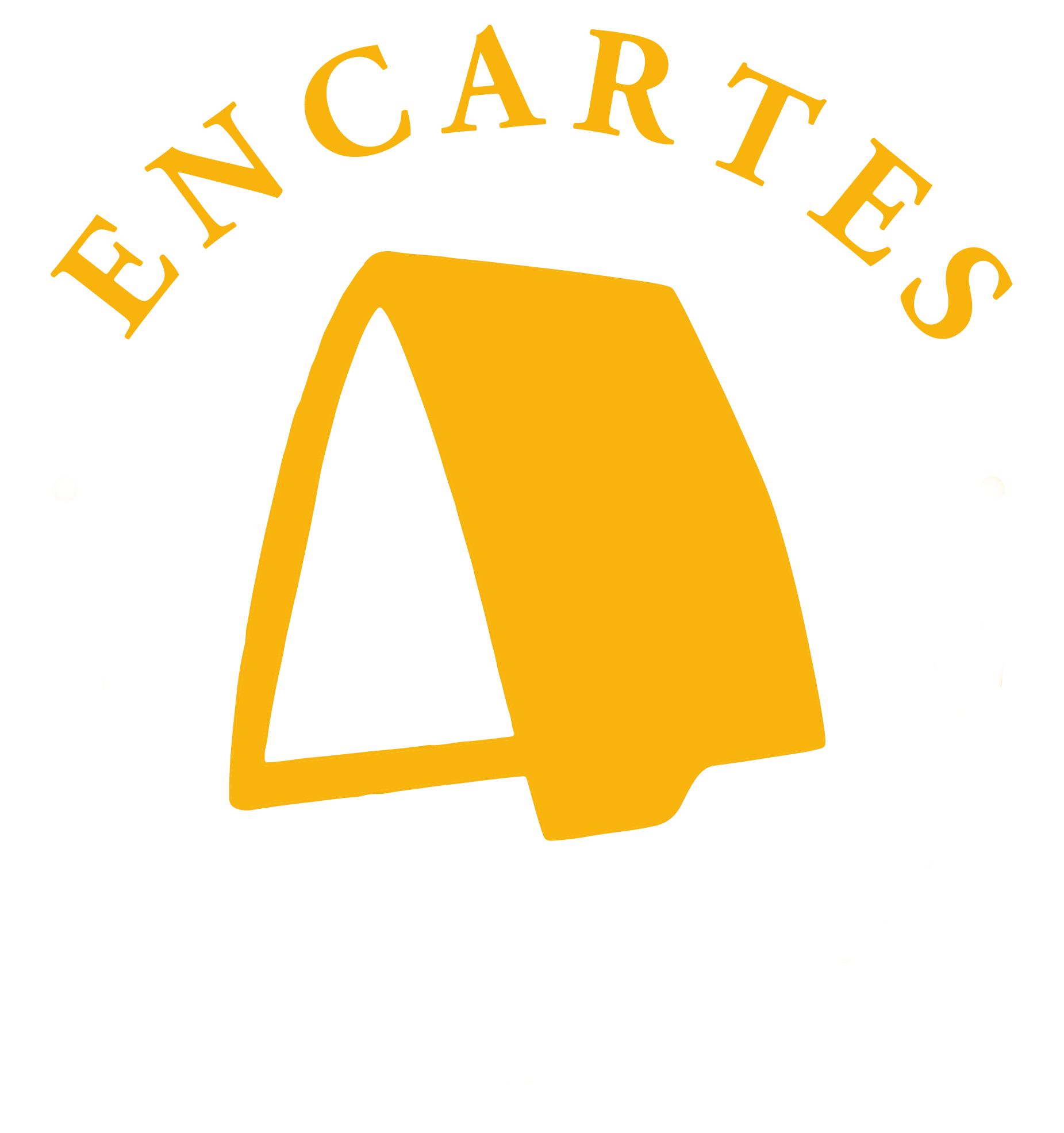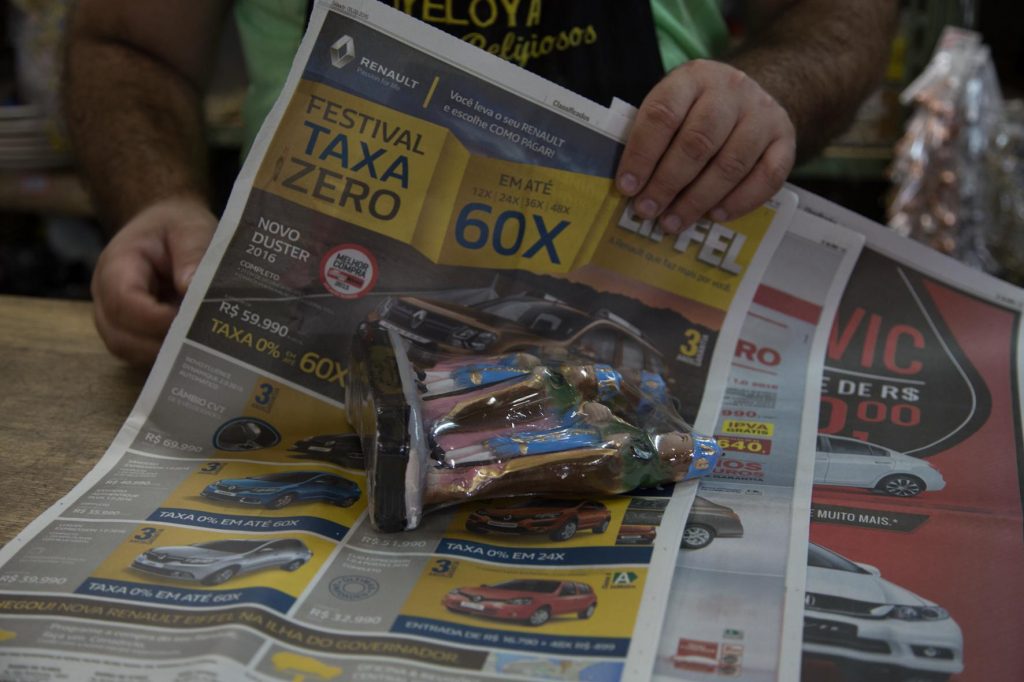Global manifestations of the Israel-Palestine conflict in anti-war aesthetic images from around the world
Concern over the armed conflict unleashed on October 2023 in the area known as the Gaza Strip has led to mobilizations, takeovers of public spaces and performances around the world. Although it is part of a long-standing territorial conflict between two ethno-national groups, it has become a global concern for different student groups, religious, human rights and political activists who are speaking out against a war that has contravened international agreements and has increased hate speech and attacks on civil society - mainly children and women, the elderly and journalists.
During 2024, the war intensified and expanded its territorial radius beyond Palestine. This situation has given rise to multiple demonstrations that make use of ritualized symbolic expressions to demand a halt to the war and denounce the horrors it provokes. Pro-Palestinian committees have been formed in different cities to oppose the war and denounce what Amnesty International called genocide. On the other hand, tensions have also shifted to public spaces, which has led to police repression of protests.
Due to the importance of this topic in today's time, the magazine Encartes launched an open invitation to participate in the vi photography contest with images capturing objects, subjects, places, landscapes, symbols and aesthetics that have accompanied the mobilizations and demonstrations around the Israel-Palestine war conflict taking place in different universities, public squares, in front of embassies, in national festivities, in political and religious ceremonies and even in parades and other festivities.
The call stated that the images had to cover the following contents: to show the processes of aesthetic creativity that generate anti-war and anti-nationalist manifestations, denouncing violence, using not only words but also staging, installations and shots of emblematic sites and stylistic interventions of symbols, as well as the creation of an iconography of denunciation or the metaphoricity (deconstruction of signs of power) with which the conflicts of race, nation, ethnicity, territory, religion and gender are expressed.
The call was extended to visual artists, filmmakers, researchers, communities, collectives, students of social sciences and humanities to send their photographs accompanied by a descriptive title and caption data (emphasizing the event, the place where it took place, who are the participants and the date), and a short text explaining the expressive meanings of the demonstration.
The response was very good. We received 105 photographs from 21 participants. The photographs received document demonstrations around the Israel-Palestine conflict in nine different cities, showing the impact that this issue has had on a global scale: Guadalajara, Guanajuato, Mexico City, Tijuana, San Cristóbal de las Casas (Chiapas), Santiago de Chile, New York and Los Angeles (United States) and Uruguay. Due to the quality of the images and the strength of the situations they were able to capture with their cameras, it was not easy to make the selection and even less so to decide which ones would get the first places. Thus, we had to establish several criteria to make a selection of 17 photographs: first, we considered the quality of the photograph (framing, aesthetic composition, image resolution); second, we took into account the expressive force of the image (that in itself could generate a message); third, the members of the jury had in mind the narrative as a whole and tried to ensure that the photos chosen would allow us to form a visual narrative that would account for the diversity of situations, places and actors involved in the demonstrations. In this way we were forced to avoid repetition of content and to choose only one photograph when this happened. Five members of the editorial team participated in the selection committee.
We decided to award first place to Elizabeth Sauno's photograph, which shows a demonstrator depicting a Palestinian mother carrying a bloody baby in her arms. The photo was taken during the March for Palestine on December 17, 2023 in Mexico City. Second place was awarded to Rodolfo Ontiveros for the photograph "Fences" which generates the metaphor of the body as a territory lacerated by barbed wire; it was taken on September 5, 2024, during a demonstration on Paseo de la Reforma in Mexico City. We decided to award third place to two photographs: one by Charlie Eherman and the other by José Manuel Martín Pérez. The first author's depicts "Two men, a Palestinian (left) and an Orthodox Jew (right), show peace signs next to the White House in Washington D. C., USA, during a national demonstration" (June 8, 2024, Washington). The second photograph presents how the global action of solidarity with Palestine is articulated with the feminist demands that took place in the already named Plaza de la Resistencia in San Cristóbal de las Casas during the march of March 8, 2024, in the framework of International Women's Day.
Each of the four winning photographs documents a different face of the demonstrations, but, when seen together, they allow us to recognize that the shared symbols give a single voice to people of different nationalities who may not speak the same language. At the same time, they help us to recognize how their installation in different places deploys multiple enunciations, making photography a resource of metaphoricity as a productive matrix to redefine the social (Bhabha, 2011) from the pro-Palestinian demonstrations and against the war actions in the Gaza Strip.
The idea behind the photographic contests organized by Encartes seeks to assemble the images in order to generate a meta-narrative. Each image captures a different local scenario that, when put in relation, allows the narration of different realities articulated by a global aesthetic. These are articulated because they occur in the simultaneity of a historical time even though they are replicated in multiple distant places. At the same time, the singularity of each shot accounts for the multiplicity of actors, scenarios and symbolic expressions that are manifested there. The exercise allows us to circumvent the paradox of political homogeneity and heterogeneity of identity belonging.
The pro-Palestine movement is undoubtedly a transnational mobilization that has produced its own slogans and symbolism. These aesthetic marks and emblems are the lingua franca that articulates a global communitas of an imagined moral community that shares values, although they will never meet or interact face to face (Anderson, 1993); that has in common a sense of grievance and at the same time a sense of commitment. Different pro-Palestinian committees exist in different countries, cities and towns. The slogans of denunciation and symbols are shared representations and build a single voice in simultaneous time throughout the world. For example, kite flying is already an act of empathy with the children of the Palestinian people; the use or representation of the kufiya covering head and neck is already a distinctive element of the Middle East and wearing it places the enunciation of an activist body. The watermelons, whose colors match the Palestinian flag, go hand in hand with the choruses and banners of free Palestine, as do the Palestinian flags.
The interesting thing about representation is that these symbols do not appear in a vacuum: they dress bodies, they are installed in key scenarios to intervene places. The symbols have acquired a powerful metaphoricity with dissident force. For example, the kite reaches its flight in the emblematic building of the National Autonomous University of Mexico or flying over the concrete slab of Mexico City's zocalo (photo by Dzilam Méndez Villagrán). The flag is placed on the sand of a beach, metaphorically restoring the slogan "From the river to the sea" (photo by Pilar Aranda). The flag is intervened with the phrase "Nunca más, nunca nadie" and "ni un@ más" by a Jewish population that places the slogan of opposition to the holocaust on the Palestinian flag, to generate a hybrid of opposition to the war and to dissociate itself from Zionism (photos by Charlie Eherman).
The flag is used to conquer territories. Its placement constitutes representativeness in a regime of unrepresentability (Rancière, 2009). In the different photos selected, the flag generates a regime of visibility of solidarity for Palestine that, when placed in iconic places such as monuments, acquires a metaphorical enunciative power: In front of the Angel of Independence on Reforma Avenue in Mexico City (photo by Elizabeth Sauna), in front of the Glorieta de la Minerva (symbol of justice) in Guadalajara (photo by Christophe Alberto Palomera Lamas), placed on the border wall that divides Mexico and the United States today in what used to be the same territory inhabited by families that were divided by the wall (photo by Marco Vinicio Morales Muñoz). It even extends the enunciation of genocide to other realities, as is the case with the placement of the sign "Stop genocide" on the wall that divides Mexico from the United States (photo by Priscilla Alexa Macías Mojica), extending the clamor to the tightening of immigration policies. Symbols also move to occupy spaces and change their vocation, such as the emblematic Central Station in New York, taken over by demonstrators from the Jewish community (photo by Charlie Eherman); or their presence in the plaza of San Cristobal de las Casas (photo by Jose Manuel Martin Perez) with a wooden cross in the background, representing the indigenous Catholicism of the area.
The flag transgresses territorialities that also leave their territories traced by the States to configure mini-domains in other countries. This is the case of embassies. The photographs of a demonstration outside the Israeli embassy reproduce scenarios and experiences of violent confrontation (photo by Gerardo Vieyra). We see homemade bombs, police fences, fire, fallen bodies. This did not happen in Gaza, but in Mexico, in the territory of the Israeli embassy; but also in the center of Mexico City, in front of the Guardiola building, which houses the Bank of Mexico (photo by Ana Rodríguez). Territories are made by practicing them and the doors of the Guadalajara International Book Fair during the last month of November acquire the notoriety of an international forum and, therefore, of visibility beyond the local (photo by Pilar Aranda).
Symbols linked to different bodies also generate intersections between various activisms: they gain and expand the demands when they are linked to the feminist movement or when they are articulated with the demands for the recognition of transsexuals; or the resymbolization achieved by placing the already recognized mustache of Hitler, the exterminator of the Jews, on the portrait of Benjamin Netanyahu, current Prime Minister of Israel.
We invite you to sharpen your gaze to read the multiple realities generated by the aesthetic interventions in favor of Palestine captured by the lenses of photographic cameras and, at the same time, to allow yourself to enjoy the marvelous photos that make up this visual essay.
Renée de la Torre
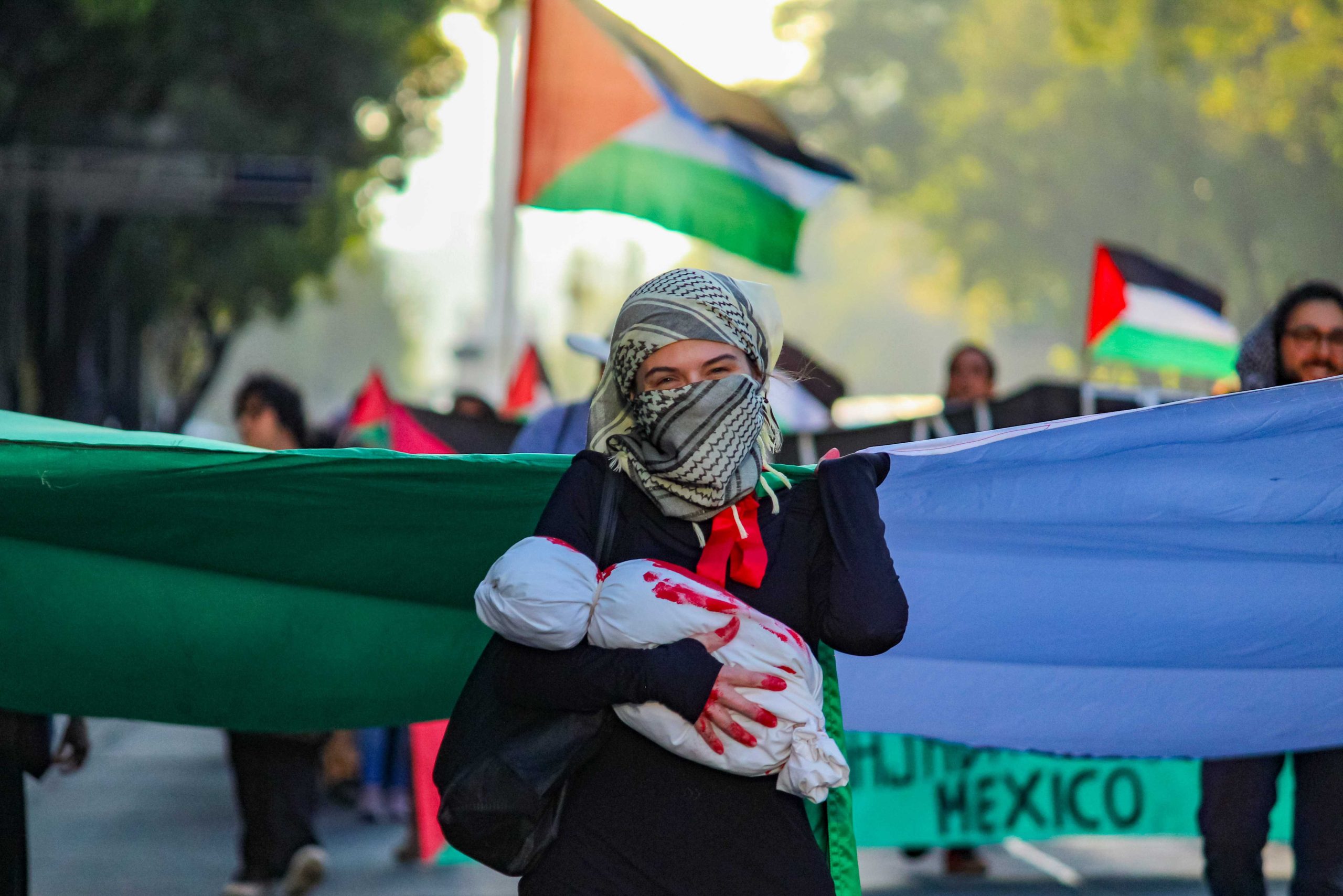
March for Palestine 17 Dec 2023 CDMX
Elizabeth Sauno, Mexico City, December 17, 2023.
Mobilization in solidarity with Palestine, from the Angel of Independence to the Zocalo, Mexico City.
Fences
Rodolfo Oliveros, Paseo de la Reforma, CDMX, September 5, 2024.
Two young men march through Palestine holding hands; the body is the territory encircled by the State of Israel.
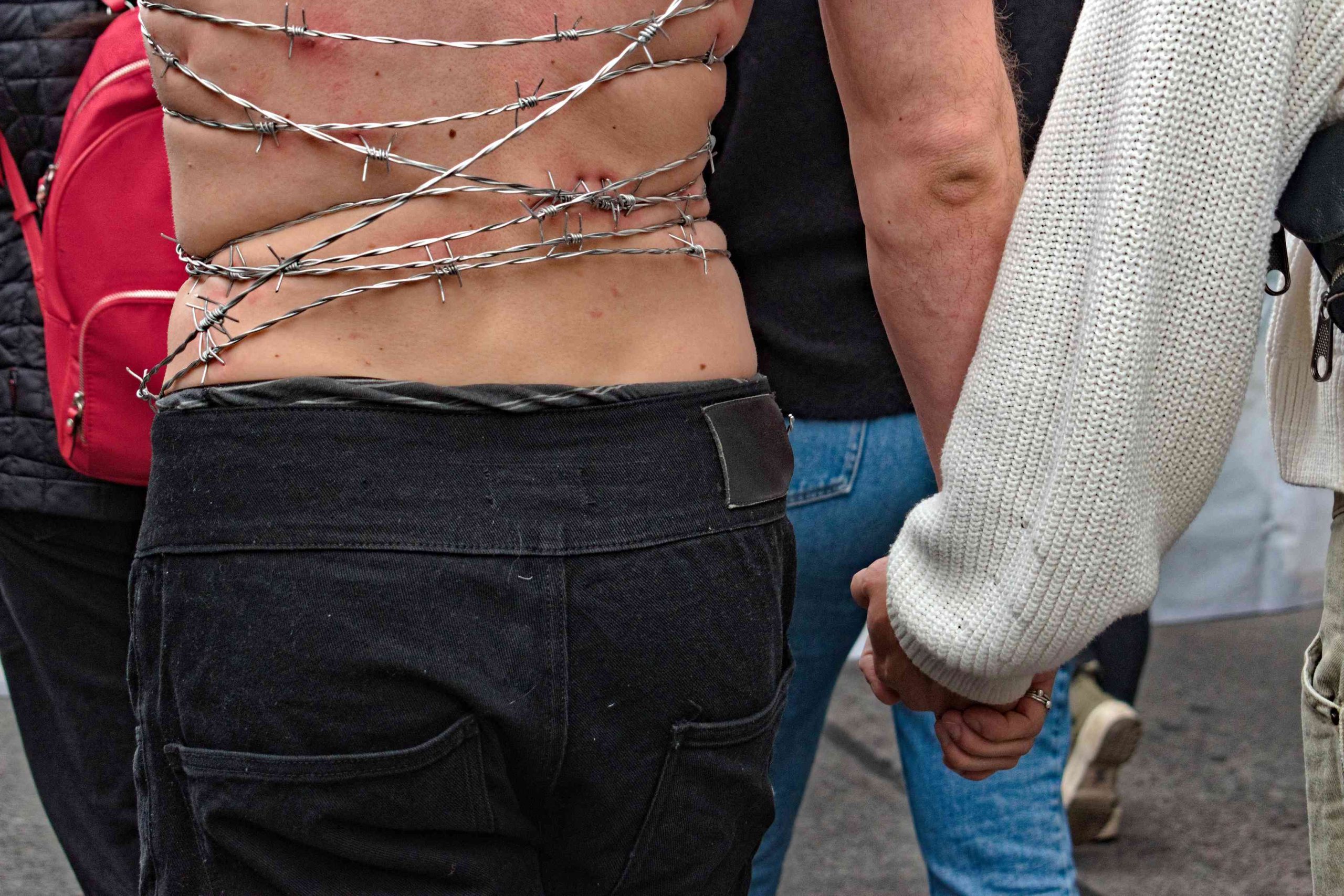

One year of genocide, 76 years of occupation.
José Manuel Martín Pérez, Plaza de la Resistencia, San Cristóbal de Las Casas, Chiapas, Mexico, March 8, 2024.
On March 8, in the framework of International Women's Day, the feminist movement in Chiapas joined the global action in solidarity with Palestine.
Symbols of peace in the capital.
Charlie Ehrman, Washington DC, June 8, 2024
Two men, a Palestinian (left) and an Orthodox Jew (right), display peace signs next to the White House in Washington DC, USA, during a national demonstration.
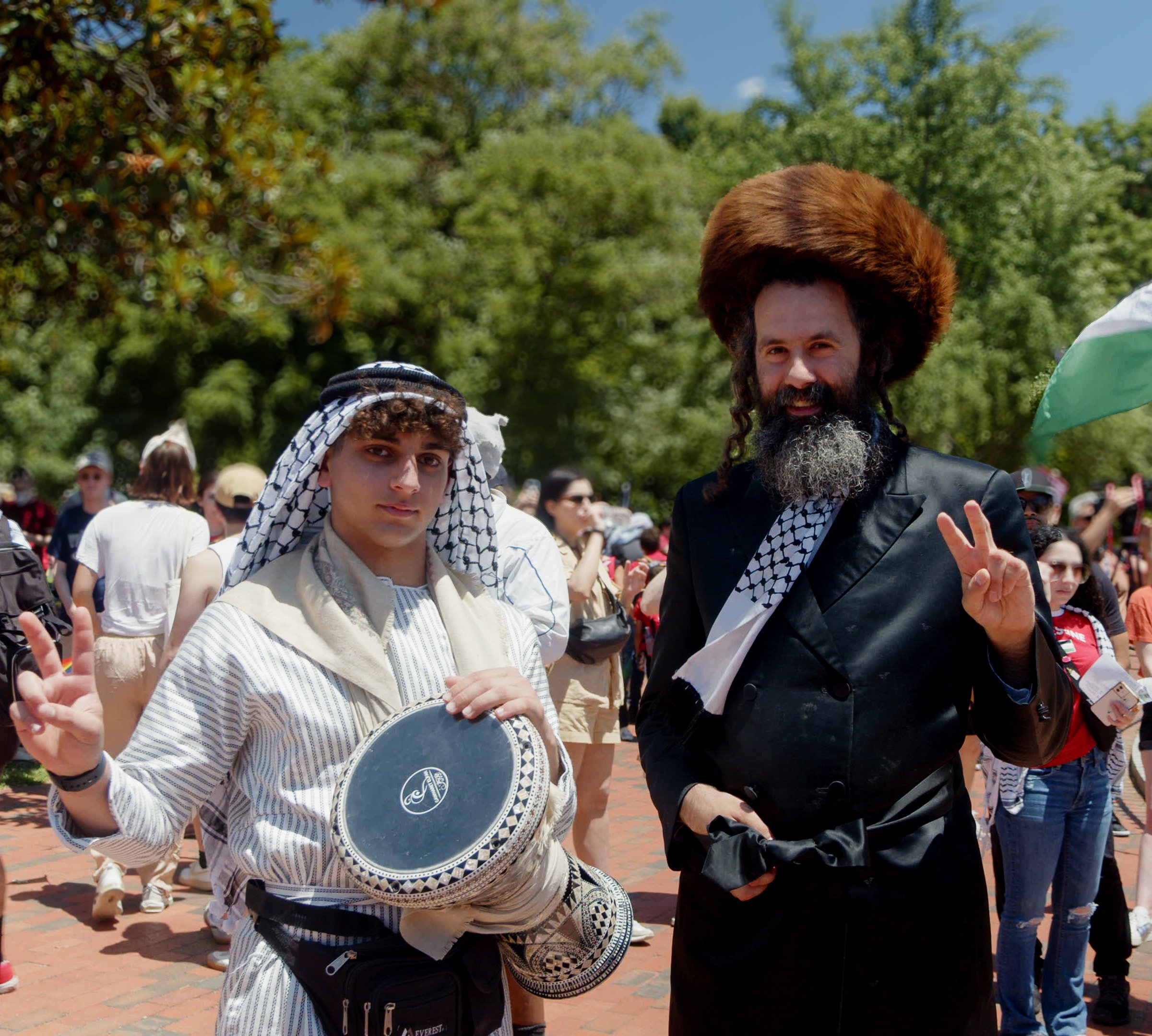
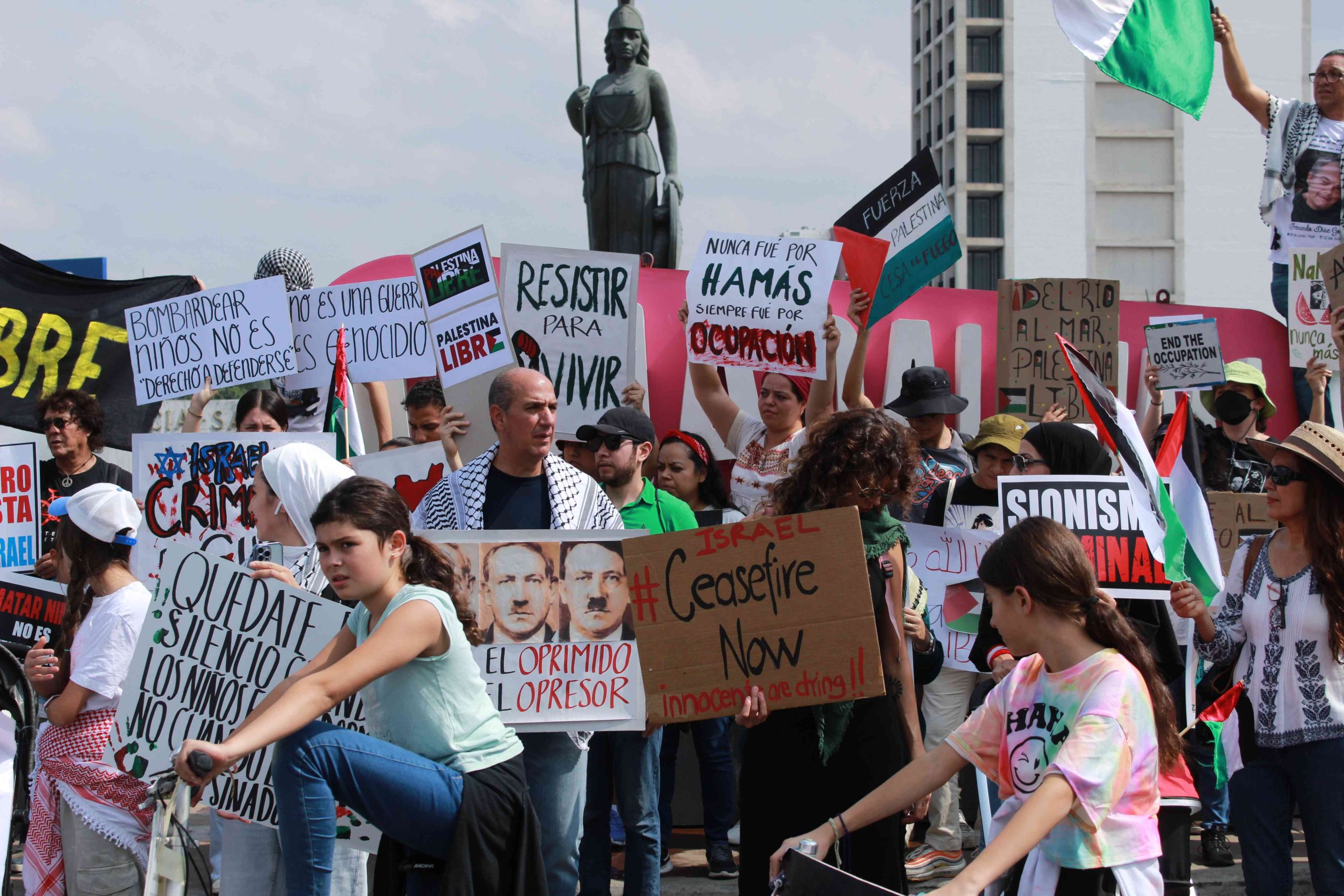
Pro-Palestinian Minerva
Christophe Alberto Palomera Lamas, Mobilization in solidarity with Palestine. Glorieta la Minerva, Guadalajara, Jalisco. Committee of Solidarity with Palestine GDL. November 12, 2023.
La Minerva, an emblematic symbol of Guadalajara, has been a meeting point to celebrate the identity of Guadalajara, but also to protest. Spectator of the search for justice and strength gives opening to the first mobilizations of the Committee of Solidarity with Palestine GDL. November 12, 2023.
Boy with kite in the Zócalo square
Dzilam Méndez Villagrán, Mexico City Zócalo, January 14, 2024.
A symbolic act to express support for the children of Gaza through the making of kites, held in the Zócalo square in Mexico City.
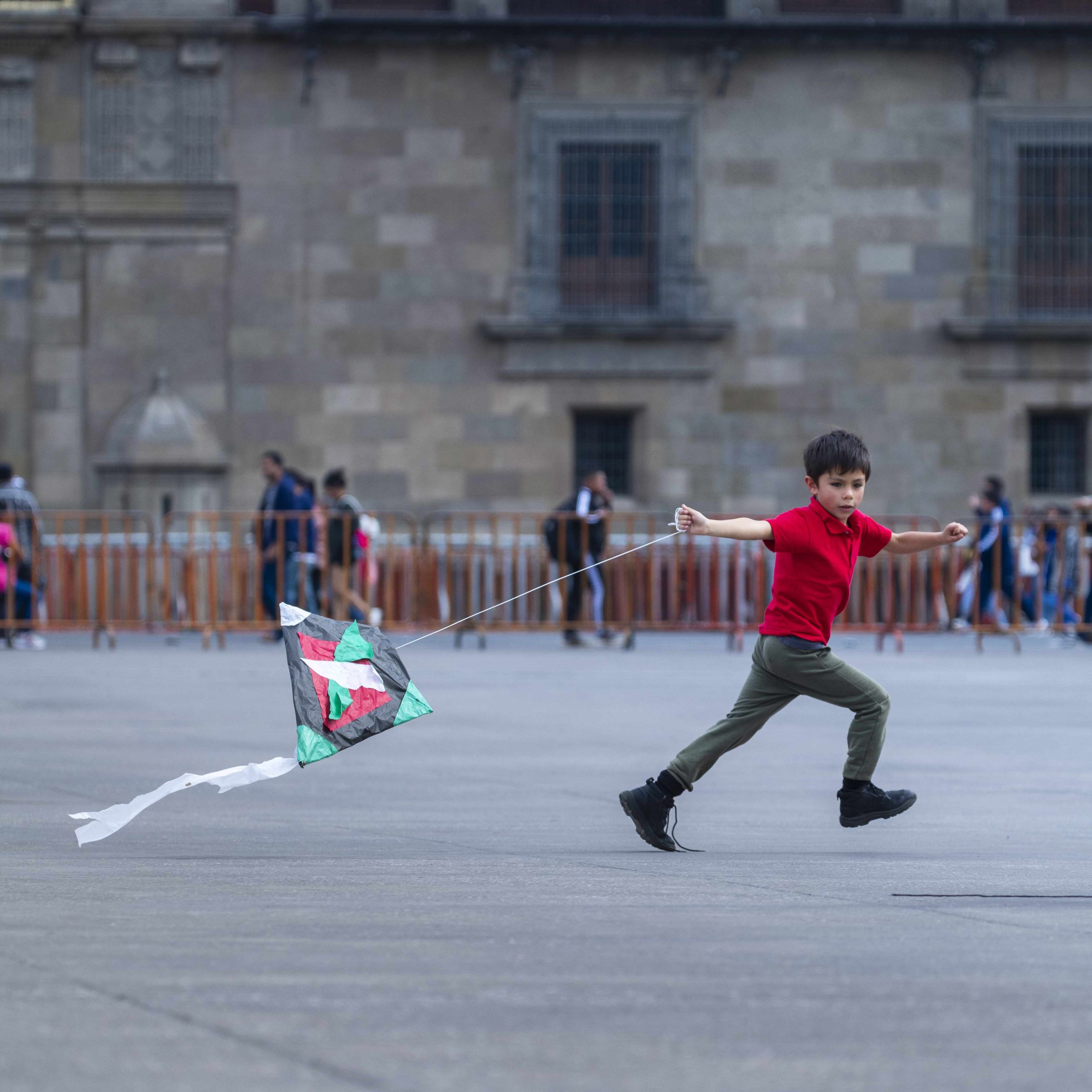
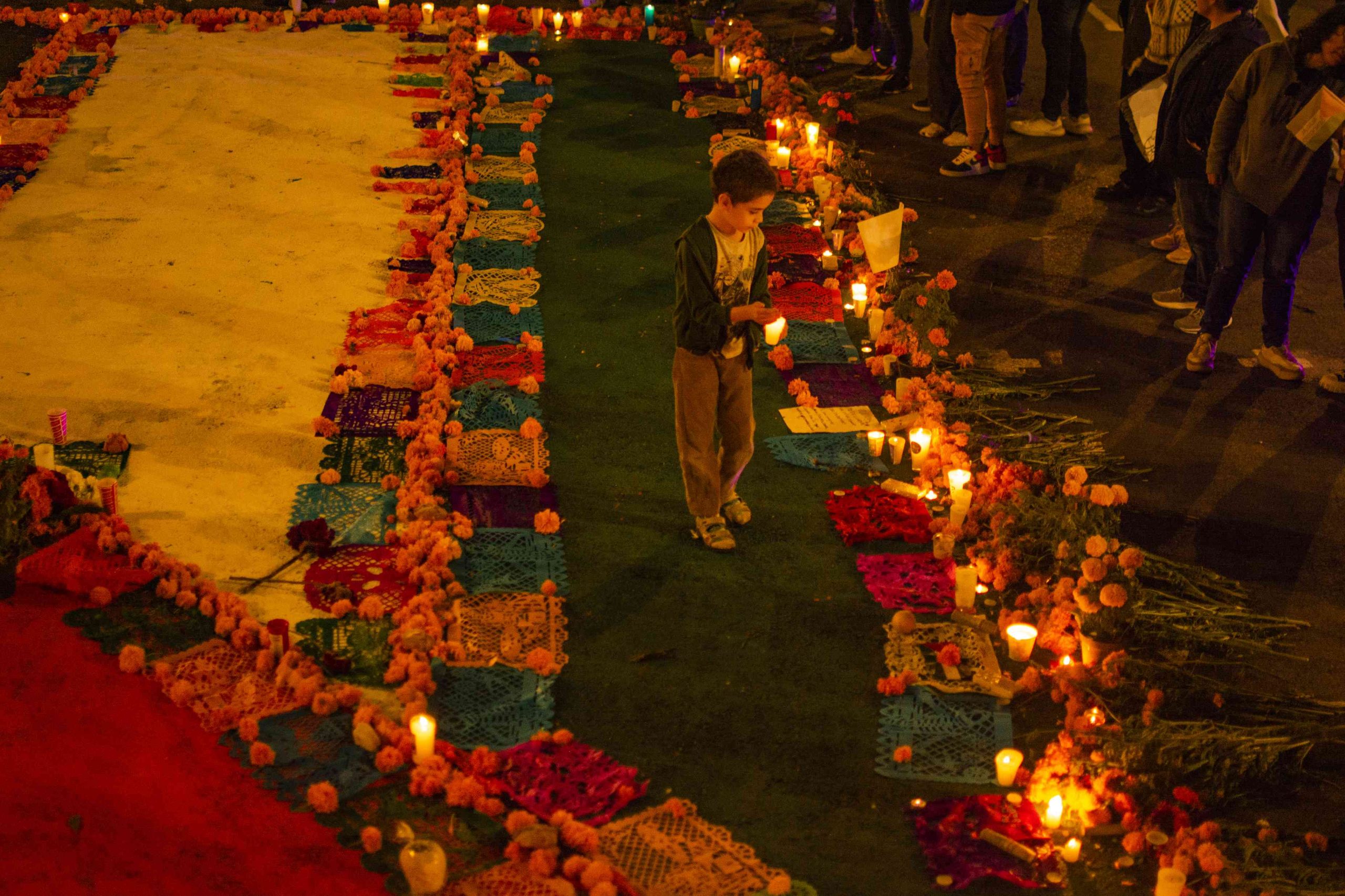
A light for Palestine
Sandra Suaste Avila, Mexico City, November 5, 2023.
A group of academics and activists demonstrate and offer cempasúchil flowers, candles, bread and the wish for an end to the violence in the Gaza Strip. Mexican women remember Palestinian women.
Stop genocide
Priscila Alexa Macías Mojica, Tijuana, Baja California, June 1, 2024.
Poster placed on the U.S.-Mexico border fence in a cross-border art and community activity.
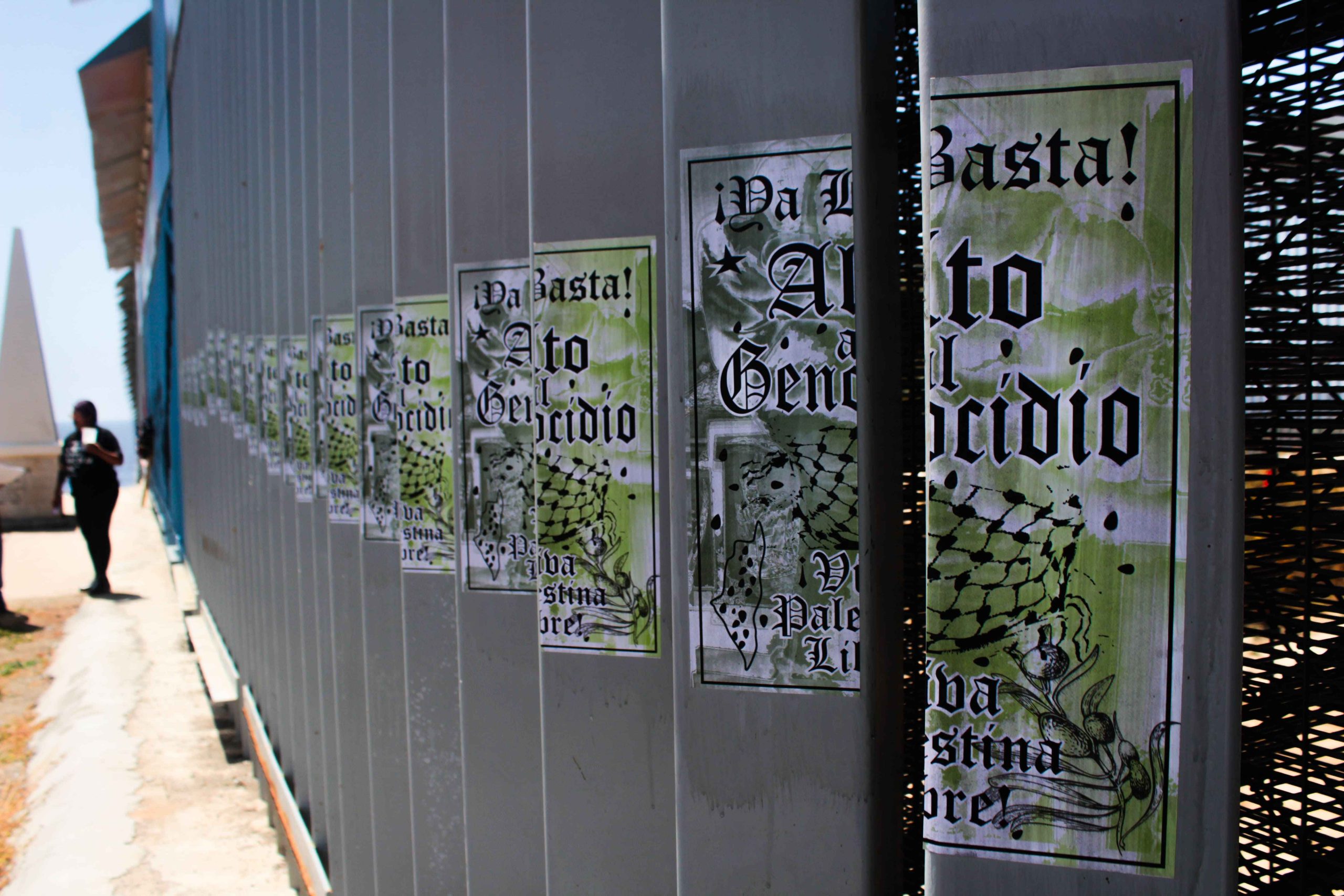
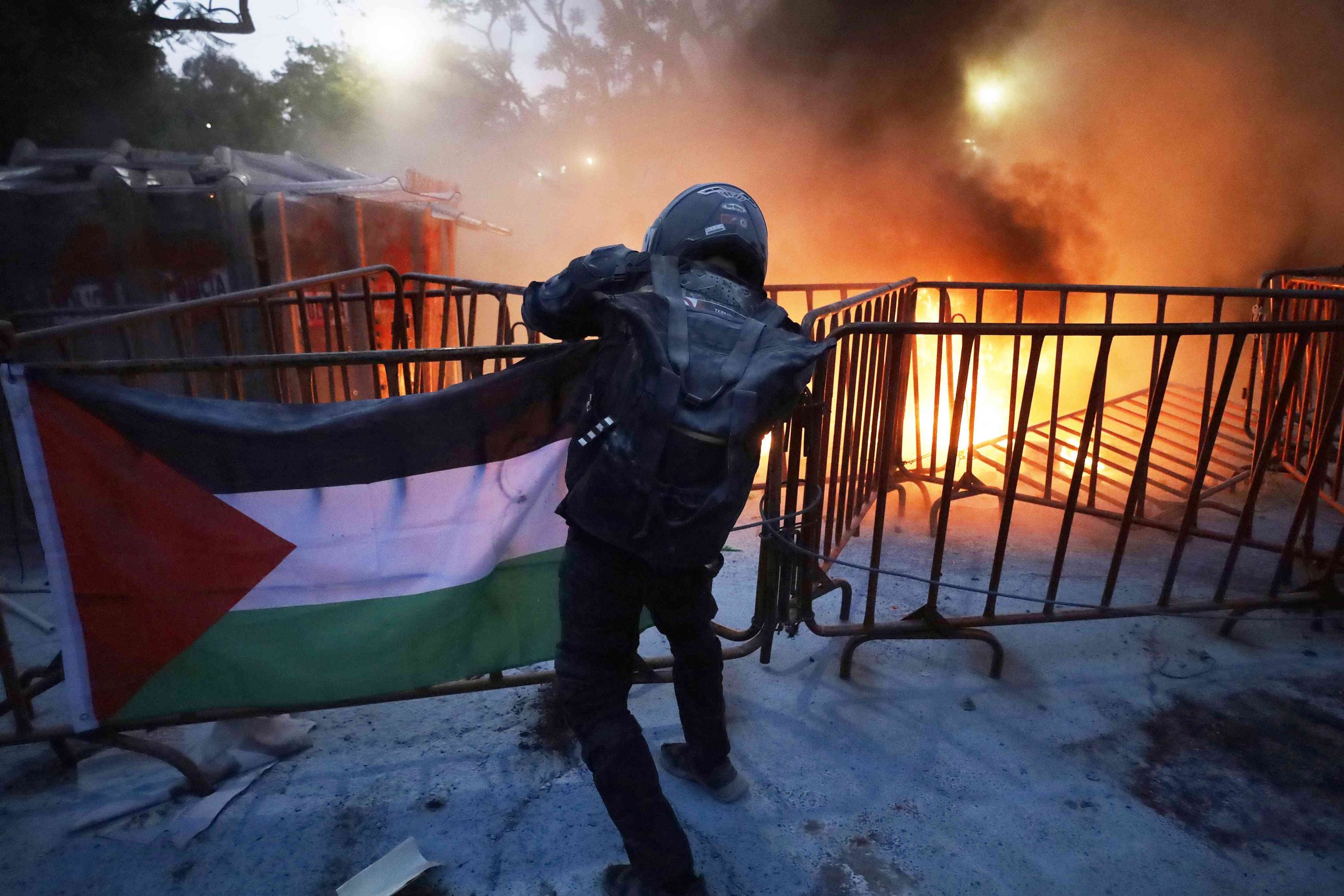
Global action for Rafah in Mexico
Gerardo Vieyra, Mexico City, May 28, 2024.
On Tuesday, May 28, 2024, students from various universities and social organizations in support of Palestine, demonstrated outside the Israeli Embassy in Mexico City, in rejection of the Israeli attacks that arrived that day to the center of Rafah, south of the Gaza Strip, the same day that Ireland, Spain and Norway recognized the State of Palestine and despite international condemnation for a bombing of a camp for displaced persons. According to data from human rights organizations, more than 46,000 people have died in Palestine and a large number of people have been wounded with serious health repercussions.
Looking down on the resistance from the 10th floor.
María Fernanda López López, UNAM Ciudad Universitaria, Mexico City, May 2024.
View of the encampment and monumental painting written on the esplanade of the central library of the UNAM, carried out by the members of the university student encampment in support of Palestine.

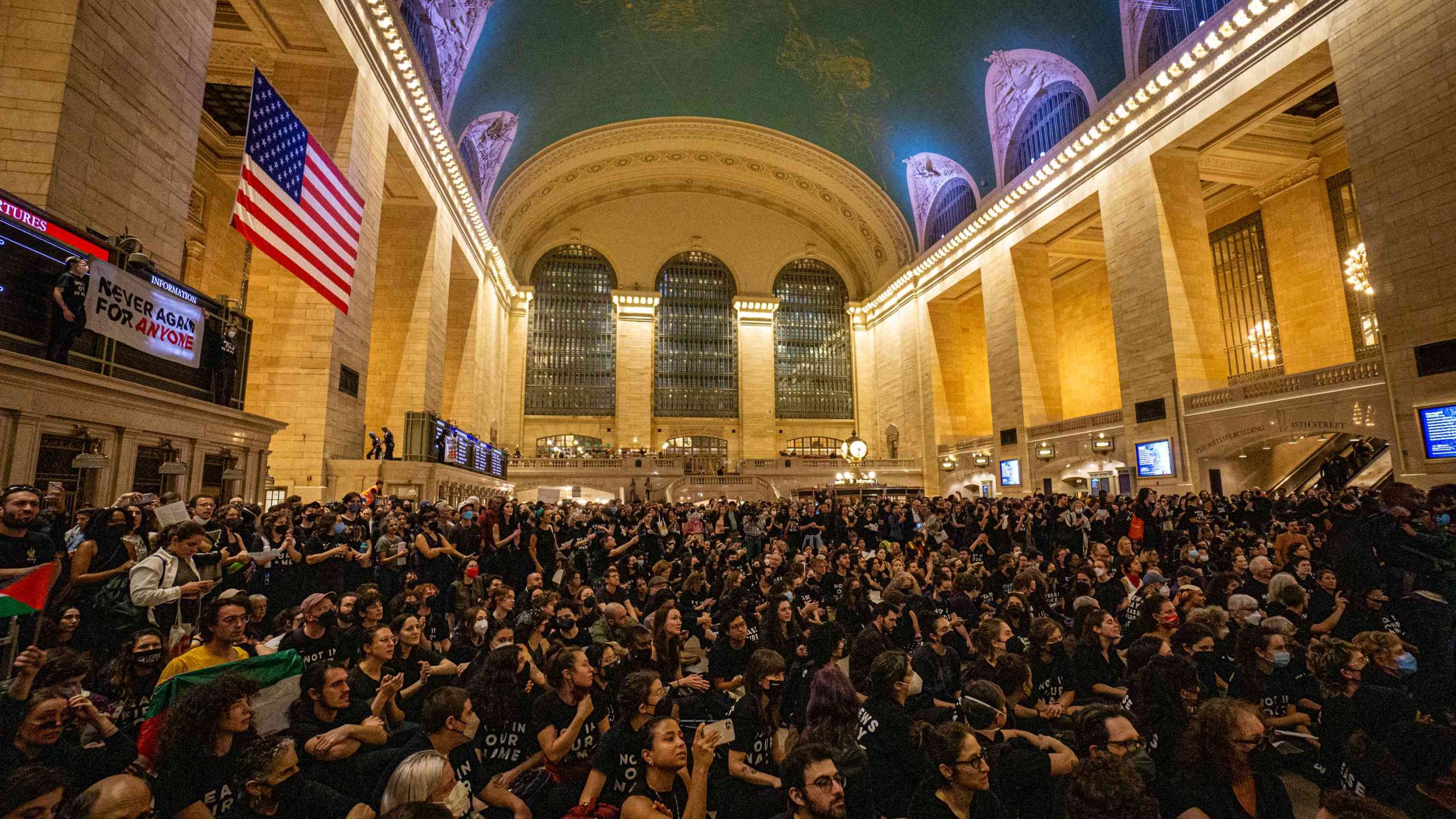
A break at Grand Central, no more war.
Charlie Ehrman, Manhattan, New York, October 27, 2023.
Hundreds of demonstrators from the Jewish Voice for Peace organization occupied the concourse of Grand Central Station in Manhattan, New York, to stop passenger traffic and demonstrate for a cease-fire in the conflict between Israel and Hamas.
March 8M CDMX
Elizabeth Sauno, Mexico City, March 8, 2024.
During the March 8 march in Mexico City, there were contingents in solidarity with Palestine, where sexual dissidents showed their support for the Palestinian cause.

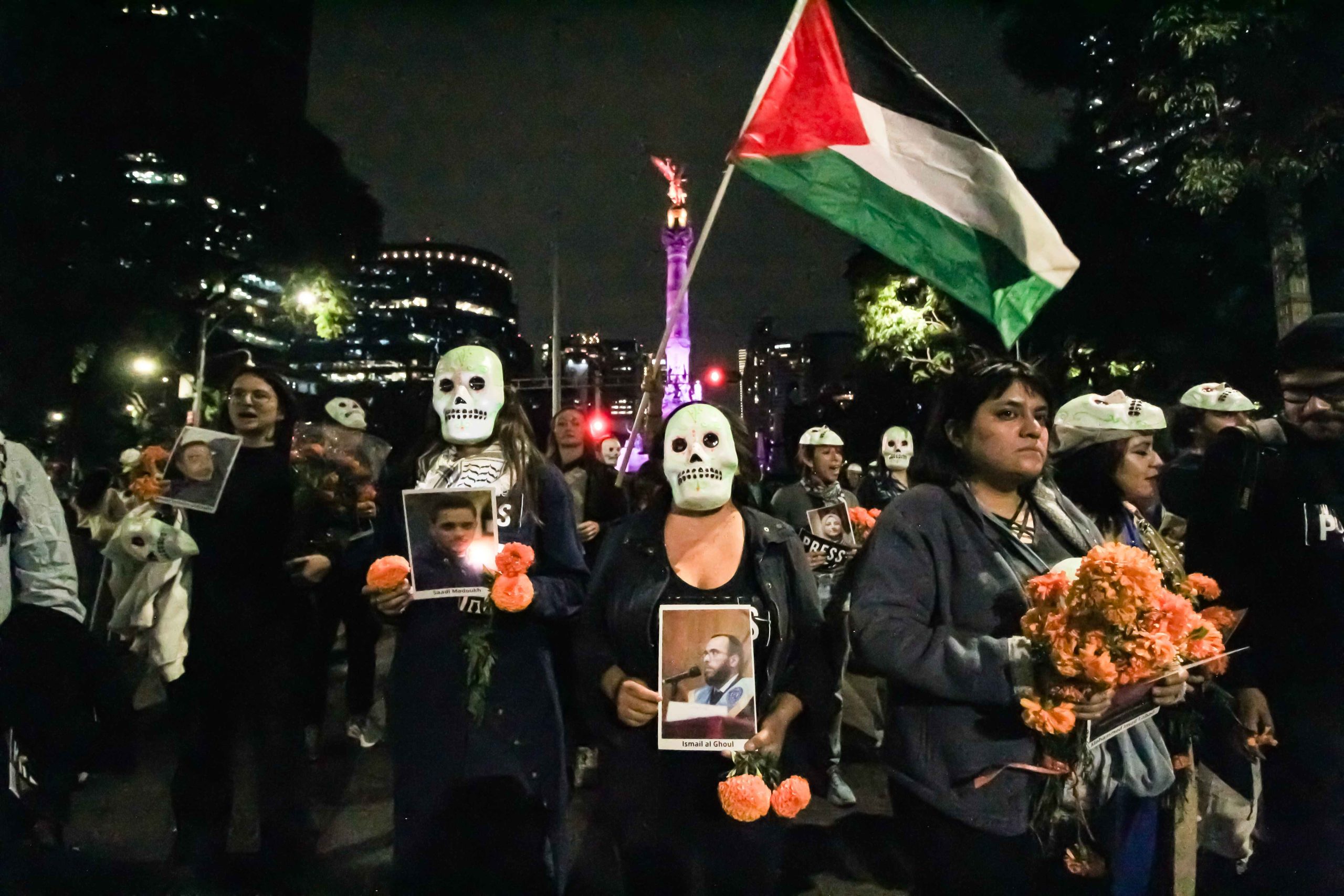
Day of the Dead CDMX 30 Oct 2024.
Elizabeth Sauno, October 30, 2024, Mexico City.
As part of the Day of the Dead, journalists gathered at the Angel of Independence to make visible the journalists who have lost their lives in the coverage of Israel's military escalation against the Palestinian people.
Stop genocide, a collective cry.
Ana Ivonne Rodríguez Anchondo, Mexico City, May 15, 2024.
Youth in front of police blockade at the Guardiola building, during the demonstrations for the 76th anniversary of the Palestinian Nakba, in Mexico City.

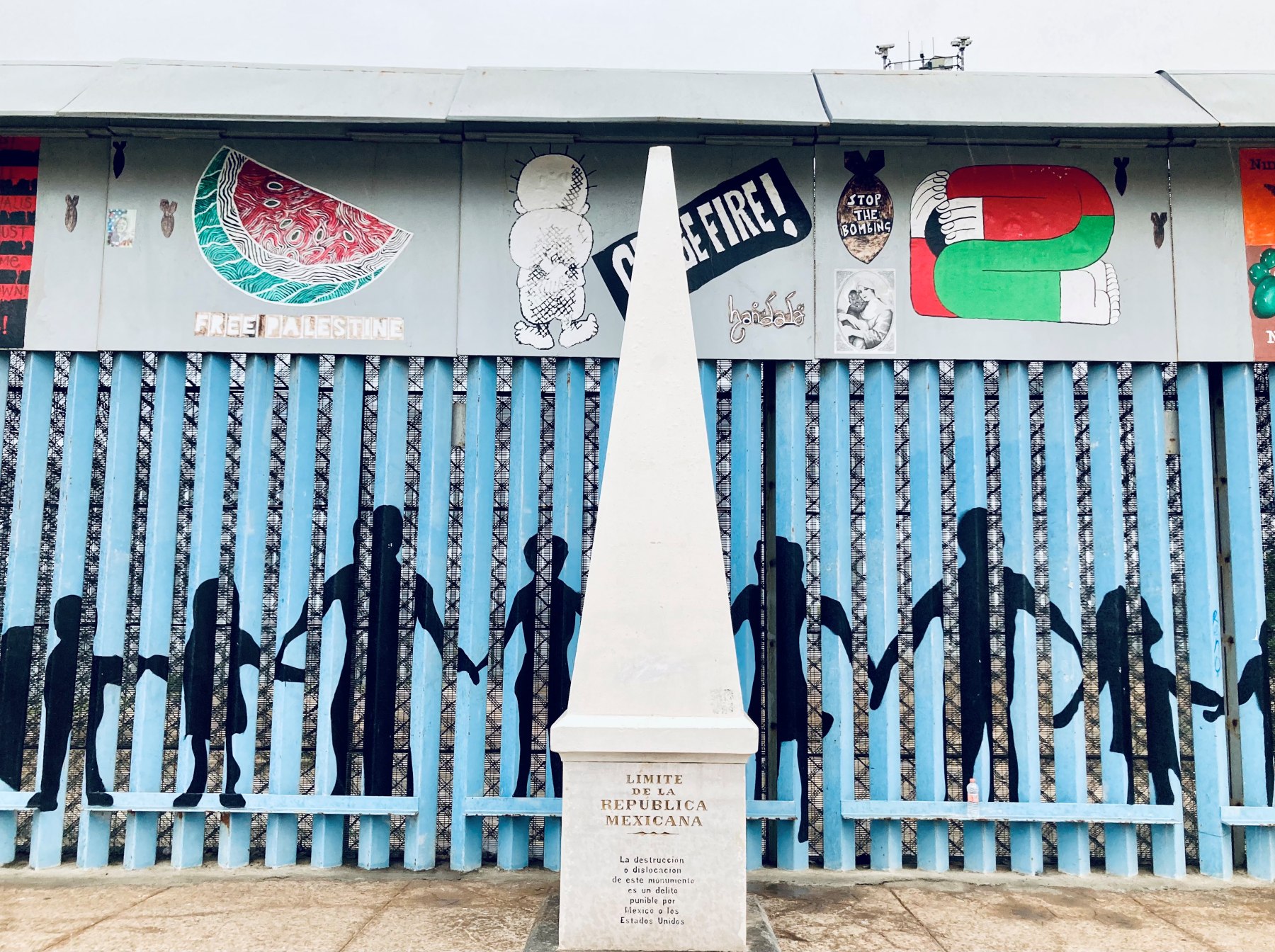
Handala in the corner of the world.
Marco Vinicio Morales Muñoz, Tijuana, Baja California, Mexico, February 13, 2025.
Handala, a symbol of the Palestinian people, is depicted on the Tijuana border wall along with other aesthetic elements and anti-war graphic designs that refer to the Israeli-Palestinian conflict.
Censorship in the media and shouting in the streets
Ilze Nava, Zócalo de la CDMX, February 17, 2024.
Demonstration for Free Palestine 2024.
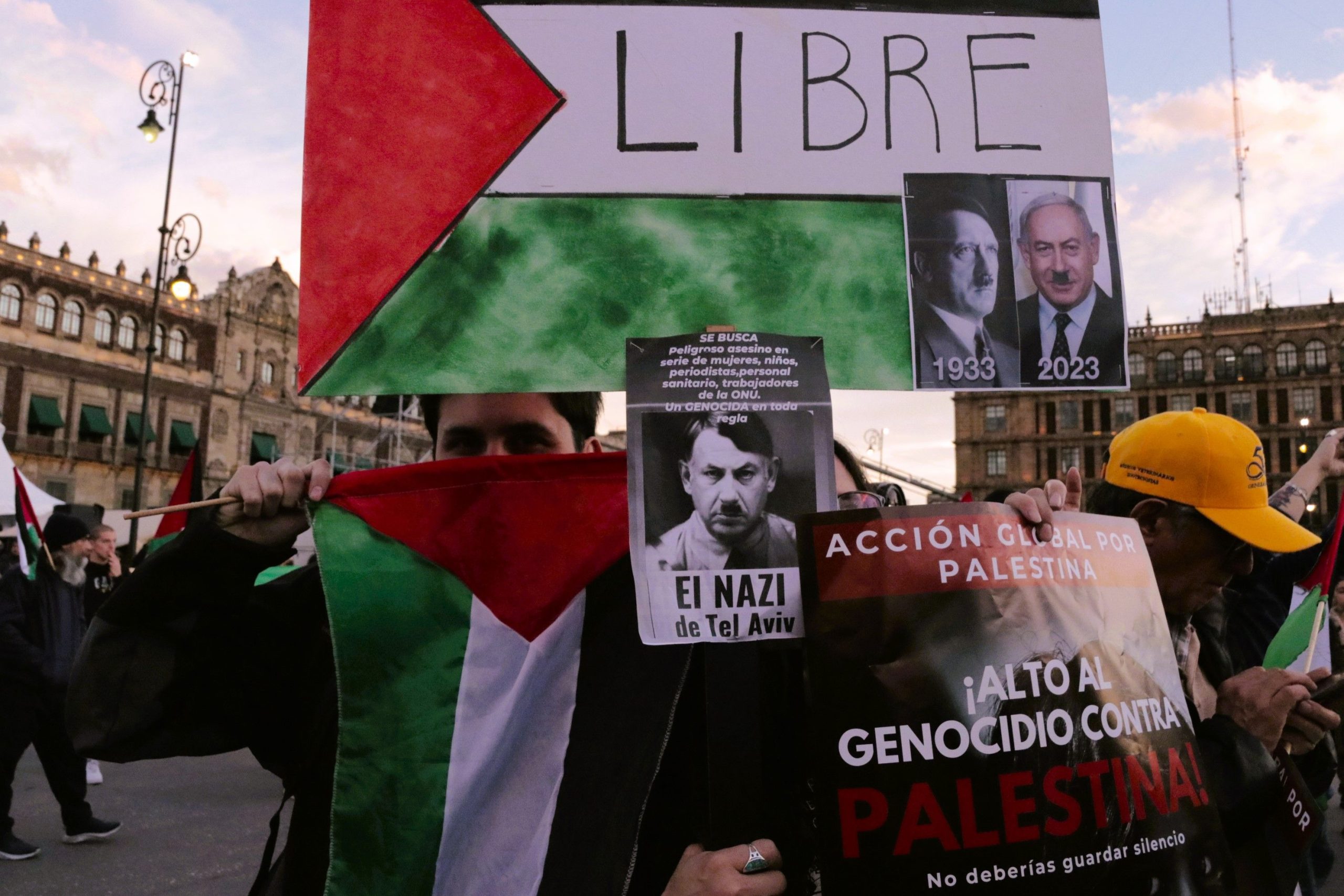

Journalists at FIL
Pilar Aranda, Expo, Guadalajara (FIL), December 5, 2024.
On the occasion of the XX International Meeting of Journalists, a protest was held in the vicinity of the International Book Fair in Guadalajara, it is reported that in the "conflict" there are close to 200 journalists murdered.
Bibliography
Anderson, Benedict (1993). Imagined communities. Reflections on the origin and spread of nationalism.. Mexico: FCE.
Bhabha, Homi K (2011). The place of culture. Buenos Aires: Spring.
Rancière, Jacques (2009). The distribution of the sensitive. Santiago de Chile: lom.
El monocultivo y el “ecuaro”: Aspectos y genealogías de la modernización agrícola en San Miguel Zapotitlán, México
Rubén Díaz Ramírez
Universidad Autónoma Metropolitana – Unidad Iztapalapa, México
es doctor en Antropología Social por la Universidad Iberoamericana. Actualmente realiza una investigación postdoctoral en la UAM-Iztapalapa. En su trayectoria académica se ha dedicado a la investigación histórica y etnográfica sobre diversos aspectos de las transformaciones sociotécnicas, así como los imaginarios del progreso, la modernización y el desarrollo en varias localidades del municipio de Poncitlán, Jalisco. Su trabajo actual versa sobre la antropología e historia tecno-ambiental de Poncitlán, con énfasis en San Miguel Zapotitlán.
ORCID: https://orcid.org/0000-0002-4424-0001
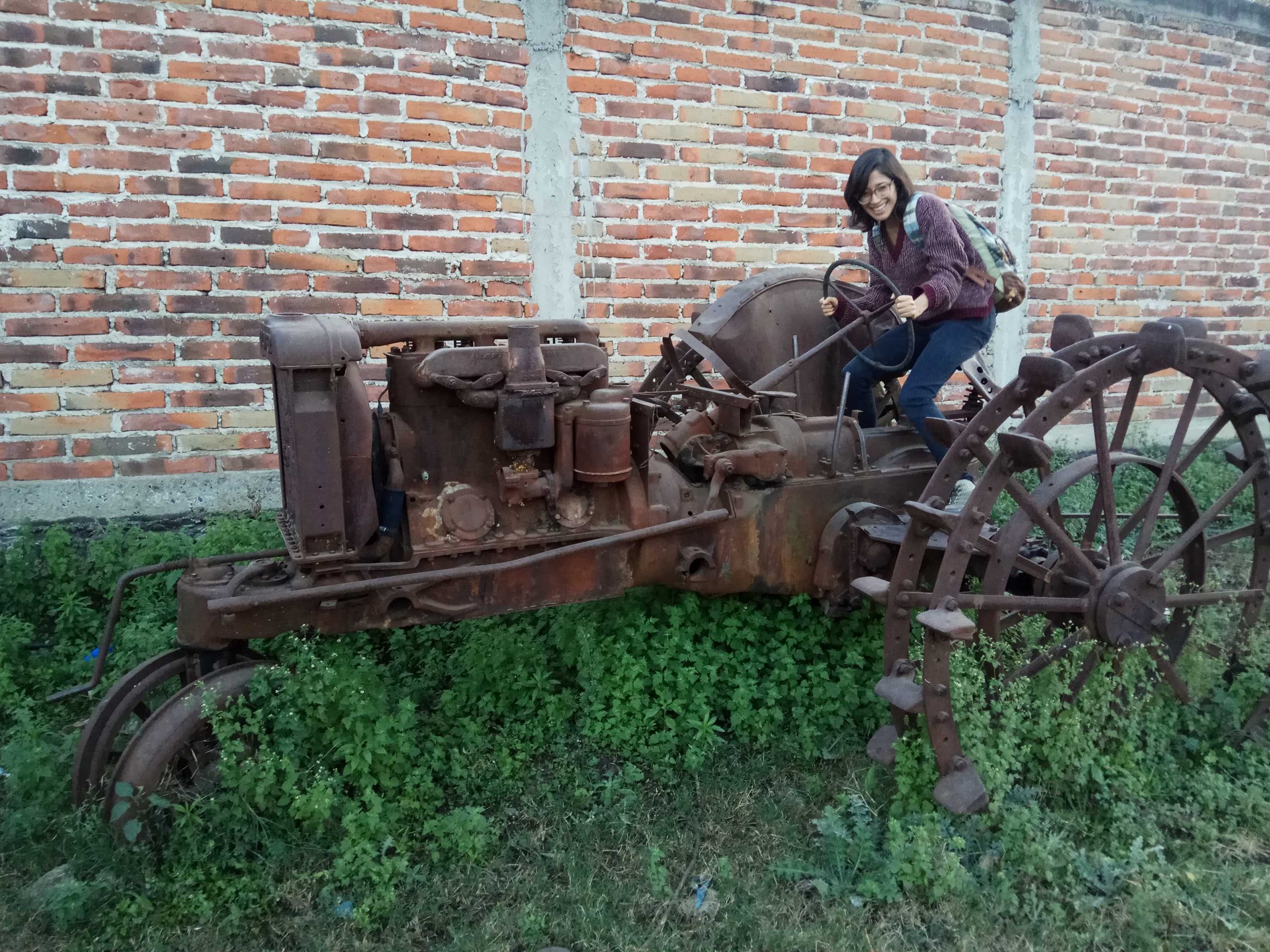
Imagen 1. Fantasmas y ruinas del progreso
San Miguel Zapotitlán, 16 de enero de 2022.
(Mariana en el viejo tractor Oliver del ejido) La agricultura es un modo de vida en la que los fantasmas y ruinas de los proyectos del pasado perviven visibles e invisibles, apacibles y violentos, efímeros y perdurables. Este modelo de tractor Oliver fue una de las insignias de la “modernización” de la agricultura ejidal en la década de 1950. En sus ruinas jugaron los niños de la generación nacida en la década de 1980.
Imagen 2. Resignificación de las infraestructuras del progreso
San Miguel Zapotitlán, 07 de marzo de 2022.
(Antiguas oficinas de CONASUPO, ahora Castariz) Una de las funciones de CONASUPO fue evitar los abusos de los intermediarios (conocidos como coyotes) en la comercialización del maíz. En el paisaje rural mexicano abundan estas ruinas que se asemejan a los templos mesoamericanos. En la Imagen 2 aparecen las bodegas de San Miguel Zapotitlán. El ejido renta las bodegas a Agropecuaria Castariz y a Integradora Arca, que se apropiaron simbólica y funcionalmente de las materializaciones de los sueños del progreso de la agricultura mexicana del siglo XX.

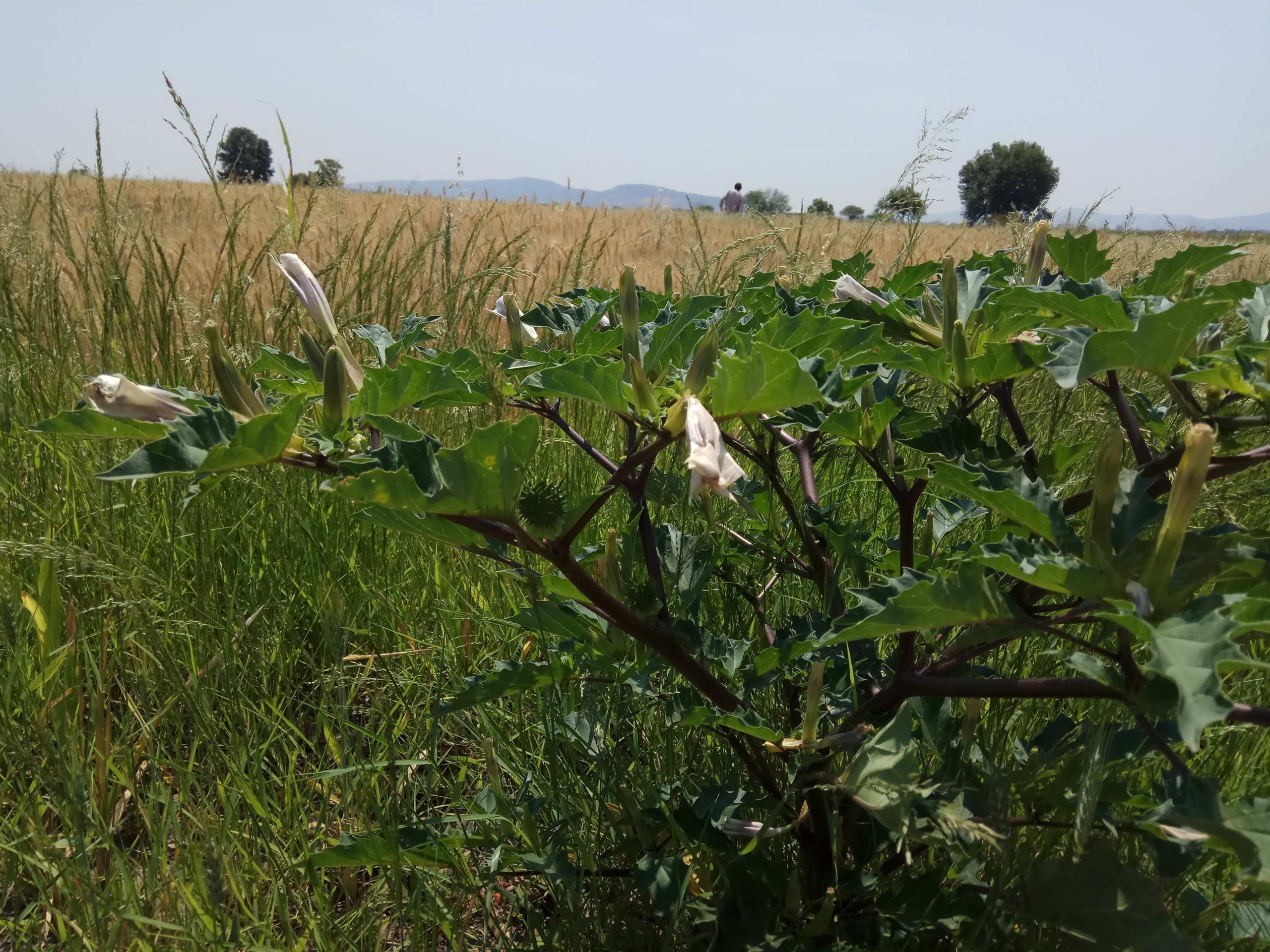
Imagen 3. Presencias no humanas residuales
Potrero Barranquillas, 07 de mayo de 2021.
(Datura floreciendo en un callejón cerca del trigo) Sujetar la agricultura a las cadenas productivas de la industria a mediados del siglo XX resultó no solo en el sometimiento de los campesinos a la producción de alimentos para el mercado urbano, también produjo el desplazamiento o aniquilación de otras especies clasificadas como “malezas” o “plagas”. Los callejones (áreas entre parcelas) son espacios residuales, albergan especies que también son residuales y por ello sobreviven a los agroquímicos. En la Imagen 3, una planta de toloache común, quizás Datura stramonium L.
Imagen 4. Visitantes inesperados
Potrero Barranquillas, 06 de diciembre de 2018.
(“Avenilla” en el callejón) Historias de seres vivientes perviven en el paisaje. Así como un día los castellanos trajeron sus especies del otro lado del océano, en el siglo XX se introdujeron maíces híbridos, sorgos y variedades de trigo exógenas. Los caminos quedaron trazados para el arribo de otras especies inesperadas. Por ejemplo, la “avenilla” (posiblemente Themeda quadrivalvis), que coloniza áreas perturbadas en cerros y carreteras, es un indicio de su trasiego encima de la maquinaria agrícola.

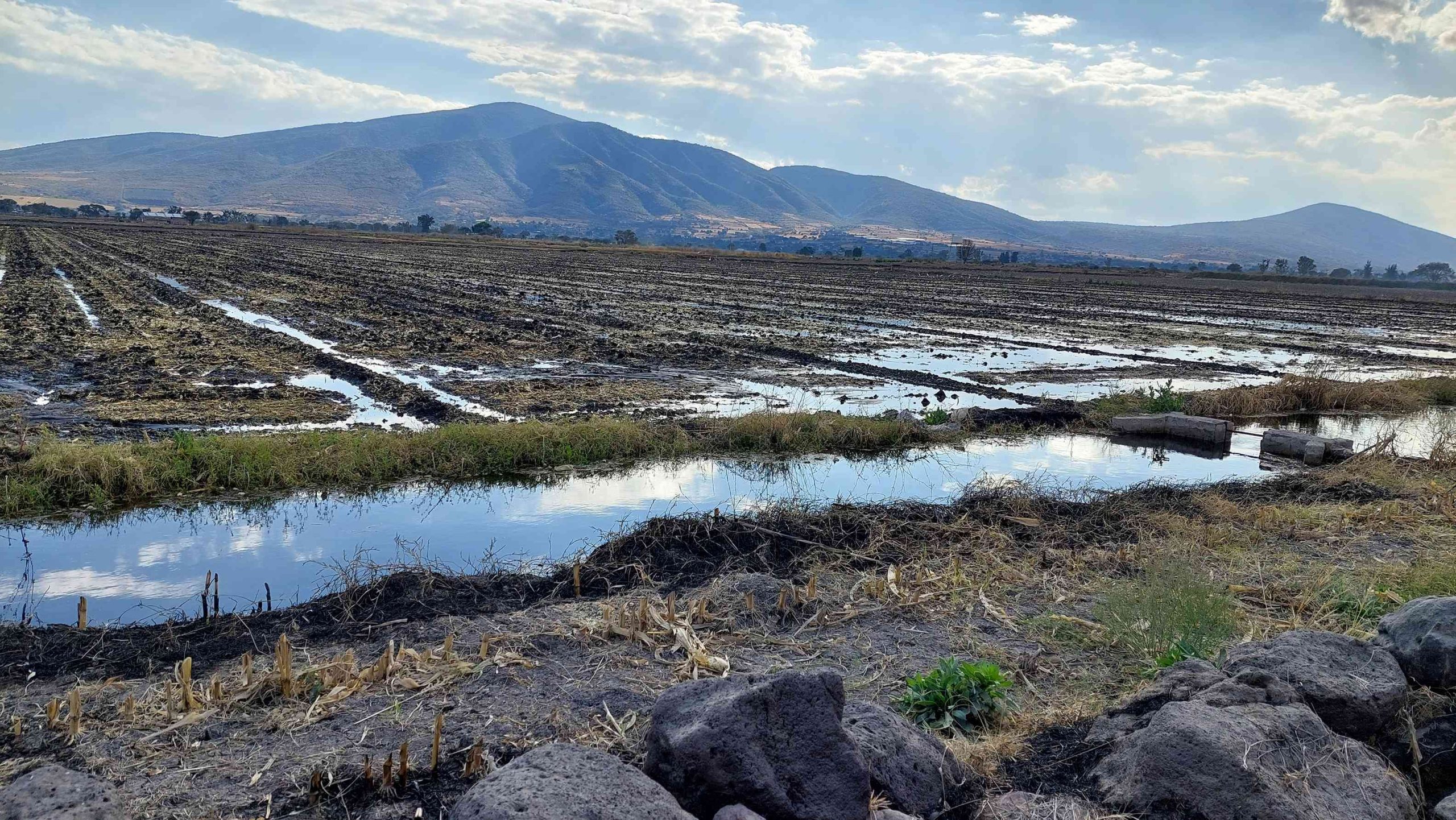
Imagen 5. El trigo: regar con agua contaminada del río Santiago
Potrero Barranquillas, 11 de enero de 2023.
(Riego “rodado” con agua del río) Los sistemas de riego son infraestructuras que conjuntan tiempos. En el siglo XIX, pequeños propietarios y hacendados acapararon las tierras de riego, pero los campesinos ganaron su derecho al agua en la reforma agraria del siglo XX. Estos sistemas aprovechan zanjas, canales, bordos y represas, algunas provienen de la época de las haciendas, otras fueron abiertas en los años de la reforma agraria.
Imagen 6. El trigo entre tradición e industria
Potrero Barranquillas, 21 de enero de 2023.
(La “raya” para guiar el agua por la parcela) Los agricultores y regadores son unos expertos en ver el terreno y usar la gravedad para dirigir las aguas dentro de las parcelas para regar el trigo. Este conocimiento se transmite a través de las generaciones. El líquido para el riego se extrae o se canaliza desde el río Santiago, en cuyo cauce las empresas del corredor industrial desechan sus residuos tóxicos. Como se observa, la “naturaleza” y la agricultura están contenidas por la tradición y por la industria de maneras poco evidentes.

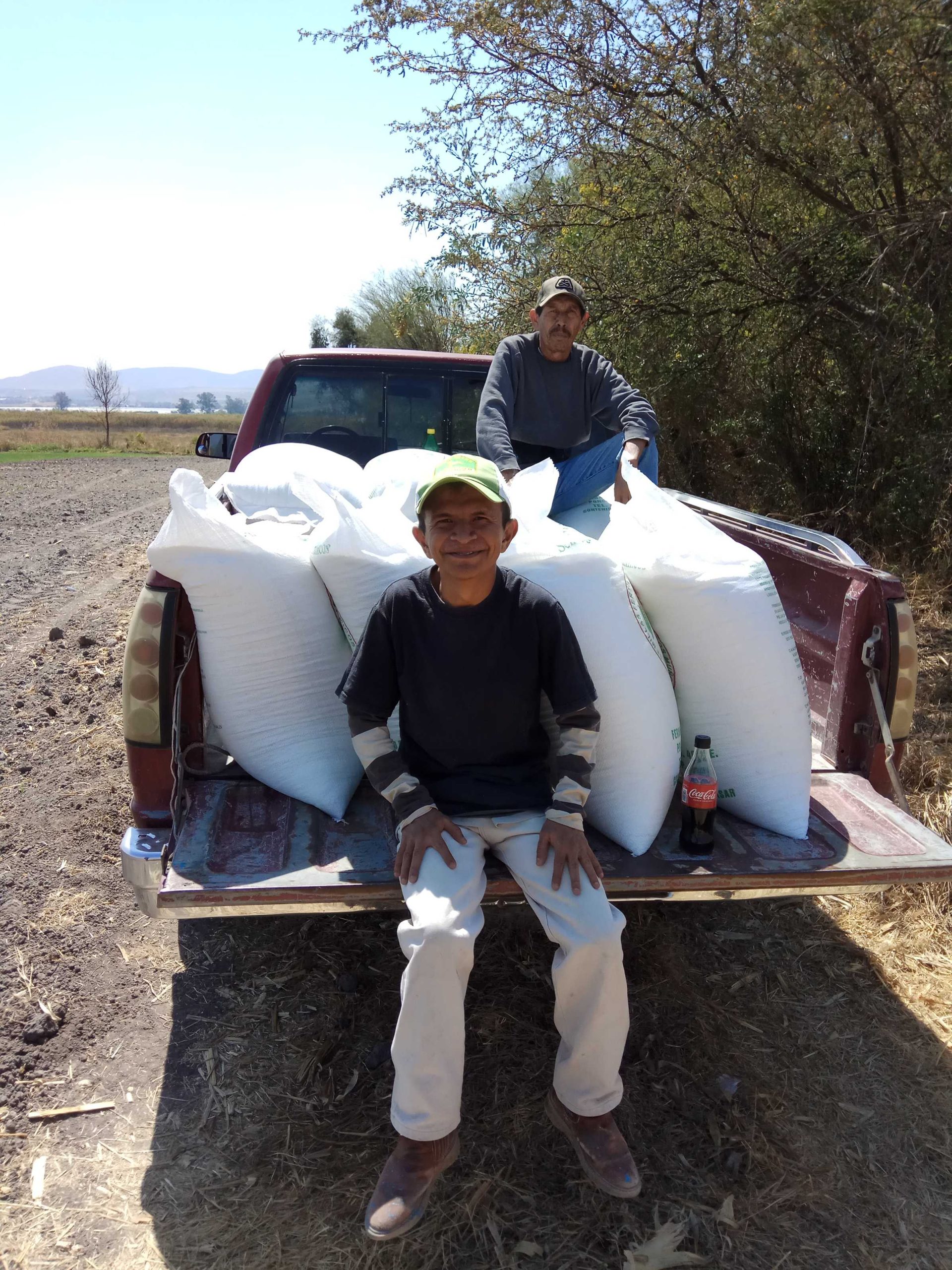
Imagen 7. Dependencia: el monocultivo y los fertilizantes químicos
Potrero Barranquillas, 23 de febrero de 2021.
(Los dos Martín entre costales de urea). La agricultura comercial depende de los fertilizantes químicos. Entre 2021 y 2022 el precio de la urea alcanzó en la región hasta los 24 000 pesos por tonelada; 18 000 pesos según otras fuentes (Index Mundi 2023). La situación se agravó por la escasez provocada por la guerra entre Rusia y Ucrania, iniciada el 24 de febrero de 2022.
Imagen 8. Una dupla esencial: el monocultivo y el nitrógeno
Bodega Libertad, San José de Ornelas, 10 de junio de 2023.
(Sulfato de amonio y tarimas de Monsanto) El desabasto de urea y la guerra Rusia-Ucrania provocaron aumentos en el precio de la urea y por tanto en los gastos de producción por hectárea del maíz, 5 o 10 000 pesos más que en años anteriores. En una charla entre agricultores escuché: Estados Unidos nos lleva “muchísima ventaja” porque allá ya existen las sembradoras y los aplicadores de fertilizante que dosifican la cantidad suficiente por metro cuadrado. En México, al contrario, se “tira parejo”. Por eso, “las tierras que no lo necesitan se vuelven mejores y las que lo necesitan peores porque no reciben el fertilizante necesario” (Diario de campo, 29 de mayo de 2022).
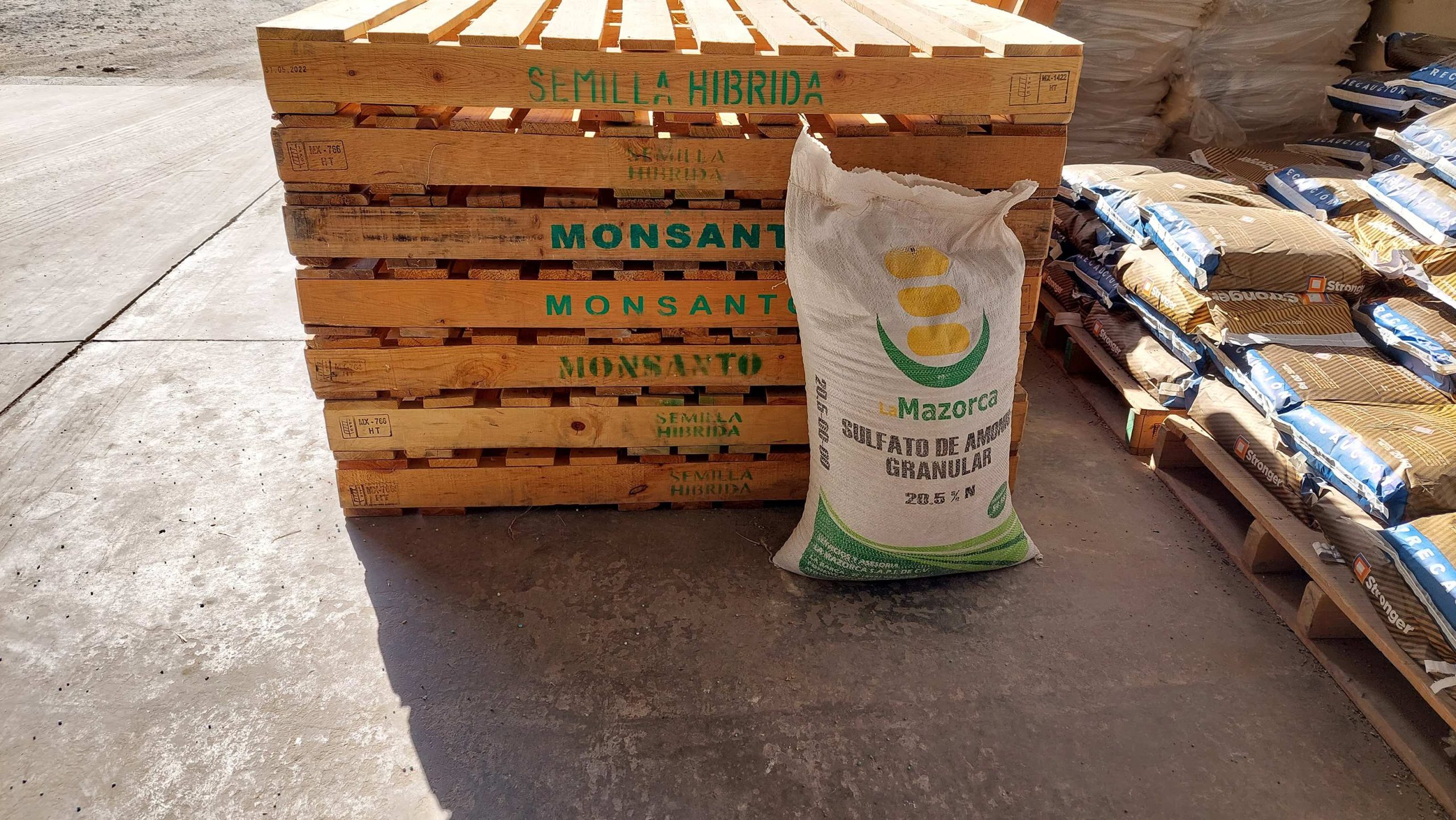
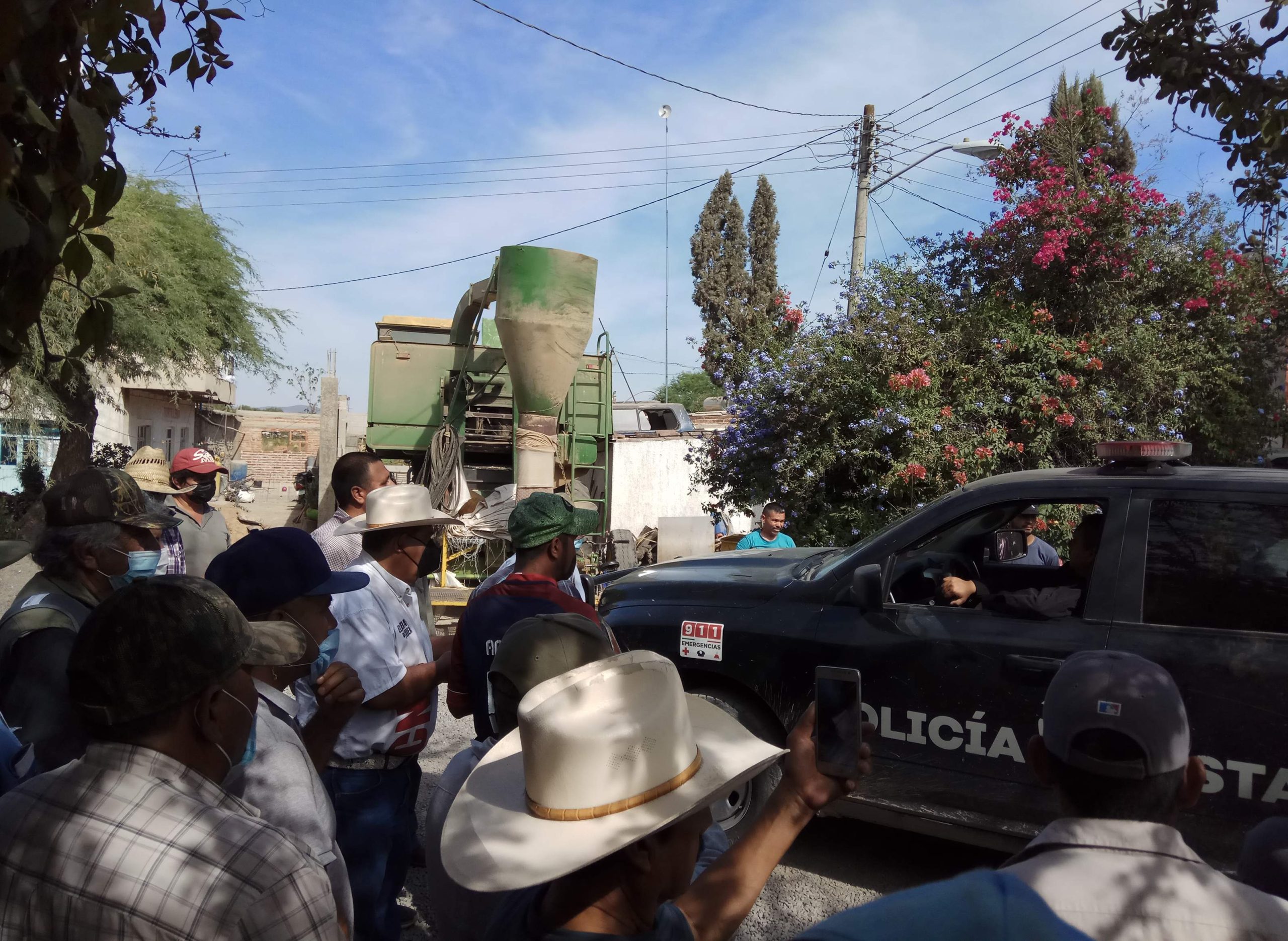
Imagen 9. Cuando se alteran los ensamblajes
La Constancia, Zapotlán del Rey, 27 de marzo de 2021.
(Agricultores ven pasar una patrulla) El 22 de marzo de 2021, Día Mundial del Agua, los policías estatales destruyeron equipos de arranque del sistema de bombeo de varios de los ejidos de la región y retrasaron el riego en una etapa crítica del ciclo del trigo. Con estas acciones el gobernador de Jalisco, Enrique Alfaro, responsabilizó a los agricultores de la crisis de abastecimiento de agua potable que sufría la ciudad de Guadalajara e intentó granjearse la simpatía de sus gobernados con el típico recurso de enfrentar el campo con la ciudad.
Imagen 10. Cuando se alteran los ensamblajes
La Constancia, Zapotlán del Rey, 27 de marzo de 2021.
(Agricultores organizados) Los agricultores buscaron el diálogo con el gobierno. Al final, se acordó que se restaurarían los equipos, pero las afectaciones ya estaban hechas. Las cosechas fueron de dos a tres toneladas por hectárea, la mitad o menos del promedio en años normales. El precio del trigo fue de 4 500 pesos la tonelada. Los ingresos de nueve mil pesos, en el caso de cosechas de dos toneladas por hectárea, son insuficientes, ni siquiera cubren la mitad de los gastos de producción.


Imagen 11. El agave
Potrero Barranquillas, 15 de septiembre de 2022.
(Nuevos cultivos en el ejido) La sequía, las acciones del gobierno estatal, los altos precios de insumos agrícolas y la expansión del mercado del tequila orillaron a varios agricultores a rentar sus parcelas a productores de agave (tequilana Weber). La fiebre por el agave surge en parte por el alto precio que alcanzó durante el periodo 2019-2021. Según una nota del periódico en línea UDG TV, “el precio del kilogramo del agave […] superó los 30 pesos, [30 veces más caro] que en 2006 cuando se vendía en 1 peso” (García Solís, 2020). En 2024, el precio varía entre 15 y 8 pesos el kilogramo.
Imagen 12. Eliminar especies sin valor
Potrero Barranquillas, 21 de febrero de 2019.
(Preparación del tanque de fumigación para el trigo) El monocultivo implica la eliminación sistemática de cualquier especie animal o vegetal que “compite” por espacios y recursos con las plantas cultivadas. Como apunta Gilles Clément, “la erradicación de una especie invasiva es siempre un fracaso: es afirmar que el estado actual de nuestros conocimientos no nos permite otro recurso que la violencia” (2021: 19). Uno de los herbicidas post emergentes más usados en San Miguel Zapotitlán se llama Ojiva (Paraquat), una prueba más del vocabulario bélico que pervive en la agricultura (Romero, 2022:51).
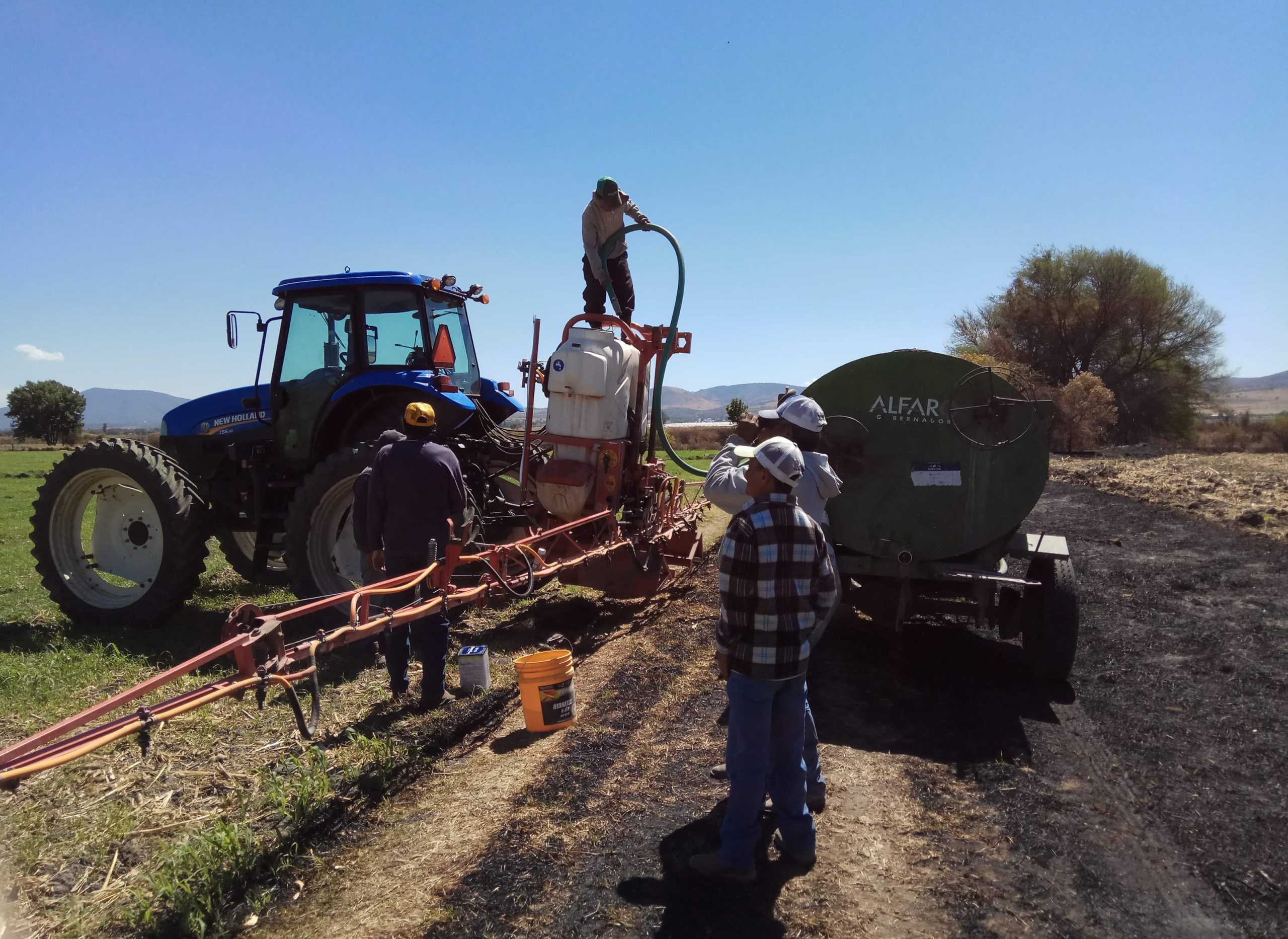
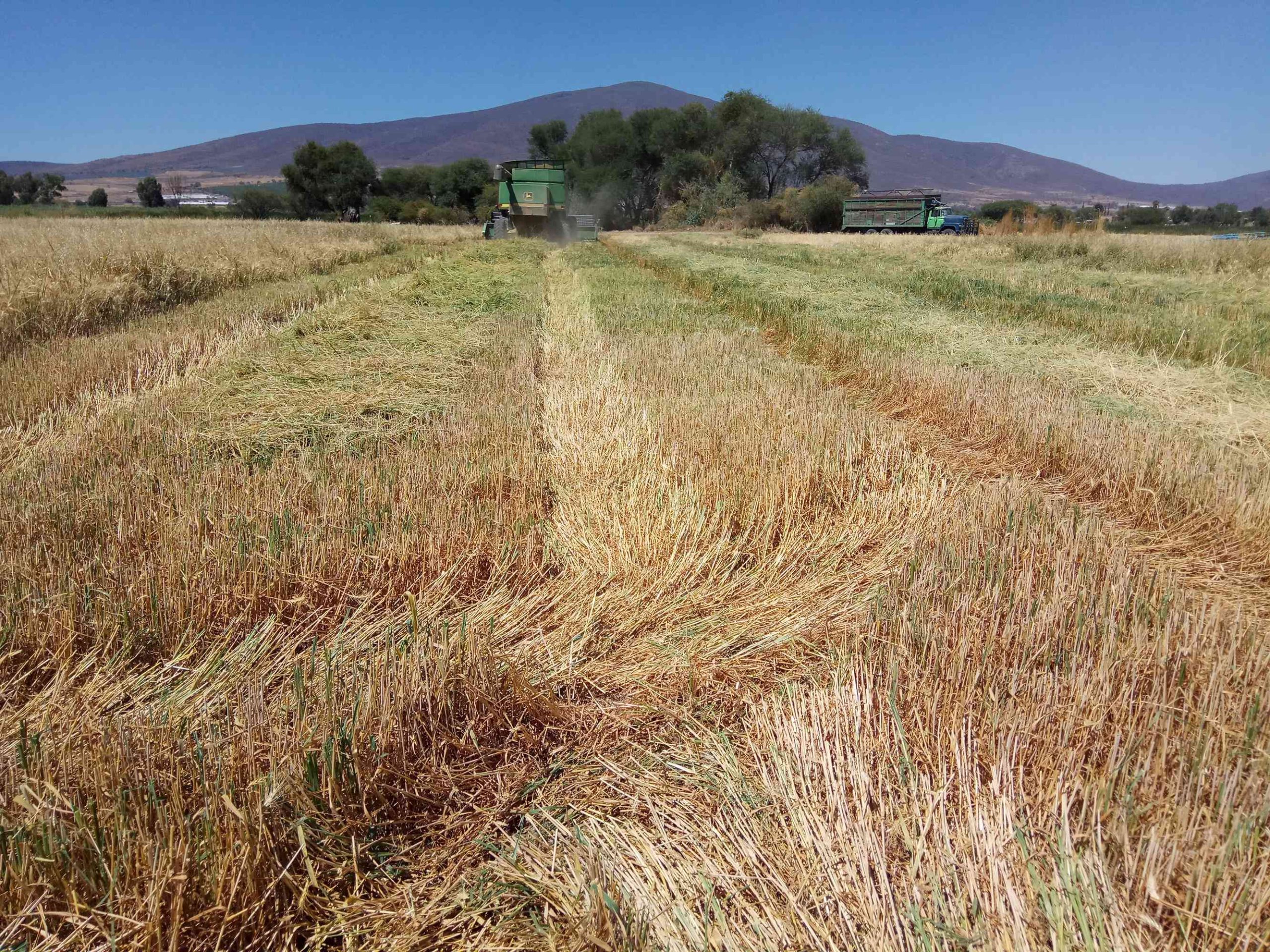
Imagen 13. La cosecha
Potrero Barranquillas, 19 de mayo de 2021.
(Los rastros verdes de otras especies entre el trigo) El trigo se cosecha a mediados de mayo. Este cereal fue la insignia de las haciendas de la región hasta la Revolución Mexicana de 1910 y se convirtió en el centro de atención de la ciencia agronómica a partir de 1940 (Olsson, 2017: 150). Variedades de trigo mexicanos se exportaron a países tan distantes como India, con lo que se crean más corredores globales biotecnológicos.
Imagen 14. Las máquinas
Potrero Barranquillas 19 de mayo de 2021.
(Cosechadora cargando trigo en el camión Dina) Uno de los símbolos visibles de la modernización agraria en esta región son las máquinas. Desde la década de 1960 el trabajo en los ejidos de Poncitlán es inimaginable sin trilladoras, tractores y camiones de carga. Los camiones transportan los granos hasta las fábricas Barcel, Kellogg´s, Bimbo, Ingredion, Cargill o PEPSICO, donde transforman los cereales en productos industriales que después regresan en camiones repartidores a los comercios en donde los agricultores los compran en forma de mercancía.
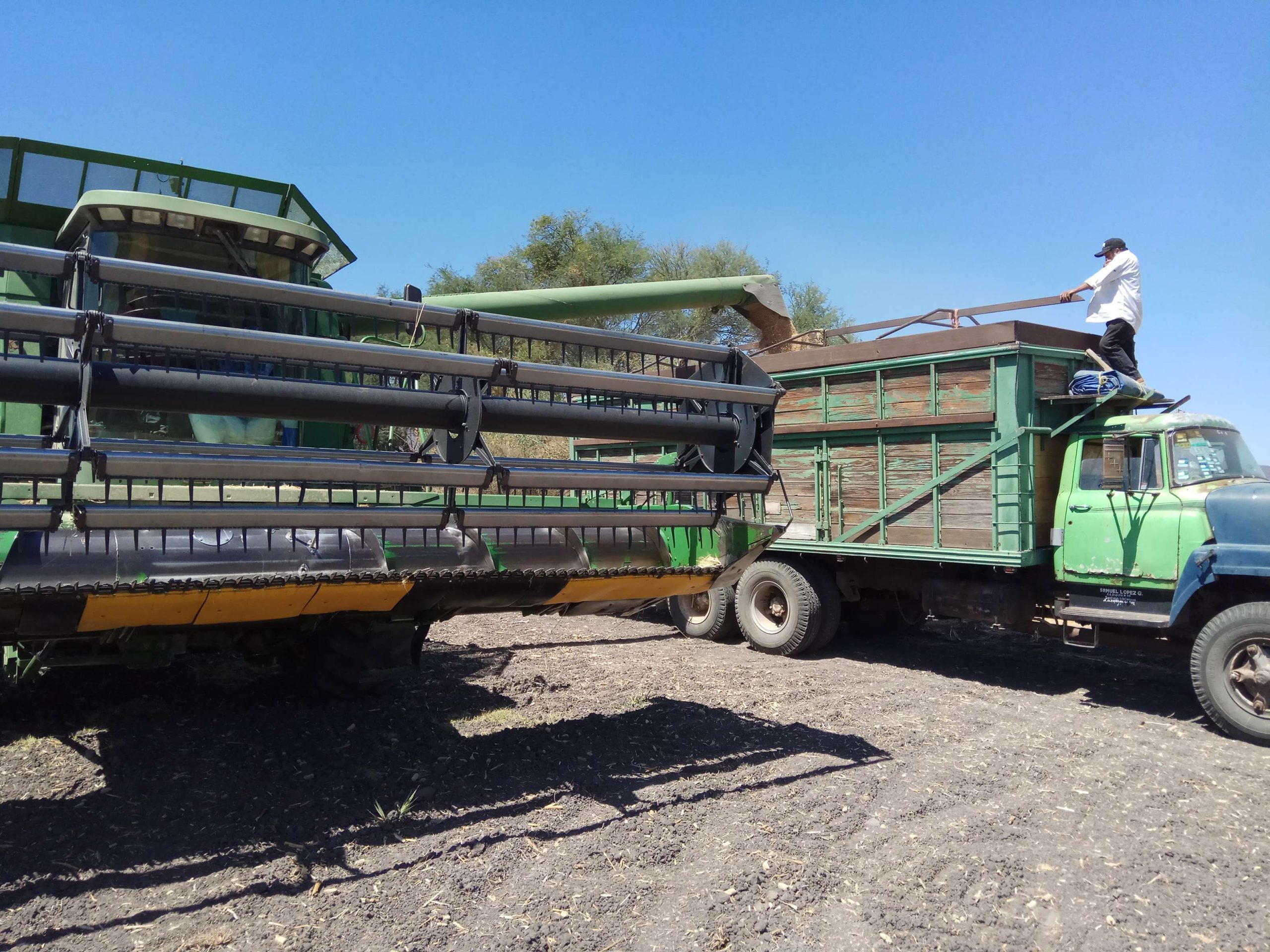
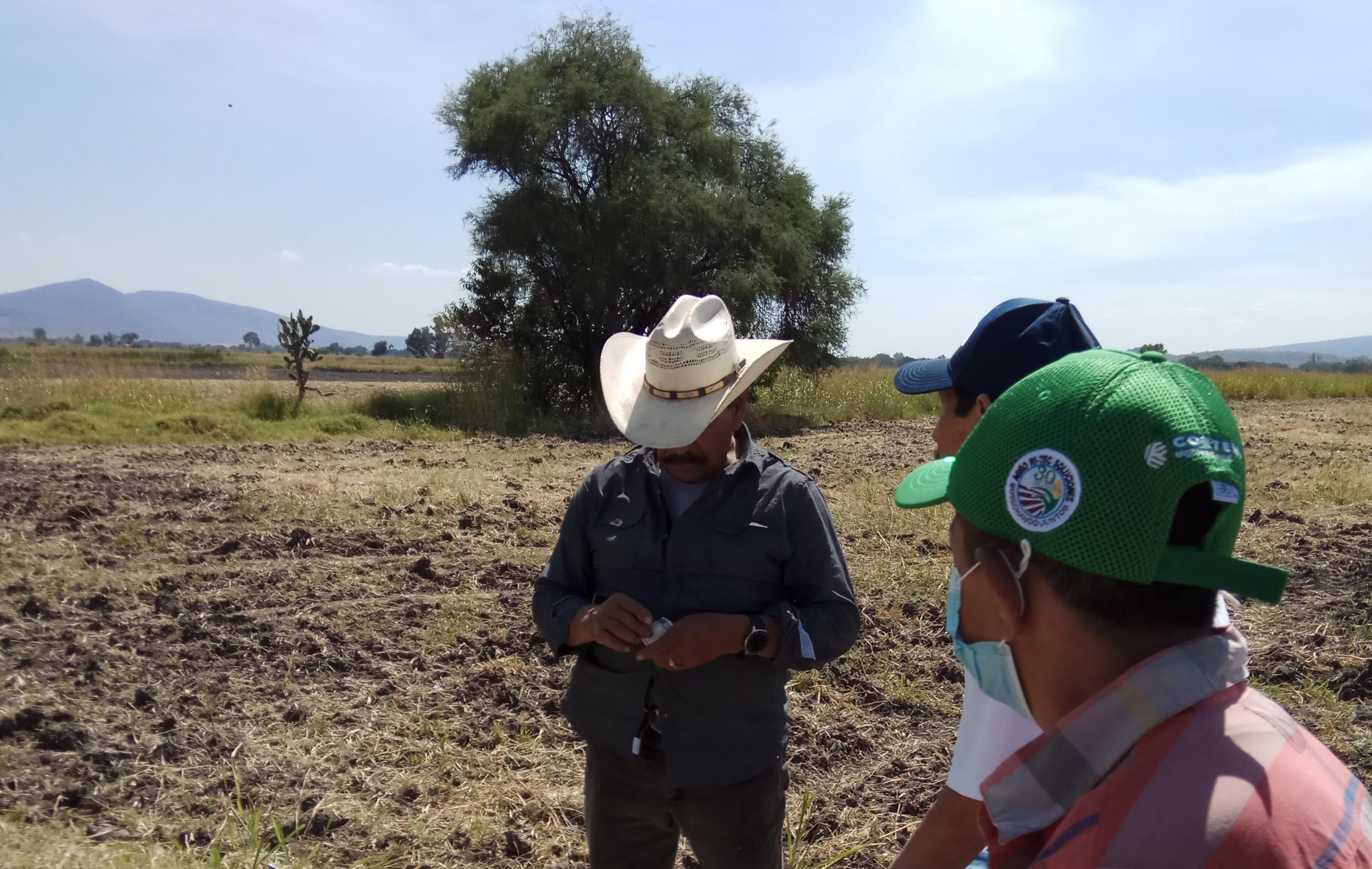
Imagen 15. Pagar la maquila
Potrero Barranquillas, 11 de junio de 2021.
(Pagar a tiempo la maquila) A mediados de la década de 1980 los ejidatarios compraron maquinaria agrícola para uso individual. Por diversas razones, estos agricultores fueron perdiendo su maquinaria hasta depender de los maquiladores: dueños de tractores, sembradoras, cosechadoras y demás equipo que rentan sus servicios a quienes los requieran. Esta es otra de las razones por las que el minifundio se encuentra en retroceso.
Imagen 16. De maíz mesoamericano a semilla híbrida
Potrero Barranquillas, 11 de junio de 2021.
(Jornalero revisando la semilla híbrida de maíz) Hay algo inquietante en el hecho de que las compañías privadas que comercializan semillas híbridas de maíz sean dueñas de “miles de años de conocimientos acumulados por millones de productores” que han sido depositados en la semilla como “plasma germinal” (Warman, 2003: 185). Los agricultores de Poncitlán dependen de estas empresas para comprar semilla año con año desde mediados del siglo XX. En ese entonces, a los híbridos les llamaban “maíz del gobierno” (Diario de campo, 25 de junio de 2022).
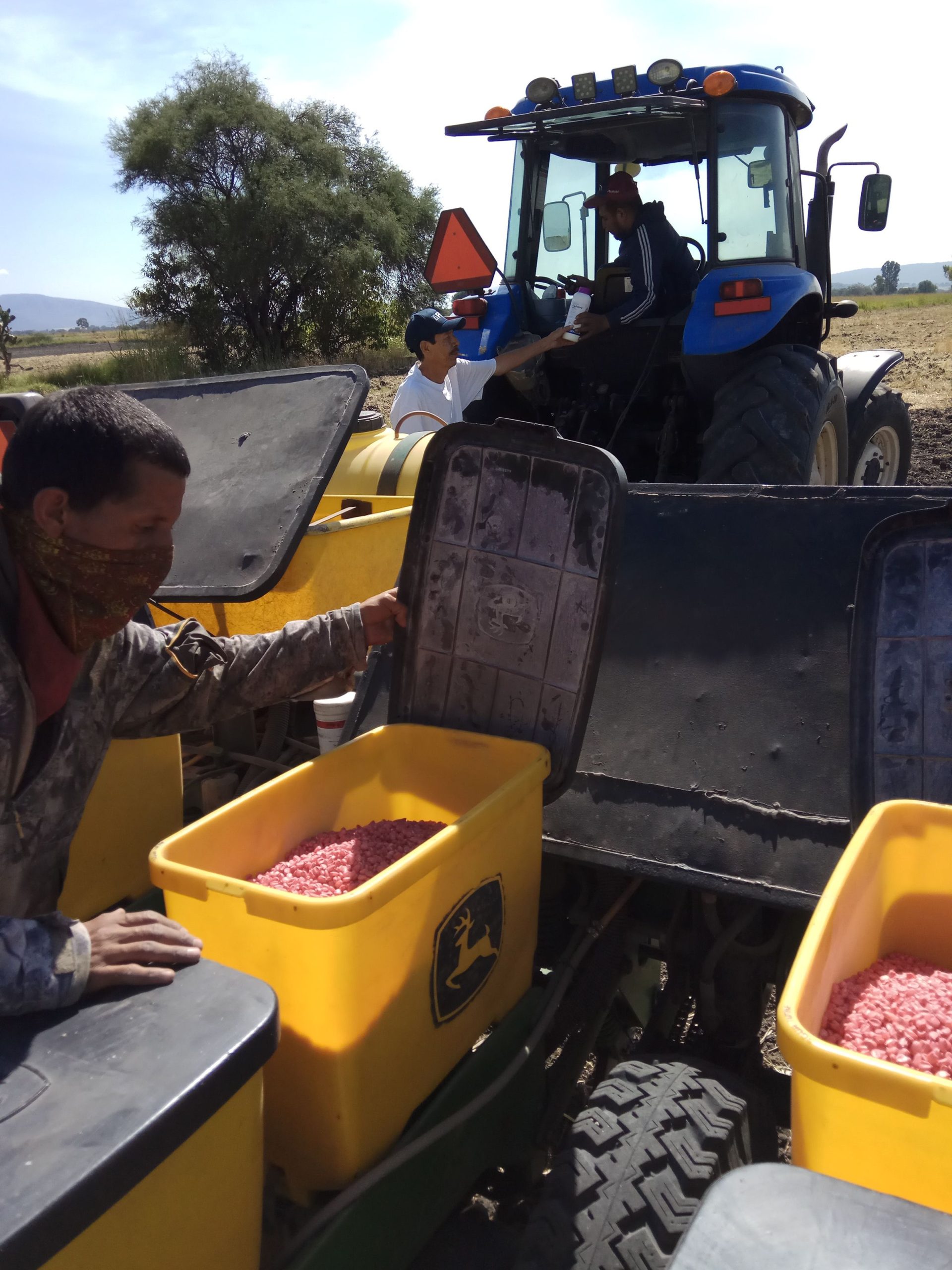

Imagen 17. La siembra genera tensión
Potrero Barranquillas, 10 de junio de 2023.
(Los agricultores supervisan la siembra correcta del maíz) La siembra del maíz inicia a finales de mayo, cuando han caído las primeras lluvias. La siembra genera tensiones nerviosas en los agricultores porque, como me comentó uno de ellos: “Tenemos tirado el dinero en las parcelas”. La inversión para producir maíz en 2018 se encontraba entre los 20 y 30 000 pesos por hectárea (Diario de campo, 2 de junio de 2018). Durante el 2023 la inversión fue de alrededor de 40 000 pesos por hectárea.
Imagen 18. La siembra a la hora que sea necesaria
Potrero Barranquillas, 10 de junio de 2023.
(Noche de siembra del maíz) Hay que mirar al cielo en busca de los indicios del clima. En 2022 una serie de tormentas reblandecieron los suelos del ejido, luego paró de llover hasta bien entrado el mes de junio. La lluvia ocasionó el retraso de las siembras y la resequedad marchitó las plantas que nacieron para encontrarse expuestas bajo un sol inclemente con apenas algo de humedad. Por eso, la siembra se realiza a la hora que sea necesaria, incluso por la noche, porque es imperativo bregar entre los cambios climáticos.


Imagen 19. Eliminar la competencia del maíz
Potrero Barranquillas, 22 de junio de 2022.
(Los jornaleros rellenan las bombas de aspersión) Los jornaleros están en contacto directo con los pesticidas. Según un estudio, cada año en el mundo 385 millones de personas enferman por envenenamiento con plaguicidas (Chemnitz et al., 2022: 18). Pero los efectos de los pesticidas en la salud humana alcanzan incluso a los consumidores urbanos de frutas y verduras contaminados por residuos invisibles.
Imagen 20. Quemar
Potrero Barranquillas, 22 de junio de 2022.
(Los jornaleros eliminan el “mostrenco”) Se le llama “mostrenco” a la milpa que nace de los granos de maíz que no alcanzan a ser recolectados por las máquinas cosechadoras. Es una planta rebelde que germina donde no debería: afuera de las líneas de los surcos. A la labor de eliminar el mostrenco y otras malezas los agricultores la llaman “quemar”, porque cuando el herbicida actúa sobre las plantas las seca, coloreándolas de dorado, amarillo o blanco. Un cultivador preguntó a un ingeniero por qué la ciencia no ha inventado un agroquímico que acabe de manera definitiva con este problema, a lo cual el ingeniero respondió entre veras y bromas: “¿Si acabamos con eso, qué veneno les vamos a vender?” (Diario de campo, 18 de octubre de 2018).
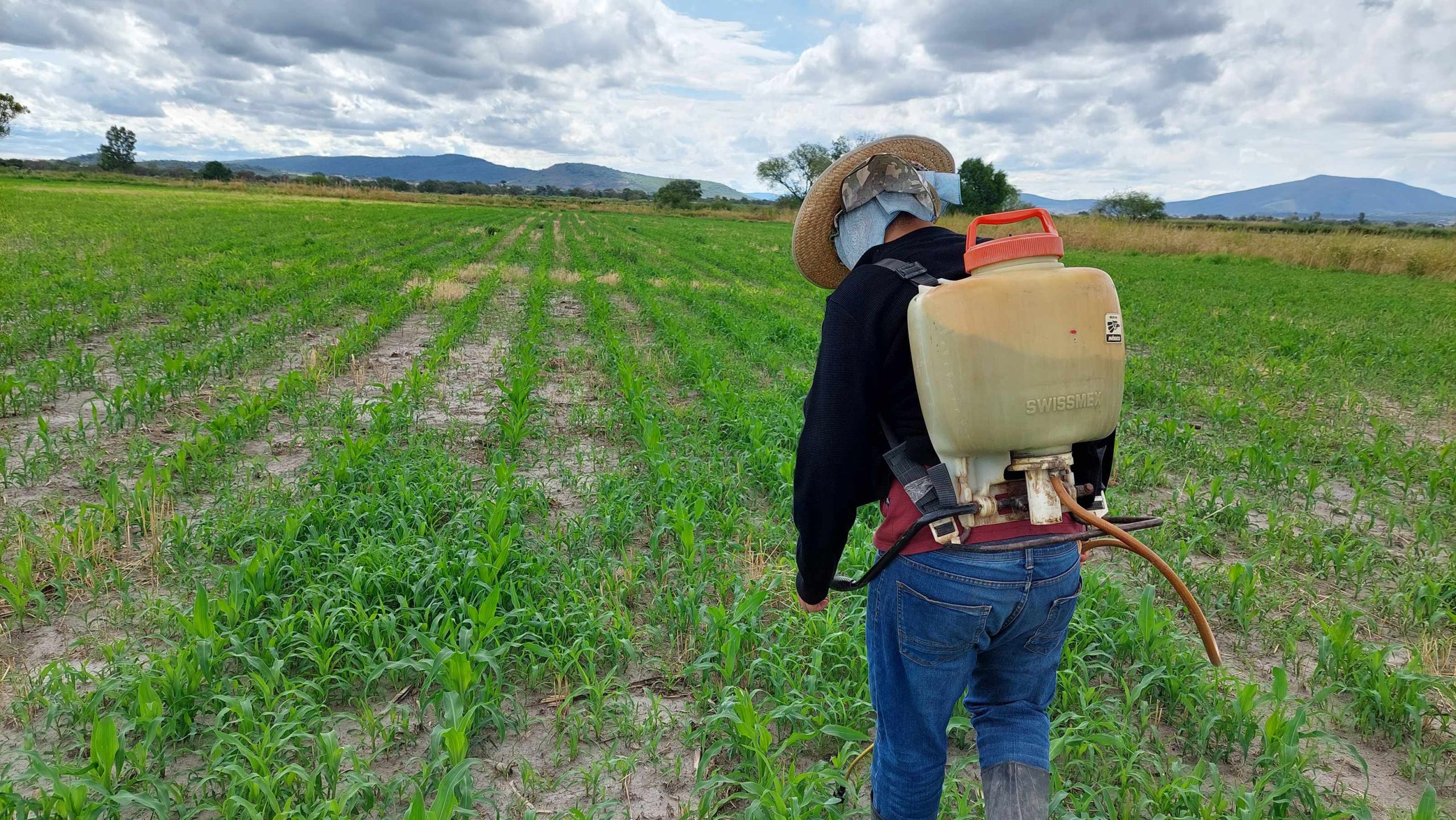
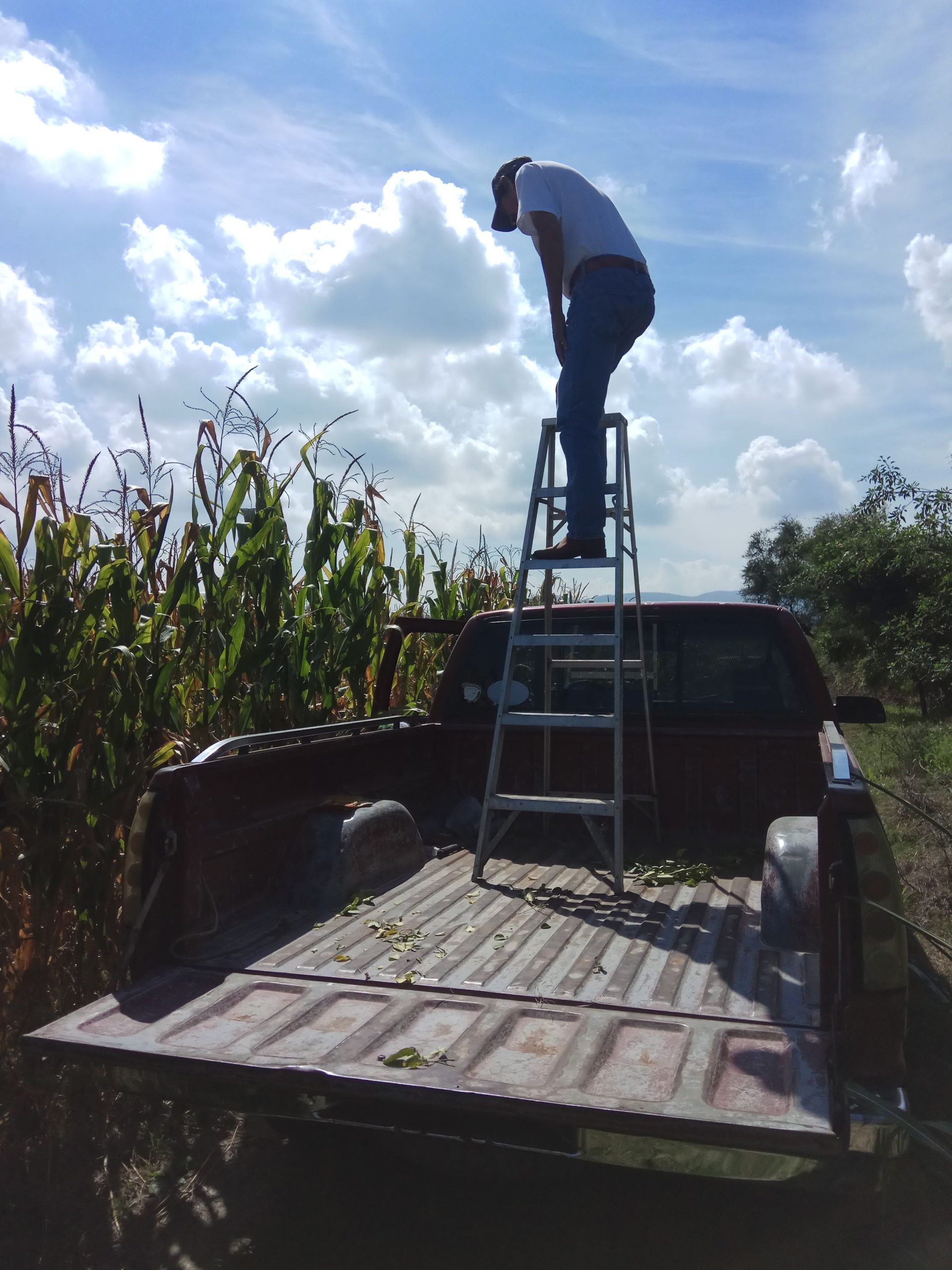
Imagen 21. Mirar la siembra
Potrero Barranquillas, 31 de octubre de 2018.
(Arriba, para mirar mejor las parcelas) La agricultura implica mirar. Lo anterior significa andar por la superficie de la parcela, levantar el polvo, auscultar por surcos mal alineados, sacar plantas agonizantes a la superficie, arrancar la maleza, ensanchar un canal con una pala; sentirse triste por las plantas nonatas. Ya que este mirar es una forma de conocer el mundo, “moviéndolo, explorándolo, atendiéndolo, siempre alerta al signo por el cual se revela” (Ingold, 2000: 55). El cultivo “moderno” depende de estas intuiciones “tradicionales” y sensibles.
Imagen 22. El acto de mirar en agricultura
Potrero Barranquillas, 21 de febrero de 2019.
(Mirar el trigo) El acto de mirar en la agricultura de San Miguel Zapotitlán es una búsqueda por signos de malos enredos de las múltiples especies y sus temporalidades. El agricultor observa entre las raíces y las hojas: Si el color es amarillento, es necesario fertilizar. Si las hojas están como mordisqueadas, es a causa de los gusanos. Está atento al desarrollo de hongos, mayates o gusanos cogolleros. Se siente satisfecho cuando la mayoría de las plantas refulgen con un verde oscuro y la población de plantas en la parcela luce homogénea. ¿Cuán distinto es el observar de los modernos urbanos al de los agricultores y campesinos?
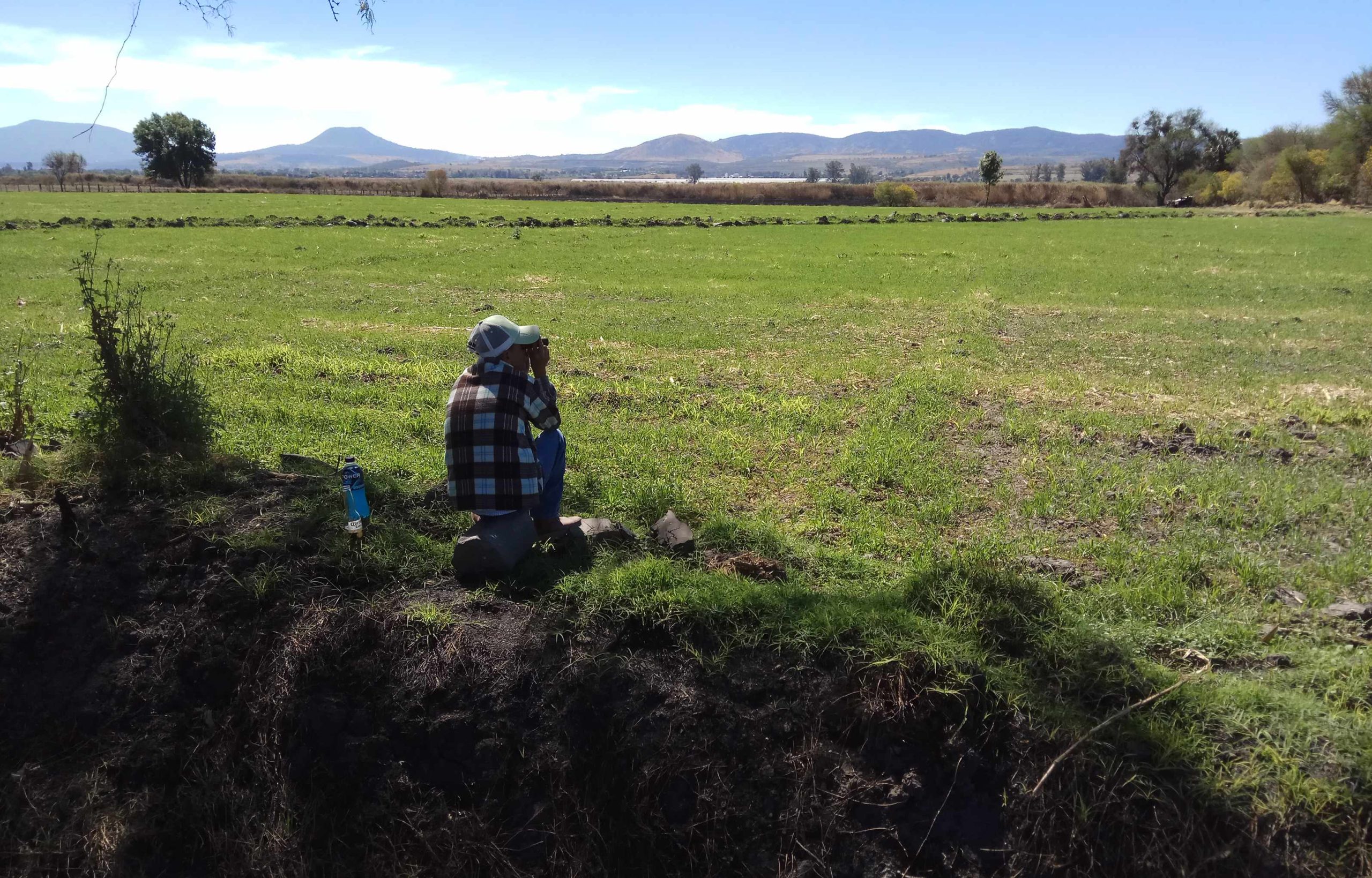
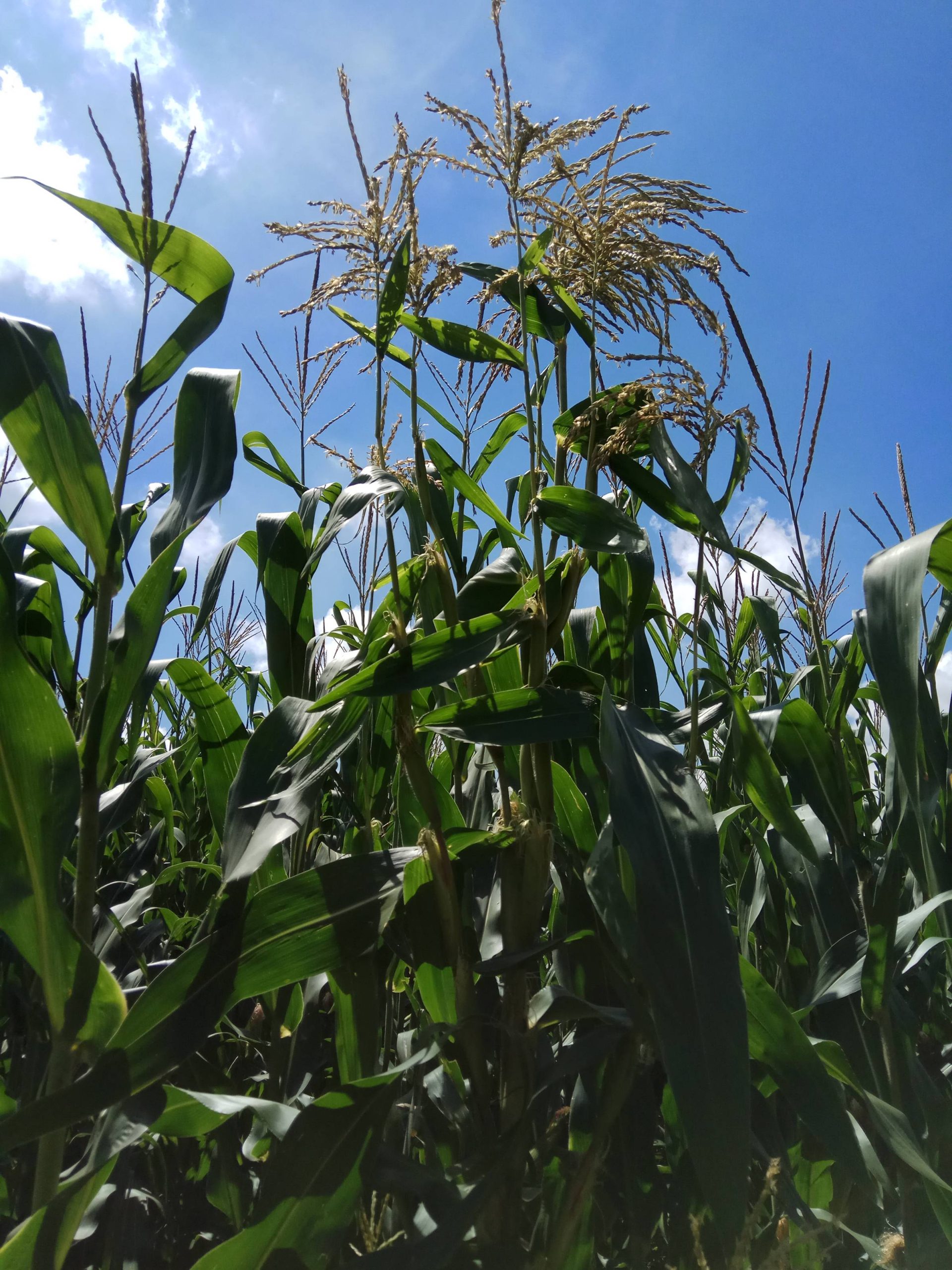
Imagen 23. Colapso temporal: teocintle y maíz
Potrero Barranquillas, 22 de junio de 2022.
(Teocintle entre maíz híbrido) La lógica de la modernización supone que eficientes variedades de maíz sustituirán a las antiguas menos productivas. El teocintle, el ancestro evolutivo del maíz, crece entre los híbridos modernos en las tierras ejidales. Esta “rémora” de la evolución resiste los herbicidas y es visible solo cuando sobresalen sus espigas encima del maíz debido a su mayor longitud, que es cuando los agricultores arrancan la planta. El teocintle se ha mezclado con híbridos como el Pioneer (Inzunza, 2013: 72).
Imagen 24. Agricultores crono-nautas
Potrero Barranquillas, 19 de diciembre de 2021.
(Cosechadora vaciando el grano en un camión) Elegir cuándo sembrar y cosechar es una decisión delicada que depende de las condiciones climáticas. Si siembran antes del inicio del temporal, la semilla no nace. Si esperan demasiado, el terreno está tan blando que es imposible sembrar. Si el maíz no se seca a tiempo, las lluvias de invierno podrían dificultar la cosecha. El agricultor se convierte en un crono-nauta que navega entre temporalidades insumisas, las cuales se agitan en el Antropoceno y la Era de las Plantaciones.

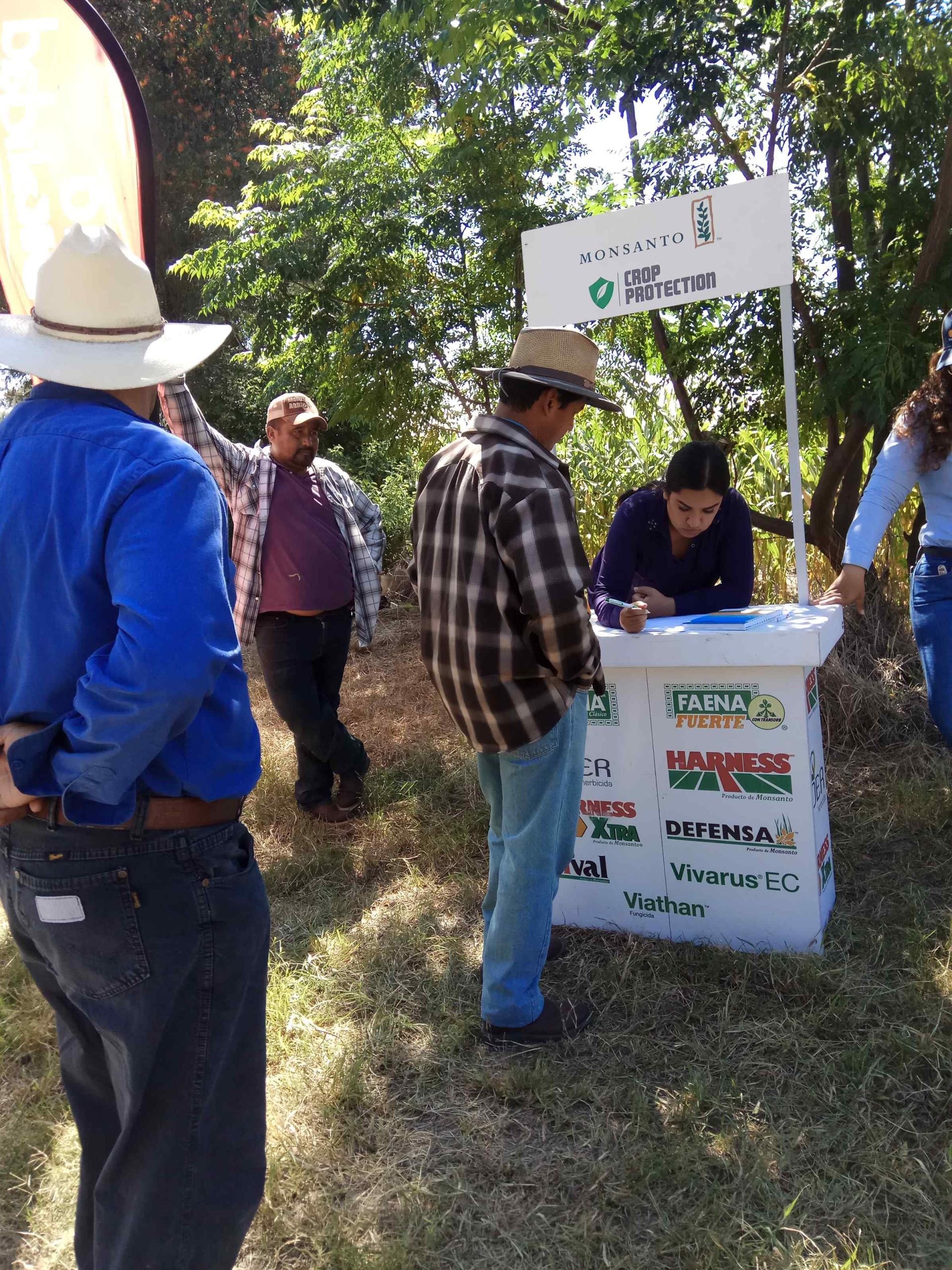
Imagen 25. Las viejas nuevas demostraciones
Potrero La Bueyera, 09 de octubre de 2018.
(Registro para asistir a una demostración) Las demostraciones son las viejas tácticas del extensionismo y la comunicación rural del siglo XX. Después de la Segunda Guerra Mundial existió una “necesidad” por incrementar la producción de comida en América, “la consecuencia fue un fuerte interés en los medios de comunicación”. En ese contexto, “la persuasión fue considerada el arma correcta” para incentivar el cambio y “facilitar el desarrollo” del campo (Díaz Bordenave, 1976: 136).
Imagen 26. Demostrar para vender
Potrero San Juanico, 18 de octubre de 2018.
(Ingeniero demostrando el llenado de la mazorca) Al contrario del mirar del agricultor, las demostraciones son un despliegue de retórica visual que busca convencer al productor agrícola de comprar un producto o un servicio. Los ingenieros agrónomos (antes los extensionistas) son los actores que intentan superar el supuesto “escepticismo” de la gente de campo mediante tácticas fundamentadas en la ciencia de la comunicación.


Imagen 27. Etiquetas para reconocer el híbrido
Potrero San Juanico, 18 de octubre de 2018.
(Ingeniero bromea con agricultores) Las agro empresas llaman “vitrinas” a estas escenas donde se demuestra al agricultor los beneficios de sus productos (Diario de campo, 15 de marzo de 2024). Son fundamentales los apoyos visuales, como este letrero que indica la variedad sembrada: Pioneer P3026W, que está asociada con el insecticida Dermacor de DuPont.
Imagen 28. La sociabilidad de los agricultores y la publicidad
San Miguel Zapotitlán, 04 de noviembre de 2022.
(Comida de agradecimiento) Desde 2019, Integradora Arca organiza la Expo Foro Maíz Amarillo en San Miguel Zapotitlán el mes de noviembre, una feria que vincula a los agricultores con agronegocios, aseguradoras, empresas financieras y con el sector industrial. Como el nombre lo indica, gira en torno a las complejidades de la producción de maíz amarillo para consumo de la industria. Luego de conferencias y demostraciones, Integradora Arca ofrece una comida a los asistentes, donde sobresalen los vistosos artículos promocionales de las empresas, como las gorras blanquiazules de Financiera Rural (FIRA).
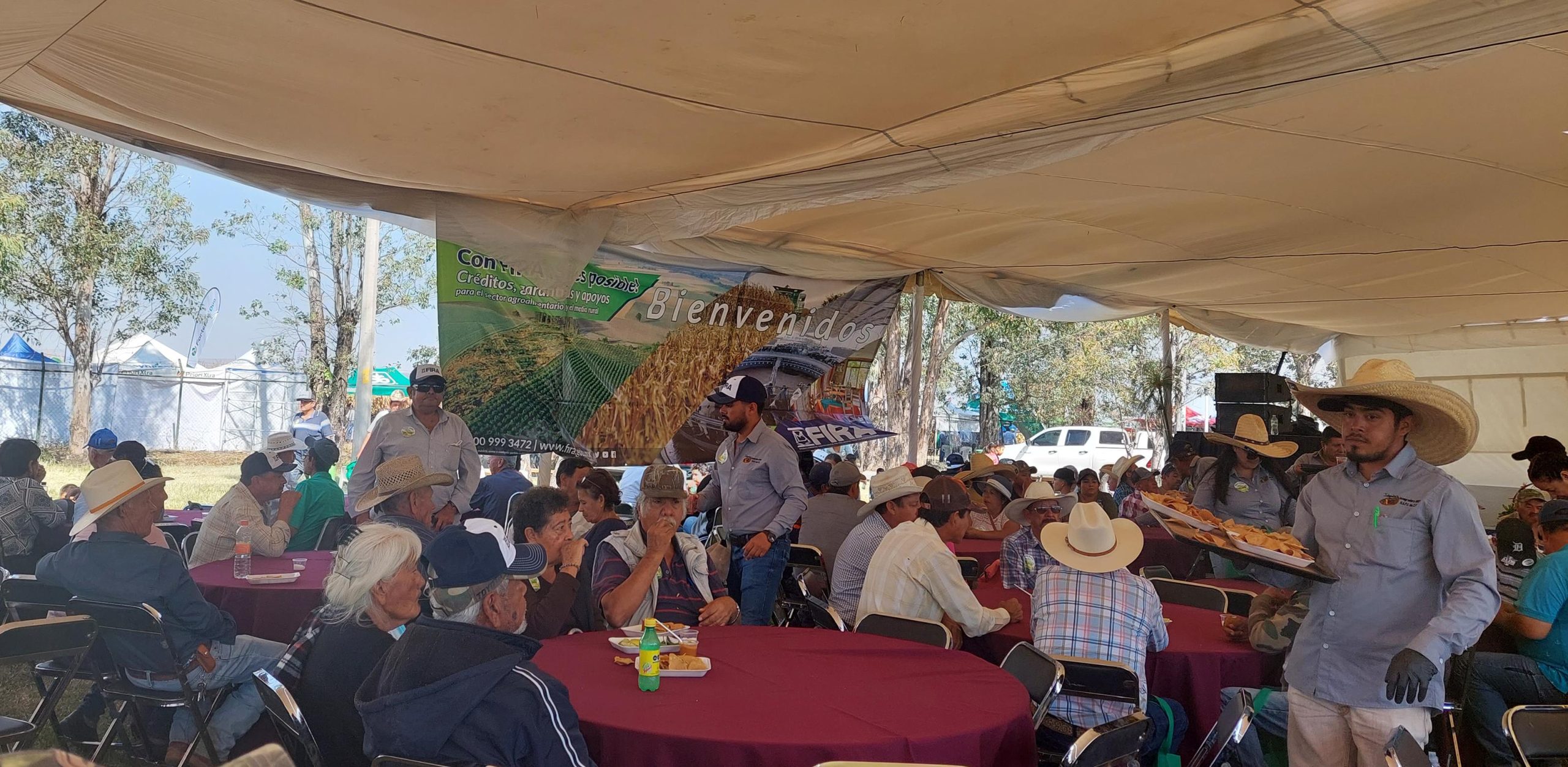

Imagen 29. Nuevas tecnologías
San Miguel Zapotitlán, 04 de noviembre de 2022
(Venta de drones agrícolas) En el sector del agronegocio pervive el determinismo tecnológico: se asume que las nuevas tecnologías incrementan casi de inmediato la producción. En la Imagen 29 aparece la última innovación: el dron fumigador. Otro aparato de uso militar que extiende sus aplicaciones al agro y que se suma a la lista del maquinismo promovido por la visión futurista del agronegocio (Marez, 2016).
Imagen 30. La religiosidad del tractor
San Miguel Zapotitlán, 20 de septiembre de 2023.
(Entrada de Gremios San Miguel Zapotitlán) Si bien la agricultura es una actividad comercial abismada entre el pasado y el futuro, esto no significa que los aspectos religiosos estén ausentes en su operación. Las misas por el buen temporal y las peticiones a san Isidro Labrador, patrono de los labradores, son comunes en San Miguel Zapotitlán. La religión es parte integral de la producción de granos para la industria “moderna”.


Imagen 31. La religiosidad del agroquímico
Poncitlán, 09 de octubre de 2018.
(Entrada de Gremios Poncitlán) La iconografía agrícola traspasa los dominios para formar parte de desfiles y procesiones religiosas. En la Imagen 31 aparece un envase gigante de un agroquímico encima de un carro alegórico que desfiló en la “Entrada de Gremios”, un desfile que abre la fiesta de la Virgen del Rosario en Poncitlán, la cabecera municipal. La agricultura no es solo producción, también es cultura visual mezclada con religión.
Imagen 32: Los ecuaros: policultivos en el olvido
Cerro el Venadito, San Miguel Zapotitlán, 22 de marzo de 2023.
(Ecuaros en laderas) La agricultura comercial convive con una práctica de policultivo llamada “ecuaro”. Un campesino define ecuaro como “un pedacito de tierra para sembrar verduras o maíz, como decir: nomás pa´ los elotes” (Diario de campo, 6 de marzo de 2019). Esta práctica está a punto de desaparecer, si bien todavía quedan unos cuantos campesinos que cultivan sus ecuaros. En la Imagen 32, se observa un ecuaro en temporada de secano y en lontananza las planicies con trigo.

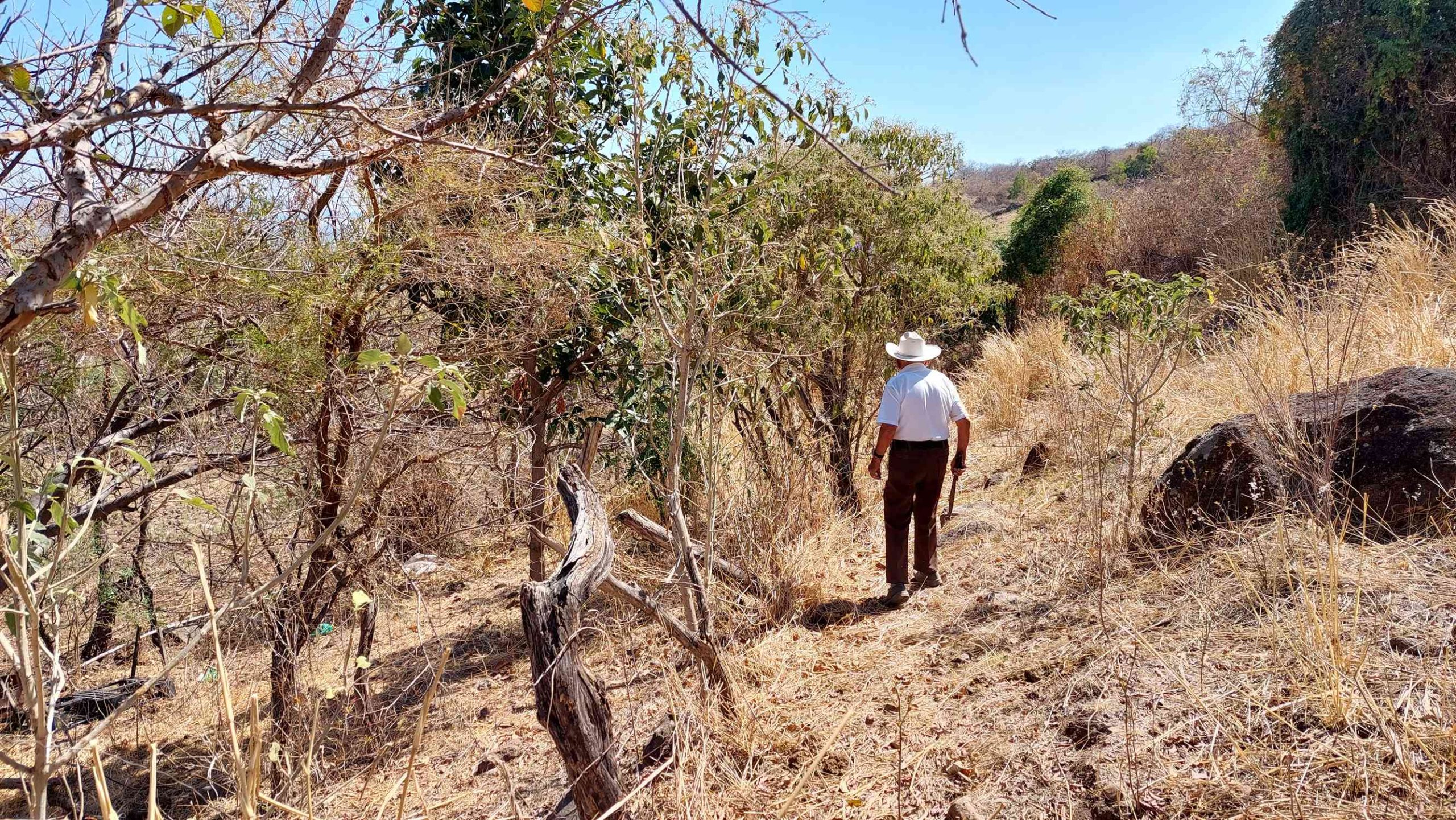
Imagen 33. La diversidad incluso en la sequía
Cerro el Venadito, San Miguel Zapotitlán, 22 de marzo de 2023.
(Ecuaro del tío Conrado) Los campesinos eran hacedores expertos de arreglos multiespecie antes del monocultivo. Los ecuaros han sido caracterizados como “sistemas agroforestales” donde coexisten “un elevado número de plantas perennes y anuales, silvestres y domesticadas, [así como] especies con diferentes usos” (Moreno-Calles et al., 2016: 5). En esto, los policultivos son distintos a los monocultivos, donde se asegura la supervivencia del trigo y del maíz, pero no de otras especies. En la Imagen 33 se observa la cerca viva formada por especies maderables y frutales.
Imagen 34. Ecuaro y desmonte
Cerro el Venadito, San Miguel Zapotitlán, 22 de marzo de 2023.
Antes de sembrar la milpa, el campesino “limpia” el terreno. Corta las especies consideradas malezas, mientras que tolera otras plantas útiles, con esta acción crea el paisaje a partir de la biodiversidad existente. En la Imagen 34 se observa el nopal, llamado blanco, que es muy valorado en la cocina local por su sabor y textura.

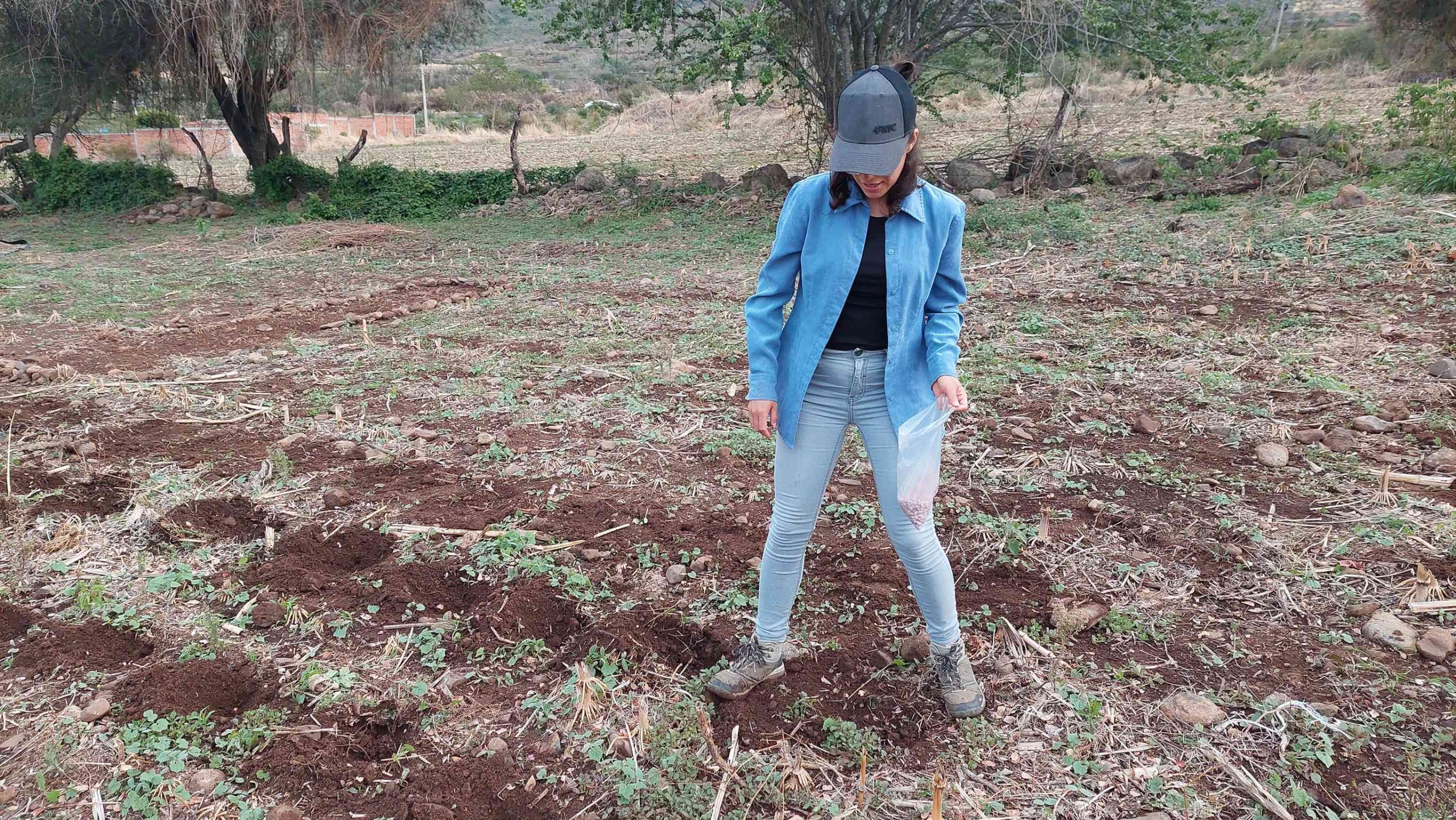
Imagen 35. Nuevos campesinos
San Miguel Zapotitlán, 16 de junio de 2022.
(Mariana sembrando un nuevo ecuaro) La pandemia publicitó el “retorno a la naturaleza” a nivel del discurso popular. Sin embargo, este fenómeno es relativamente común en las sociedades postindustriales en que los “neo campesinos” y los “neo artesanos” reivindican saberes y praxis locales al regresar al mundo rural desde las urbes (Chevalier, 1998:176). En la Imagen 34, Mariana tapa los hoyos –ahoyados con una herramienta manual llamada azadón– en donde depositó las semillas con esperanza de la cosecha.
Imagen 36. Antiguas y nuevas asociaciones
San Miguel Zapotitlán, 24 de agosto de 2023.
(Asociación de maíz, zinnias, calabazas y frijol) Los nuevos campesinos aprenden a cultivar la milpa atendiendo las enseñanzas de los antiguos campesinos, pero también mediante videos de YouTube, que fueron filmados por personas que practican la permacultura en Chile o en España. De modo que la milpa se convierte en un laboratorio de experimentación –como lo ha sido durante milenios– donde se ensamblan nuevas asociaciones entre seres vivientes y se trazan rumbos globales que son distintos a los del monocultivo.

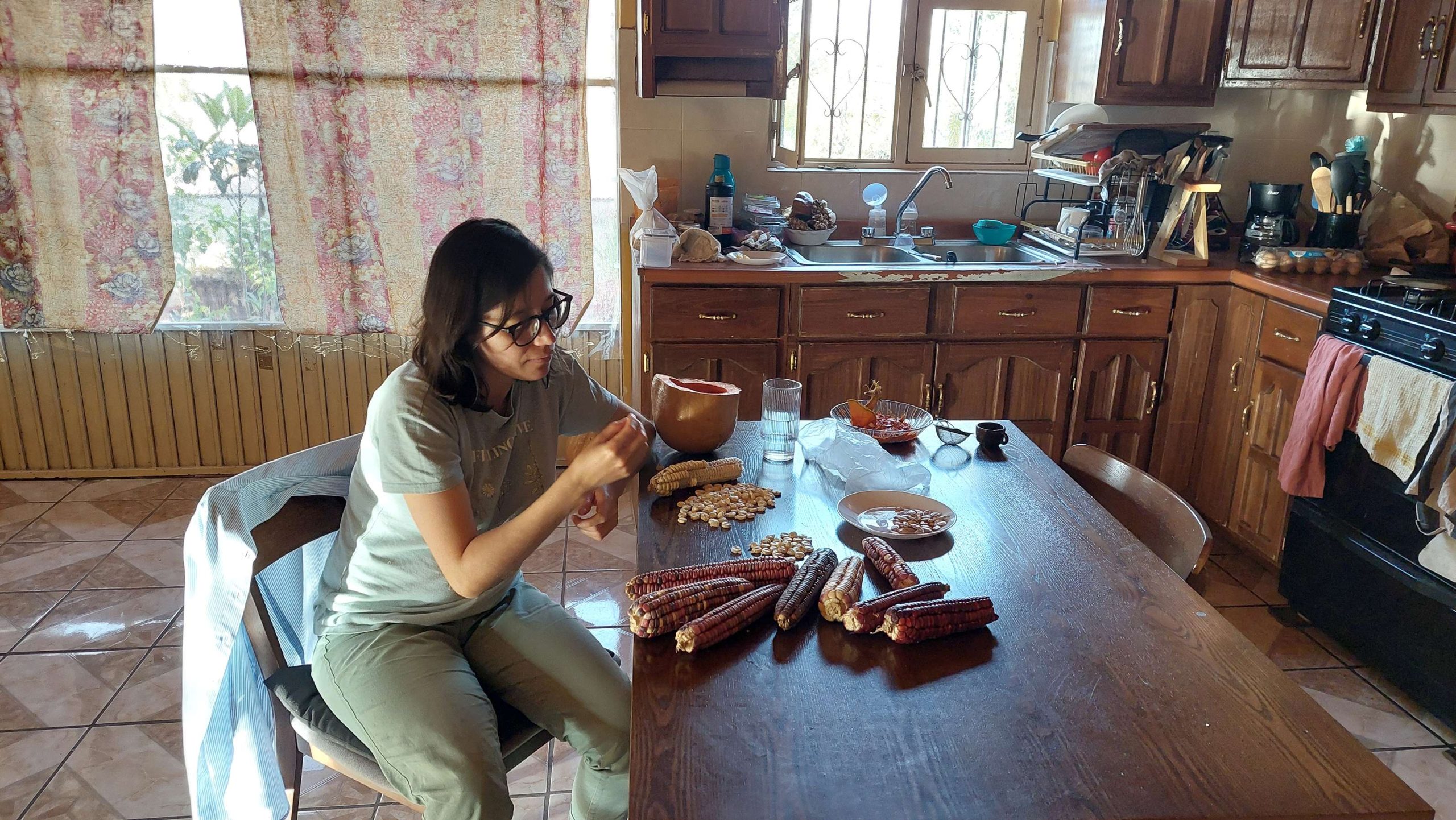
Imagen 37. Selección emotiva de la semilla
San Miguel Zapotitlán, 09 de marzo de 2024.
(Mariana seleccionando la semilla) Las semillas que se siembran en la agricultura de ecuaros han sido seleccionadas por campesinos desde hace decenas de años. Su historia-genética es razón suficiente para promover su cuidado. Incluso en medio de esta región donde la agricultura es cada día más tecnificada y comercial, las personas conservan variedades locales de semillas de frijol, calabaza y maíz, y las plantan en donde encuentran suelo disponible. Este modo popular de conservación de semillas podría asegurar la preservación de los maíces nativos.
Imagen 38. La milpa más allá del rendimiento
San Miguel Zapotitlán, 09 de marzo de 2024.
(Calabaza y sus semillas junto a mazorcas multicolor) Una pregunta esencial de la historia económica agraria es si la milpa es productiva. Si se compara la cosecha de los ecuaros con el rendimiento de los monocultivos, la respuesta es negativa. El monocultivo está diseñado para producir masivas cantidades de materia prima para la industria. En comparación, ni siquiera hay cifras exactas sobre la producción en los ecuaros. Pero lo que se pierde en cantidad con los policultivos, se gana en diversidad y salubridad: el sabor de las calabazas o los elotes sin pesticidas es inmejorable. Y las relaciones entre humanos y no humanos se intensifican alrededor del cultivar y compartir estos alimentos.
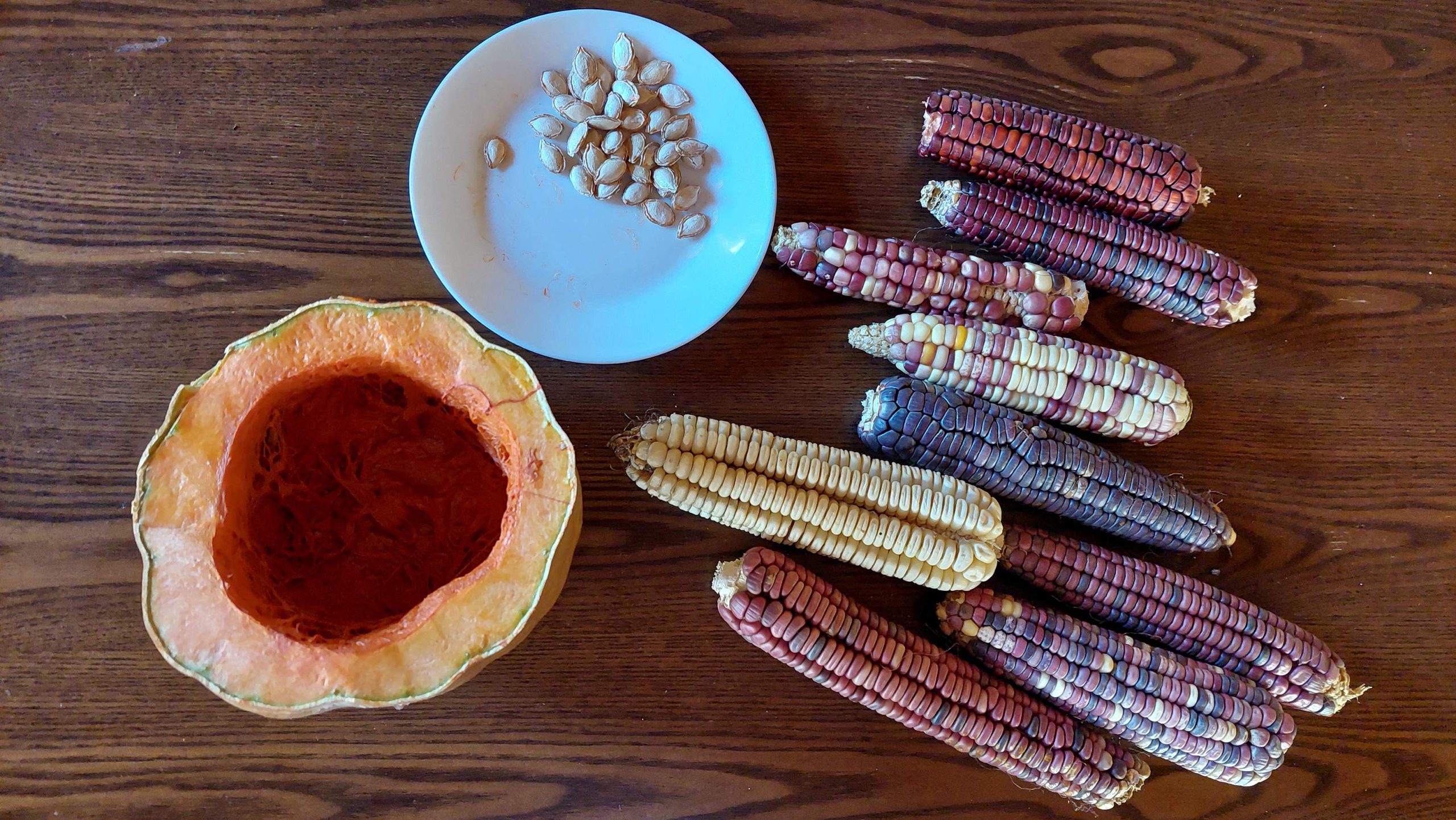
Bibliografía:
Chemnitz, Christine, Katrin Wenz y Susan Haffman (2022), Pestizidatlas. Daten und Fakten zu Giften in der Landwirstschaft, Heinrich-Böll-Stiftung; Bund. Friends of The Earth Germany; PAN Germany; Le Monde Diplomatique. Recuperado de: www.boell.de/pestizidatlas.
Chevalier, Michel (1993). “Neo-rural phenomena”, en L’Espace géographique. Espaces, modes d´emploi, número especial, pp. 175-191. Recuperado de: https://www.persee.fr/doc/spgeo_0046-2497_1993_hos_1_1_3201
Clément, Gilles (2021). El jardín en movimiento. Barcelona: Gustavo Gili.
Díaz Bordenave, Juan (1976). “Communication of Agricultural Innovations in Latin America.
The Need for New Materials”, en Communication Research, vol. 3, núm. 2, pp. 135-154.
García Solís, Georgina Iliana (8 de mayo de 2020). Sin desabasto, el agave azul se encarece en 3 mil%. UDG TV. Recuperado de: https://udgtv.com/noticias/sin-desabasto-el-agave-azul-se-encarece-en-3-mil-/168584
Index Mundi (2024). Urea precio mensual. Peso mexicano por tonelada. Recuperado de: https://www.indexmundi.com/es/precios-de-mercado/?mercancia=urea&meses=60&moneda=mxn
Ingold, Tim (2000). The Perception of the Environment. Essays on Livehood, Dwelling and Skill. London: Routledge.
Inzunza Mascareño, Fausto R. (2013). “Hibridación entre teocintle y maíz en la Ciénega, Jal., México: propuesta narrativa del proceso evolutivo”, en Revista de Geografía Agrícola, núm. 50-51, pp. 71-97.
Marez, Curtis (2016). Farm Worker Futurism. Speculative Technologies of Resistance. Minneapolis: University of Minnesota Press.
Olsson, Tore (2017). Agrarian Crossings. Reformers and the Remaking of the US and Mexican Countryside. Princeton: Princeton University Press.
Romero, Adam (2022). Economic Poisoning. Industrial Waste and the Chemicalization of American Agriculture. Oakland: University of California Press.
Warman, Arturo (2003). Corn and Capitalism. How Botanical Bastard Grew to Global Dominance. Chapel Hill: The University of North Carolina Press.
Photographing a Ritual Process: An Approach to the Agency of Xantolo Masks
Pablo Uriel Mancilla Reyna
The College of San Luis
is a doctoral candidate in the Anthropological Studies Program at El Colegio de San Luis. His research interests are ritual, visual anthropology, religious practices and the anthropology of art. She is part of the Visual Anthropology Laboratory of El Colegio de San Luis (LAVSAN).
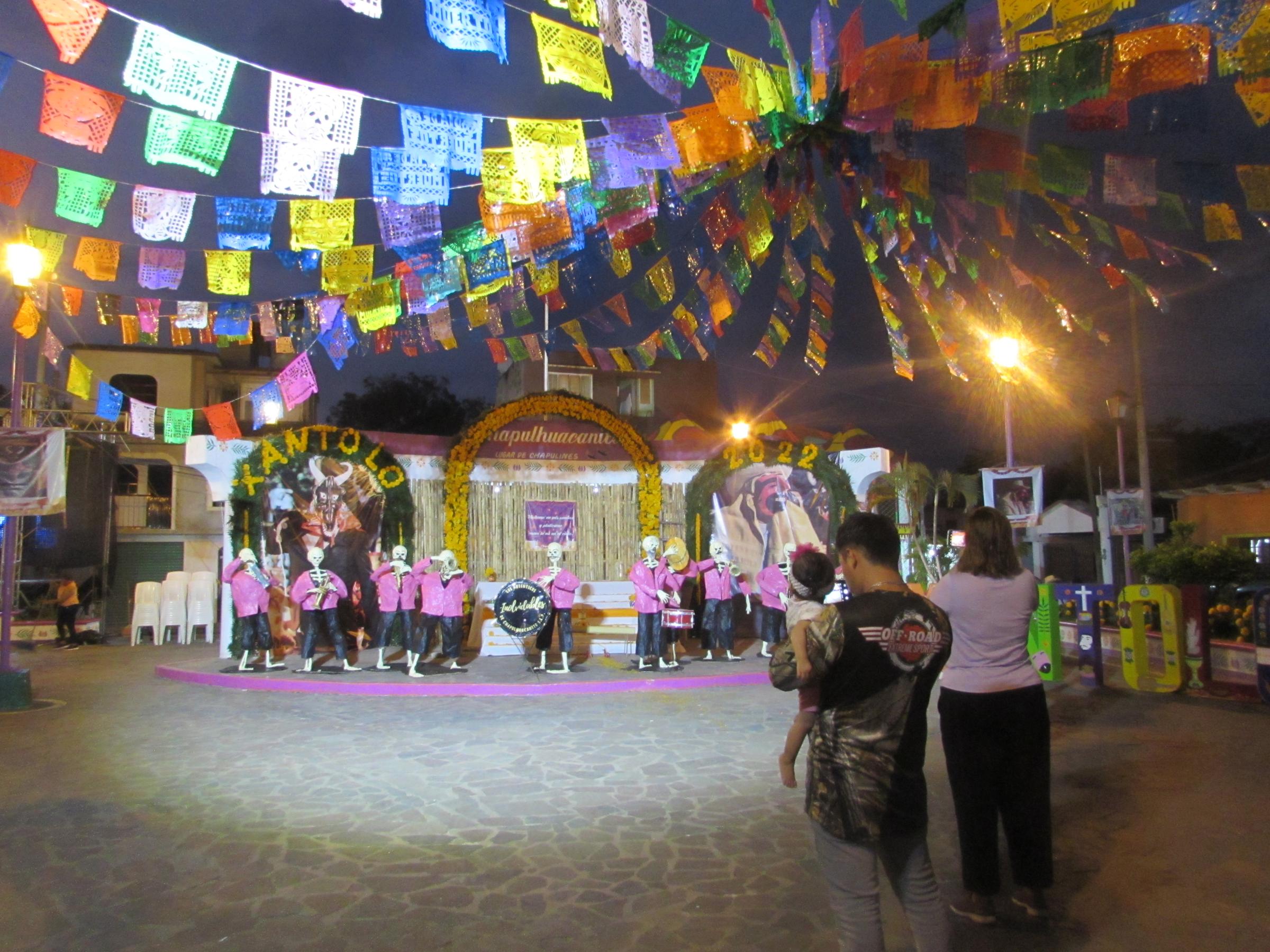
Image 1. Chapulhuacanito: place of grasshoppers and masks.
Chapulhuacanito, Tamazunchale, S.L.P. Mexico. November 2022
During the days of the Xanto festival, the center of Chapulhuacanito is decorated for the attraction of the townspeople and visitors.
This year we hope that the delegation arranges it well, because the Xantolo is Chapulhuacanito's big party.
Participant of the costumed group of the San José neighborhood.
Image 2. Seed for St. John's day
Chapulhuacanito, Tamazunchale, S.L.P. Mexico. November 2019
The cempasúchil flower that is placed on the domestic altars during Xantolo is left to dry and its seeds will be sprinkled on June 24 (St. John the Baptist's Day) of the following year. On that day they go out to their backyards and sprinkle the seeds that will give them that year's Xantolo flower.
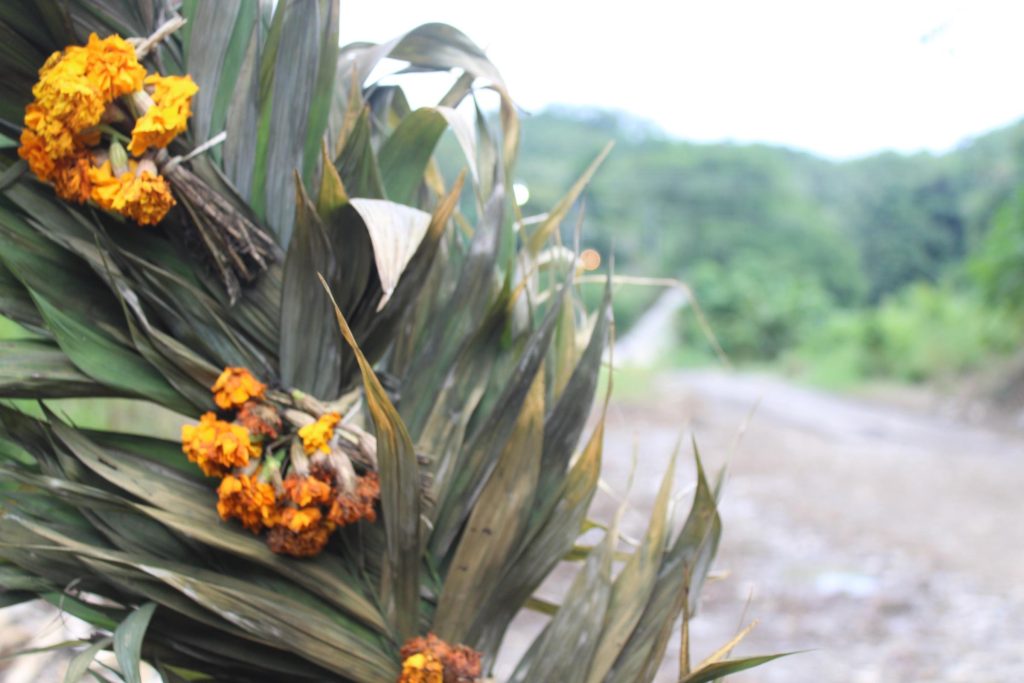

Image 3. Tamales for the offering
Chapulhuacanito, Tamazunchale, S.L.P. Mexico. October 2023
During the descent of masks and the days of Xantolo, the women organize themselves to make the tamales that they will offer and that will be the food for the participants of the costumed group, who will come to eat them when they finish dancing in the streets of the community.
Making tamales is one of the most important tasks and is the support of the Xantolo ritual process at the time of offering and exchanging food.
Image 4. Domestic altar
Chapulhuacanito, Tamazunchale, S.L.P. Mexico. November of 2019.
I'll be waiting for you for Xantolo so you can take a picture of me with the altar I'm going to put up here in the house," said don Barragan.
Excerpt from my field diary
In the houses a domestic altar is set up and dedicated to the deceased members of the family. Here food is placed and an offering is made, sometimes a mask is also placed, referring to their participation in a costumed group.


Image 5. Not saying thank you
Chapulhuacanito, Tamazunchale, S.L.P. Mexico. November 2019
In the domestic offerings are placed the food that will be smoked and then eaten. In Chapulhuacanito, during the days of Xantolo, people eat what they put on the altar. When you are invited to ofrendar (consume the food on the altar), you do not have to say thank you because the food was prepared for the deceased and you are the only vehicle that consumes it in its material form.
Image 6. The descent of the devil
Chapulhuacanito, Tamazunchale, S.L.P. Mexico. November 2023.
In the first lowering of masks it is crucial to lower the devil masks with bent horns and standing horns. These are received by a past businessman who, upon taking them, blows copal from the sahumerio.
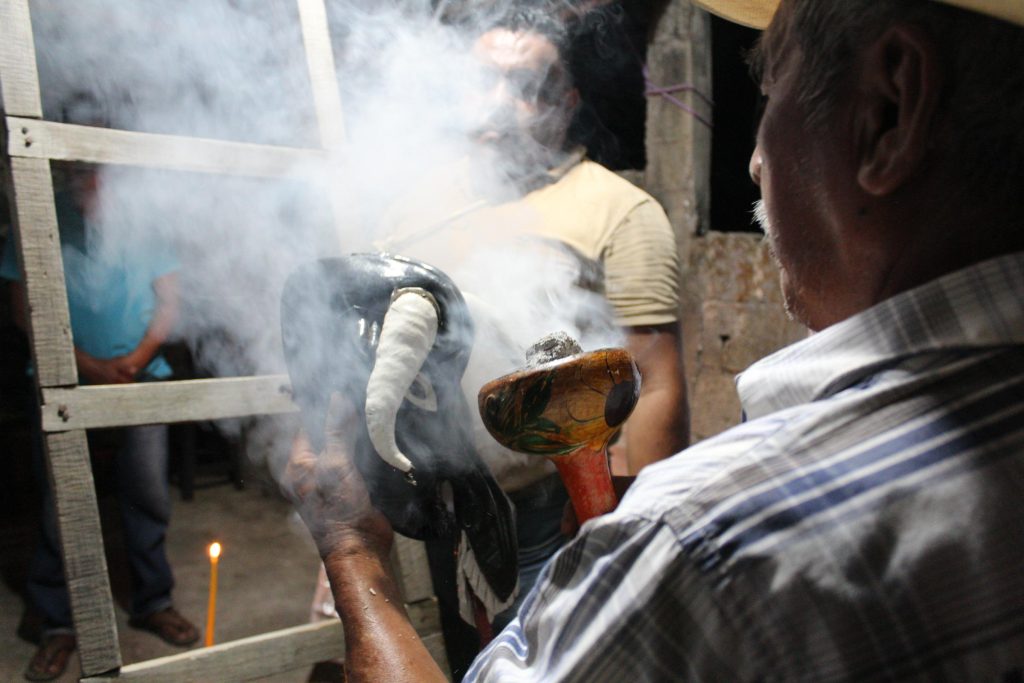
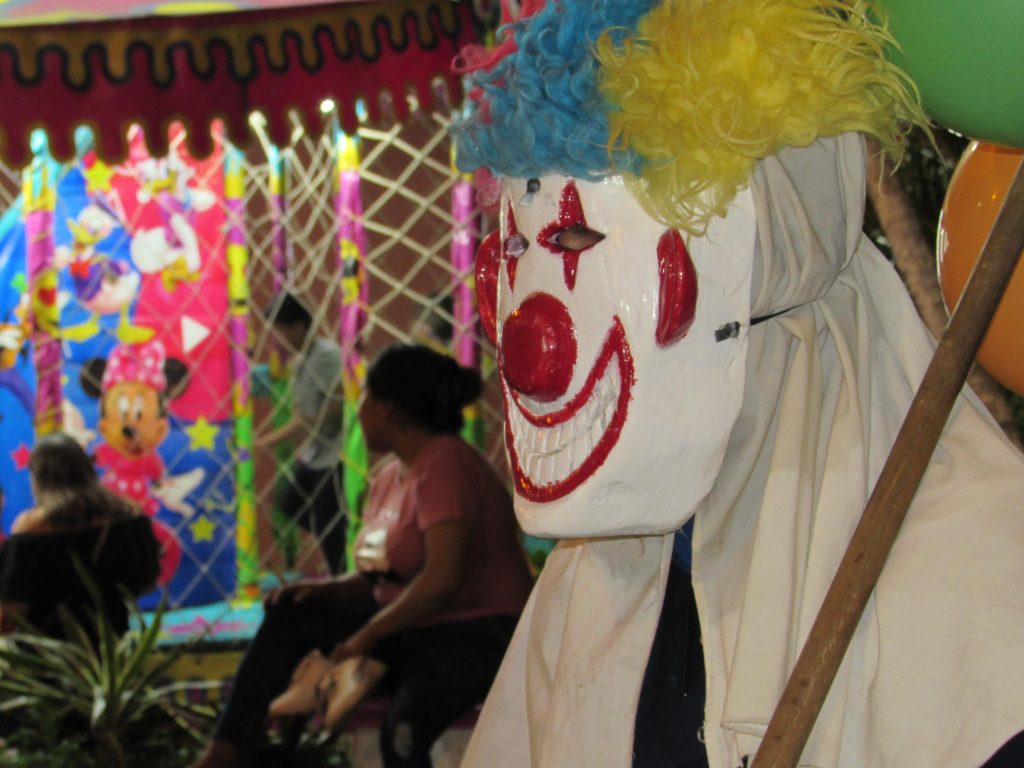
Image 7. The clown
Chapulhuacanito, Tamazunchale, S.L.P. Mexico. November 2022.
In addition to the traditional pink masks of the San José neighborhood, there are others that lead participants to create other types of characters.
This year they don't know what I'm going to dress up as, and I don't want to tell anyone because they'll copy it later.
Participant of the San José neighborhood group
Image 8. The photographer
Chapulhuacanito, Tamazunchale, S.L.P. Mexico. November 2019.
We were at the businessman's house while everyone was preparing their costumes, when Toño arrived and told me: "You don't know what I'm going to dress up as, you're going to be surprised, Uriel".
Excerpt from my field diary
One of the qualities of the costume is that it can include elements of what they see or is happening at the time. In that case, one of the costumed decided to include my work as an anthropologist/photographer in the way I would appear during those days.
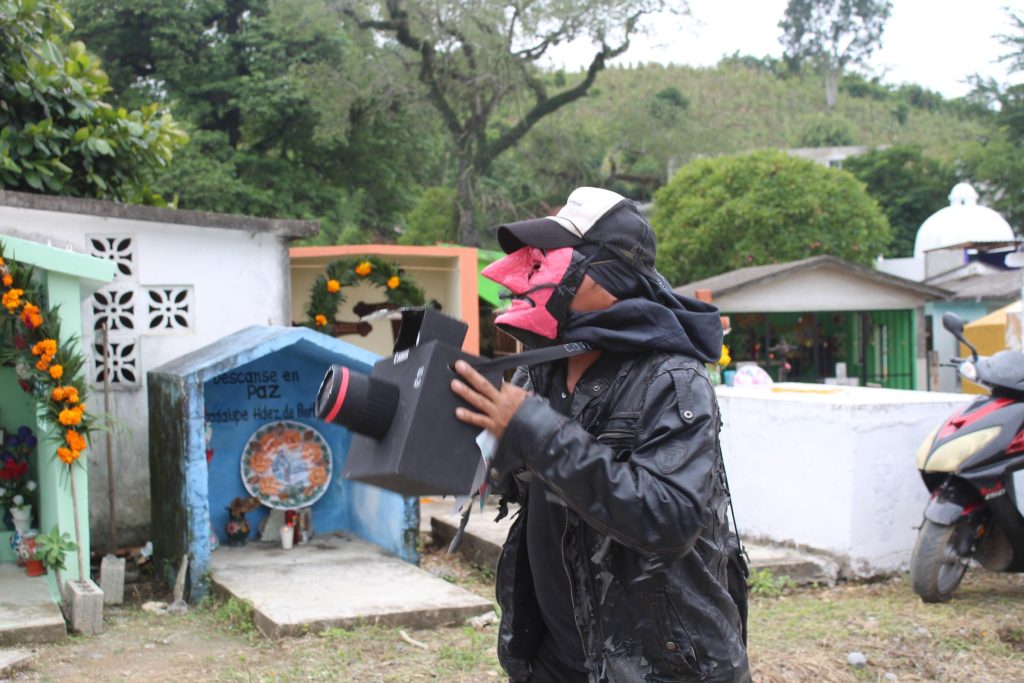

Image 9. Game of glances
Chapulhuacanito, Tamazunchale, S.L.P. Mexico. November 2019.
After Toño's camera was destroyed, only the lens was preserved. The playful character of the Xantolo achieved a game of looks in which the look and the way of doing it were exposed.
Image 10. Music for the masks
Chapulhuacanito, Tamazunchale, S.L.P. Mexico. November 2019.
The music of the Huapango trio is crucial in the descent of the masks of each of the costumed groups. When the trio arrives at the empresario's house, it begins to play "El canario" for the masks. In addition, he accompanies the masqueraders to their dance through the streets of the community during the four days of the festival.
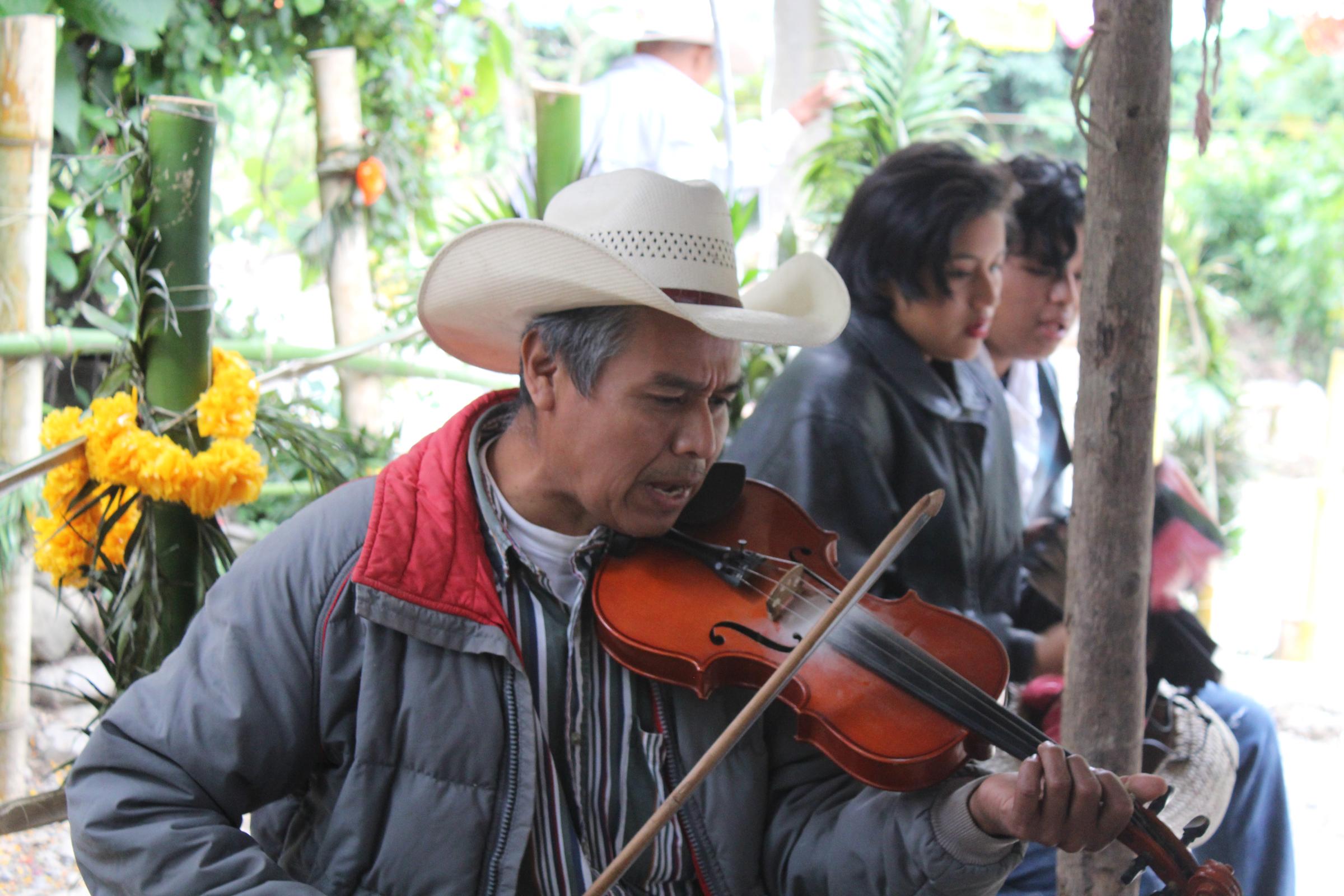

Image 11. The devil in the mural
Chapulhuacanito, Tamazunchale, S.L.P. Mexico. May 2023.
One of the most relevant masks in Chapulhuacanito is that of the devil. This is because the shape, figure and image of this mask is the way the devil appeared in this community. For this reason some murals have been dedicated to highlight the importance of this image.
Image 12. "We have to start playing cuetes". El Gordo, second businessman of the San José neighborhood.
Chapulhuacanito, Tamazunchale, S.L.P. Mexico. March 2013.
In addition to the music, another fundamental sound aspect is the rocket or, as the people say: "echar cohete". Its thunder in the sky creates a festive atmosphere that serves to warn a large part of the community where they are preparing for the offerings, the lowering of masks or that the costumed are getting ready to go out into the streets of the community.
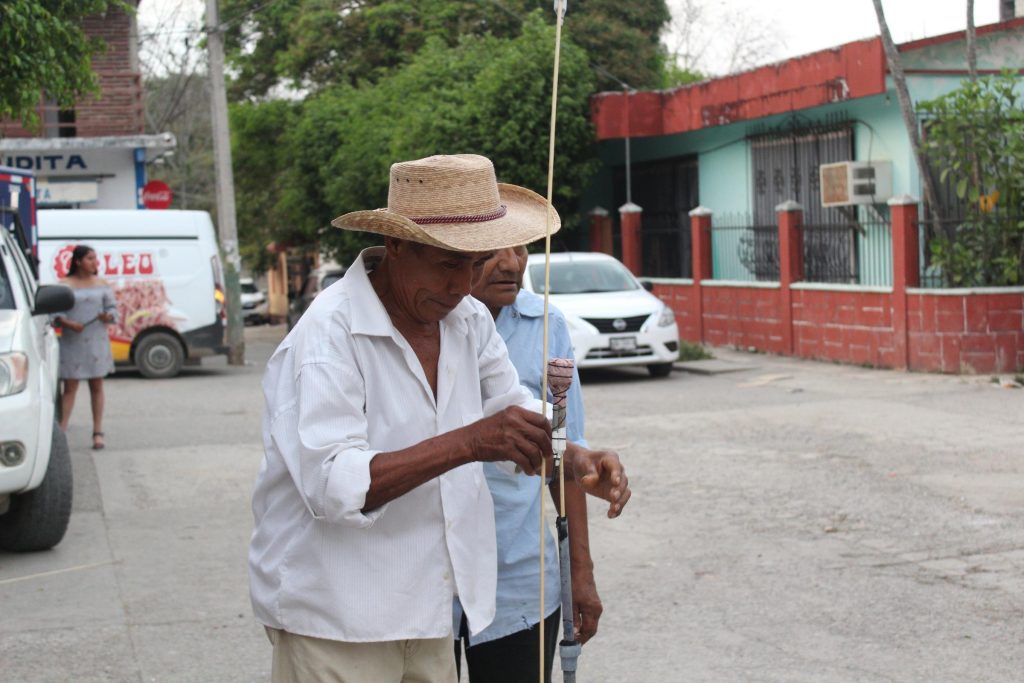
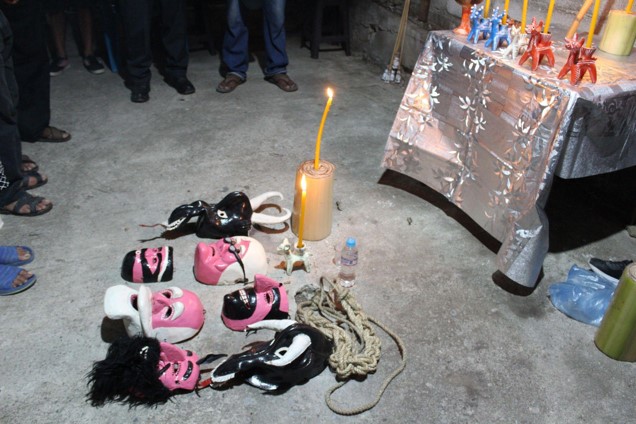
Image 13. "Touching the floor means that the past is already here among the living". Cecilio, a former businessman from the San José neighborhood.
Chapulhuacanito, Tamazunchale, S.L.P. Mexico. October 2023.
During the first mask lowering, only seven main masks are lowered. In this case, the crouching horned devil, the standing horned devil, the older cole, the grandfather, the grandmother, the mask of the second businessman and the mask of the chiflador were lowered. After lowering them from the false ceiling of the house where they are kept, it is necessary that the masks touch the ground, which is a sign that the deceased are already on the earthly plane, where we, the living, live.
Image 14. "In the first descent it is something intimate with few people, and in the second descent it is big". El Gordo, second businessman of the San José neighborhood.
Chapulhuacanito, Tamazunchale, S.L.P. Mexico. October 2023.
For the second descent of masks, the group of costumed people from the San José neighborhood organizes and sets up chairs to wait for about 50 people, sometimes there are more. All the people are offered tamales, coffee, chocolate and soft drinks.


Image 15. Transmissions
Chapulhuacanito, Tamazunchale, S.L.P. Mexico. November 2023.
The second descent of masks can be such a big event, that businessmen manage the transmission of the ritual. Sometimes it is only given through social networks and other times they take the community radio so that it can broadcast.
Image 16. Mask heights
Chapulhuacanito, Tamazunchale, S.L.P. Mexico. October 2023.
The altars where the masks are placed are usually larger than the domestic altars. This leads to a greater elaboration of the arch and cempasúchil flower necklaces. Making a bow for the lowering of masks carries a signifier of prestige and pride.

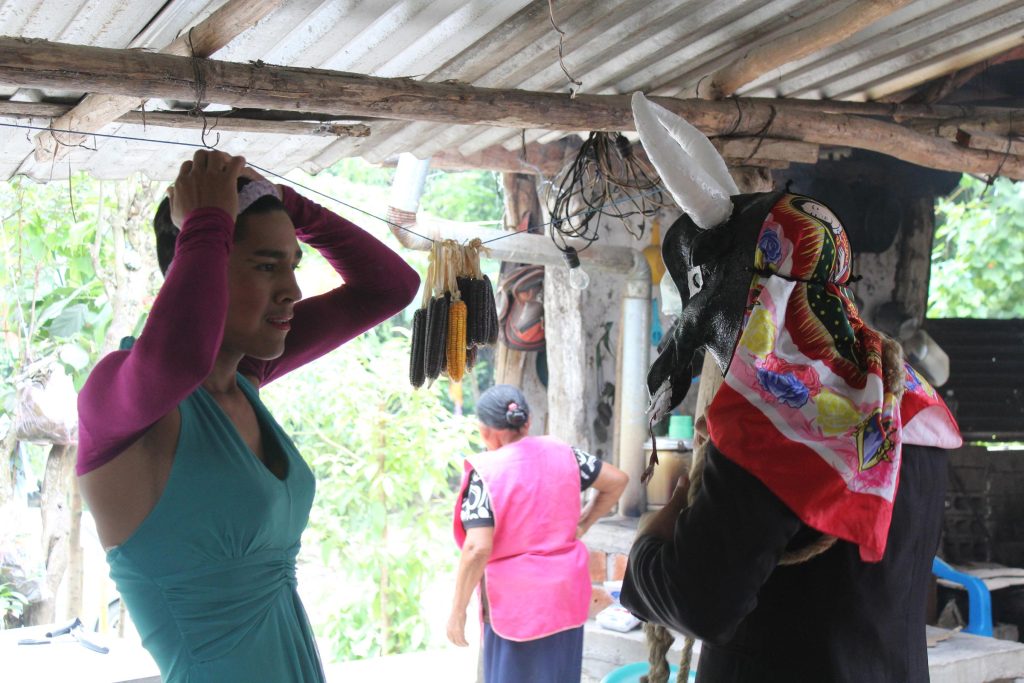
Image 17. Have your costume ready to go out.
Chapulhuacanito, Tamazunchale, S.L.P. Mexico. November 2019.
The participants of the costumed group meet at the businessman's house where they take their mask and prepare their costume. In some occasions they take clothes that are already in the place of the masks and that are used year after year, in others they wear their own clothes. In addition to disguising themselves with masks, some men also dress up as women to make couples when dancing.
Image 18. The new generations
Chapulhuacanito, Tamazunchale, S.L.P. Mexico. November 2019.
If you notice, this group brings a lot of children, many of them are attracted by it and come here, and that's good because they are the new generations. I used to walk like them since I was little, behind the costumes.
El Gordo


Image 19. Small mask
Chapulhuacanito, Tamazunchale, S.L.P. Mexico. November 2019.
I have already made my son a small mask, which fits him well and can be used for the Xantolo.
Chilo, community masquerader
Image 20. Sweat
Chapulhuacanito, Tamazunchale, S.L.P. Mexico. October 2019.
Imagine all that a mask has gone through inside, it has the sweat and energy of many people who have worn it.
Óscar, disguised as the neighborhood of San José
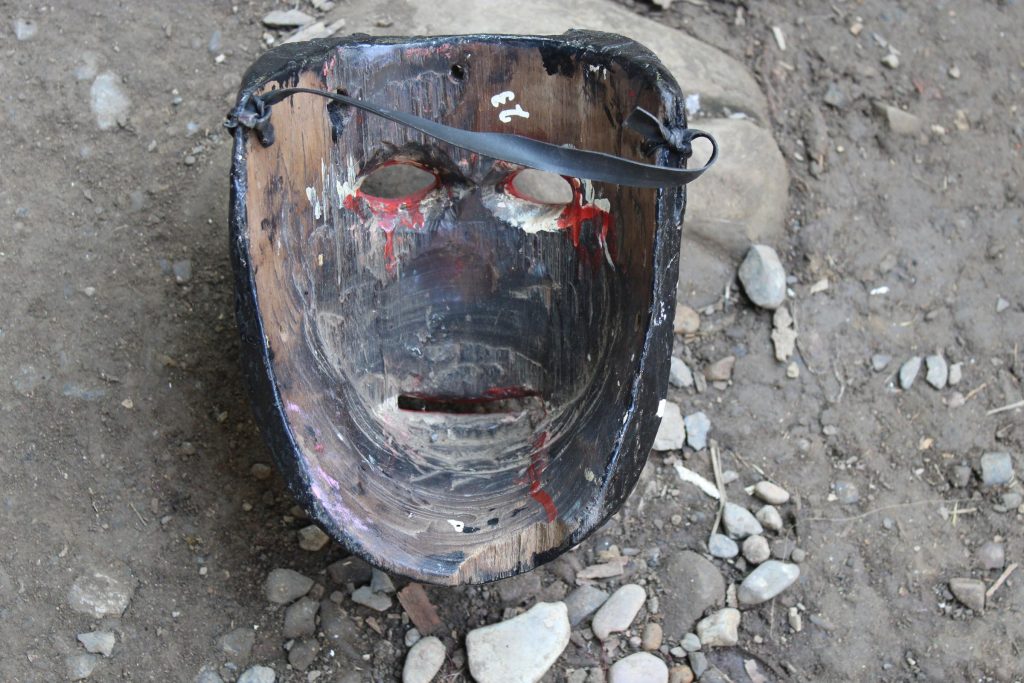

Image 21. The descent from the school
Chapulhuacanito, Tamazunchale, S.L.P. Mexico. October 2023.
Each of the masks that is lowered has to be smoked before being placed on the floor and given aguardiente to drink.
Image 22. Passing the drink
Chapulhuacanito, Tamazunchale, S.L.P. Mexico. October 2023.
Deliver and receive: these are words used in the lowering of masks and consist of a dialogue between present and past businessmen, in which sharing a drink (aguardiente) is fundamental during the ritual, to strengthen the process in which they welcome the deceased.
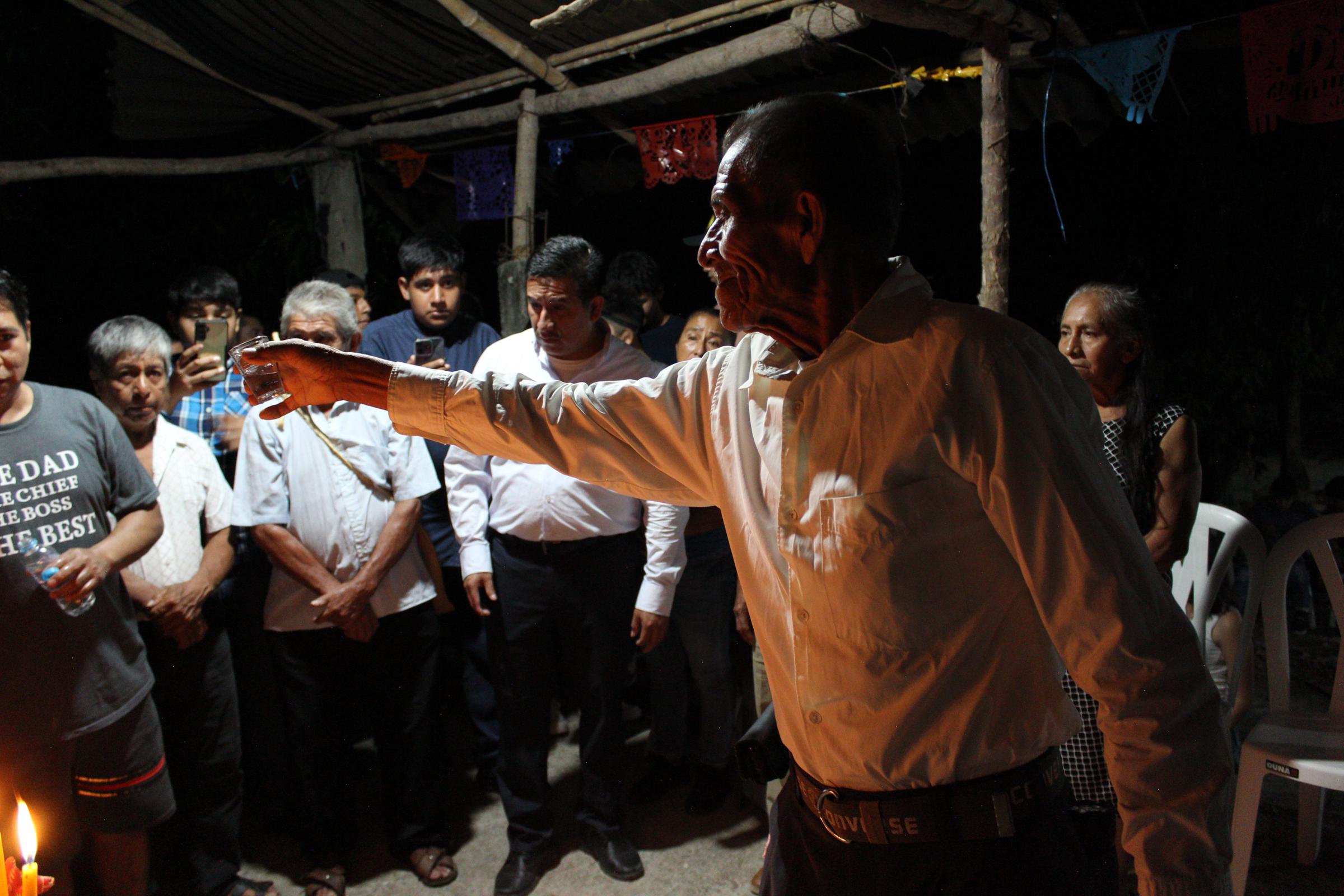
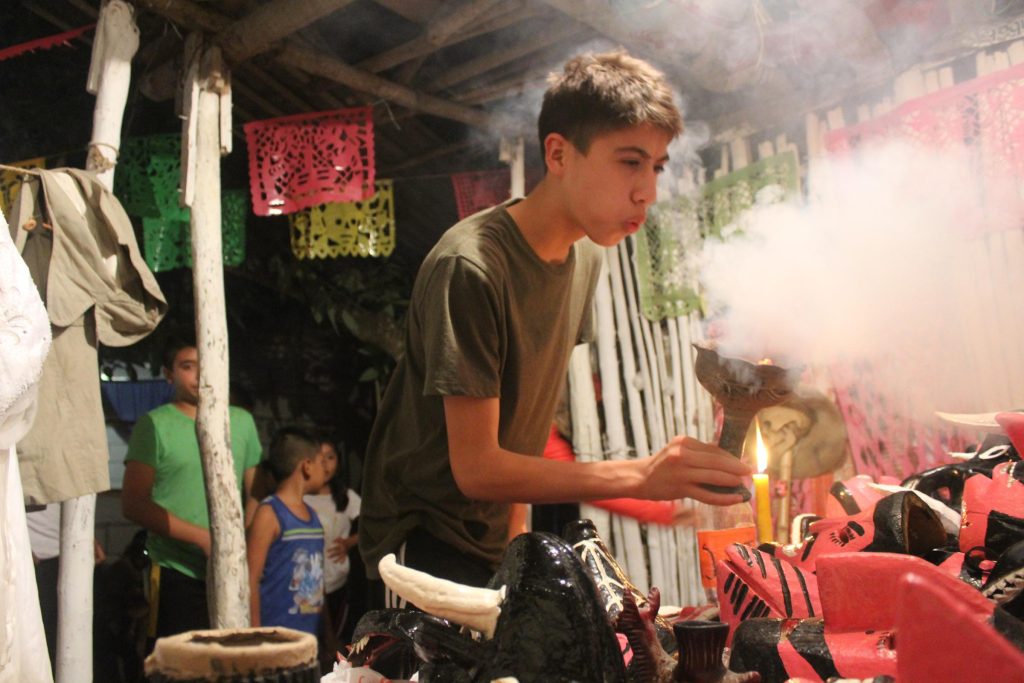
Image 23. Sahumar not to go crazy
Chapulhuacanito, Tamazunchale, S.L.P. Mexico. September 2018.
During the lowering of masks, it is necessary that all the people attending the ritual pass by to smoke them. This will prevent them from going crazy, which consists in not falling asleep and listening to the disguised people. In case of going crazy, the entrepreneur has to carve a mask and give to drink the powder that comes out with aguardiente.
Image 24. Óscar's unveiling
Chapulhuacanito, Tamazunchale, S.L.P. Mexico. November 2019.
In the unveiling, when one takes off the mask, I feel sad that I will not return until next year.
Oscar
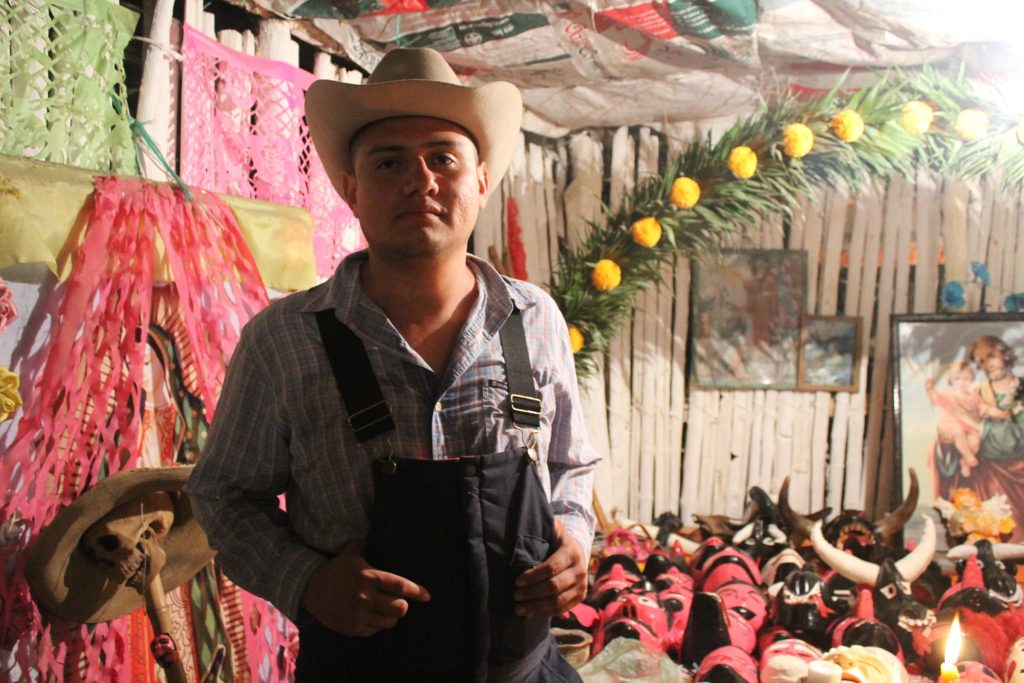
Of Zamorano insomnia. What is not talked about, but what the night allows to be shown
Laura Roush
El Colegio de Michoacán
likes to walk at night and during the pandemic began documenting aspects of the night in Zamora, Michoacán, where she lives. She holds a PhD in anthropology from the New School for Social Research and teaches at El Colegio de Michoacán.

Image 1. Zamorano's insomnia. What is not talked about, but what the night allows to show.
Entrance hall in Jardines de Catedral, Zamora, Michoacan. Mural by Marcos Quintana, 2019
Image 2. Pandemic novena
Colonia El Duero, Zamora, December 2000

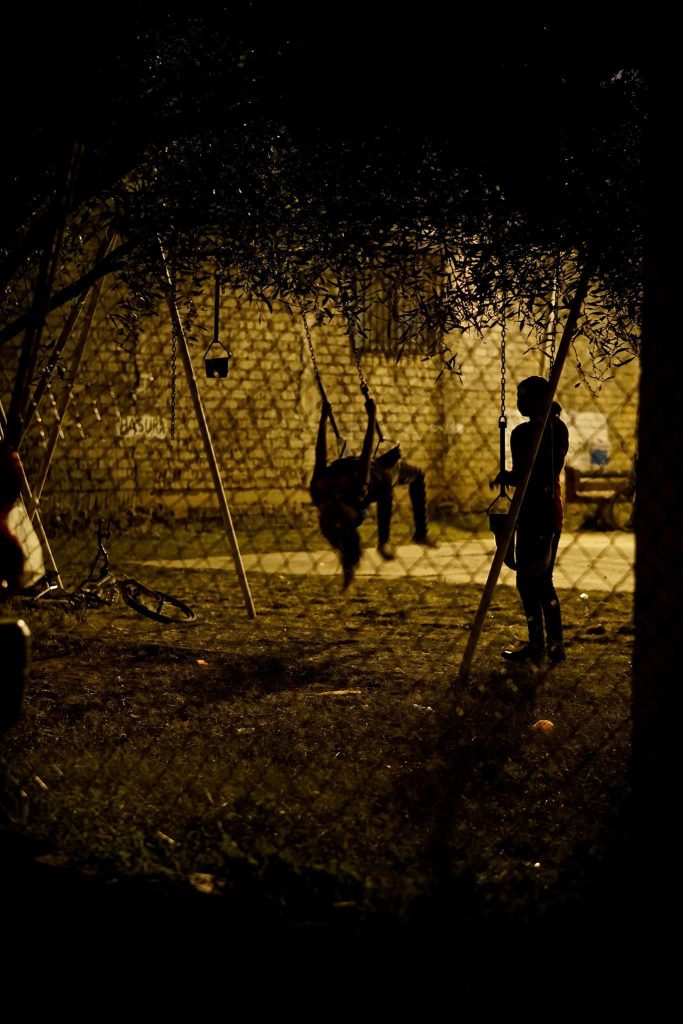
Image 3. "When the Merza closes at eleven o'clock, I want you back here".
Parish of St. Peter and St. Paul, Infonavit Arboledas. 22 hours and 55 minutes. January 2020.
Image 4. Chiras pelas. At night the streets and sidewalks cool down and you can play more fun. Some neighborhoods in the city offer the conditions for children to enjoy nightlife all year round.
Cathedral Gardens, Zamora, 2018.
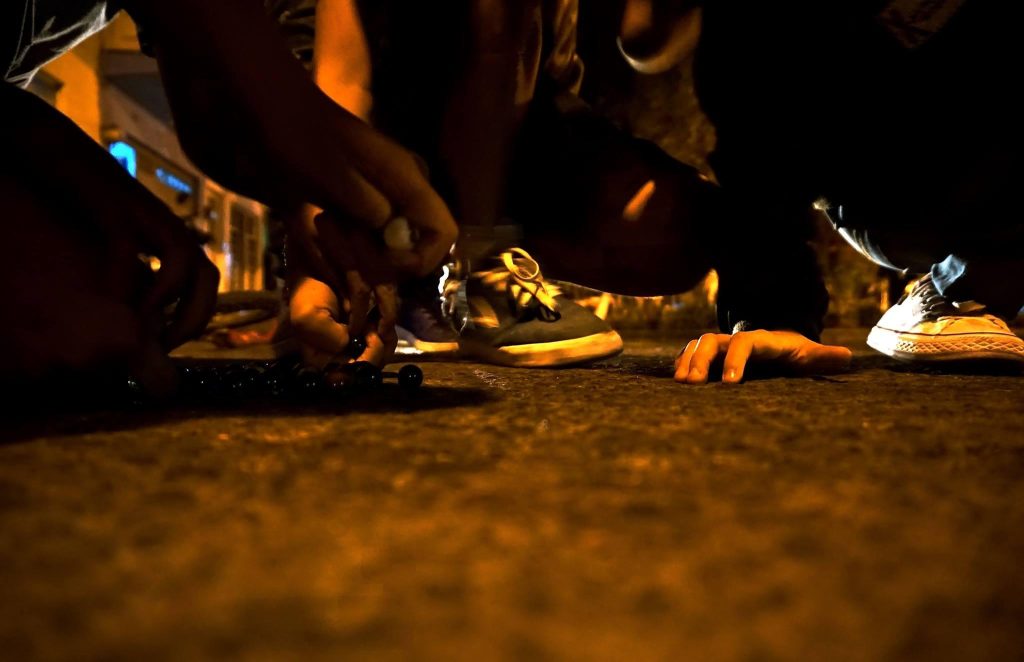
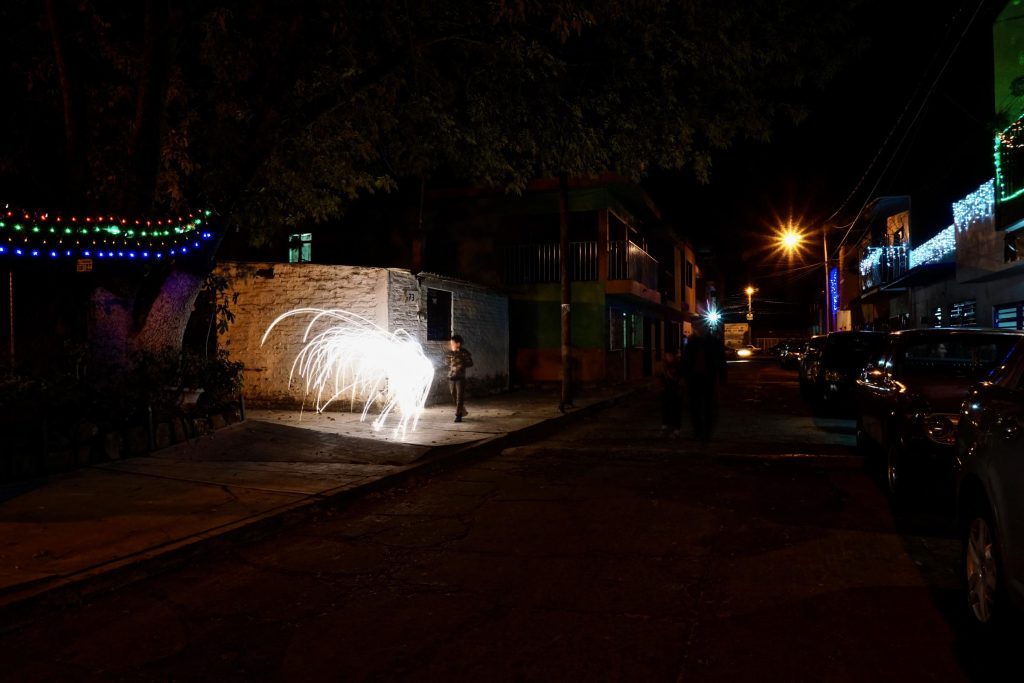
Image 5. On Christmas and a few other holidays, the schedule rules are suspended.
Cathedral Gardens, December 24, 2020, almost midnight.
Picture 6
Cathedral Gardens, Zamora, New Year, 2021.

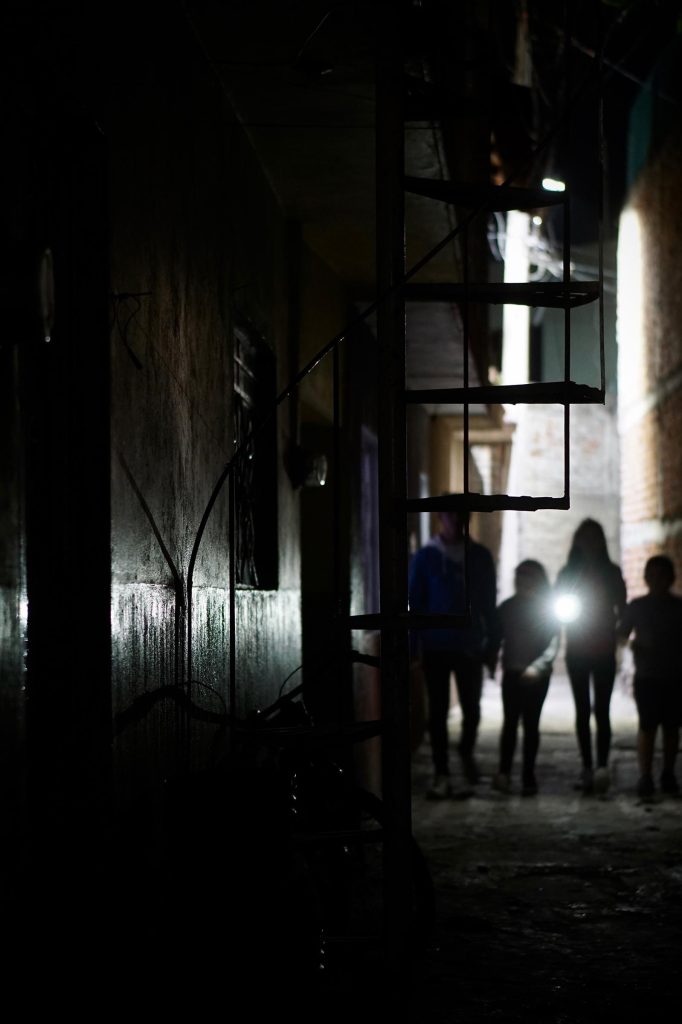
When the Douro River was diverted, segments of its former course became curved streets, sometimes narrow and with few connections to other streets.
La Lima, July 2023.
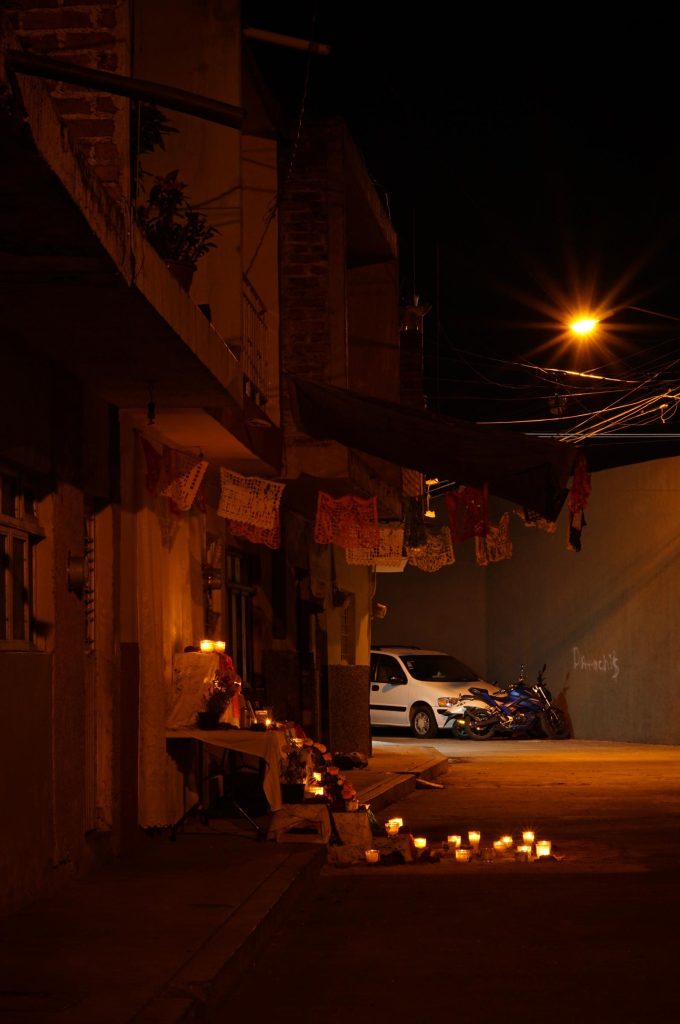
The narrow and curved streets of the old course of the Duero allow the continuation of the custom of street altars because they protect them from traffic. However, they say, because of the violence and disrespect, many now prefer to set them up inside the houses and publicly visible altars are scarce.
Day of the Dead, 2020, La Lima.
Image 9. Traffic goes down, kids go in and cats come out.
Colonia El Duero, September 2023.
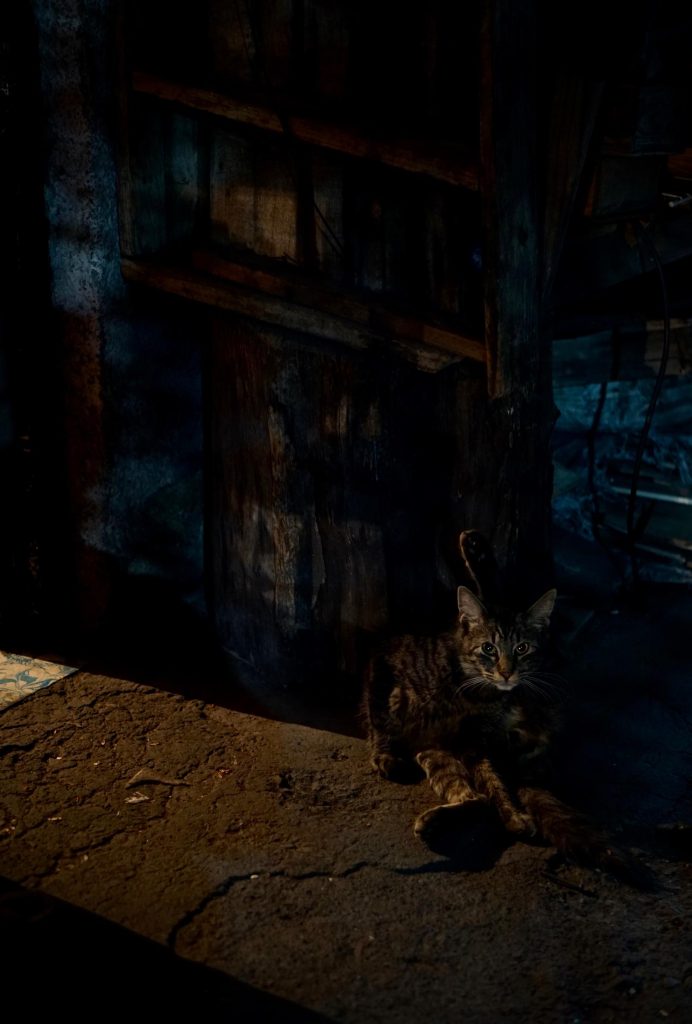

Image 10. Already locked up
Jacinto López, January 2021.
Image 11. Day of the Dead Altar
Infonavit Arboledas, 2021
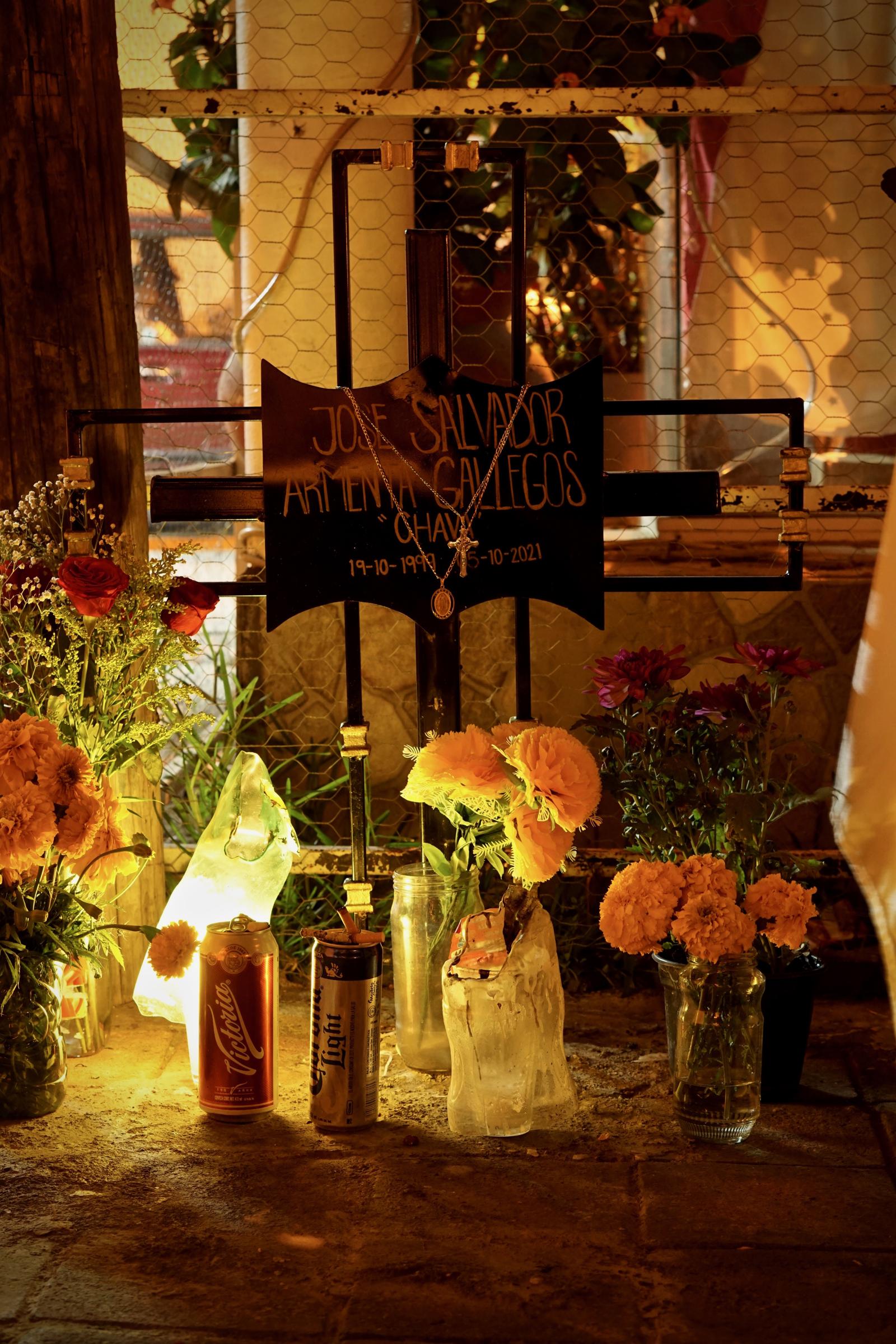
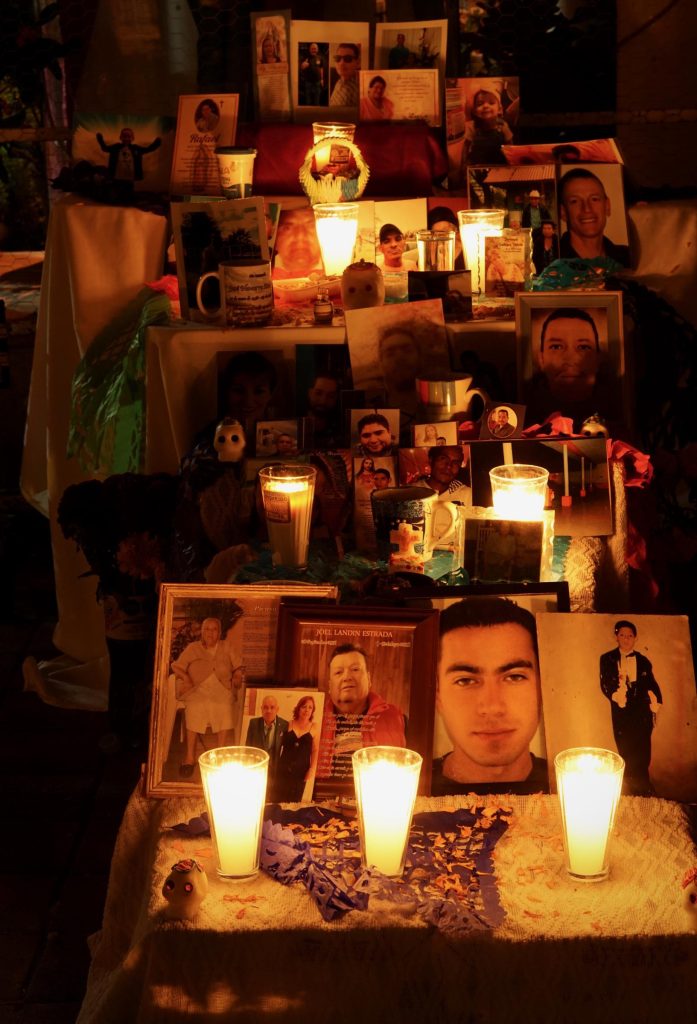
Image 12. A multi-family altar housing memories of an entire street
Arboledas Third Section, Day of the Dead, 2021
Image 13. "What hurts is the fucking killing".
Day of the Dead, 2021, La Lima
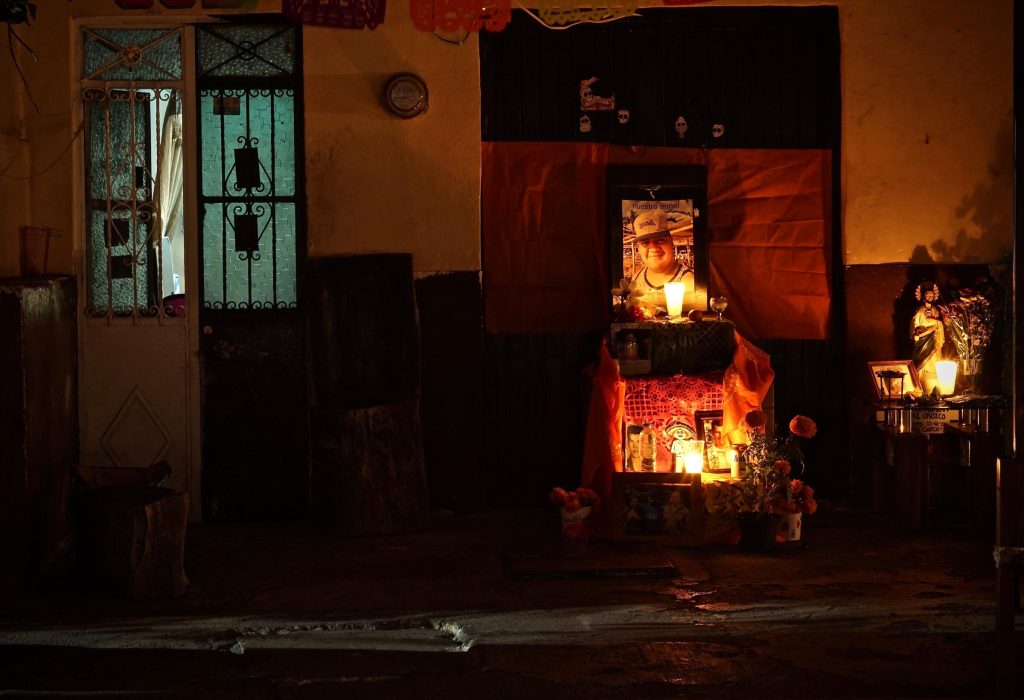
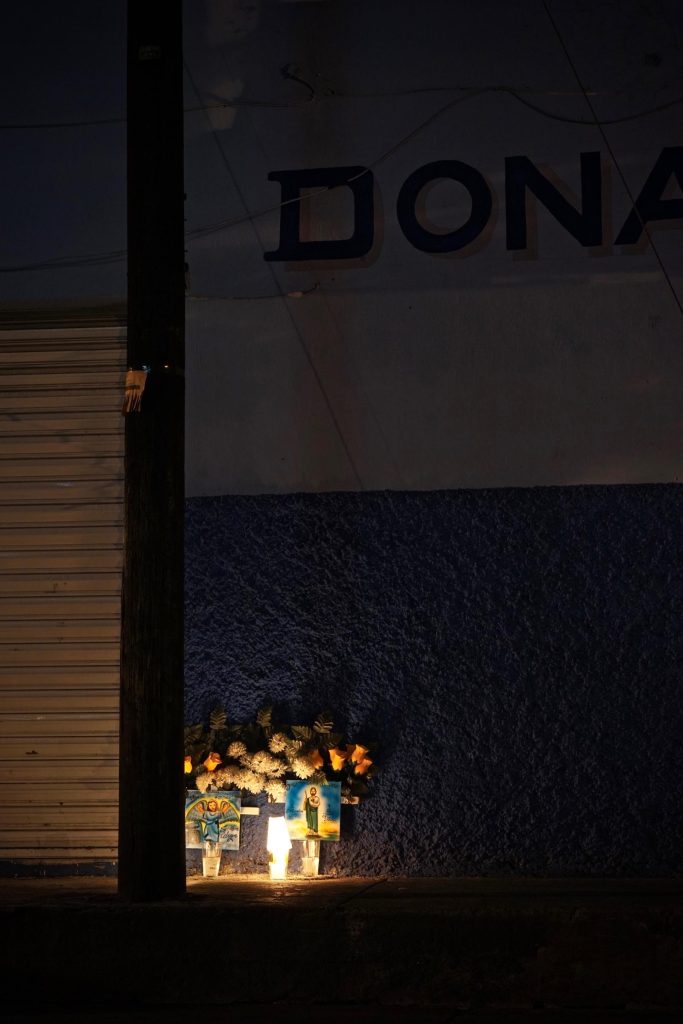
Image 14. Two fallen from the same family. Suddenly, the third one was killed
The Douro, July 2021
Image 15. "It's just that he was in it".
The Douro, July 2021
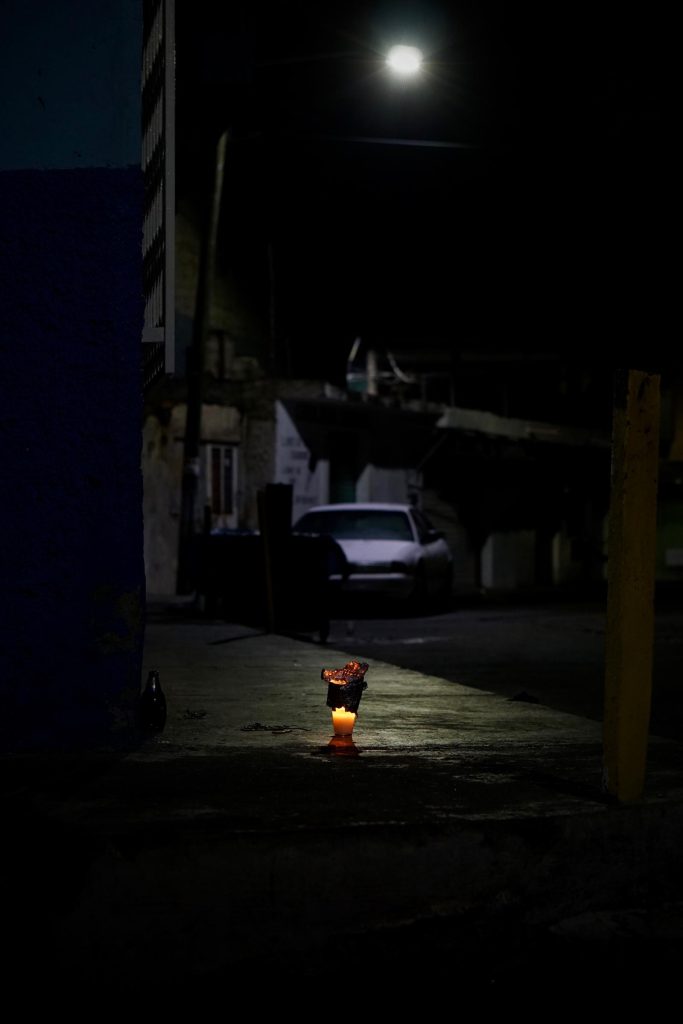
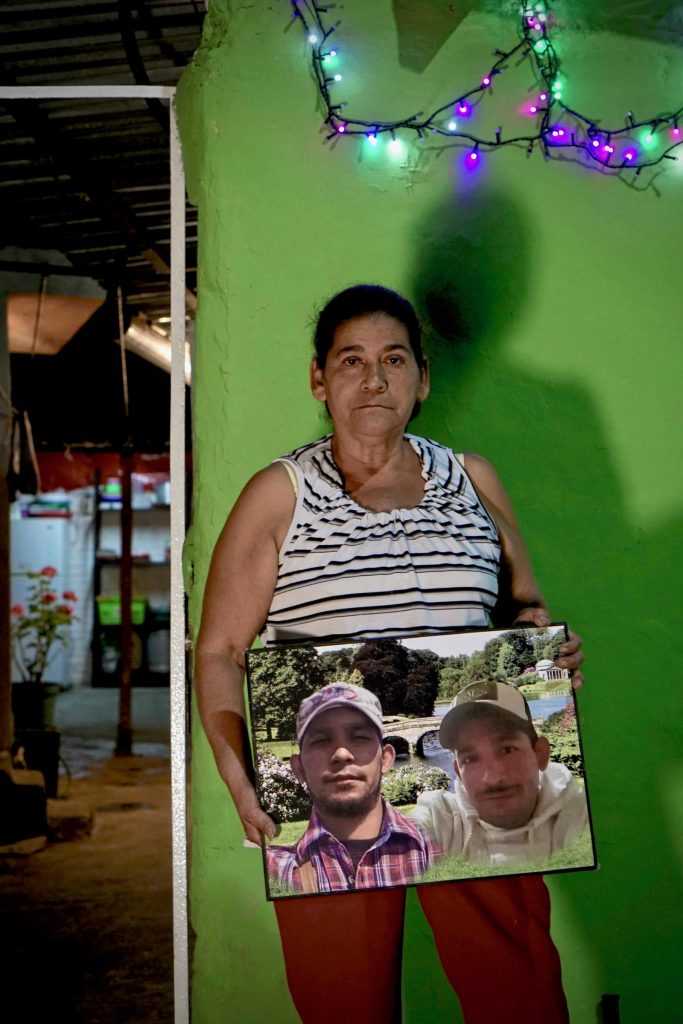
Image 16. "No one understands. But if you isolate yourself, you can go crazy."
Zamora, October 2022 (photo); conversation about the purpose of these photos, October 2023.
She wanted to remain anonymous, but she also wanted her children to be seen, for one might be alive somewhere.
Image 17. Altar to Saint Jude Thaddeus
Same place as in the previous image, Zamora, October 2022.
The situation of women who had to take on these tasks due to the kidnapping-disappearance, imprisonment or clandestinity of their partners is intrinsically different....
The situation of terror in which they lived required various forms of concealment, even of personal pain. It included trying to get the children to go about their daily activities as if nothing had happened in order to avoid suspicion. Fear and silence were constantly present, with a very high emotional cost.
Elizabeth Jelin, anthropologist, on the Dirty War in Argentina (2001:105)

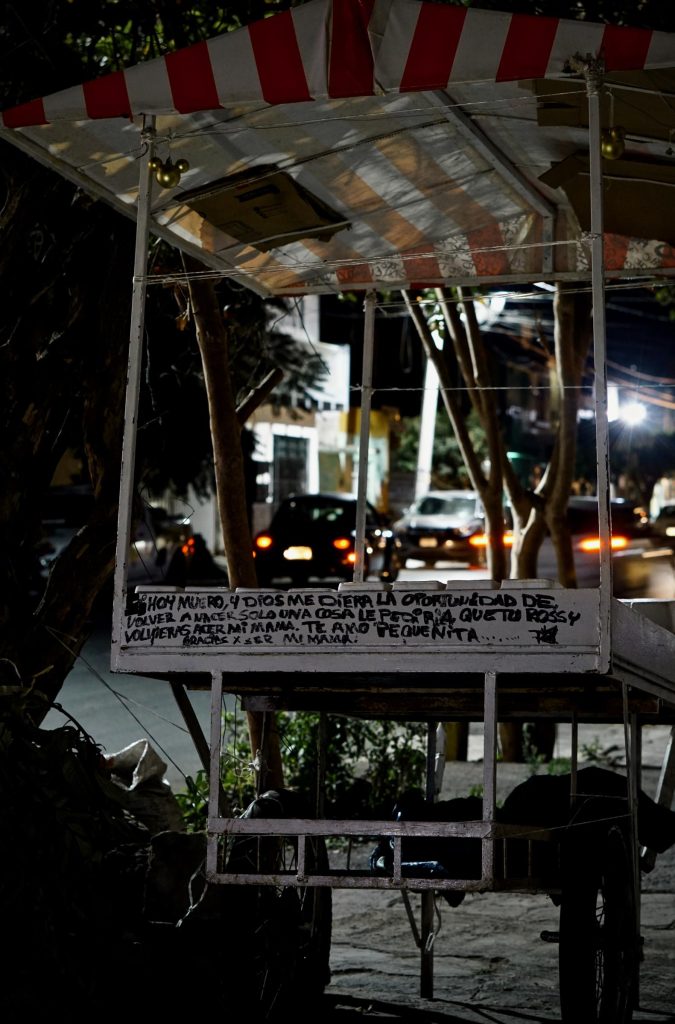
If I die today, and God gives me the opportunity to be born again, I would ask only one thing, that you, Rossy, be my mother again. I love you, little one. Thank you for being my mommy."
Avenida Virrey de Mendoza, January 2021.
Picture 19
Arboledas Second Section, October 2023
There is a great stigma attached to missing persons. In Zamora, the population has internalized the phrase "he was up to something" to justify any crime against humanity. I believe that this is a reflection of the fact that we have lost the ability to empathize with the pain of others, we think that violence is a reasonable means to punish or resolve conflicts, and it also gives us a false sense of security, since it will not happen to me, only to the other, to the one who is "up to something".
This symbolic violence exercised by the population has had various repercussions on the victims of forced disappearance and murder, and their relatives, in the search for truth and justice. It would seem that, if the victim had any link with illicit activities, to search for them, to demand justice or their appearance alive, would be illegitimate in the eyes of society, but also of their relatives, who out of shame or "lacking moral authority", are forced to live in fear and silence.
Itzayana Tarelo, anthropologist, personal communication, Zamora, October 2023.
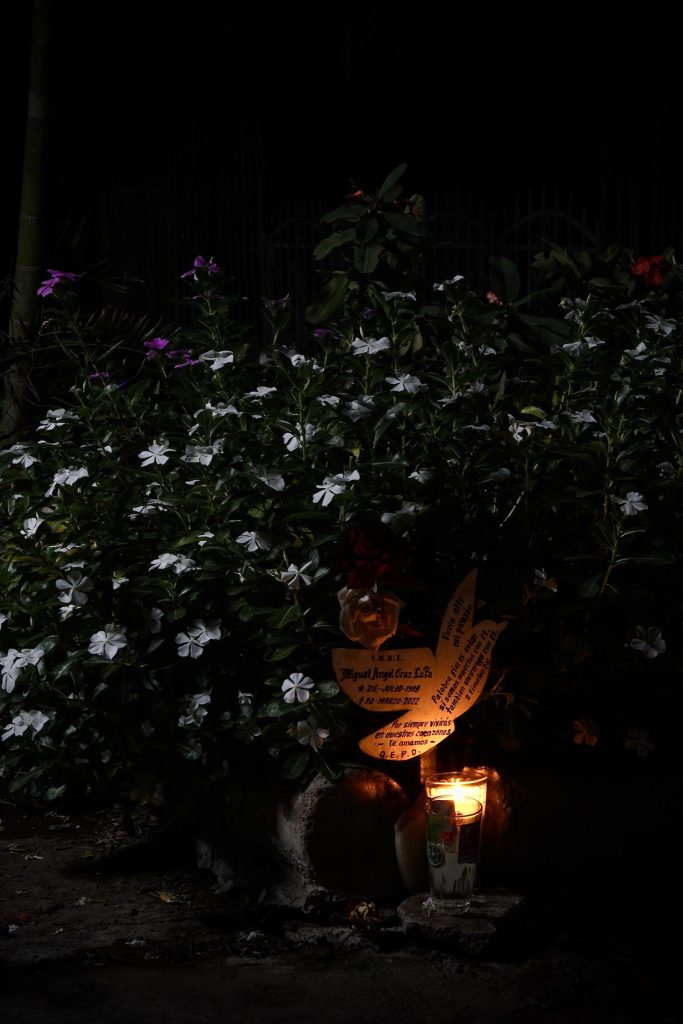
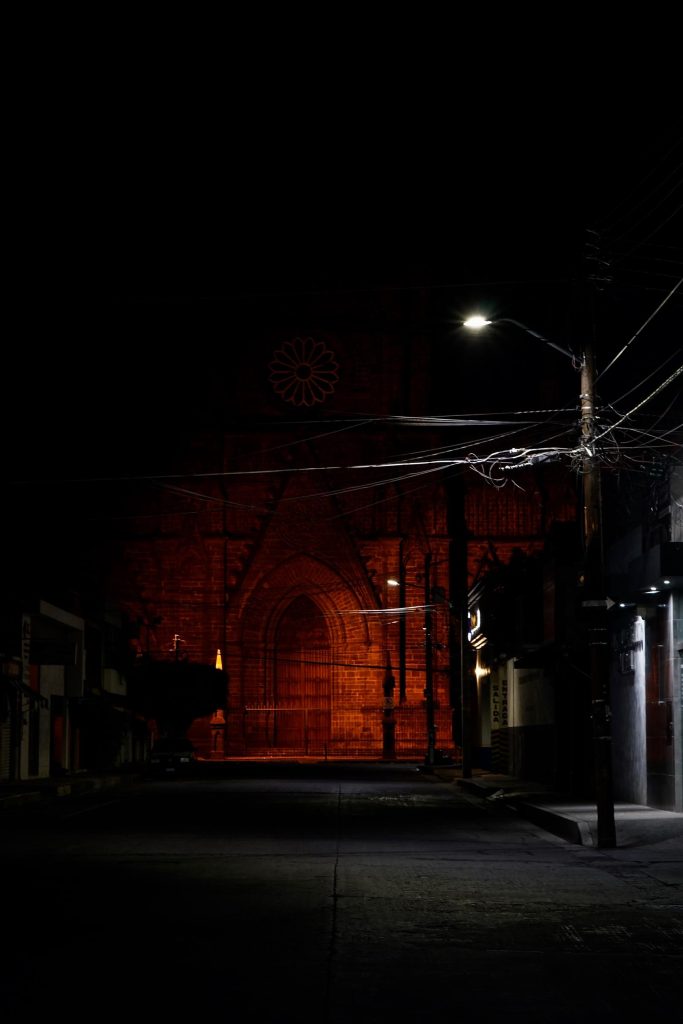
Picture 20
Guadalupano Shrine, Zamora Centro, July 2023
What level of violent deaths is socially acceptable? If we aspire to a death rate of 9.7 intentional homicides per one hundred thousand inhabitants, registered at the beginning of Felipe Calderón's government, or 17.9 when his administration ended, the 39 murders in Zamora and 15 in Jacona, in April alone, are a lot.
But if we compare with the 196.63 (per hundred thousand) publicized by the national press, according to the report of the Citizens' Council for Public Safety and Criminal Justice (March 11, 2022), then "we are doing well", since 39 murders per month would result in 468 per year, slightly above the 401 that result from an annual rate of 196.63%. Ah, but if we compare with the 57 intentional homicides in Zamora and the 21 in Jacona noted in December 2021, April is going down!"
José Luis Seefoo (2022)
Image 21. Asphalt up to the very trunk
Avenida del Arbol, May 2023.
A saleswoman from hot dogs she told me how two murderers waited for their victims among the trees. Although the ones she mentioned were just rickety ficus trees; to her, they added to the darkness of the scene. She went on to relate other murders in the area, including one on the next street. Drug addicts hung out there, she said, until several large trees were cut down. When I insisted, he acknowledged that the military rounds began around that time. However, she stuck to the fact that the trees were the main factor. For this lady, the trees were metonymically linked to danger and crime.
For an ex-taxi driver, these were thugs themselves. He told me of a dead tree that fell on top of a car, killing the parents and orphaning the children riding in the back seat. "No tree bigger than a person should be allowed!" he insisted. We also talked about the homicides that day, but he saved his indignation for the trees. When those responsible cannot be named for fear of reprisal, even trees can be a focus for articulating anxiety.
Rihan Yeh (2022) The Border as War in Three Ecological Images
(The border as war in three ecological images)
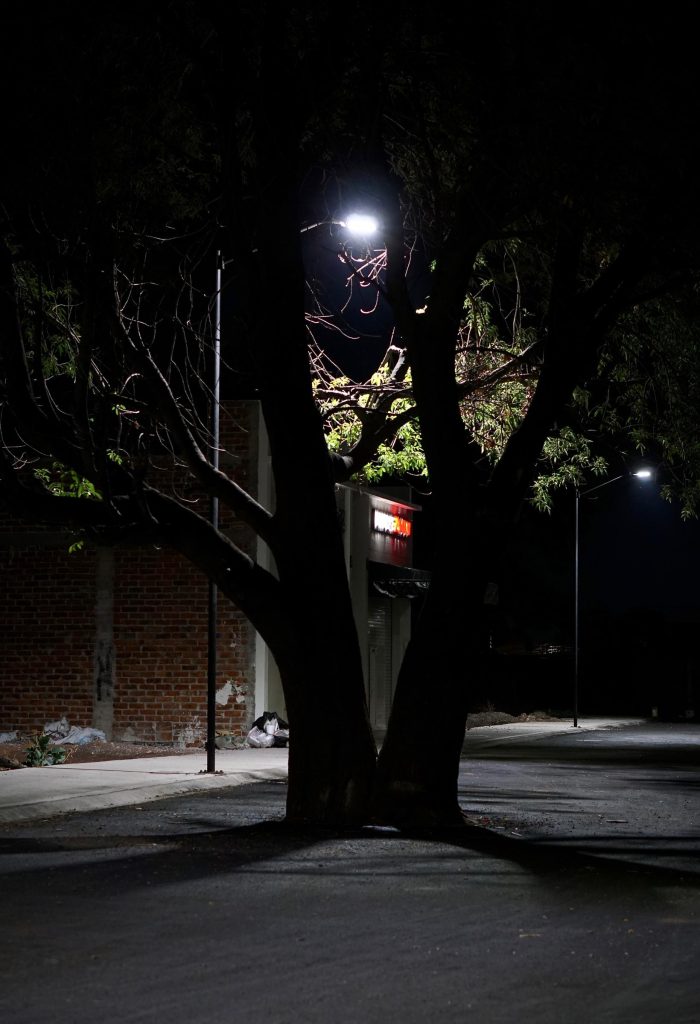
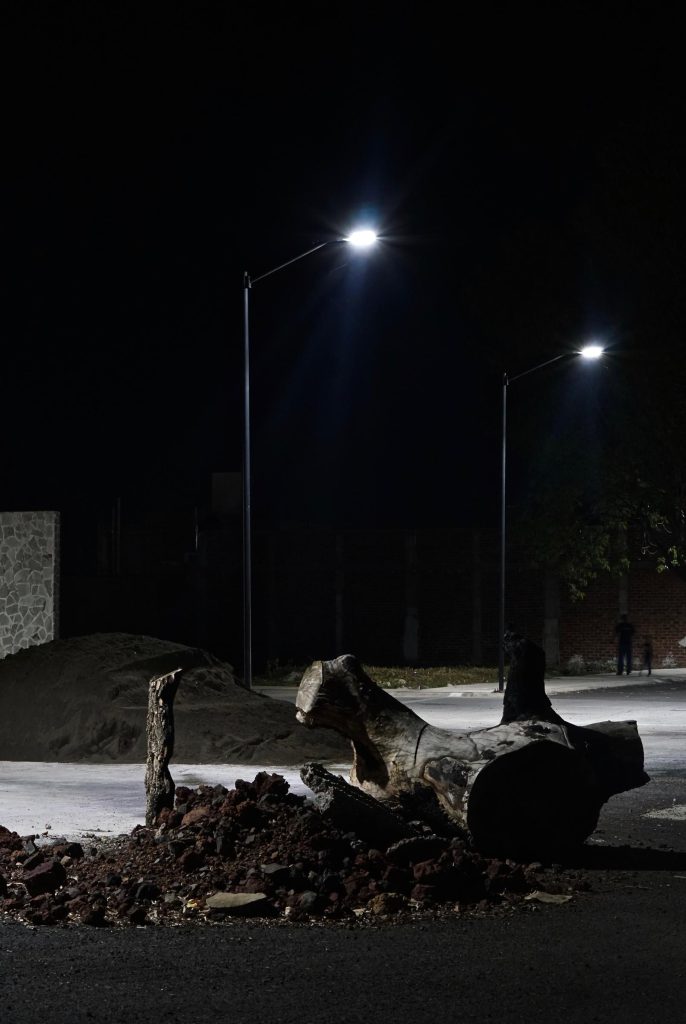
Image 22.
Avenida del Arbol, June 2023.
Picture 23
Day of the Dead, 2020, Colonia El Duero
The homicides, stated as 'confrontations', are in reality forms of manhunts of marginalized youths. Both victims and direct killers do not occupy high positions on the social ladder.
Thus, as long as the pain of loss and the smell of incense invade the homes of popular neighborhoods, intentional homicides will not drop sufficiently. If wakes and funerals were to take place in "residential" spaces, we should expect important changes...
Anonymous (textual)

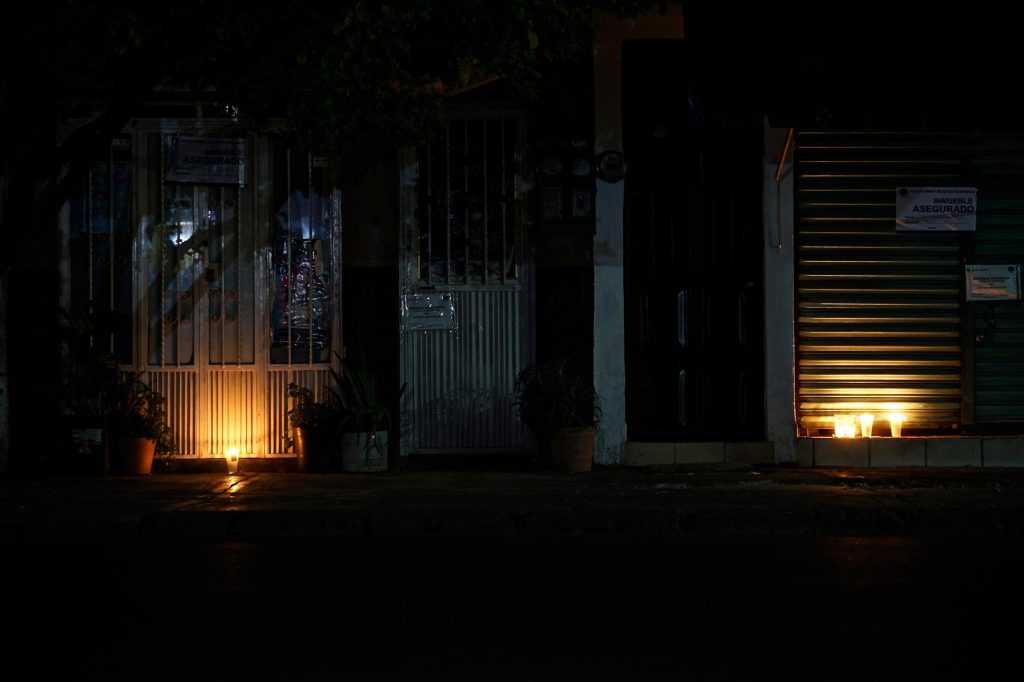
Picture 24
Colonia El Duero, January 2022
Image 25. The food stalls with their lights summon from afar to live with neighbors or strangers, a nocturnal sociability that does not give up.
El Duero, January 2022
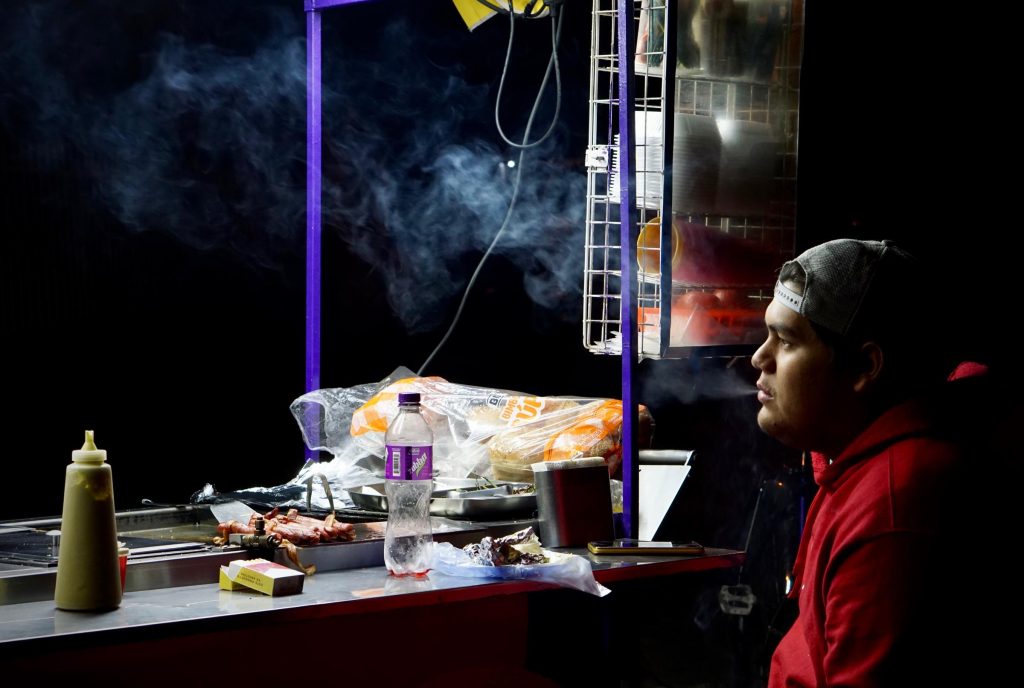
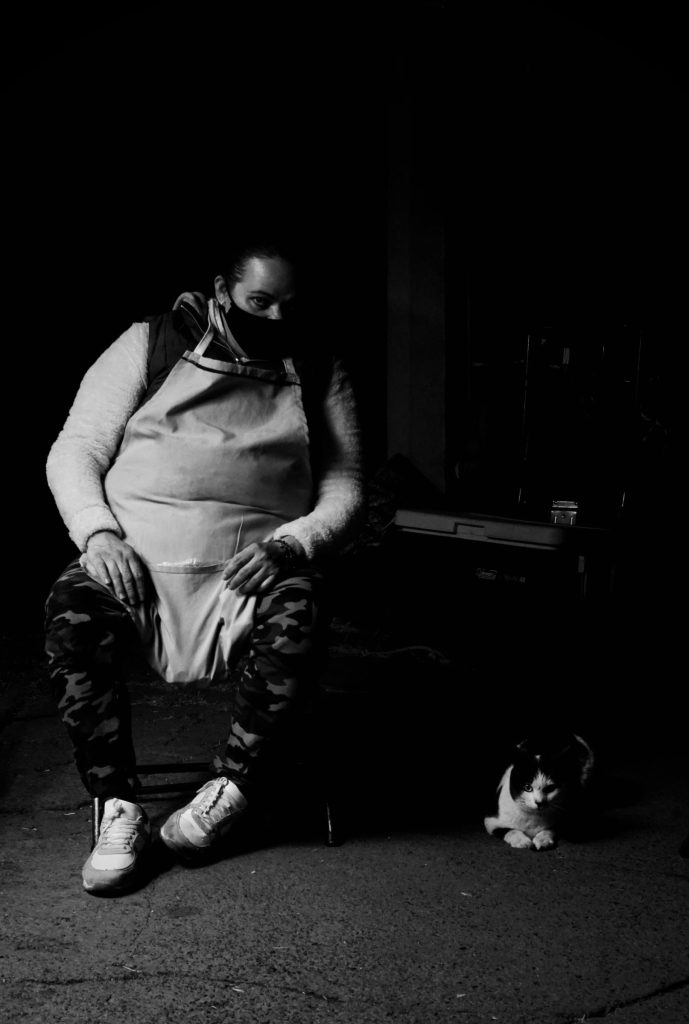
Image 26. Just called "The Metataxis": it gathers information from all cab drivers.
The Douro, February 2021
His hamburger stand is the one that closes most nights. He has the gift of getting watchmen, watchmen, policemen, hospital staff, taqueros who have already set up their stalls and who have also heard something, and a whole range of people who can't sleep for some reason.
Cab driver committed to the night shift and occasional diner at the hamburger stand.
Colonia El Duero, October 2022
After midnight, the conversation often becomes more philosophical. Bits of news that will never make it into a newspaper are gathered.
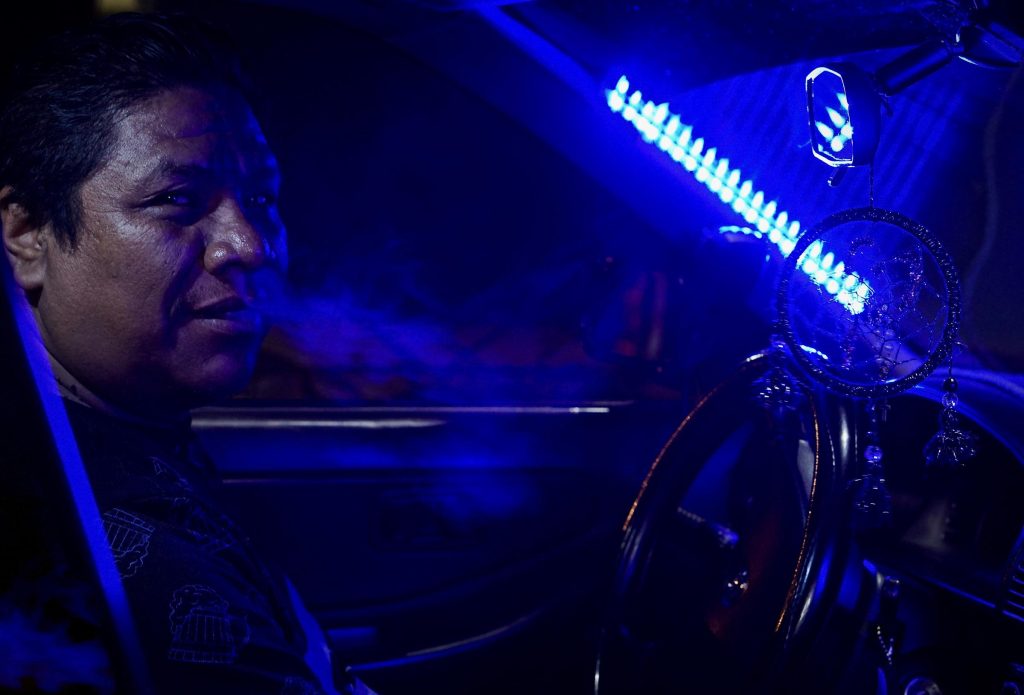
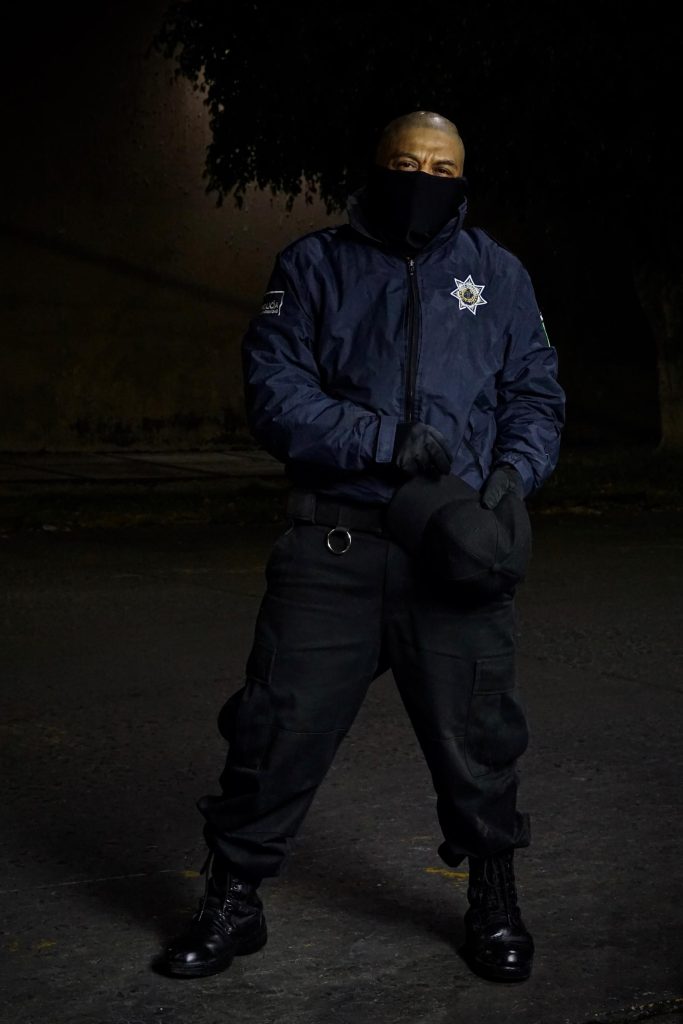
Image 28. Another member of the night owls' gathering. Topic: What is the fault of the night if you are killed during the day?
Colonia El Duero, 2022
Image 29
Zamora Centro, March 2023.
On March 5 we went out to march in Zamora for 8M. I was accompanying the contingent of women searchers and we were gluing, with paste, the cards of the missing persons. A few days later I passed by those streets again and I saw that they had tried to tear them up.
A friend of mine told me that in Queretaro the public cleaning people were instructed to remove all kinds of propaganda or posters and that is why they tore off the missing persons' cards. I suppose they do the same thing here, although sometimes the advertisement of an event lasts longer on a wall than the face of a missing person.
Anonymous, Zamora, October 2023
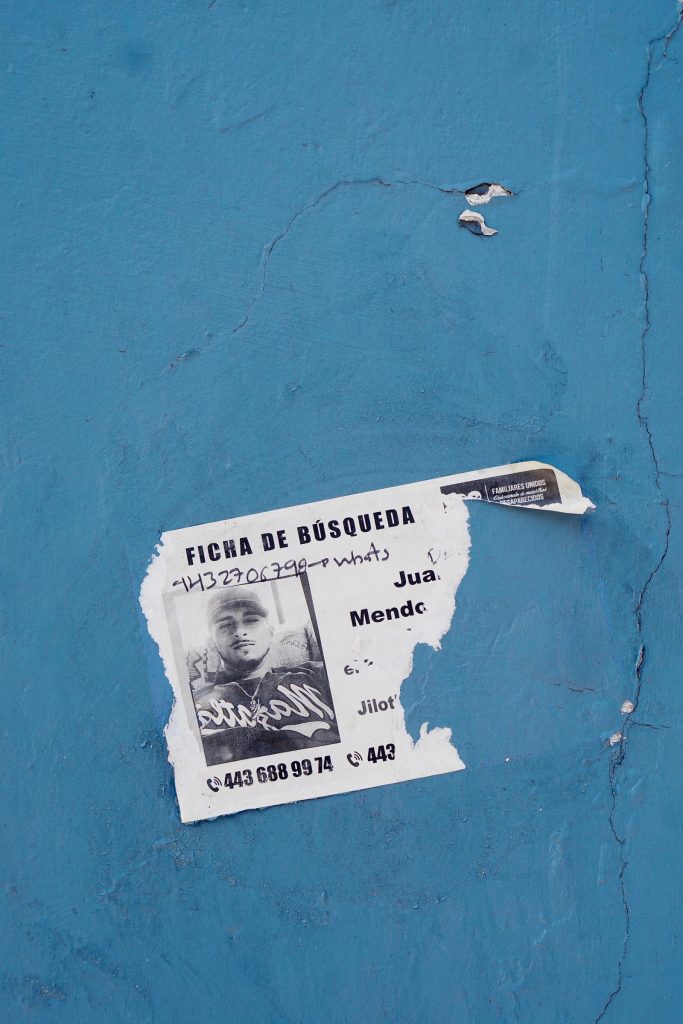
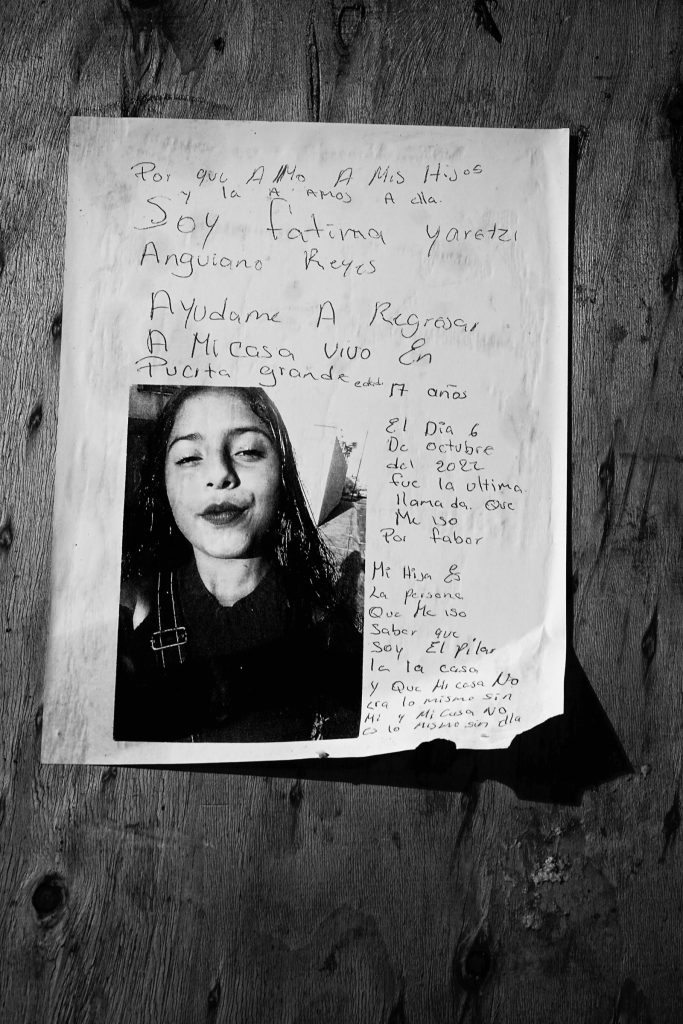
Image 30
Zamora Centro, August 2023.
To the perpetrators of the violence, the searching mothers have said "We don't want the guilty ones, we only want our children". With the celebration of masses and vigils in which prayers are said and candles are lit with the photo of their family member, the mothers seek God to soften the hearts of those who took their sons and daughters, not to abandon them in their search and to protect their family member wherever he or she may be.
Anonymous, Zamora (textual), October 2023
Image 31
Zamora, April 2023
We accompany ourselves with Our Lady's sorrow today, in the hope that she will be moved with us.
Anonymous, ending the Women's March of Silence
The March of Silence in the Catholic world is typically a procession of men commemorating the death of Christ on Good Friday. The Women's March of Silence has grown in parts of Latin America in recent years. In some, as in Zamora, it provides a language for some of the mothers of missing or dead young people.
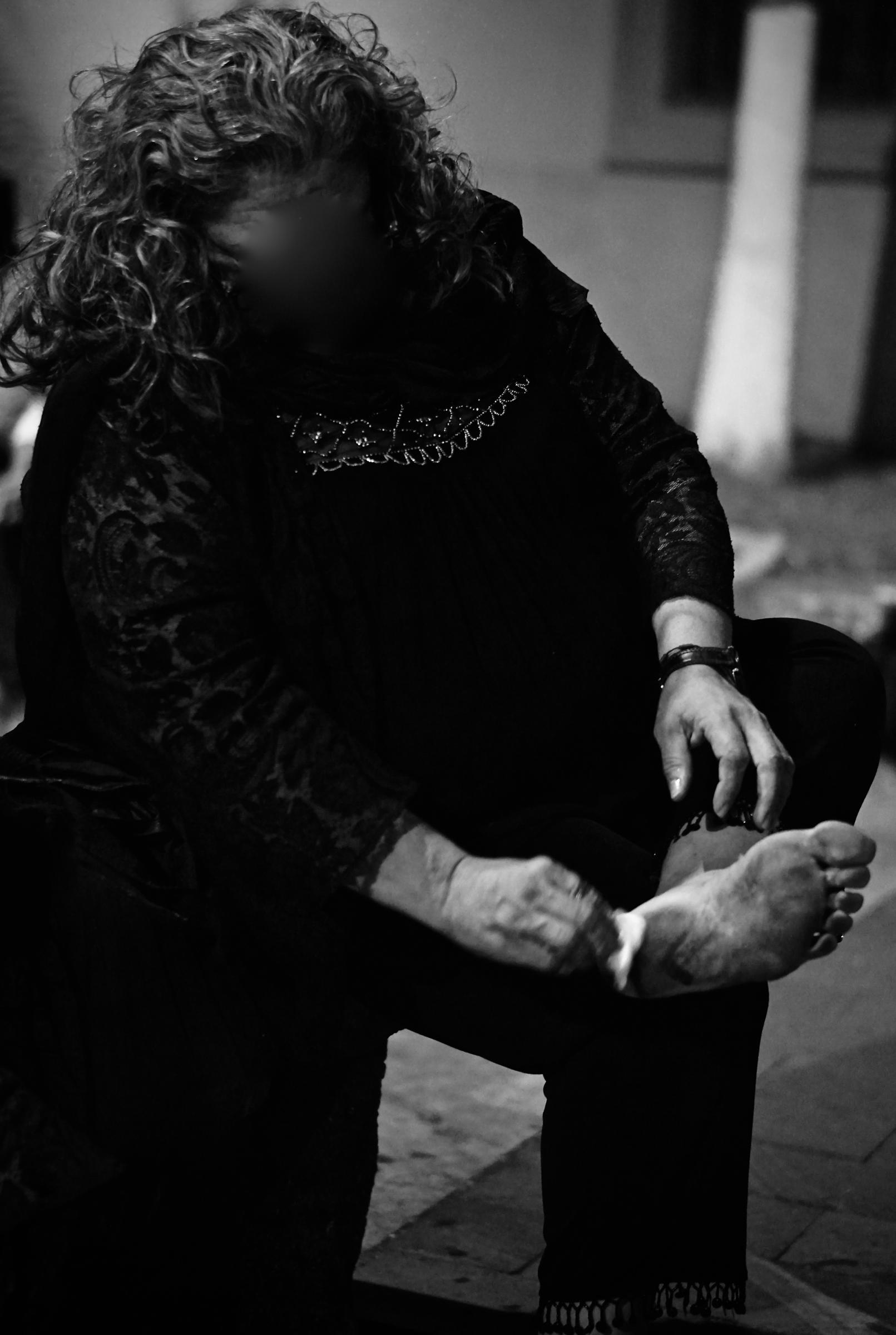

Image 32. Panther
Colonia El Duero, October 2020
These pains have no words. One keeps silent more out of modesty than fear. Crying screams and one hides the tears. All loss does not want to show itself impudently.
One closes oneself and keeps silent while one's heart burns, either for love or for absence. Impotence hurts and one knows that there is no return or solution. Poetics can only murmur. The anthropologist sometimes errs on the side of exhibitionism and fills with theoretical frameworks what hurts to mention.
The Douro Panther (textual), October 2023
Image 33. Anonymous. She made this figure representing her husband after he was killed.
Zamora, November 2023
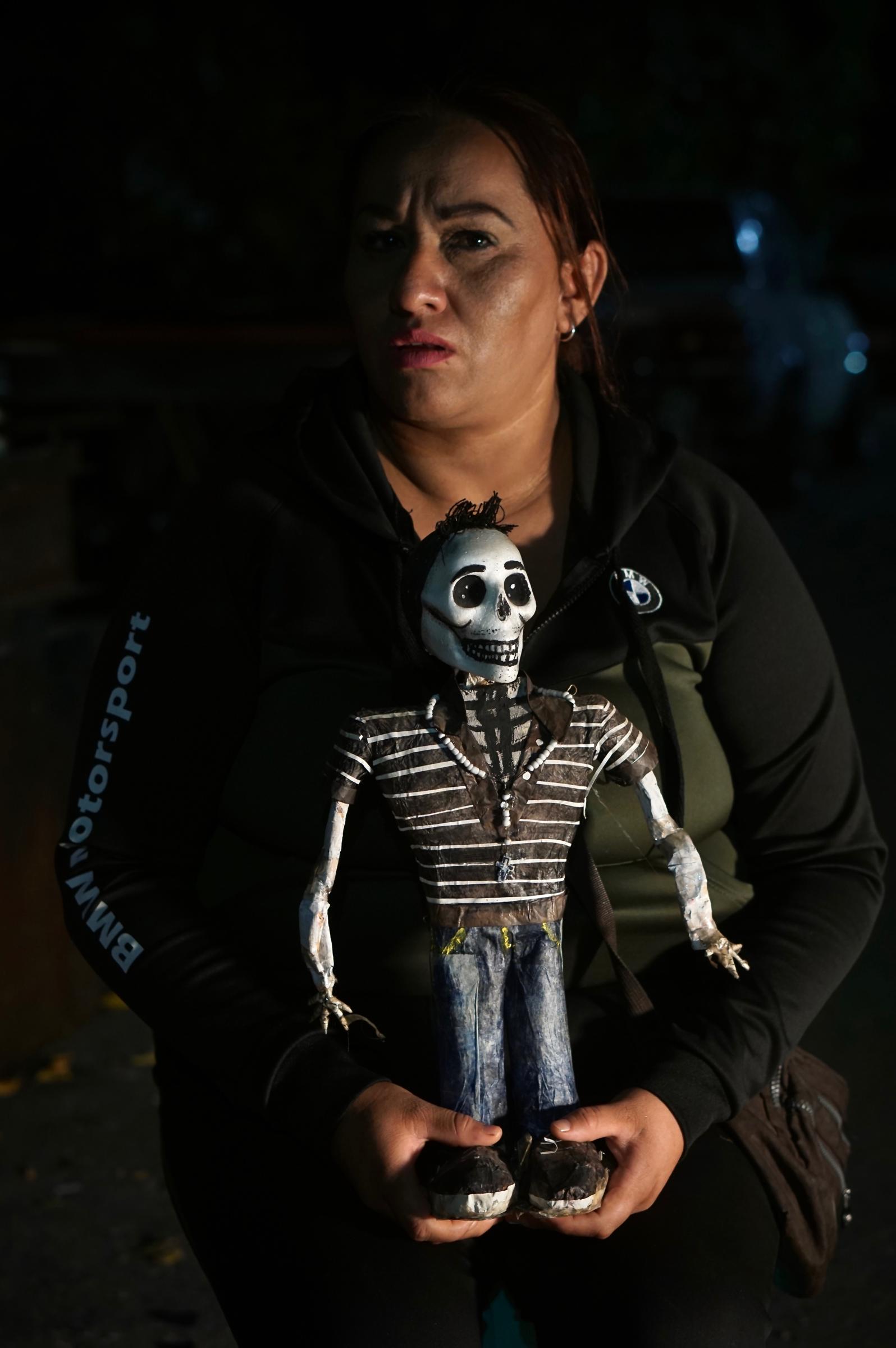
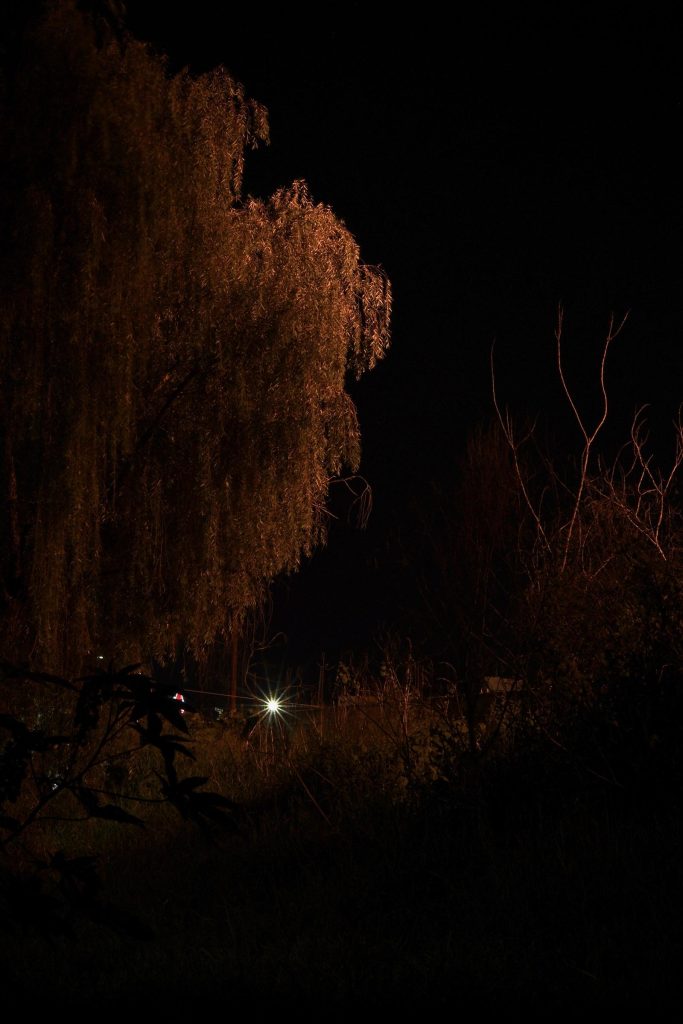
Image 34
Bank of the Douro river course
Four months ago (May 30, 2023) a teenager was killed in my neighborhood when he was going to pick up his girlfriend at CBTIS. Rumors said it was for stealing his cell phone. Some guys on a motorcycle chased him and shot him many times, until he fell dead on the corner of a vacant lot, where people throw garbage.
A few days after he was murdered, his family put up a small metal cross, some plastic flowers and a candle, but someone came by and tore the cross down and people threw garbage there again.
My mother told me that she felt bad that the boy didn't have a cross, so she made him another one with some pieces of wood she found in the yard. She put it up and, days later, she found it lying in the vacant lot, as if someone had thrown it. We think that this could only have been done by the person or persons who killed him, that the cause of his death was personal and not a robbery, as it was said.
We feel that it was a matter of hatred, of a lot of anger against the boy, because they did not respect the place where he died, nor the crosses. I feel that there was a desire to erase him, to erase his memory.
Anonymous (verbatim), October 2023
Image 35
March 29, 2024
The Women's March of Silence grew exponentially; the municipal government estimated that 15,000 people participated.
Silence was strictly maintained, punctuated only by drums with a slow, synchronized rhythm between contingents. Likewise, other signs were discarded and only those that reminded to remain silent were kept.
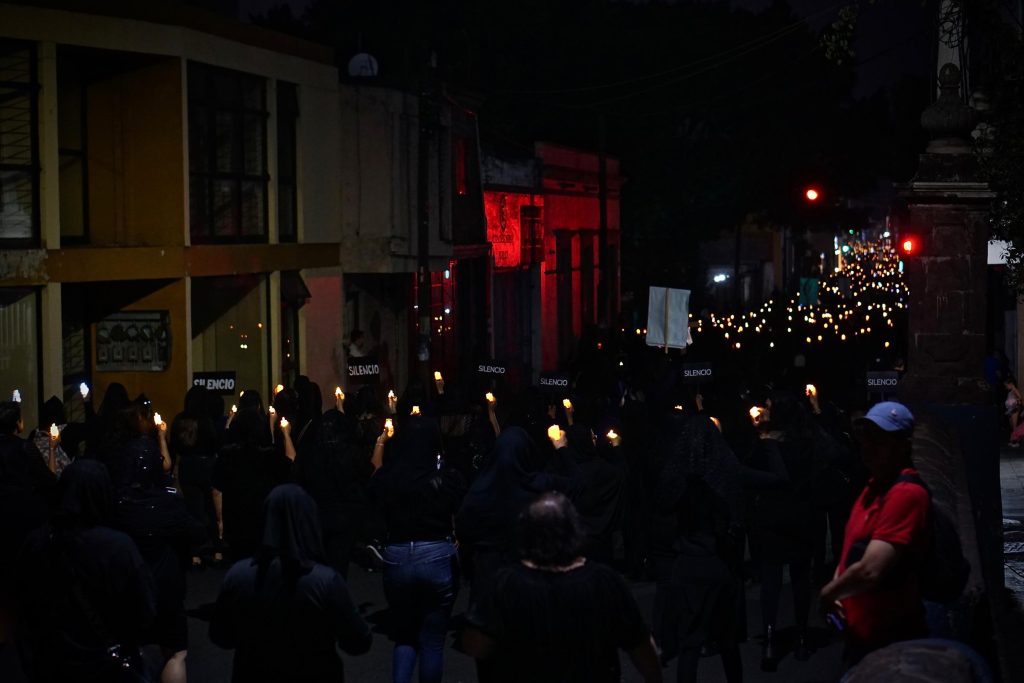
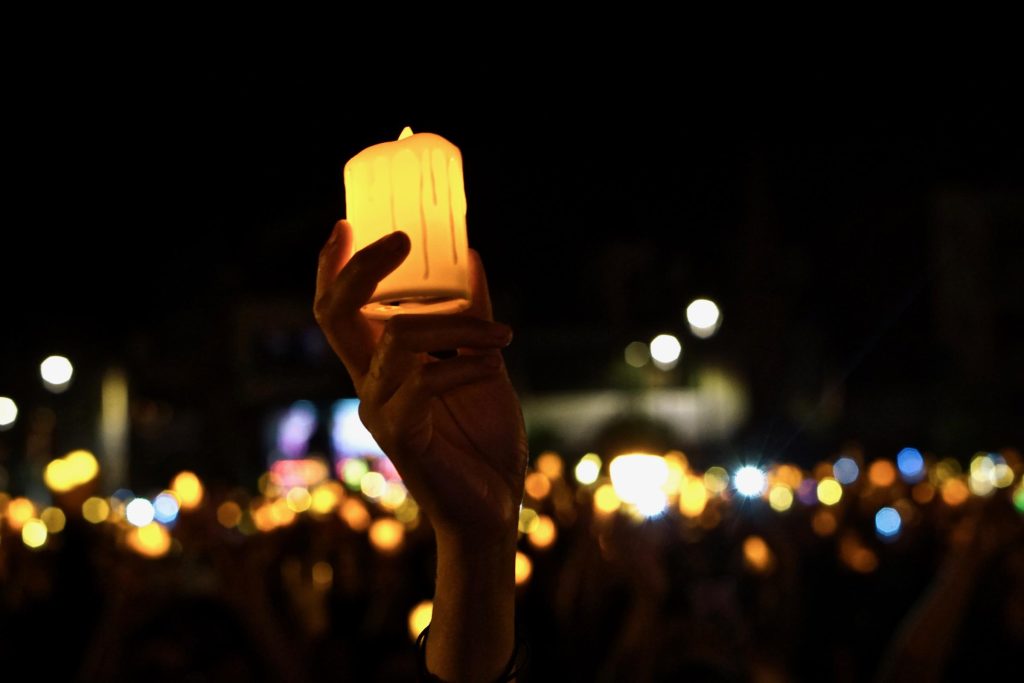
Image 36
Guadalupana Shrine of Zamora, March 29, 2024
They were received by their rector, Father Raúl Ventura, who congratulated them because "Zamora is consolidating its position as a leader in religious tourism.
Image 37
Avenida Virrey de Mendoza, January 2022
Where language must be imprecise, a flame in the night communicates, even if it is difficult to know who put it there or to whom it is addressed. To the dead man himself, of course; to God.


Image 38. During the day they are not even seen. At night they acquire convening power
Hidalgo Market, September 2022.
Image 39. It hurts. See it
Jacinto López, October 2022.
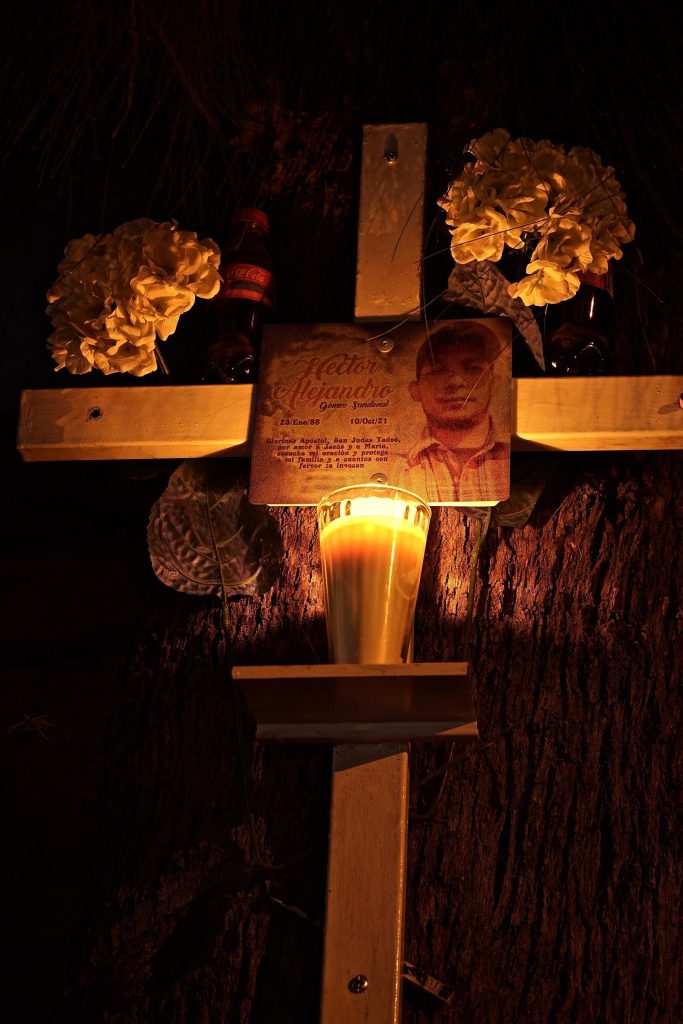
The author would like to publicly acknowledge the support and patience of her colleagues at the Centro de Estudios Antropológicos, Colmich; the collaborations of Itzayana Tarelo and Reynaldo Rico Ávila to think the narrative arc from a hundred photos or more; the enthusiasm of Renée de la Torre, Paul Liffman, Melissa Biggs and Gabriela Zamorano, as well as the complicity of Ramona Llamas Ayala.
Dedicated to the memory of Julio César Segura Gasca, alias the FUA (1967-2024), poet of the Zamorano night.
Bibliography
Citizen's Council for Public Safety and Criminal Justice (2022). "Ranking 2021 of the 50 most violent cities in the world." https://geoenlace.net/seguridadjusticiaypaz/webpage/archivos Accessed: August 2023.
Jelin, Elizabeth (2001). The work of memoryMadrid: Siglo xxi.
Seefoo Luján, José Luis (2022). "Zamora va... muy bien?", Semanario. Guide. https://semanarioguia.com/2022/04/jose-luis-seefoo-lujan-zamora-va-muy-bien/
Yeh, Rihan (2022) "The Border as War in Three Ecological Images," in Editors' Forum: Ecologies of War, thematic issue, in. Cultural Anthropology. January. https://culanth.org/fieldsights/series/ecologies-of-war
The awareness of being looked at: giving a view of the tianguis stall
Frances Paola Garnica Quiñones
El Colegio de San Luis, San Luis Potosí, Mexico.
is a Conacyt postdoctoral fellow at El Colegio de San Luis. She holds a master's degree and PhD in Social Anthropology with Visual Media from the University of Manchester, UK. Her research topics include the perception and imaginary of spaces, Chinese migration in San Luis Potosi and ritual and therapeutic uses of peyote from a biocultural territory defense approach. She is co-director of the documentary ...And I'm not leaving the neighborhood! (2019).
Orcid: https://orcid.org/0000-0001-6957-1299
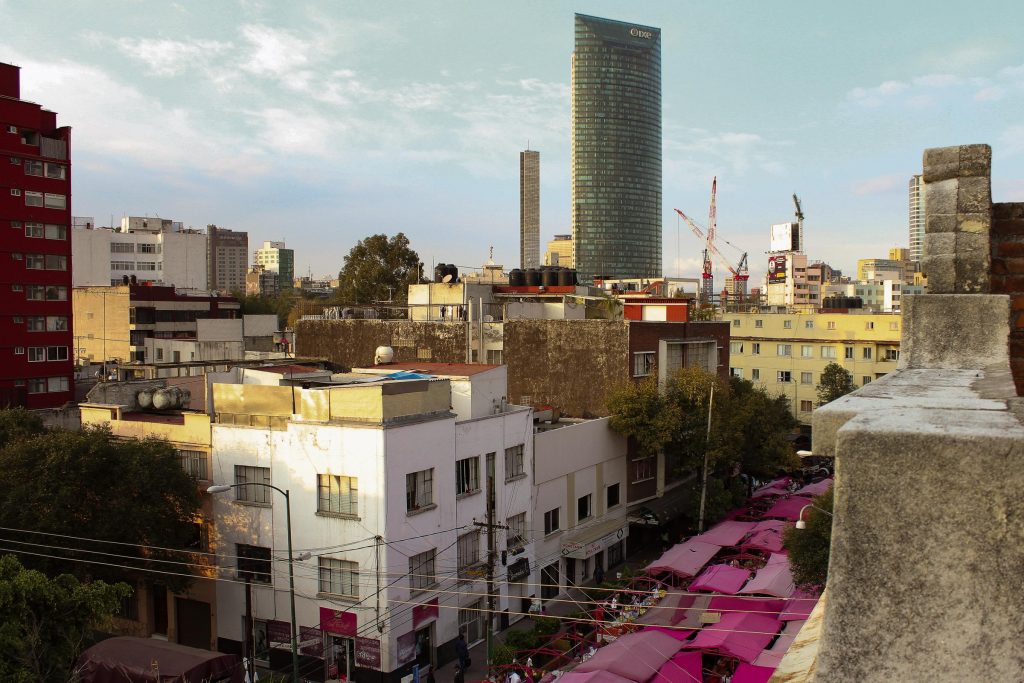
Image 1
Tianguis: a place to watch
CDMX, 2012.
Once a week the Ruta 8 de Mercados sobre Ruedas is installed in eight different neighborhoods of the CDMX. People visit with certain expectations of the place:
The tianguis is a light bulb on, a journey, a back and forth, going in search of something with the desire to get something, open space, without walls, without walls. There is room for everyone; it is a tradition, an adventure, a means of sustenance, a job and a chinga. - Rodrigo, dealer.
Picture 2
"The tianguis can be seen, smelled and touched" (Jorge, art dealer).
CDMX, 2013.
The atmosphere of a tianguis is generated in large part thanks to the work that tianguistas put into the presentation of their stalls.
The main expectations of a tianguis from the perspective of the marchantes are that, 1) its installation is on the public street, 2) there is an atmosphere of exploration, sociability and personalized attention, 3) there are products that are not found in other establishments and at low cost, 4) the visit is recreational and enjoyable, 5) there is room for maneuver in the commercial exchange, such as bargaining and bargaining.


Picture 3
"Why do I always get hungry at the tianguis?" (Carlos, dealer)
CDMX, 2013.
These expectations are not the result of a marketing study where the preferences of the potential clientele were calculated and then the tianguistas created and executed an action plan accordingly. They are the result of the observations and adaptations made by the tianguistas in order to set up a street sale. They bring together a series of knowledge about the use of space, hygiene, product presentation, interaction with vendors and internal social organization. Since stalls are usually passed down from father to son or daughter, this knowledge is acquired and inherited over decades of coexistence with vendors.
Picture 4
Assemble the stand
CDMX, 2013.
At eight o'clock in the morning, the constant whistle of the devils or chargers alerts pedestrians walking in the middle of the traffic of devils (wheelbarrows). Heavy wooden boards on the floor mark the place of each stall. Half-assembled stalls, like skeletons, wait to be dressed. But the tianguistas must take into account the rules imposed by the association itself, the government and the neighbors of each neighborhood: install the awning of the indicated color, have the stall tubes painted in the same color, do not exceed the allotted meters, do not ruin flower boxes or fences of the neighborhood, keep the boxes and other materials tidy in the back of the stall and avoid cables, ropes and obstacles in the aisles, among others.

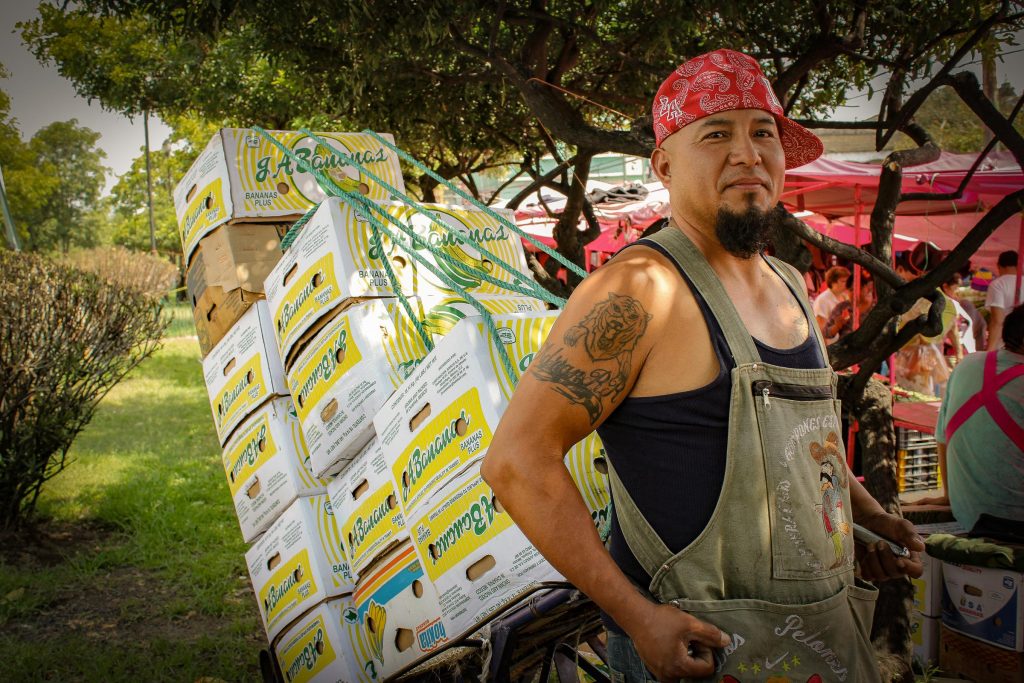
Picture 5
Diablero
CDMX, 2013.
The diableros perform work that requires great physical effort. A diablero can carry up to 100 kilos. They load, unload, assemble and disassemble the tubes of the stand. They can also act as assistants, serving customers and giving "testers" to the vendors. For many migrants, this job is their first entry into the world of work in the CDMX, as the requirements are minimal.
Picture 6
Assistant
CDMX, 2013.
The stall owners usually hire employees to help them unload the merchandise and set up every day. The tianguistas who do not have their own cargo truck hire freight drivers who store the merchandise in their truck overnight and deliver it early in the morning to the neighborhood where the tianguis is to be set up.
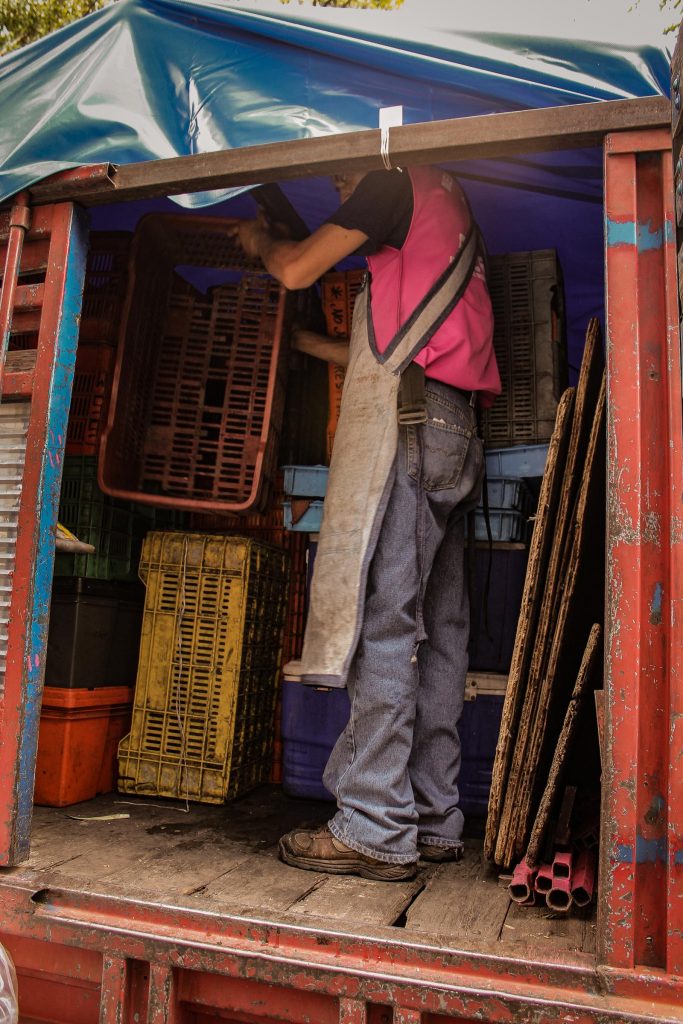

Picture 7
The tailor of the post
CDMX, 2012.
Abel, an assistant at the banana stand, resembles a tailor who puts the finishing touches on the stand. A native of Veracruz, he considers his trade to be that of a farmer, but he has developed diverse skills over ten years of handling the stall's structural materials. Abel prepares and adapts the stall for possible weather conditions: clear, rainy or windy. He uses coins that he wraps and ties around the corners of the stall's canopy to get a better grip. He says he likes this work because it awakens his creativity.
Picture 8
The art of banana placement
CDMX, 2012.
Abel takes the bunches of bananas from the rows he already formed and, with a curved knife, skillfully cuts the top of the stem without splitting the bananas, making the joint look flatter:
I'm giving them a view. It's more attractive; the bananas look fresher and more appetizing..
Giving a view consists of working on the aesthetic and spatial presentation of the stand and the products that compose it.
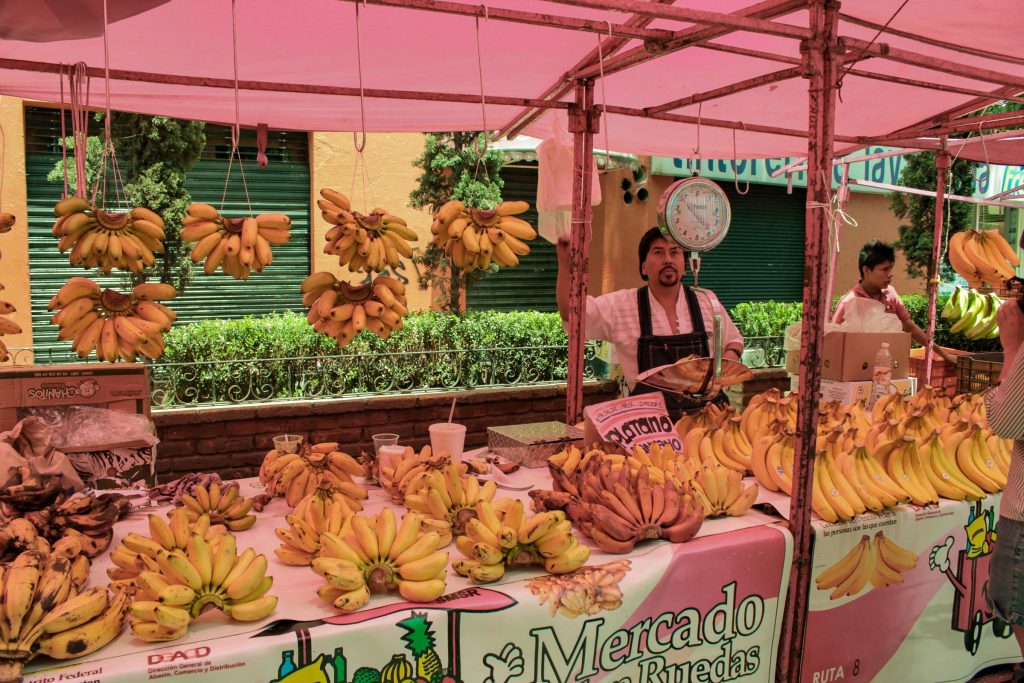
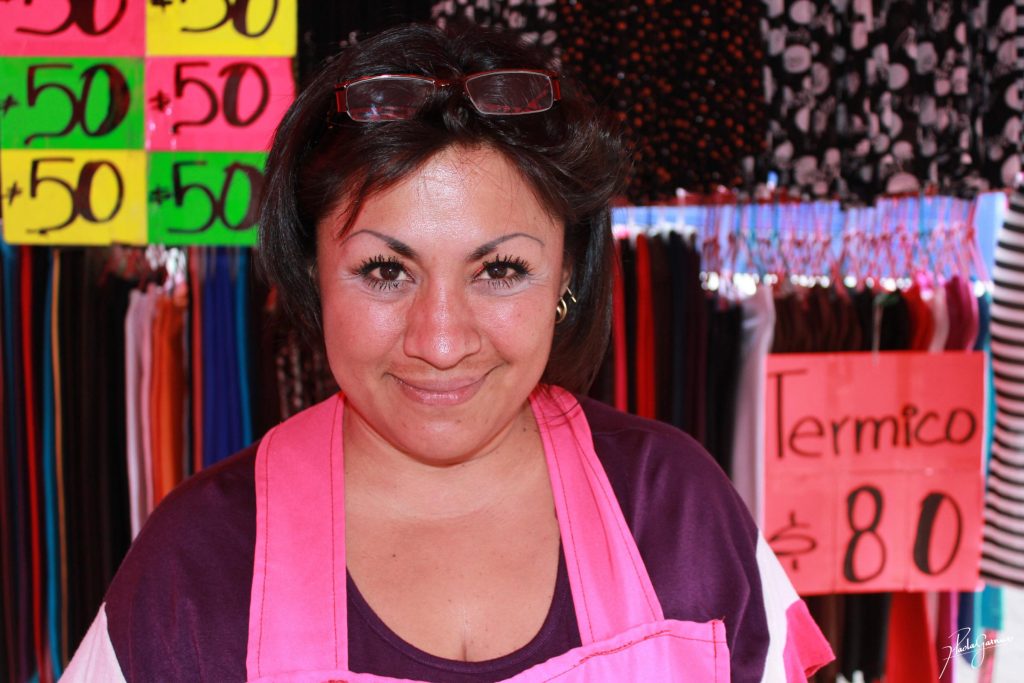
Picture 9
The stocking stall
CDMX, 2012.
A few meters from the banana stand, Olimpia is unpacking the merchandise from her hosiery stand. Her mother inherited it from her. After a hired loader assembles her two-meter stand and places large drums full of clothes, Olimpia arranges the merchandise. As part of give view to her stall, she also often dresses her merchandise, a strategy that has helped her sell.
Picture 10
Giving sight is inherited
CDMX, 2012.
On the front counter, Olimpia places colorful socks that she has had dyed, because it's cheaper. She stretches them along the corner of the stall, creating a rainbow of nylon. Light filters through the transparent material, highlighting the delicate patterns of the stockings, which are hung like invisible legs. Bundles of stockings portraying several white-skinned blonde women hang at the front of the stall, swaying delicately in the morning breeze.
From my mother I learned to show my stockings like this. She always told me to hang up my stockings just like this. They look great, don't they? Don't they? Look at them. - Olimpia, tianguista.


Picture 11
Variety in 2 meters
CDMX, 2012.
The extensive variety of merchandise that Olimpia handles includes more than a hundred different products. After three hours of arranging socks, tights, leggings, tights, stockings, lycra skirts and so on, Olimpia arranges her seat, which consists of a stack of box tops on a storage box, and checks on Galleta, her little French Poodle who is napping very comfortably on a cushion.
Picture 12
Giving a view is innovation
CDMX, 2013.
During the 1980s, before the Free Trade Agreement, the tianguis were the place where innovations were found. Things that were not allowed to be sold were sold freely in the tianguis. It was a place of novelties. People liked to find something new, even if it was the same thing, but in a different form, for example, curiosities, like jicama. Instead of selling it in a jar, you put a stick to the slice of jicama and it becomes a special popsicle called "jicaleta". That's something innovative and it was sold at the tianguis. Fruit covered with chocolate, things like that. The idea was to look for something attractive, something curious. It was more than just satisfying a desire to consume. - Roberto, tianguista.
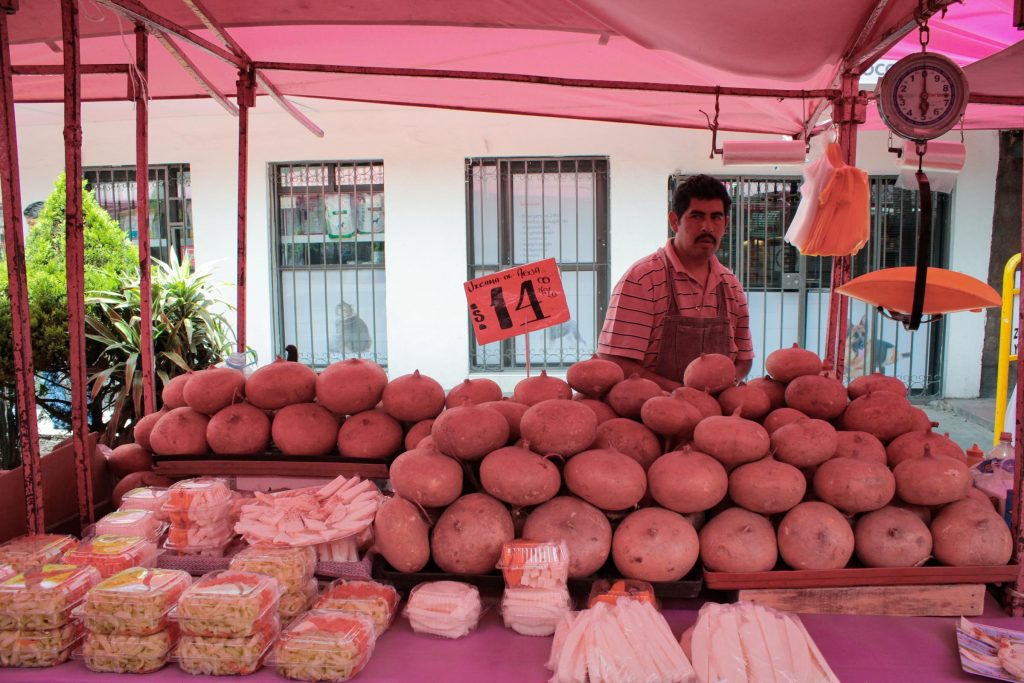
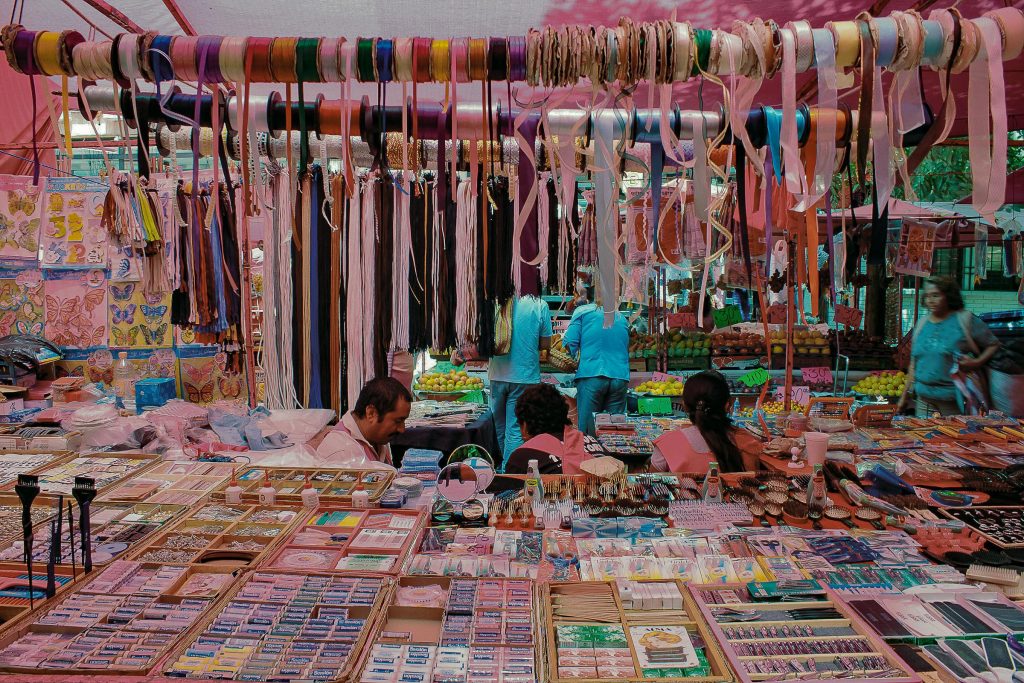
Picture 13
Recognition comes through the eyes
CDMX, 2012.
On Sunday more foreigners arrive and I would imagine that in their countries there are not as many things as here. It is a marvel for them to see our work, because it is not easy to arrive and find everything already shaped, washed, cut, sliced; it is a great task that we do from very early in the morning and they are amazed. And they see it as a treasure that we have. I don't know, maybe, if we had it every day, it became more habitual and maybe you don't value it so much. You see the enthusiasm, the expression on their faces, how they stand with their cameras, film and ask for permission. Many are more observant. They try to see the structures we have to work with, because it is not easy, and they are even more amazed when they go the next day and there is nothing of what they saw the day before.. - Abel, tianguista.
Picture 14
The good trader
CDMX, 2012.
The tianguis reminds you not to assume that there are no faces on the fruit. Here at the tianguis, you can see that the vendors work for the goods. They share their knowledge about the produce, how it can be eaten. It's a more direct approach, not like in the storefronts. - Octavio, art dealer.
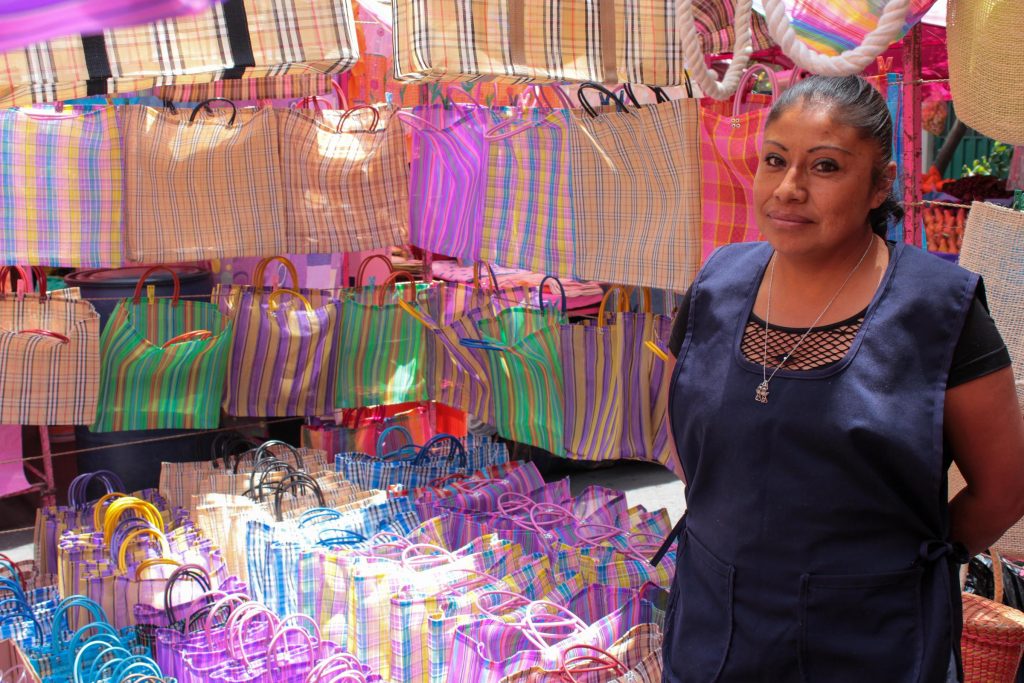

Picture 15
Oranges with a view
CDMX, 2013.
Twice a week Roberto, tianguista and representative of Route 8, buys 90 kgs. of oranges in arpilla, as many kilos of Valencia oranges, grapefruit and pineapples.
In Abastos, a higher monetary value is given to oranges that "have eyesight", that is, those that are large in size -and therefore heavier-, uniform in color and without blemishes.
Picture 16
Automatic and manual aesthetic selection
CDMX, 2013.
At the Central de Abastos, a machine sorts the oranges by size and, via a conveyor belt, sorts them into compartments. Once the oranges have fallen into these compartments, two fruit sorters pick them up and manually select the oranges that have spots or dents.
Some fruits get leaves stuck to them when they are growing and get stained. We take care of this. We select the best ones, and the ugly ones we remove so that the fruit has a better presentation. This is what helps people consume more.- Ángel, worker at the Central de Abastos.
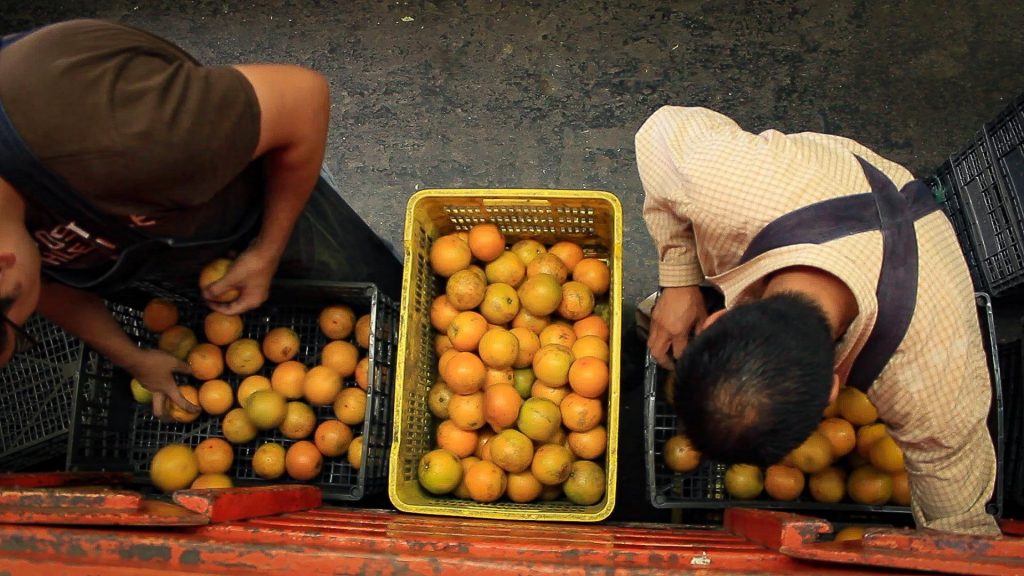

Picture 17
Back at the post
CDMX, 2013.
Roberto finally arranges the oranges in his stand. These oranges have gone through a selection process that is part of a chain involving the aesthetics of the product. The oranges with the "best look" are given at a more expensive price to the dealer. Roberto also sources oranges for juice, pineapples and grapefruit.
Picture 18
Map of a tianguis stand set up in the vicinity of the Velódromo sports center.
CDMX, 2013.
These are the basic elements that make up the assembly and presentation of a Ruta 8 citrus stand. Variations tend to occur with respect to the type of products being sold, the neighborhood where the stand is set up, where space may be larger on some streets than on others, and the needs of the vendors. Annexes are more tolerated in Velódromo, where there is much more space than, for example, in La Condesa.
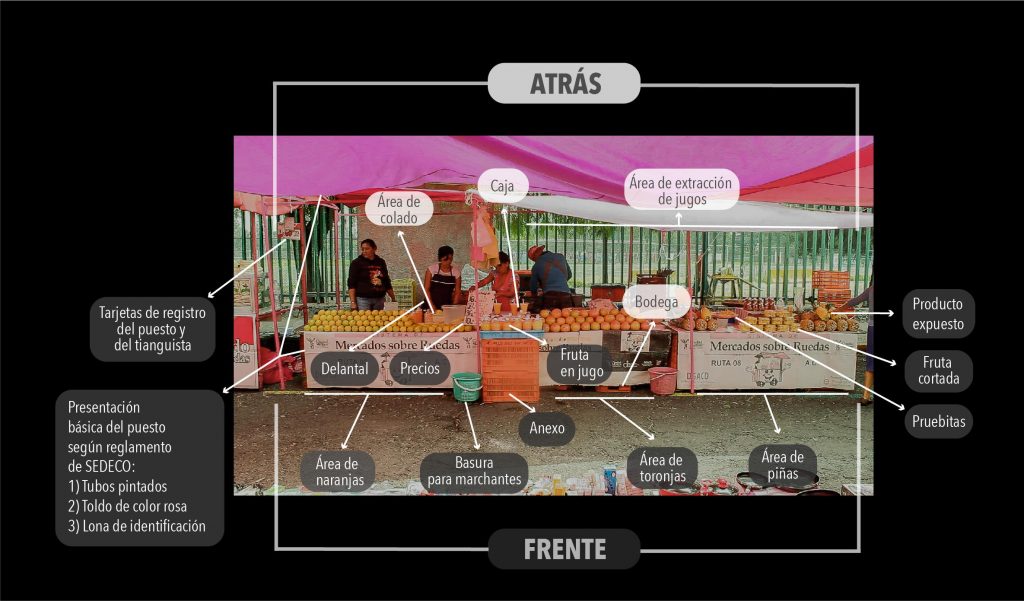

Picture 19
Social control and view
CDMX, 2013.
Roberto, as a representative of Ruta 8, along with the coordinator of the Markets on Wheels Program and a representative of a neighborhood committee, review the news to measure risks, threats and points for improvement. They set out to carry out the monthly supervision of Ruta 8's facilities in the Condesa neighborhood. The criteria for this supervision focus on the presentation of the stall and the use of the space.
Picture 20
Aisle width
CDMX, 2013.
Roberto measures the aisle space together with the coordinator. Maintaining an adequate width is important to maintain a comfortable and safe circulation of people. We also check that there are no annexes or extensions of stalls beyond the permitted measurements, to avoid unfair competition among vendors.
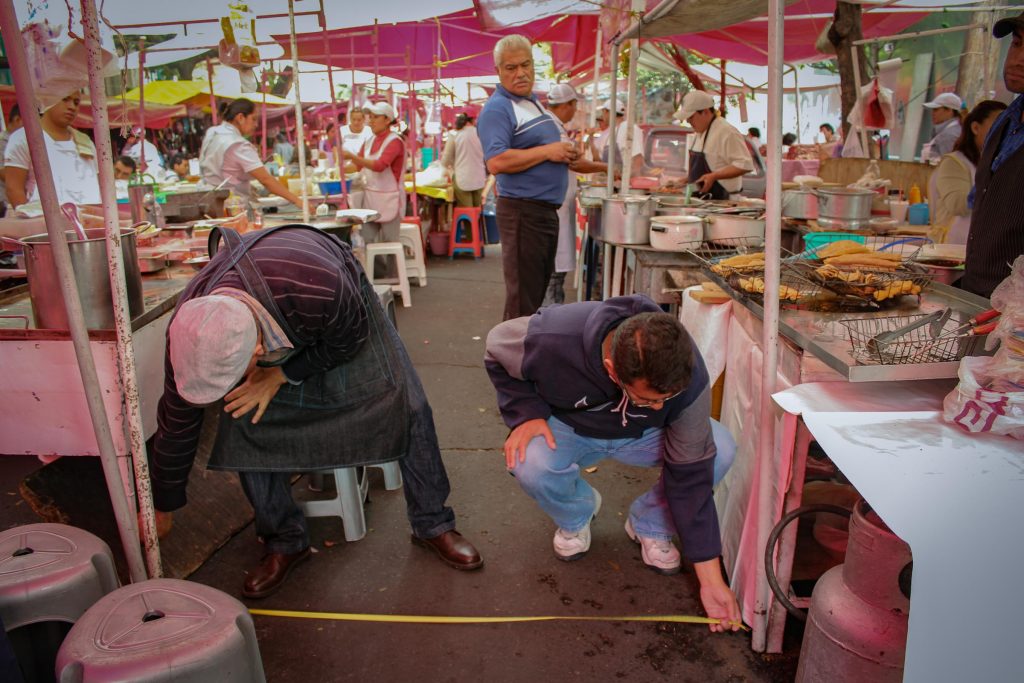

Picture 21
Annexes
CDMX, 2013.
An annex is any extension of a tianguis stall. Annexes can obstruct the circulation space of the aisle and also invade the space of another trader's stall. Some tianguistas also denounce the invasion of their stalls with annexes of others:
If I don't complain, I get more space tomorrow.. - Tianguista of Route 8.
Picture 22
Inches away from unfair competition
CDMX, 2012.
Exceeding the spatial limitations of a stall can translate into a problem for tianguistas. The consequences of annexes are often complaints by customers and neighbors to the local government or the media, which contributes to a damaging public image of the tianguis and the suspension of working days for traders by the authorities.

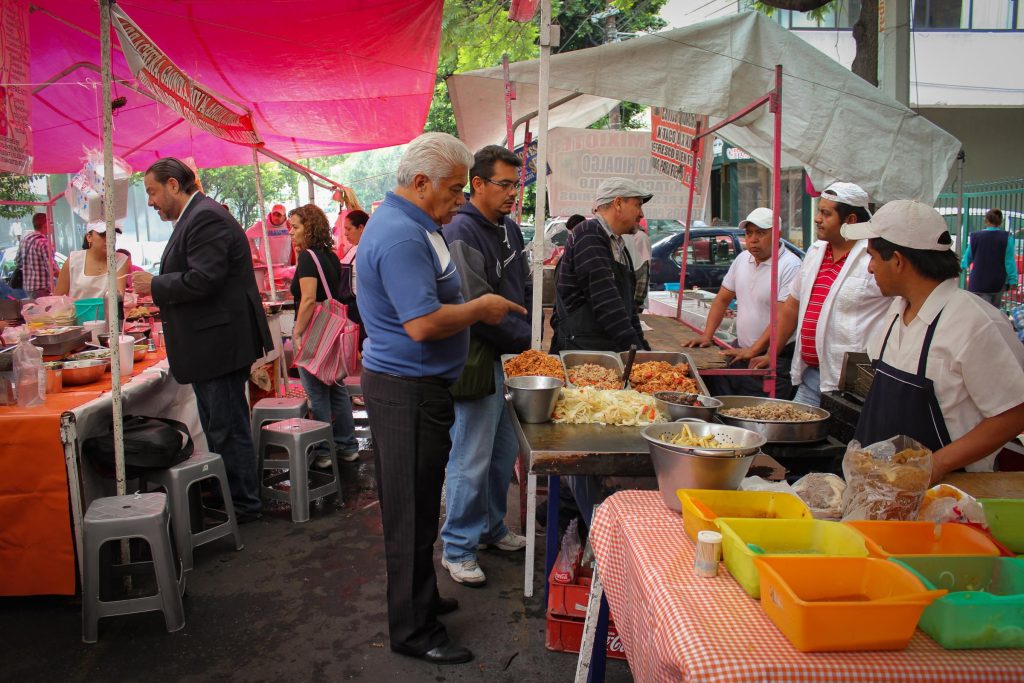
Picture 23
Walking without burning
CDMX, 2013.
It is also checked that there are no hot stoves, boxes, electric cables or other objects that could compromise the safety of the marchers. In the image, these indications are directed to merchants of stalls that do not necessarily belong to the Ruta 8 association but that are installed in some neighborhoods together with them. These stalls may be independent or belong to other tianguista associations. However, for Roberto it is important that these stalls abide by the rules, because otherwise "we can all be lumped together".
Picture 24
Circulators
CDMX, 2013.
The criteria that are reviewed during an aisle supervision are based on the people who walk the tianguis, especially those with limitations, such as the elderly, children in strollers and people with disabilities.
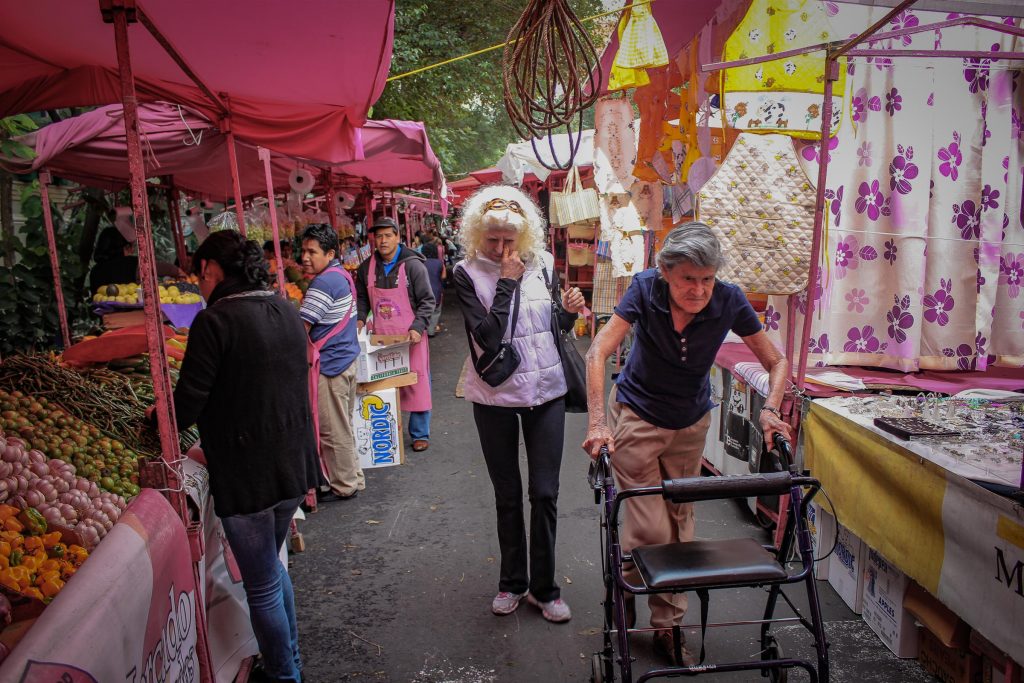
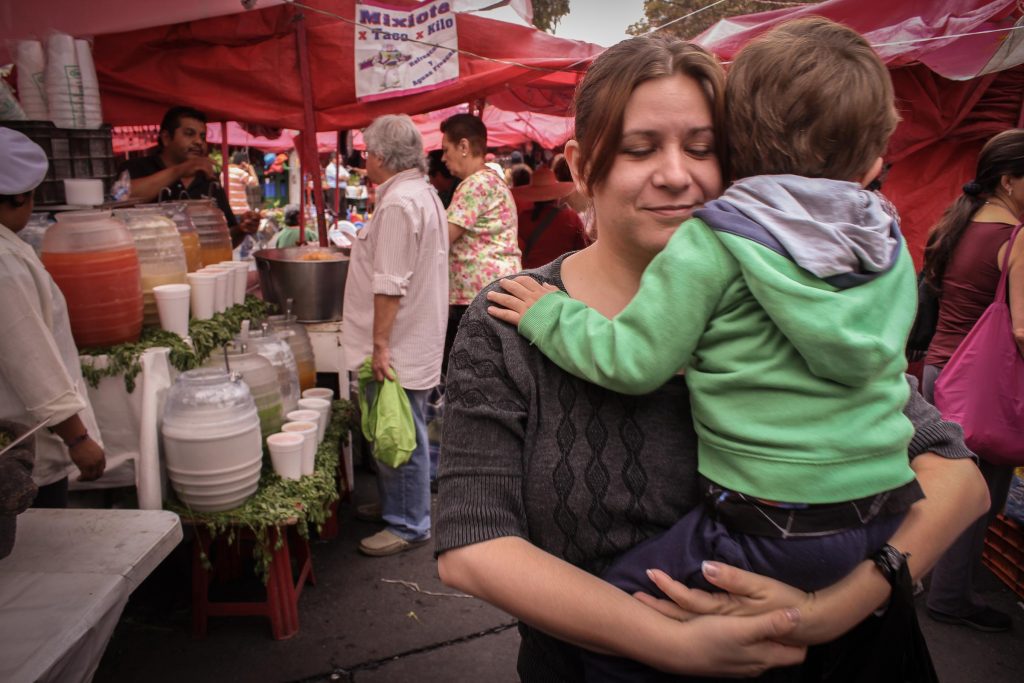
Picture 25
Taking care of the dealer's space
CDMX, 2012.
The tianguis plays an important economic and social role in the leisure time of this marchanta and her son. The tianguis, in addition to saving her a long trip to a park or other recreational place, is inexpensive. CMDX residents grow with the tianguis, whether out of necessity or entertainment, and the tianguis grows along with them. Recurring clientele is a tianguista's main income. Therefore, taking care of the stalls and avoiding complaints from neighbors helps to maintain the tianguis economically and socially. But, beyond work, tianguistas have maintained relationships with up to four generations of marchantes, many are close and trusting, and there have even been several cases of marriages between tianguistas and marchantes.
Picture 26
The little test
CDMX, 2013.
The housewife is suspicious and the salesman redoubles his courtesies. - Carlos Monsiváis (2000, p. 223).
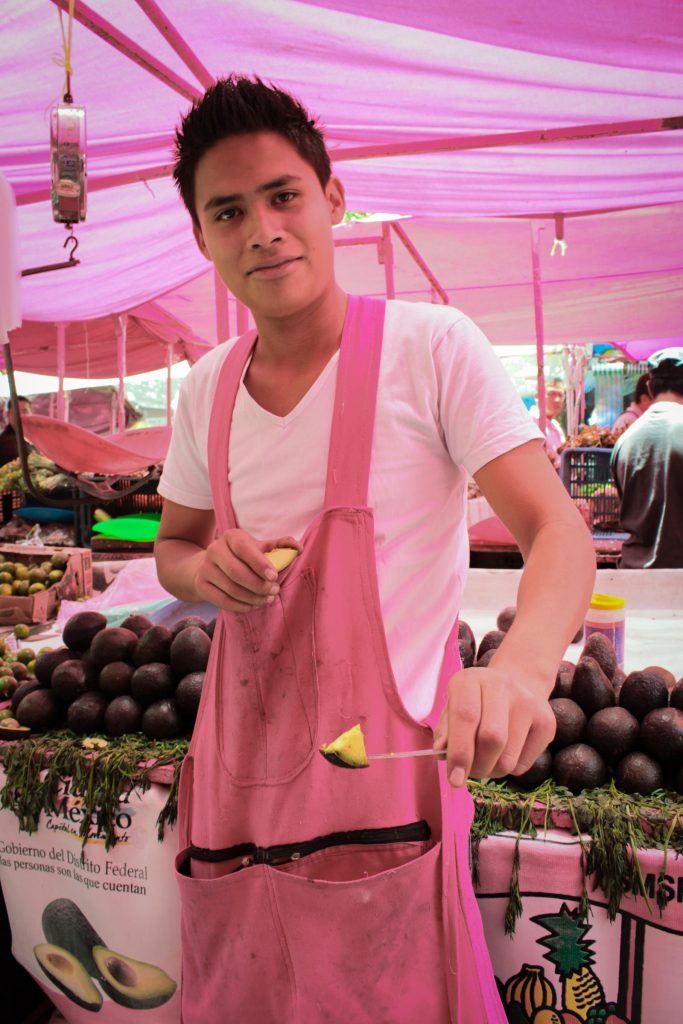
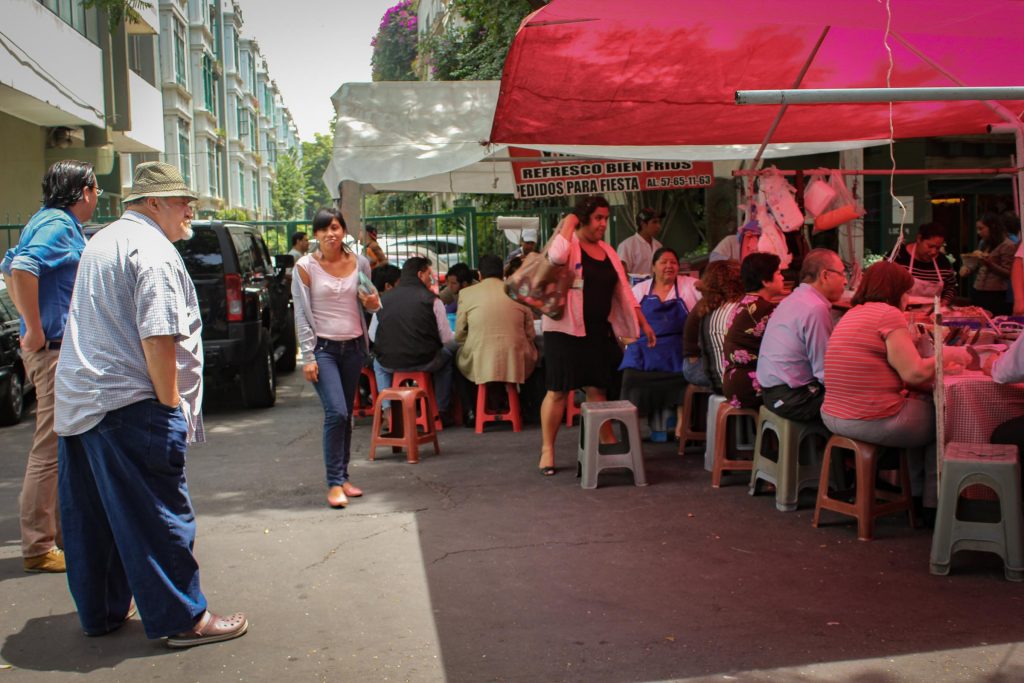
Picture 27
The neighbors
CDMX, 2013.
In neighborhoods such as La Condesa, the political participation of neighbors through neighborhood committees has forced tianguistas to pay special attention to the aesthetics of their stalls. Complaints in high-class neighborhoods reach the tianguis representative very quickly, and if they are not addressed, the neighborhood committees often take legal action. Roberto thinks that in these areas people get more involved because they have the time to do so, while complaints are infrequent in lower class areas because:
People are too busy working and don't have time to participate. - Roberto, tianguista.
Picture 28
Cars vs. stalls
CDMX, 2013.
"Oh no, why didn't you tell me, I didn't know today was tianguis day!" said a young woman to the security guard of the building she was exiting. Next to the young woman's trapped car, vendors who were supposed to be assembling their stall were standing on the pavement next to unpacked packages of the merchandise they were supposed to be selling. One of them commented to the others, "We're losing a good day's work."
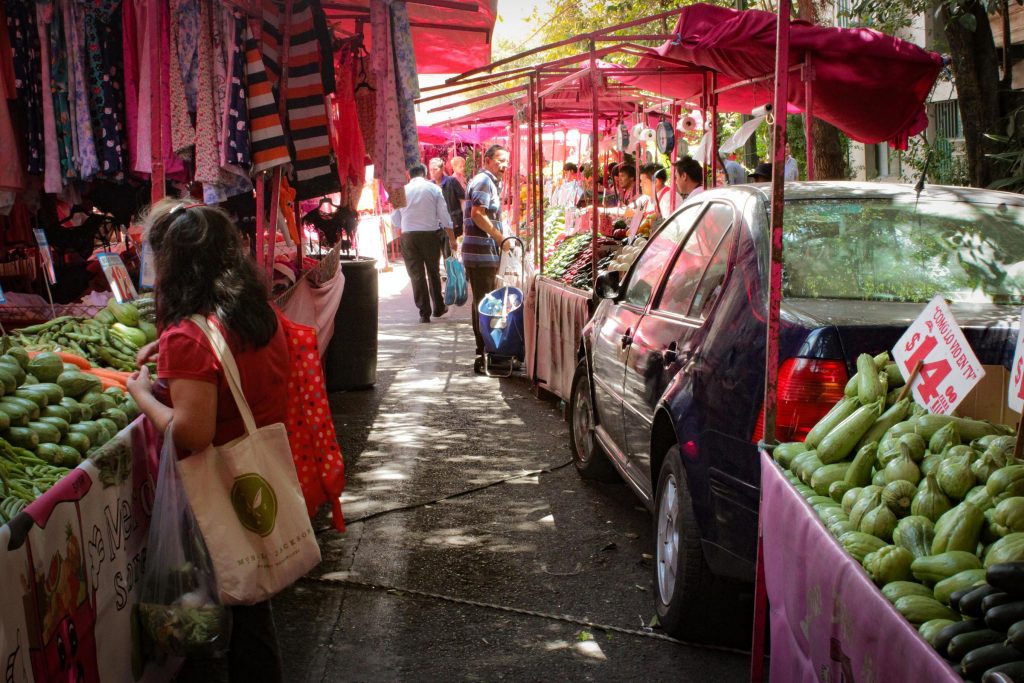
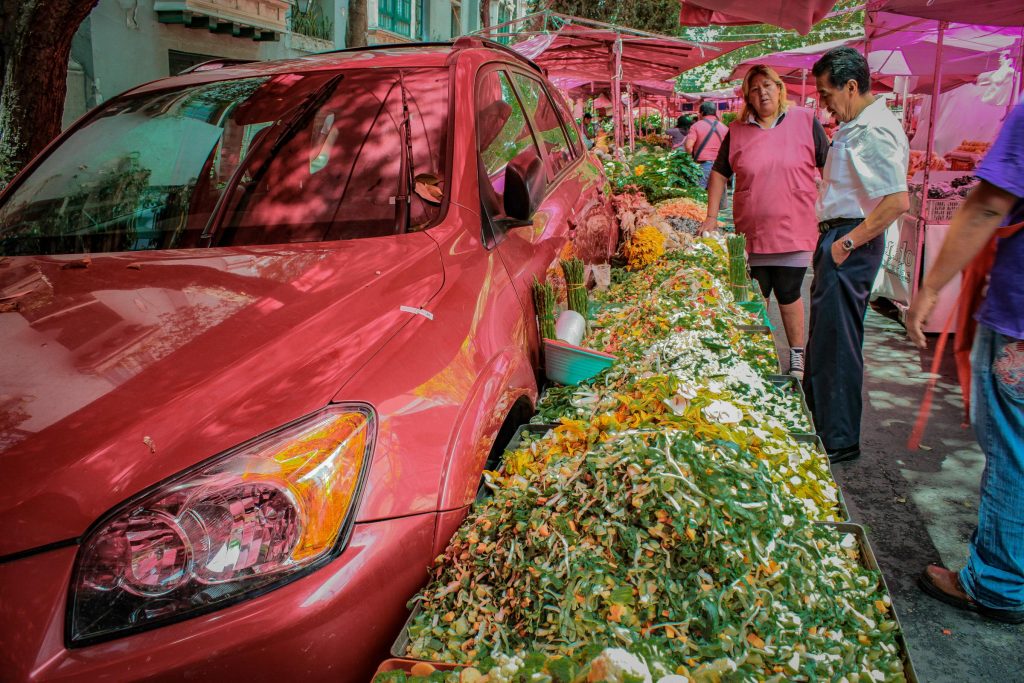
Image 29
Improvisation
CDMX, 2013.
The most flexible thing in the universe is space, there is always room for another person and another and another, and in the Metro, human density is not synonymous with the struggle for life, but rather, the opposite. Success is not about surviving, but about finding space in space. How can two objects not occupy the same place at the same time?
Carlos Monsiváis (2000, pp. 111-112).
Image 30
Residential rights or right to work?
CDMX, 2013.
The temporary solution is to install the post around the car. This type of situation causes tension and conflicts with neighbors and sparks discussion about who has more or less right to the street. The tianguistas prioritize the neighbors' right to the street in virtue of their right to work on the established day.
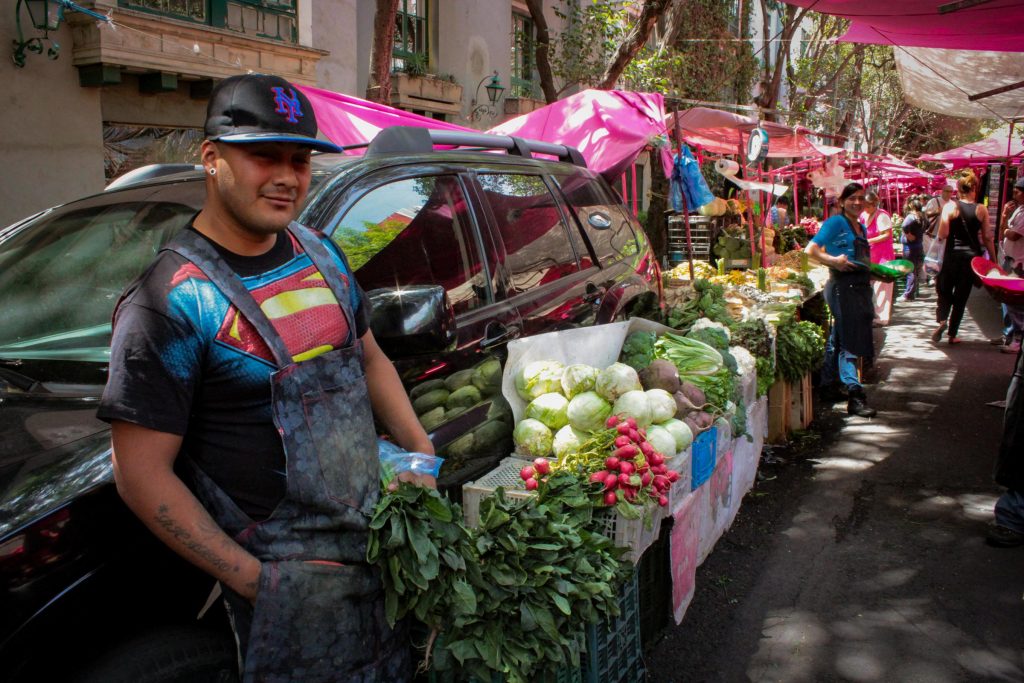
Image 31
The apron, pride at work
CDMX, 2013.
"You can catch me tired but never without the desire to sell," reads the apron of this helper. It is common to find these types of messages that reinforce the tianguistas' pride in their work.
Articles published in the media and in some government speeches, use words such as "combat" or "attack" together with the words "tianguis" or "informal commerce", "disorder", "garbage" and "dirt". Faced with such public opinions, Victor, tianguista leader, responds:
There are all kinds of people, those who like and those who do not like to go to the tianguis, but if they lack something, they go to the tianguis. Many people used to say: "filthy tianguistas", but it is a filth of work, it is a filth of effort, it is a filth of necessity, it is not a filth of laziness or of sitting down and getting dusty. It is something that, finally, must be respected because the work of a garbage collector is as worthy as that of a tianguista, as of an engineer.
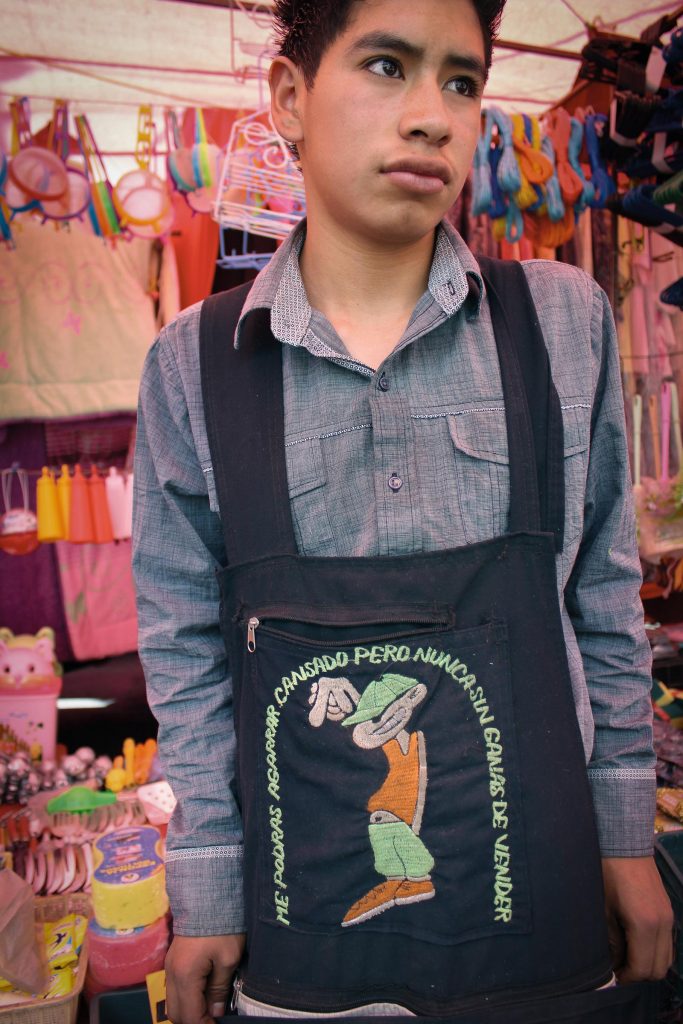

Image 32
Improvisation
CDMX, 2012.
At the end of the day, diableros, fleteros and vendors meet again to exchange notes and anecdotes of the day while the leaders see to it that no one is left behind and that the garbage is collected. Leaving the street dirty would mean one more complaint to the detriment of the Ruta 8 installation. Sometimes this task can last until ten o'clock at night, as the garbage collectors are often late. In some neighborhoods, Ruta 8, through quotas, hires private garbage collection services because, according to the tianguistas, the public service often does not show up.
Sweet saints: devotions to Cosmas and Damian in Rio de Janeiro, Brazil
Renata Menezes
is a professor in the Anthropology Department of the National Museum, Federal University of Rio de Janeiro (ufrj). D. (2004) and M.A. (1996) in Social Anthropology from the Graduate Program in Social Anthropology of the National Museum, ufrj (ppgas/mn/ufrj). Coordinator of the Laboratory of Anthropology of the Playful and the Sacred of the National Museum (Ludens). Researcher at the Conselho Nacional de Desenvolvimento Científico e Tecnológico - Conselho Nacional de Desenvolvimento Científico e Tecnológico.cnpq and Faperj's "Cientista do Nosso Estado". renata.menezes@mn.ufrj.br
Morena Freitas
is an anthropologist at the Superintendence of the Institute of National Historical and Artistic Heritage (Instituto del Patrimonio Histórico y Artístico Nacional (iphan) in Sergipe, Brazil. Researcher at the Laboratory of Anthropology of the Playful and the Sacred (Ludens/...).mn/ufrj). D. in Social Anthropology from the Federal University of Rio de Janeiro. morebmfreitas@gmail.com
Lucas Bártolo
D. student at the Graduate Program in Social Anthropology of the National Museum of the Federal University of Rio de Janeiro (ppgas/mn/ufrj), Brazil. Researcher at the Laboratory of Anthropology of the Playful and the Sacred (Ludens/...), Brazil.mn/ufrj). Master in Social Anthropology from the Federal University of Rio de Janeiro. bartolo.lucas@mn.ufrj.br

Virtual exhibition poster Sweet Saints: Devotions to Cosmas and Damian in Rio de Janeiro
Leear Martiniano, 2020
During the months of September and October, Cosme, Damien, Doum and the ibejadas circulate and are exhibited in religious stores.
Thiago Oliveira, 2015.
Since the beginning of September, the shop windows announce the arrival of the season of saints' sweets. Until October 25, the day of Crispim and Crispiniano, passing through October 12, Children's Day, a festive-religious calendar is established in the city of Rio de Janeiro around the celebration of childhood. In the religious articles stores, the images of Ibejadas, Cosme, Damião and Doum are the most sought after in this period, when the terreiros and churches are used to celebrate children.
Season of sweets in the markets
Thiago Oliveira, 2015.
The typical sweets of Cosme y Damián
Thiago Oliveira, 2015.
White candies, typical candies, sweet pots, traditional candies, industrialized candies, homemade candies... Welcome to the incredible world of candies! Coconut candy, sigh, paçocajujube, lollipop, milk candy, peanuts (pé de moleque) and pumpkin. Many of these sweets only appear on the shelves once a year, in September: they are the typical sweets of Cosme y Damián.
There are those who like to give more than just candy, mainly toys.
Thiago Oliveira, 2015.
In celebrations organized by a larger group of devotees - in the street or in neighborhood clubs - or by the community of a terreiroThe toys can be more special, such as bicycles and remote-controlled cars, and recreational activities and games are scheduled throughout the day. Distributions take on a charitable dimension when school supplies, food and clothing are also donated.

The assembly requires the development of a technique, without renouncing affection.
Thiago Oliveira, 2015.
The assembly technique is a family apprenticeship, in most cases through the maternal line.
Thiago Oliveira, 2015, Vaz Lobo.
At home, families usually organize themselves in an assembly line: candies are taken out of the packages and placed on the table, and each person is in charge of putting one or more types in a bag, which is passed from hand to hand until it reaches the person in charge of closing it with a stapler or a ribbon. Ideally, each bag should have the same amount and type of candy as the others, so that no child is harmed. And the saints are watching! But the bags can't be assembled too far in advance because the candy can melt. Once the bags are filled and closed, it's time to separate the ones that will go to the neighbor, the nephew, the work friend's daughter. There are people who have been giving for decades, there are those who are starting now, to greet the arrival of a baby, and there are those who continue practices inherited from their ancestors.

Far beyond the candy, Cosme y Damián's bags also contain promises, family traditions and childhood memories.
Thiago Oliveira, 2015.
The sachet with the effigy of the twin saints is considered the most traditional, whether it is made of paper or plastic.
Lucas Bártolo, 2016.

For many, the saints also participate in the celebration, eating the sweets. Cocadas, suspiros, pumpkin candies, etc. are also offered. Many Cosme y Damián altars contain candies and soft drinks as offerings.
As they are associated with the orixás twins, Cosmas and Damian also eat the food of the gods. In addition to sweets, the saints eat caruru, omolocum, acarajé and chicken. At home or in the terreiros.

Offerings to Cosmas, Damian and Doum in a religious articles store.
Thiago Oliveira, 2015.
Offerings to the saints in the Roman Catholic Church
Renata Menezes, 2012.
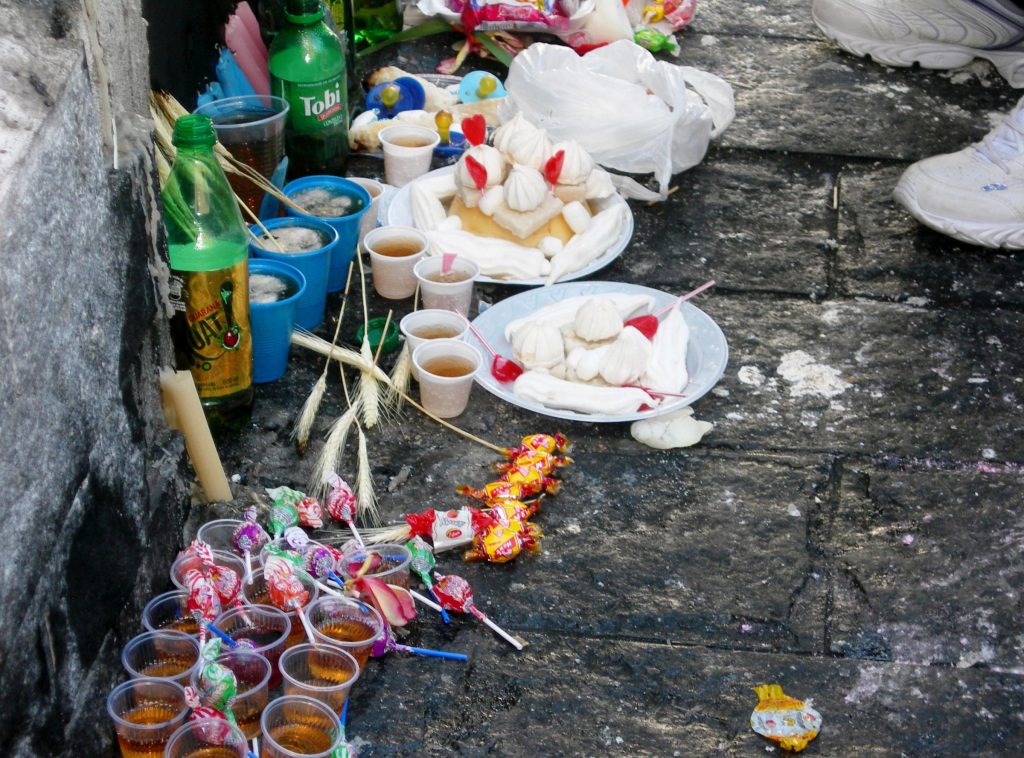
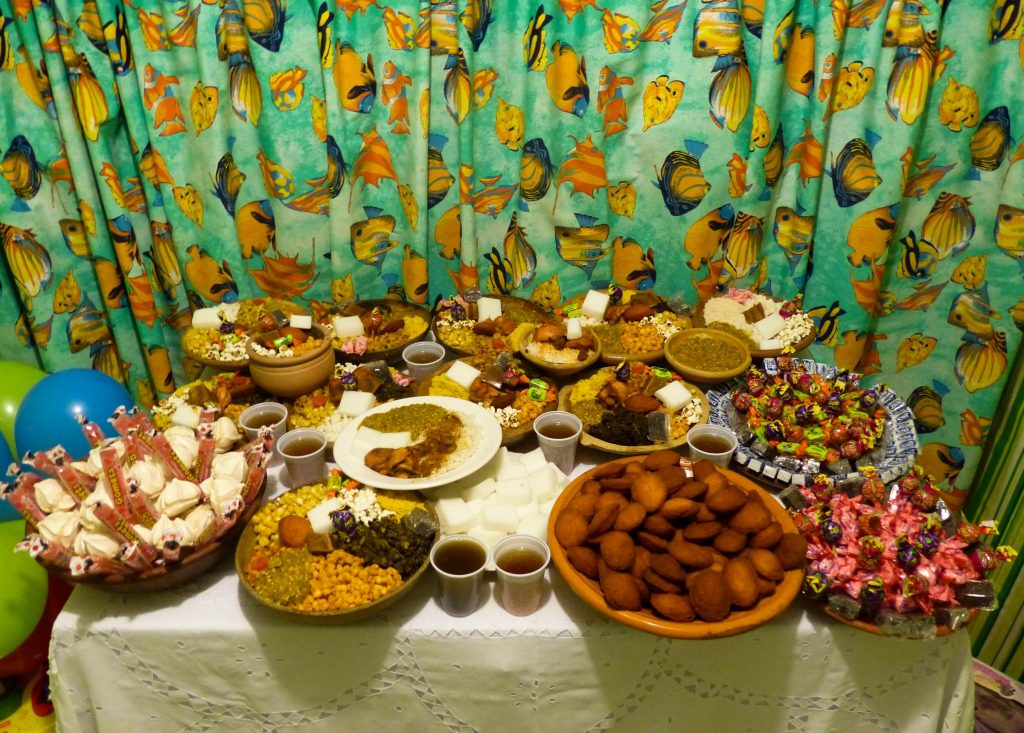
Offerings to the saints e orixás in a terreiro
Lucas Bártolo, 2016, Cavalcanti.
The big day is approaching. Tickets and invitations are distributed to avoid crowds and alternate distribution in the neighborhood. Information about the houses that distribute the bags of candy circulates among the children, who begin to draw an affective (and sweet) map of the city.
In groups, led by the eldest or even by an adult, the children leave home early and spend the day roaming the streets, running after candy. The party draws an affective map of the city, delimited by strong or weak candy places, near or far from home, where there are good or bad bags. The bags are distributed at doorways, in squares, in churches and shrines, in schools, daycare centers and orphanages, on foot or by car. Families gather to drink and give sweets. Some like to celebrate the day as if it were the birthday of the twin saints, opening the house and arranging a table with cake, guarana, blancmange and sweets. In small bags or on the tables, the sweets are, on the 27th, food for the saints and the children. The day of Cosme and Damian is a playful experience of the city.
Running after candy: a playful experience of the city
Correio da Manhã/Arquivo Nacional, September 1971.
Thiago Oliveira, 2015.
Early in the morning, the sound of the first sneakers crunching as they race through the streets heralds the start of another day on September 27. It is an extraordinary occasion when the children take on an autonomy that they will probably only really have when they are no longer children. In groups, led by the eldest or even by an adult, the children leave home early in the morning and spend the day running through the streets, or rather, running after candy.
In several neighborhoods of the city, we find patterns of grouping that can be compared to old photos, like the one we see below. There is a pattern that seems to repeat itself, in a movement of children through the streets of the city that sets adults and children in motion.
The party as a moment of anonymous and generous (and sweet) exchange with the unknown.
Isabela Pillar, 2013.
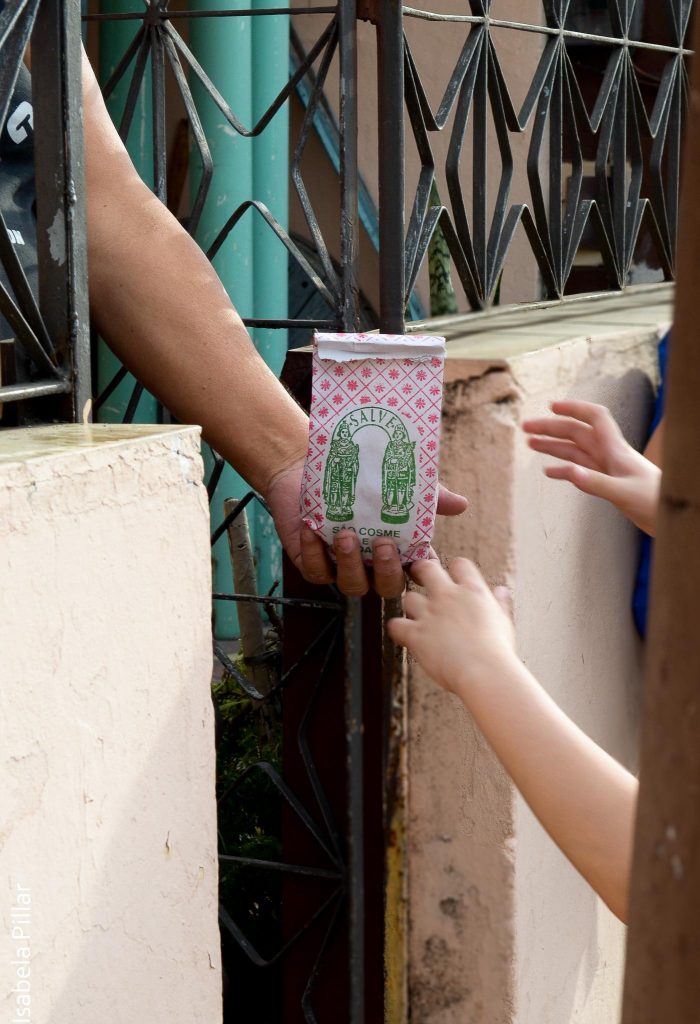
"I will give the candies at the door to the street children." This is how many devotees answer us when we ask them how they are going to make their feast. Cosme and Damien Day puts the focus on the relationship between the home and the street and puts its boundaries in suspense. It is a moment of anonymous and generous exchange with the unknown.
Among the various ways of giving sweets, the most widespread is the distribution through the door of houses and buildings. The devotees try to organize a queue, giving preference to lap children and pregnant women, but, in general, there is a small commotion in front of the houses. Another very popular modality is that of "throwing the candies forward", throwing them over the wall to the small crowd. Some donors stand out precisely for this practice, throwing not only candy, but also toys and money.
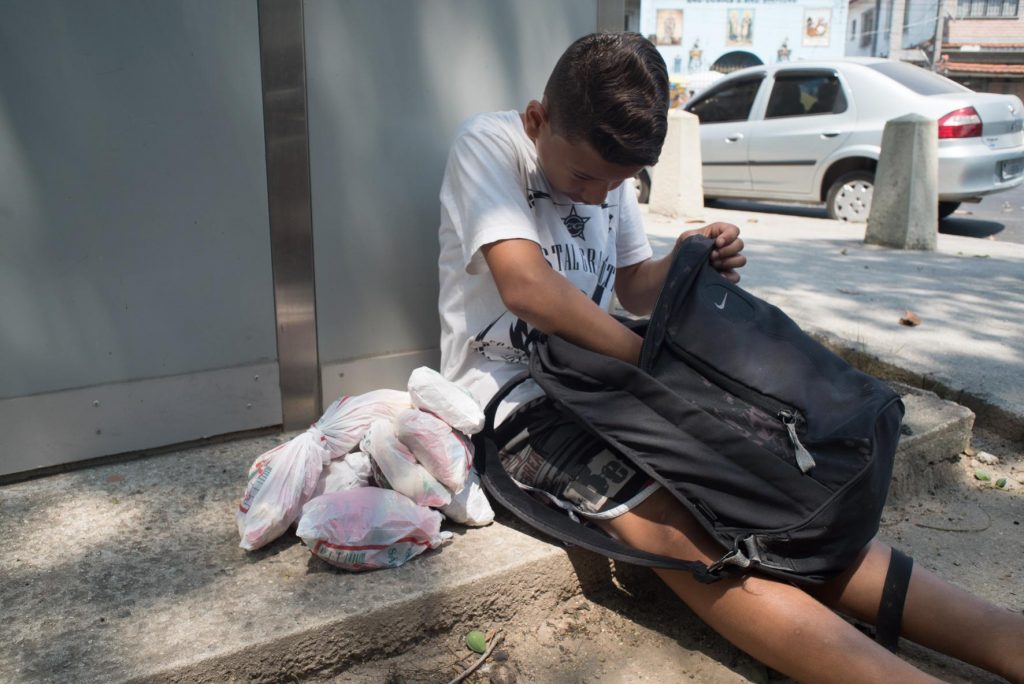
Recap of the day's achievements
Thiago Oliveira, 2015.
Lying about their age, not being recognized when they try to get two bags in the same house, knowing where the best bags are, asking for candy in the name of a supposed younger sibling... these are tricks that children use to get the most candy. It's part of the game to get the adults to bend, who warn: It's a bag for everyone! I only give candy to little kids! Anyone who goes out with anyone is no longer a child.
The festival is a playful and religious tradition that consists of a great game
Lucas Bártolo, 2014.
The smiles of the children are, for some, the great reward of the party..
Thiago Oliveira, 2015.
Isabela Pillar, 2013.
The smile of the children is, for some, the great reward of the party - if we wanted to talk about the possible interests of giving candy, it would certainly appear as the main desired retribution for the act of giving. But children are not just guests at the party: multiple, diverse, also make it. If with adults children learn to be grateful for the bags earned and also to distribute them, it is in the company of friends that they develop the tricks to take candies, especially to take them more than once in the same house.
Some people like to celebrate the day as if it were the birthday of the saints, opening the house and organizing a table with cake, guarana, manjar, sweets and many colorful balls. The delicacies can only be offered to the guests after singing happy birthday to Cosme and Damien and serving the seven children gathered around the cake. At these tables, the presence of twins is considered a blessing. From the sequence of photos, it can be seen that many families have been doing this practice for decades.
A domestic celebration to Cosme and Damian
Personal collection of Glória Amaral, 1990 (estimated date).
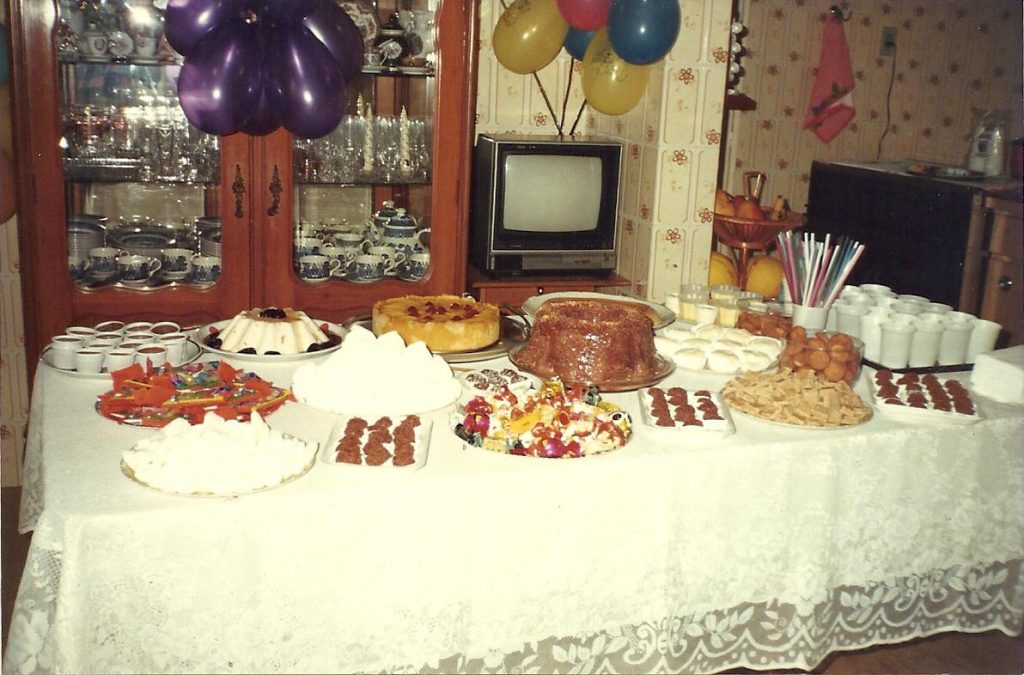
The birthday of the saints
Lucas Bártolo, 2014.
Thiago Oliveira, 2015.
Novenas, masses, baptisms and processions mark the program of the churches of the different branches of Catholicism (Roman, Orthodox, Coptic) that receive thousands of devotees on September 27, who also distribute candies, toys and food to children and needy people. Many religious traditions have the practice of charity and help as fundamental values and on the day of Cosmas and Damian, the donations made in these spaces are a way of putting these values into practice.
Donation of toys and food at St. George, St. Cosmas and St. Damian's Orthodox Catholic Church
Thiago Oliveira, 2015.
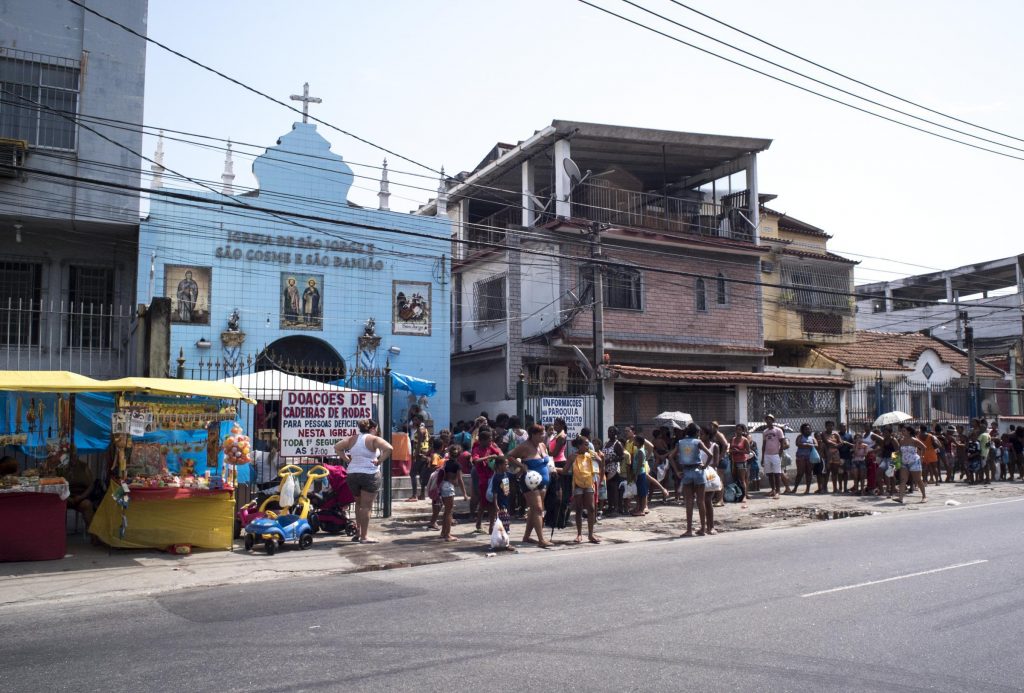
Multiform characters, Cosimo and Damian can be presented as Catholic martyrs, physicians, twins, orixás African, child protectors or child entities, among other conceptions about them that also appear combined. They are present in many pantheons, assuming specificities in each of these contexts.
In Brazil, the devotion to the saints was associated with African traditions of twin worship, highlighting the hybridization with the Ibejis, orixás children protectors of twins in the Yoruba tradition. It is from the approach of Cosimo and Damian to Ibeji that their functions were redefined: from protectors of doctors and pharmacists to protectors of children, of double births and of the health of twins. In the Brazilian religious universe, saints were linked to childhood, hence the distribution of sweets to children as a way of celebrating them.
In Catholic churches, the saints may be young or adult, identical or different twins.
Thiago Oliveira, 2015.
Ana Ranna, 2013.
The saints are now three. Idowú, younger brother of the Yoruba twins Ibeji, here in Brazil is Doum, brother of Cosme and Damián.
Thiago Oliveira, 2015
Ibejis, the orixás ninõs of the Yoruba tradition, protectors of ninõs and twins.
Lucas Bártolo, 2015.
The saints are now three. Idowú, younger brother of the Yoruba twins Ibeji, here in Brazil is Doum, brother of Cosme and Damián.
Thiago Oliveira, 2015
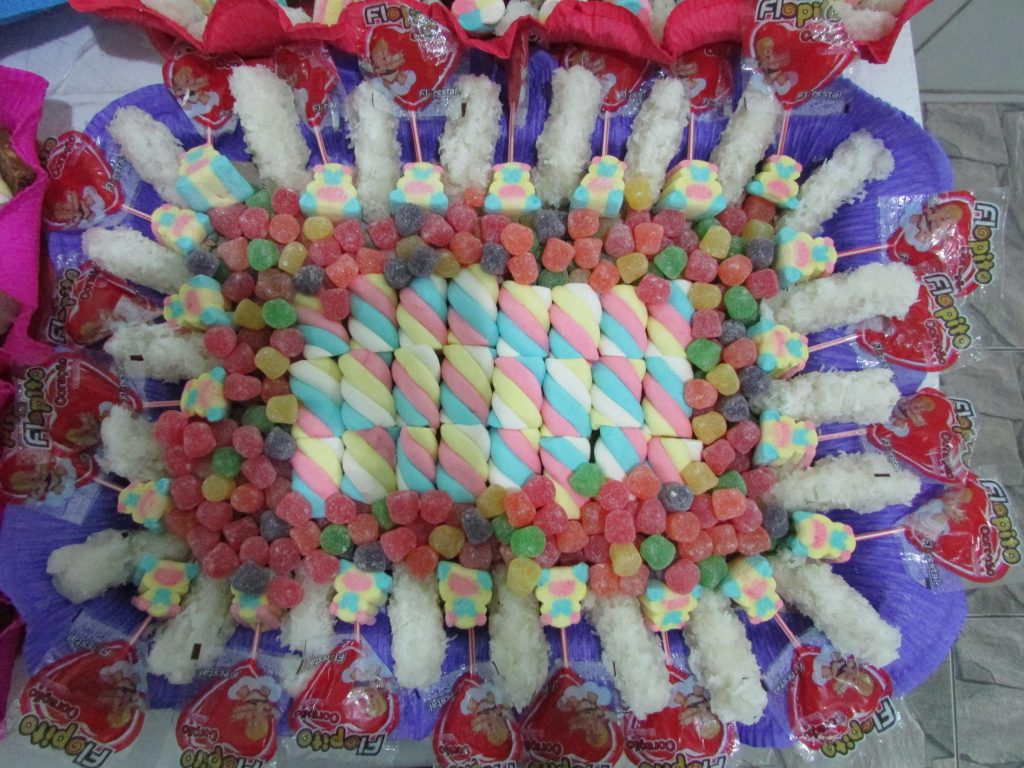
The sacred sweetness of the Children
Morena Freitas, 2016.
The sacred sweetness of the saints, of the ibejadas and of the children is venerated with sighs, cocadas, candies, cakes and guaraná. This sweetness smells, sounds, colors, melts our hands, invades our noses and mouths; and to feel this sweetness is to feel the Children.
Devotion to the saints implies an intense communication that goes through looks, gestures, words and things and involves affection, emotions and desires. Devotion unfolds, therefore, far beyond the bags of candy..
Lucas Bártolo, 2019.
Thiago Oliveira, 2015
The multiple forms that this devotion assumes express the Brazilian cultural diversity. Cosme and Damian in the literature of cordel and carnival.
Thiago Oliveira, 2015.
Lucas Bártolo, 2015.
Hybrid identities: alternative and irruptive identity aesthetics.
Technologies, transnational migration, mass tourism, trade and mediatized communication have generated intense social flows that we call global. From them derives the circulation of cultural goods that, in addition to deterritorializing and reterritorializing traditions, generate exchanges that engender novel hybridizations. Some of them are the result of mixtures of elements from societies that were previously distant and alien. There are different hybrid cultural products represented in "in-between-medium", ambivalent identity aesthetics. Homi Bhabha recognizes as hybrid that (object or subject) which arises from the exchange between two traditions and which generates something different (which is no longer one or the other). Hybrid products are, then, those that arise from the fusion of two or more aesthetic traditions and that make explicit the presence of both referents as allusive components.
Through socio-digital networks, Encartes invited academics, students, visual artists, filmmakers, collectives and photographers to participate in a photographic contest with images that capture objects, subjects, places, landscapes, rituals recreated by the aesthetics of hybridization. We were interested in receiving images showing features that generate hard, unusual, antagonistic, paradoxical or ambivalent mixtures. Hybrid products show the creativity to create alternative identities such as, for example, body marks of youth cultures, recreations of products generated by diasporic strategies of relocalization, emblems of ambivalent national, religious or ethnic identities; cult objects that transgress religious or spiritual traditions; fusion in food, costumes, regional dance choreographies, architecture, crafts, redesign of transgender bodies, and so on.
We received dozens of photographs and an evaluation committee selected the ones that complied and adhered, both in quality and affinity, with the theme of the call on hybrid identities.
By reading the winning photographs as if they were parts of a text, we can recognize that hybridity is transversal. It is present both in traditional contexts, such as religious festivals, in which the selfie accompanies the representation of a Roman centurion during a Staging of the Stations of the Crossas in ancient archaeological sites that today are the site of ceremonies of invented ancestralities (as is the case of Stonehenge), or in different places and urban territories. Hybridity articulates spaces, memories, traditions, representations and actors.
The dances of conquest are currently stagings of memory in which the history of evangelization is kept alive, but they also function as anchors of new representations. This conjugation generates realities, fictionalities and fictions turned reality. A chinelo embodies the traditional Old Man of the dance acting as a being of terror in the Halloween style, without having to give up being guadalupano. The masks are a characteristic element of the baroque tradition, but in the present they not only simulate cultural resistance under the appearance of the assimilation of European faces, but they also place, in the same mask, the symbolization of opposing faces that fight in the Guerrero dance: the chinelo (representation of the white and bearded European conquistador) with the tecuani (the daredevil jaguar). In contrast, tattooing has conquered a new support for the baroque iconic act: the body. In the photograph entitled "When you're not around, I paint!" the body of a woman, presumably Mexican, can be seen, with an enchanted garden tattooed on her body and, between the space of her blouse and skirt, the face of a Thai-style deity can be seen.
Hybridity is first and foremost a glocal phenomenon, energized by global technologies, markets and migratory dynamics, but embodied in bodies rooted in local traditions. Technology through cell phone cameras appears to co-create the images of cultural hybridity by assembling different temporalities that take place in the same performance. The cameras also deterritorialize and resituate practices. In the image taken during the feast of Epiphany in the city of La Paz, Bolivia, shows that the same scene is captured and projected simultaneously by different cameras, whose projection in socio-digital networks deterritorializes the ritual act. Cell phones are also gadgets of catrinas and the deceased that superimpose planes of existence that parody between fantasy and the cultural heritage the Day of the Dead.
Another hybridizing vector present in the photographs is that of migration. In an image recreates St. Nicholas of Bari practicing the yoga posture bhujangasana, printed on the wall of a street in Bari. This photo captures the syncretism between the devotional aesthetics of the Catholic saints and the asanas of Buddhist yoga practice. Immigration is also a generator of surprising hybridizations such as the following the Ganesha-Guadalupewhich inscribes the mother of Mexicans as a deity in a Hindu temple in the border city of Tijuana.
Diaspora is also taken into account in the cultural goods that circulate in the electronic mass media. These are the new producers of imaginaries that are embodied or placed in other landscapes, generating exchanges between fiction and reality. Here we show a traditional cylinder maker in the streets of Mexico City masquerading as an abominable Grinch who hates Christmas, but at the same time disguises himself as Santa Claus, the patron saint of commodified Christmas. On a wall in BoliviaThe graffiti places the fantastic Spiderman -a famous American comic book hero- cleaning the shoes of Chapulín Colorado -a Mexican humor antihero produced by one of Mexico's most famous television networks, Televisa, through Canal de las Estrellas. The creativity in this graffiti generates an image that can be read under the keys of the Latin American imaginary and the discourse of decolonization. For this reason, this photo was chosen for the cover of the magazine. The cultural industries also promote shows and massive sporting events. The soccer World Cup is experienced as national recognition and encourages people to take the public square and to wearing the colors of the uniform with a sculpture of the DavidThe building is a prototype of classical art and Greek beauty, in a place as remote as the city of Montevideo.
Hybridization also generates moral transgressions that operate in the blurring between the private and the public, the religious and the profane. This hybrid landscape is achieved through the photographic exercise of placing sexual diversity in the light of day, of setting up an altar in a popular lingerie store in a traditional city such as San Luis Potosi, where the visual creator of the image saysIt's not fiction, it's not reality. It is a combination: we create realities, accepting what surrounds us".
In sum, the photographs show us that hybridity goes hand in hand with decontextualization and its new creative assemblages capable of transforming meanings. The best example of this can be appreciated in the photo of the burqas put into operation by a collective of feminist women to cover their faces in a March 8th demonstration; in this new political assembly, the burkas, far from signifying female submission, manifest a dissident political expression.
Renée de la Torre Castellanos and Arturo Gutiérrez del Ángel
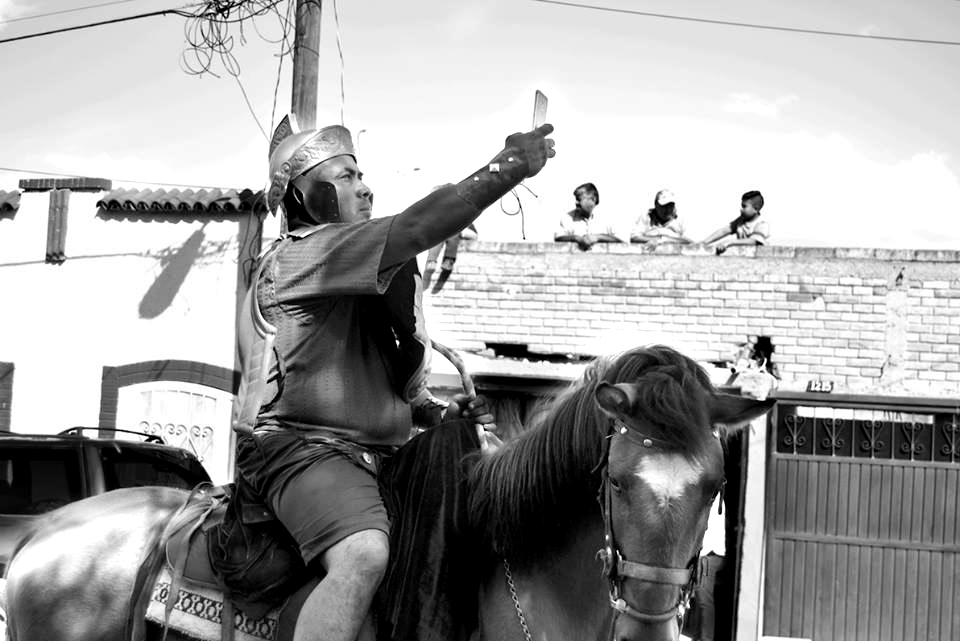
Centurion
Alejandro Pérez Cervantes. Saltillo, Coahuila, March 2018.
Participating character in the annual representation of the traditional Viacrucis in the Ojo de Agua neighborhood, in the southern periphery of the city of Saltillo, Coahuila, where there are evident syncretisms, crossroads and unusual intersections between tradition and modernity.
Shamanic drifts in the druid temple
Yael Dansac, Stonehenge, United Kingdom, June 21, 2017.
The celebration of the summer solstice at Stonehenge is a multitudinous event that brings together unexpected religious mixes and serves as a showcase for hybrid identities.

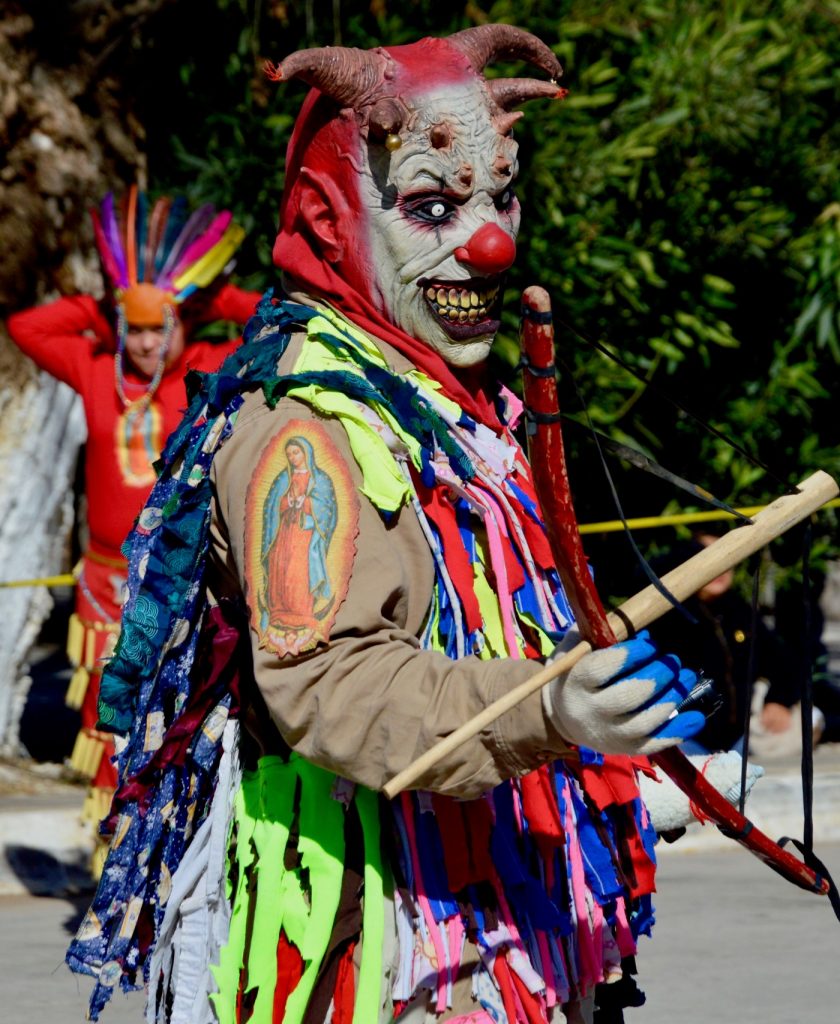
The Old Man of the Matachines Dance
Marco Vinicio Morales Muñoz, Ciudad Aldama, Chihuahua, 2018.
The character of the Old Man in the matachines dance in the feast of the Virgin of Guadalupe in Ciudad Aldama, Chihuahua, symbol and representation of evil in popular catholic religiosity.
Mask fusion of the chinelo-tecuani
Sendic Sagal, Tenextepango, municipality of Ayala, Morelos, July 23, 2022.
Aesthetic-festive synthesis of the identity fusion between the symbols of the Chinelo and the Tecuani; dialogue and revitalization between the two main popular traditions in Zapatista lands.
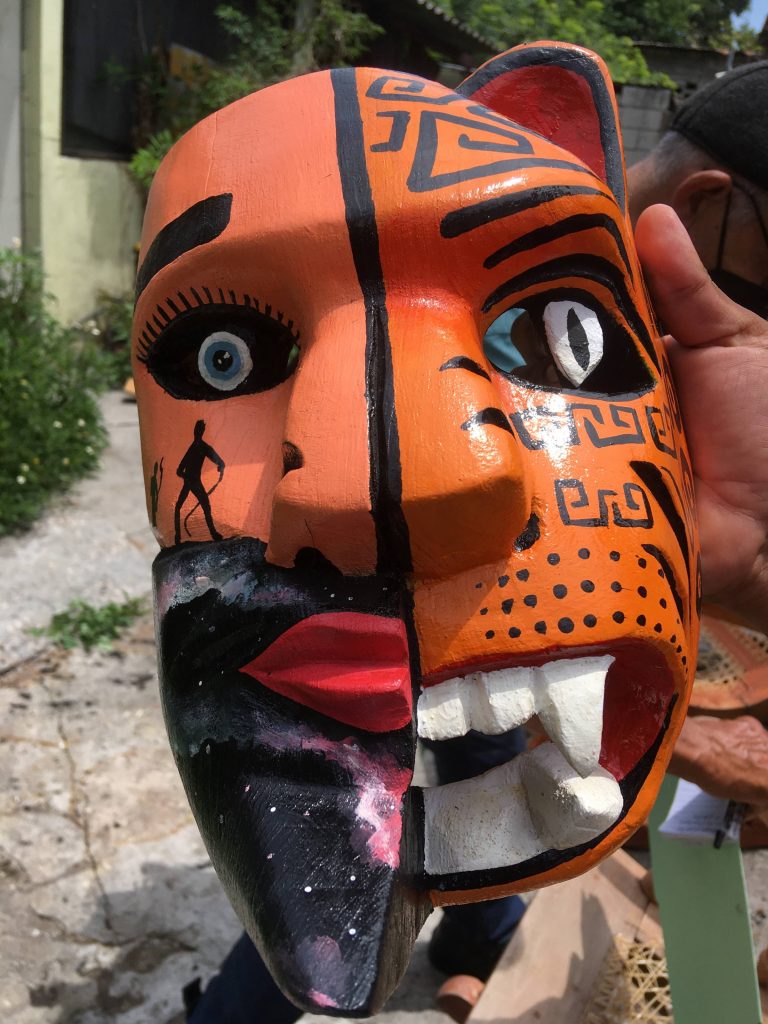
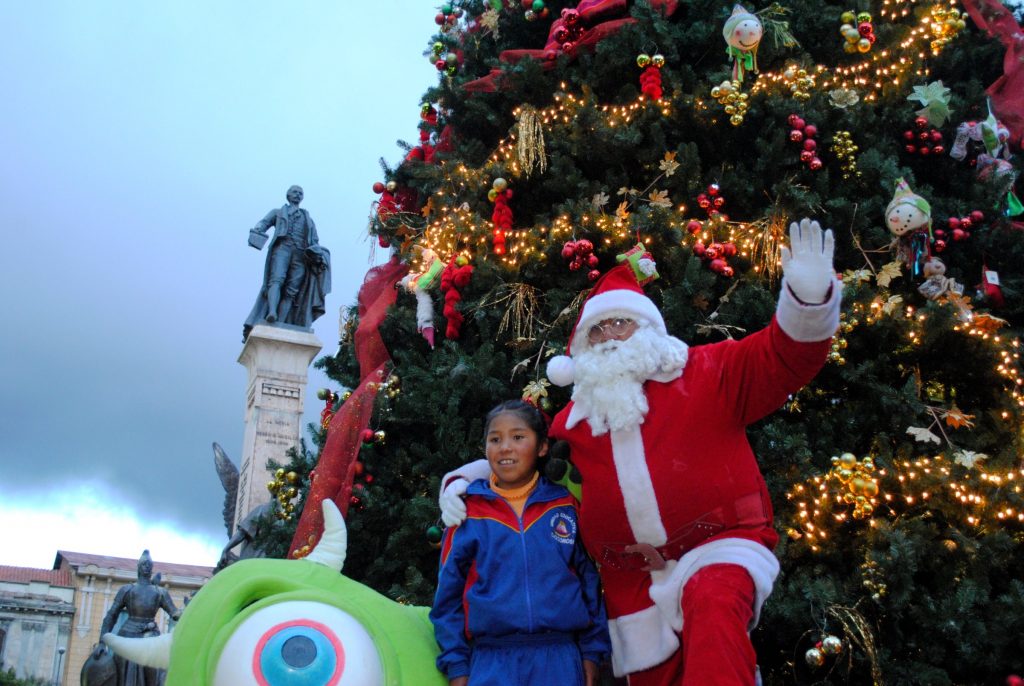
Smile
María Belén Aenlle, Feast of the Epiphany in La Paz - Bolivia.
It was taken at the Epiphany Feast in La Paz - Bolivia. Times, cultures, different traditions and two cameras (the girl's family's and mine) converge in the same space and in a smile.
Mortuary postmodernities
Yllich Escamilla, Coyoacan, Mexico City, 02 Nov 2021
The omnipresence of cellular devices generates a passivity of public space performances, which show an ambivalence between Halloween and Day of the Dead.
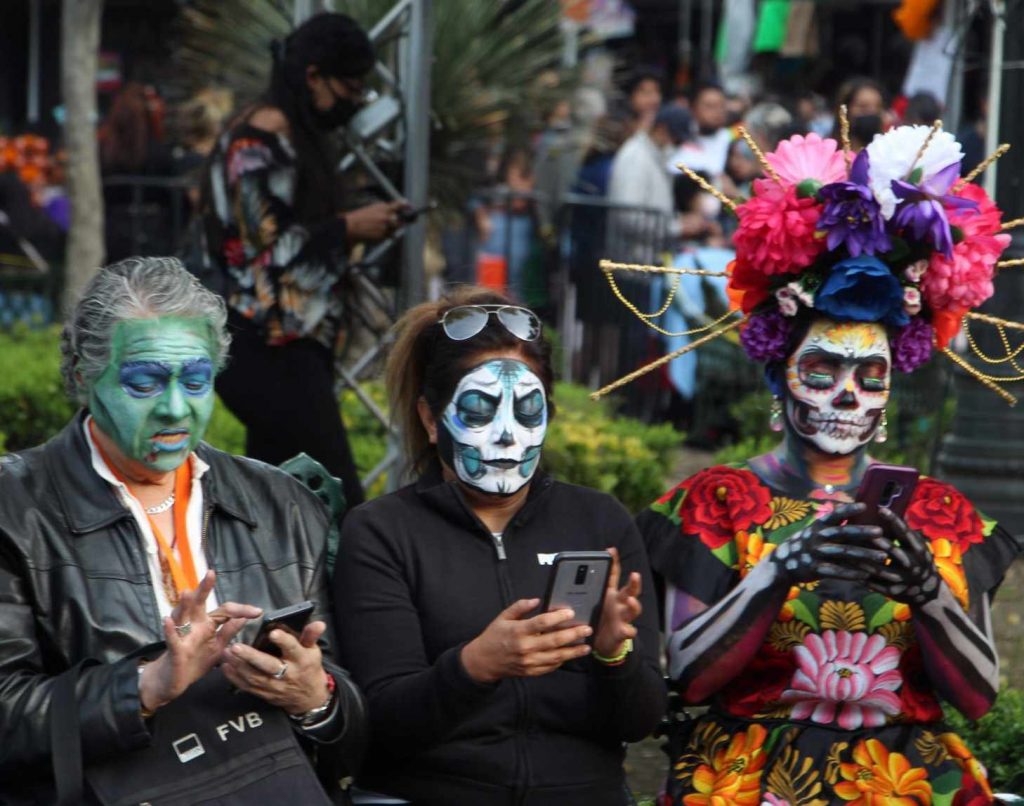

St. Nicholas of Bari practicing yoga posture bhujangasana
Yael Dansac, Bari, Italy, September 4, 2020.
In the streets of Bari, allusions to the patron saint are omnipresent. Migratory flows and Psalm 103:12 inspired this mural where the Bishop of Myra unites East and West.
Gaṇeśa and Guadalupe. A Mexican goddess in the Hindu universe.
Lucero López, Coyoacán, Mexico City, 02 Nov 2021
Ceremony in honor of the god Gaṇeśa in a Hindu temple, performed by migrants of Indian descent residing in Tijuana. The inclusion of the Virgin of Guadalupe symbolizes, among others, their new life in Mexico.
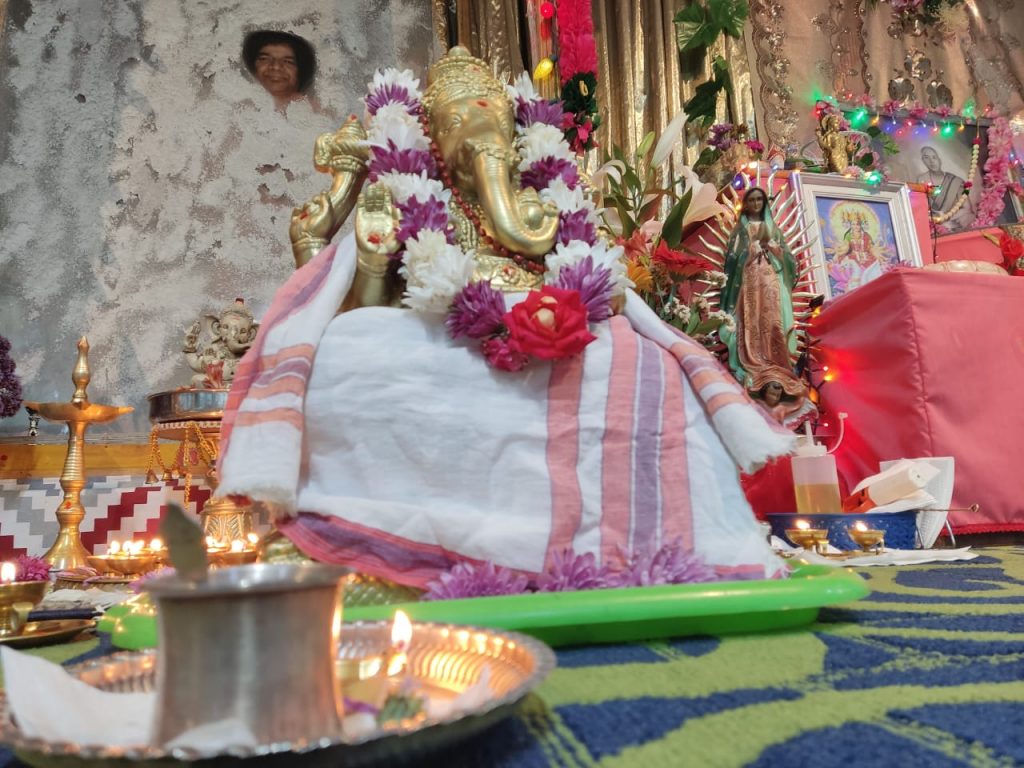

The Grinch of the Historic Center
Yllich Escamilla Santiago, Historic Center, December 24, 2021.
His name is Juan, he is the pillar that supports his family, he is an organ grinder and resists the inclemencies of life and weather, even the pandemic that hit us three years ago, depending on the season, Juan Organillero is characterized to make his job more striking and earn a few coins.
Two superheroes
Hugo José Suárez, La Paz (Bolivia), 2021
On a wall in La Paz, two opposing heroes are depicted: Chapulín Colorado and Spiderman, Mexico and the United States face each other. But the American superhero shines the Mexican's shoes. The image is intervened by third parties: one paints the Chapulín's nose with red, and another one draws an X with aerosol. From the streets, the roles of international cultural products are reinvented...


Michelangelo's David swelling for Uruguayan Celeste
Carlo Américo Caballero Cárdenas, Montevideo, Uruguay, June 25, 2018.
At the Montevideo City Hall, people flock to the public screening of the 2018 Uruguay-Russia World Cup match, gathered around the life-size replica of the David (made in 1931, there since 1958), which is dressed for the occasion with the national shirt and shorts. The Charrúa soccer identity and the Europeanist architectural-statuary typology of the capital are fused: in such a way that an urban landmark of 18 de Julio Avenue, which emulates the canon of Italian Renaissance aesthetics, is popularized and becomes one more fan among the passion, the clamor, flags and the colors of the oriental team.
Transvestism at the tianguis
Martín Ortiz, Tianguis de las vías, San Luis Potosí, March 2023.
In a city as traditional and religious as San Luis Potosi, the simple act of showing in the light of day the games we privately play with gender and pointing a camera at them, tells the story of a rupture in everyday life. Something deserves to be seen, but what is it?
The neoprovince mixes tradition with novelty. Hostile contexts with characters that exalt them. It is not fiction, it is not reality. It is a combination: we create realities, accepting what surrounds us.
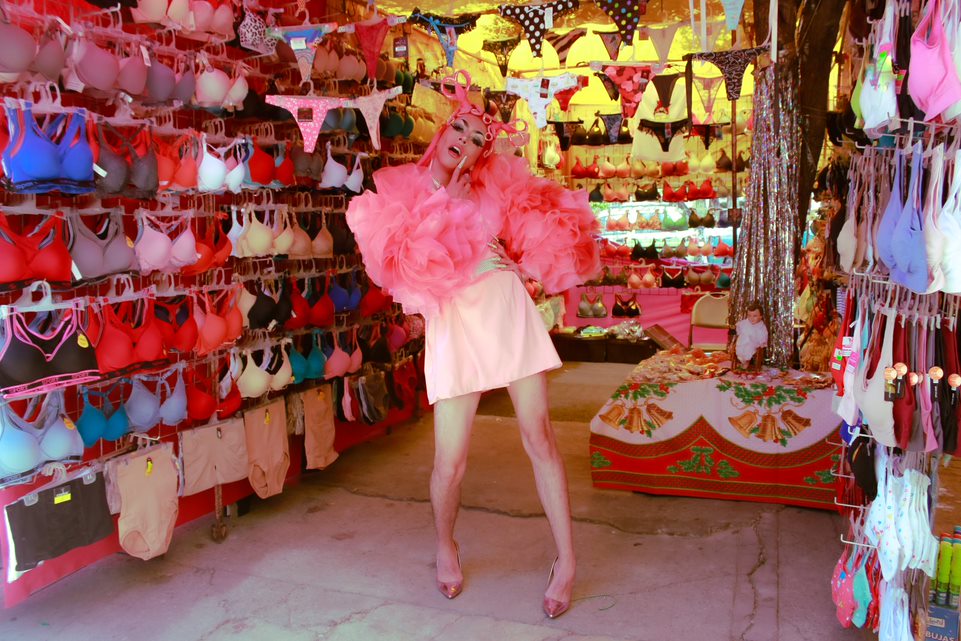

Black Block, Memory and Pandemic
Yllich Escamilla Santiago, Eje Central Tunnel, at the height of Garibaldi, Historic Center, October 2, 2021.
March to commemorate the October 2 massacre. Still in pandemic, the resistors took to the streets, despite the contagion peaks. Supporters of the Black Bloc marched along Eje Central up to Tacuba Street, where they were blocked.
When you are not around, I paint!
Saúl Recinas, Mexico City, July 13, 2023.
The photograph is part of a postdoctoral project on body aesthetics, otherness and stigma configuration, which aims to understand to what extent body aesthetics, mainly related to tattooing, contribute to the crystallization of stigmas and social segregation.
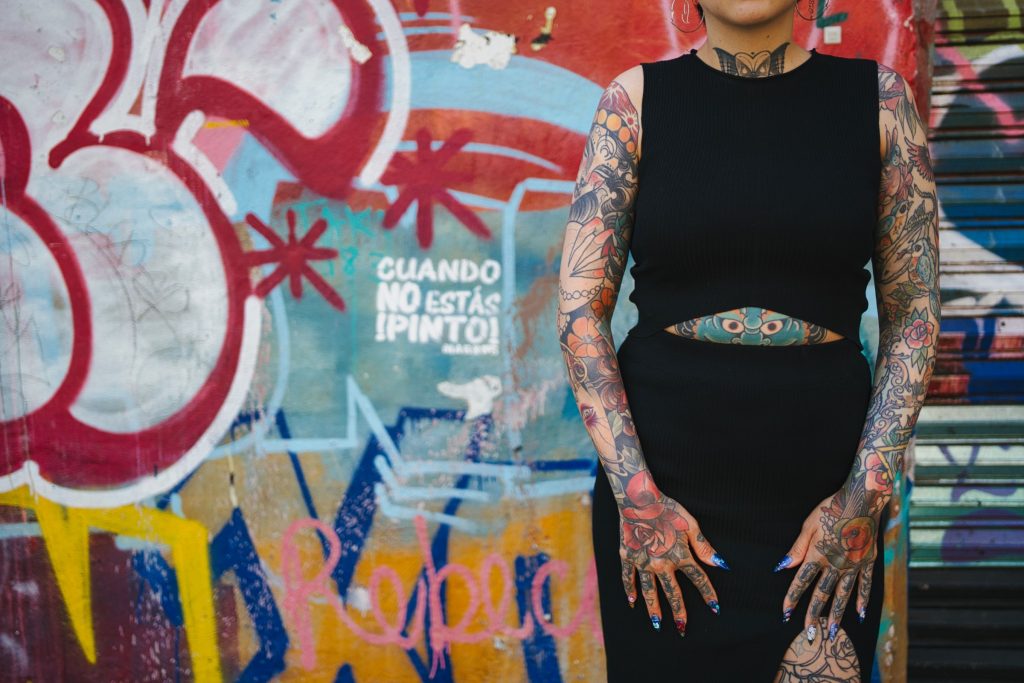

Replica of the image of Santa Muerte in the Noria de San Pantaleón, Sombrerete, Zacatecas
Frida Sánchez, La Noria de San Pantaleón, Sombrerete, October 2017.
This figure is a replica of the image of Death in the town of Noria de San Pantaleón, in the municipality of Sombrerete, Zacatecas. The original image was carved around 1940, however, it was burned because candles were left burning on the altar.
Uses and contradictions of urban infrastructure
All human beings have a spatial dimension. This condition is intimately linked to the collective ways of thinking, feeling and acting in the world; it is for this reason that the public spaces we inhabit and transit as part of everyday life constantly become scenarios in dispute, not only in their territorial but also in their symbolic dimensions. It can be said that the act of intervening in a public space is, in turn, a struggle to win a place in collective thought.
Inaccessibilities
How infrastructure excludes certain bodies and urban practices in everyday uses.

Urban reliefs
Jessica TrejoMexico City, Mexico. July 21, 2022.
Balderas Street in Mexico City, Cuauhtémoc district.
Urban Palimpsest
Oscar Molina PalestineMexico City, Mexico. March 1, 2020
Near Paseo de la Reforma, on Sundays, antique vendors offer their products at the La Lagunilla flea market. Customers and merchants take the lateral and the bicycle lane as parking, hindering the mobility of cyclists.


Reforms
Oscar Molina PalestineMexico City, Mexico. January 24, 2021
The investment in Paseo de la Reforma to provide safe mobility routes for cyclists has been great. However, the sidewalks continue to be dangerous terrain for wheelchair users, who prefer to use the deserted bike lanes.
Crosswalk elementary school
Carlos Jesús Martínez LópezZapopan, Jalisco, Mexico. June 21, 2022.
On Antiguo Camino a Tesistan Avenue, not even the warnings and adjustments to the façade of this elementary school can stop the fast pace of the cars.


Parallels
Miriam Guadalupe Jiménez CabreraGuadalajara, Mexico. November 2015.
Minimal benches
Juan Carlos Rojo CarrascalMazatlan, Mexico. April 23rd, 2021
The sidewalks in Mazatlan are shrinking almost to the point of disappearing, making it difficult for people to walk on them.


Railing or ladder?
Priscilla Alexa Macias MojicaTijuana, Mexico. July 17, 2022.
Residents of a peripheral neighborhood adapted the fence with holes that serve as steps to cross an alley that leads them quickly to the nearby shopping mall.
Road Vulnerabilities
Forms of vulnerability associated with daily traffic, understanding the relationship between bodies, vehicles and roads.
Brazil and the "Future Solutions" projects: Uses and contradictions of the urban structure
Fábio Lopes AlvesCascavel - Paraná, Brazil. July 6, 2020.
The image shows how "future solutions" projects exclude certain people.


Daily vulnerabilities
Fábio Lopes AlvesCascavel - Paraná, Brazil. August 22, 2018.
Image shows a child's willingness to interact with an unknown homeless person
Jumping the puddle
Fernanda Ramirez EspinosaMexico City, Mexico. June 28, 2022.
Photograph taken on the way back from training. We were near the young man's house. It had rained and the roads became steep and difficult to ride on.


Gambling
Leonardo Mora LomelíMexico City, Mexico. September 14, 2021.
In the daily comings and goings, the pedestrian seems to enter into a game between earning a living and keeping it by crossing the roads. At each step, depending on his skill, he gains points or loses life.
The rules of the game
Leonardo Mora LomelíMexico City, Mexico. September 14, 2021.
The most complex part of this game of mobility is to know how to avoid the vicissitudes of the urban board: players who do not follow the rules, cars that invade turns, instructions that become inaccessible to the neophyte. Vulnerability is the constant.


Web of danger
Thania Susana Ochoa ArmentaMexico City, Mexico. March 30, 2022.
In the heart of Mexico City's Historic Center, a spider's web of yellow ribbons warns of the danger of a hole in the ground.
Improvised assistants
Victor Hugo GutierrezMexico City, Mexico. December 2019.
Lupita and her companion's journey through the Pantitlán station of the Metro. There are several stairs and no elevator along the transfer between Line 1 and Line A, which makes the infrastructure inaccessible for people with reduced mobility and people with disabilities. Given the lack of accessibility, the solidarity of users is important for Lupita's displacement.


Accessible in dry
Laura Paniagua ArguedasMexico City, Mexico. May 13, 2021.
Rain is denied in our cities designed and built "dry". Infrastructures stifle the possibilities of movement for people with disabilities.
Heartbeats
Laura Paniagua Arguedas, Cartago, Costa Rica, October 19, 2019.
Cognitive disability presents for the person moments of strong emotions in an enabling world, which generates fears, isolation and discrimination.


Everyday vulnerability
Juan Carlos Rojo CarrascalCuliacán Sinaloa, Mexico. January 23rd, 2009.
This is how children have to cross the street to go to school. Even holding their mother's hand, they run the risk every day to attend a public elementary school in Culiacán.
Warning
Hugo Jose SuarezLa Paz, Bolivia. February 2021.
Faced with an increase in robberies and the inefficiency of the authorities, neighbors are turning to their own law.

Adequacies
Interventions by people with respect to public or vehicular infrastructure, in order to better adapt the practices and services performed or to meet other needs.

Waiting
Reyna Lizeth Hernández Millán, Mexico City, Mexico. March 06, 2022.
At the edge of the periphery, a swing is located at the foot of the railroad tracks.
The king of sound
Reyna Lizeth Hernández Millán, Mexico City, Mexico. November 28, 2021.
In the San Juan market, the statue of a lion watches over the local merchants.


Adaptation
Eduardo Lucio García MendozaOaxaca, Mexico. July 31, 2022.
The young man spinning is a parkour practitioner in Oaxaca, he adapts to the space where he is practicing.
Sneaky reviews
Critical look of passersby on public space, from graffiti, stencils, stickers, always considering that the message is directed to the practice of transit.
Unity is strength
Frances Paola GarnicaSan Luis Potosi, Mexico. July 2022.
Faced with the threat of the removal of 867 trees, neighbors and activists spoke out against the project, informing about the benefits of the trees.

The Border Wall in Tijuana. Photographic Prints of the Art Oblations/Interventions in Memory of the Dead Migrants 1999-2021
Guillermo Alonso Meneses
El Colegio de la Frontera Norte, Tijuana, Mexico.
orcid:
Guillermo Alonso Meneses, Playas de Tijuana, 1999, autumn.
The images belong to a film (slide) and printed photos, later scanned, obtained with a Minolta DYNAX 500 si Reflex analog camera, with a 28-80 AF Zoom. They correspond to one of the first artistic interventions on the wall in Playas de Tijuana that was made on the occasion of the 5th anniversary of the launching of Operation Gatekeeper/Guardian 1994-1999. The installation took place at the end of October. Large letters were placed on a wooden stand, with the legend "alto a guardián" in capital letters. Inside each letter were drawn dozens of calaca skulls; the calaca or skull emerges as an important iconographic and symbolic element. And separately, to the right, several wooden panels painted in white were installed with the names, origin and age -or else, the legend "unidentified"- of 473 migrants who had died in those first 5 years. The installation with the names was reminiscent of the Vietnam Veterans Memorial in Washington D.C., where the names of thousands of Vietnam War dead and other Southeast Asian conflicts are inscribed on a black granite wall. As so often before, only the names of the victims and their powerful memory remain on public display.
Guillermo Alonso Meneses, bulevar airport, 2000 and 2004.
This image was taken with a Kodak cx7430 digital camera on May 29, 2004. In the Via Crucis of the year 2000, where the airport road turns before reaching Colonia Libertad, an installation was made with a central cross where a figure made with pants and shirt represented a crucified migrant. On both sides there are three smaller white crosses with the years 1995 to 2000 and at the bottom the number of migrants killed each year at the border guarded by the Guardián operation. The wall is the original, painted in red; and although it cannot be seen in its entirety, below the installation was painted the legend: "how many more?"
Coffins
Guillermo Alonso Meneses, Airport Blvd., 2003.
Another installation in the same area, halfway between Colonia Libertad and the main airport building, next to the highway, was made by Baja California artist Alberto Caro. At the end of October 2003 he installed nine coffins painted with different colors and motifs, on each one he painted the year, the number of victims and vertically: "deaths". Later he added a tenth coffin with the legend written in black: "how many more?" And in 2004, on top of this last one, three white signs were placed with the year 2004, the number of deceased, which was 373, and in vertical: "deaths". The installation of coffins is an iconographic singularity, it represents the death of migrants, and the statistics reflect the rescued and identified victims who are those who achieve a dignified burial. Its visual impact is greater because of its evident symbolism, by factually linking the wall with death and turning it into a necro-artefact of an opprobrious necro-politics (necro-politics in the descriptive sense; not in the sense of the analytical category proposed by Mbembe). Taken with Kodak cx7430 digital camera on May 29, 2004.
Guillermo Alonso MenesesThe crossroads next to the boulevard or road to the Tijuana airport and on the descent to Colonia Libertad., 2003 a 2004.
Crosses, a Roman instrument of torture and execution widespread in the Latin world of antiquity and re-signified in Christianity as a symbol of Christ [versalitas]inri[/versalitas], a sacred symbol of redemption and forgiveness, were placed on the border wall to remember/denounce the deaths of migrants. "When someone dies, their family brings a cross with their name on it to their grave" (Smith). Also because two of the original celebrations were the Christmas posadas (the pregnant Virgin Mary and St. Joseph as migrants) and the Stations of the Cross of Catholic Holy Week. Since at least 1997 there has been an annual count, for each death counted a white cross was placed with information of someone identified or else, with the legend "unidentified". The detail of the cross has the name and age of a young victim and a postcard with the main motif of the 2003 Playas poster. Obtained with Kodak cx7430 digital camera, May 2004.
Sore and necro-expositor installation
Guillermo Alonso Meneses, airport boulevard and the limits of Colonia Libertad, respectively., 2004.
In 2004, in addition to placing a hundred white crosses on the airport boulevard, Michael Schnorr and other BAW/TAF members painted on four planks, which were anchored to the border wall at intervals and in the spaces of separation, the representation of a bleeding wound with a meaningful phrase: "The border... an open wound. Gloria Anzaldúa had written: "The U.S.-Mexican border is an open wound where the Third World grates against the first and bleeds. And before a scab forms, it hemorrhages again, the lifeblood of two worlds merging to form a third country -a border culture" (1987: 25). The necro-exhibitor, as a display case and reliquary of mortal remains, consists of a piece of furniture where there are still some wilted and dried marigold flowers (the photo is from several days after the Day of the Dead in 2004). Behind, as a scenographic background, a huge marigold flower in the center of which, as a stanza of a skull: "unidentified... by their government forgotten". On the ground to the left of the image you can see the 2004 sign that reads: "Guardian here began... ten years later, 3000 deaths achieved". On the cross above, a wilted flower from the last celebration and a postcard with the main motif of the 2004 Playas poster. This installation was made in the same place where years ago was the cross with the crucified migrant. Taken with Kodak cx7430 digital camera, May 2004.
Guillermo Alonso MenesesPlayas de Tijuana, 2004.
A significant date was 2004, the 10th anniversary of the Border Patrol's Operation Border Patrol Guardian on October 1, during which time there were an estimated 3,000 victims. The commemorative art installation consisted of three canvases (4.2 meters long by 2.5 meters high) and a wooden plank of "triplay" (2.5 meters long by 2.5 meters high), anchored to the wall, showing a calaca sitting in a desert landscape at the foot of a saguaro tree holding two empty gallons symbolizing death by dehydration and heat in the deserts. On the complementary tarpaulins was written the skull "Guardian... here it began. Ten years later, 3000 dead achieved." The installation was painted by Todd Stands and Susan Yamagata, and funded by CRLAF directed by Claudia Smith and the Coalición Pro Defensa del Migrante. The emblematic elements of the iconography are the calaca (a half-body skeleton) and the empty water gallon symbolizing thirst and death by dehydration in the desert. Augé noted: "Memories are molded by oblivion as the sea molds the contours of the shore" (1998:12). The images also show how the steel wall, after more than a decade, was crumbling due to the corrosive power of the saltpeter from the sea, pulverizing the steel into rust. Another metaphor of the memory/forgetfulness dialectic. Taken with Kodak cx7430 digital camera, May 2004.
11 years of Guardian and altar
Guillermo Alonso MenesesPlayas de Tijuana, 2005.
The photographs were taken with a Kodak cx7430 digital camera, October/November 2005. That year the installation of synthetic tarps with printed photos and names commemorating eleven years of Border Patrol operations in the region, and the altar of that year placed against the fence on the sand of the beach stand out. The cempasúchil, braceros to burn copal, candy calacas and candles stand out. Behind a painting with the theme of the desert that ironically shows the presence of civilian vigilantes among the "dead". The year 2005 was the year of the migrant-hunting movement called Minuteman. The wall that can be seen, irregular and imperfect, was built to replace the original one. Months later it was rebuilt.
Border gates
Guillermo Alonso MenesesPlayas de Tijuana, 2005.
In 2005, the installation of three paintings with three gates used for the "Posada del Migrante" (Migrant's Posada) on the renovated fence of Playas, next to the lighthouse, stands out. After that celebration they were taken to the beach, near the lighthouse. Two doors are closed, symbolizing the effects of the wall and surveillance, the third is open, but opens onto the lethal deserts of the border; quite a death trap. Each painting is 2.5 meters long by 1 meter wide. The authors were Todd Stands and Susan Yamagata. Funded by CRLAF and the Coalición Pro Defensa del Migrante. The photograph was taken with a Kodak cx7430 digital camera.
Protest against the Minuteman
Guillermo Alonso Meneses, Playas de Tijuana, 2005.
In the spring of 2005, a demonstration was held in the United States against the MinutemenThey had nothing to do with the pro-migrant organizations in Tijuana. The place is the Parque de la Amistad/Frienship Park of binational character since 1971, where the border cairn is located. The paper crosses are a remembrance of the fallen migrants. On a poster board someone painted: "Make Friends, No Fences". As the days passed the wind left no trace. Another day someone hung a synthetic banner with the slogan "No al muro de la muerte/ No Border Wall". Taken with a Kodak cx7430 digital camera, May 2005.
Day of the Dead
Guillermo Alonso MenesesPlayas de Tijuana, 2007.
In 2007 an installation was made in wood, but a windstorm in Santana disbanded it a few days later. The three-dimensional work was constructed in wood and later painted with skulls or calacas with names on their foreheads, representing the more than 400 migrants who died so far this year. It was a collective work made by students of the Border Arts Workshop at Southwestern College in Chula Vista, San Diego, an institution to which Schnorr was linked.
The iconography was formed from calacas that have something of skulls of a "Tzompantli" and the "Catrina", the latter with an aesthetic that goes from José Guadalupe Posada to Diego Rivera, gave a twist. But although these manifestations have genuinely American roots that can be traced back to before 1492 or to Mexico in the 19th and 20th centuries, the fact is that the cult of the dead or the religious and profane symbolization of skulls is ancient. Belting tells us that the so-called Jericho skulls discovered more than 4000 years ago, which were covered with a layer of lime and then painted, are images of death, however much they are painted (Belting, 2007: 181). These calacas, however, intertwine the image of death with the life of memory. Obtained with a Casio EXP600 digital camera.
Crosses
Guillermo Alonso Meneses, Playas de Tijuana, October/November 2009.
One of the most ambitious, impactful and significant artistic interventions was the 2009 Day of the Dead installation, on the occasion of the 15th anniversary of Operation Guardian. The Coalición Pro Defensa del Migrante and CRLAF promoted Susan Yamagata and Michael Schnorr's proposal to build, paint and place 5100 white crosses, one for each of the deaths of migrants crossing the border in the period 1994-2009. The crosses were placed on the Day of the Dead on part of the wall in front of the lighthouse along a length of almost 50 meters, and on one side the skull written on a board with a frame of fresh cempasúchil flowers: "In fifteen years of Guardian, more than 5,100 dead are going". At the top were still the desert gates of 2005. The art installations were not only an annual ritual, intertwined as they were with the annual calendar of Catholic celebrations, but also had something of a Miccantlamanalli (offerings of the dead). Obtained with a Panasonic DMC-TZ4 digital camera.
Canadian street artist
Guillermo Alonso MenesesPlayas de Tijuana, 2010.
In December 2010 the entire fence of Playas de Tijuana at the height of the lighthouse was replaced; it was a clean slate. The place was unrecognizable and the artistic interventions that coexisted weeks before were destroyed. The first intervention on the current wall was made by a Canadian artist. The subject is a caution road sign found at the beginning of the freeways south of San Diego; it represents three members of a family crossing a highway. The technique used is that of the "stencil" or stencil. Obtained with a Pentax Reflex k-r digital camera and an AF 18-200 mm telephoto lens.
Guillermo Alonso Meneses, Playas de Tijuana, October/November 2010.
In 2010 Susan Yamagata's commemorative painting caricatures Maricopa County, Arizona Sheriff Joe Arpaio, known for his harsh and undignified treatment of captured migrants. It coincides in space with the mural Border Angels, A Desert Door from 2005 and the crosses from 2009. Some days they put up calacas of approximately two meters. A juxtaposition of elements began to take place, announcing the struggle for space that took place later and that saturated the wall in 2021. Something that usually happens in street art in privileged and disputed spaces. Obtained with a Pentax Reflex k-r digital camera and an AF 18-200 mm telephoto lens.
Mural
Guillermo Alonso MenesesPlayas de Tijuana, 2010.
In 2010, a graffiti entitled Border Angels [Boder Angels is a US pro-migrant organization], with stylized human figures painted in white and with a red cross inside, stands out. The whole is reminiscent of the iconography and strokes of New York street artist Keith Haring. The work has the slogan: "Not one more death!. Reform Now!" It was signed by P. Breu. At that time the space was not contested by other artists or activists and the works could coexist in the space without being totally juxtaposed. Taken with a Panasonic DMC-TZ4 digital camera.
Guillermo Alonso Meneses, Playas de Tijuana, 2012.
In 2012 it can be said that it was the last great artistic installation of these collectives that fight for the defense and memory of migrants, for the Day of the Dead. The new fence had not yet succumbed under the paint of those who fight for the space to print their mark. The place chosen was in front of the lighthouse, near the international boundary marker. A giant calaca and 18 skulls were installed, from 1995 to 2012, and at their feet a small altar with offerings. As well as a sign with the legend: "Guardian... here it began. 18 years later, 5,800 deaths achieved". It was 18 years with the Guardián operation; more than 18 years of struggle. Sponsored by the Coalición Pro Defensa del Migrante, the installation was created by San Diego artists Susan Yamagata and Todd Stands. The installation arguably marked the culmination of an era; Michael Schnorr had passed away that same year. Taken with a Panasonic DMC-TZ4 digital camera.
Veteran deportees. Other claims and commemorations.
Guillermo Alonso MenesesPlayas de Tijuana, February 2013.
Deportations began to increase in Bill Clinton's second term and increased in the Bush Jr. and Obama terms. In the summer of 2013, deported military veterans joined together and painted a mural next to the Parque de la Amistad/Friendship Park, next to the lighthouse, in Playas de Tijuana. It was born in remembrance of deported veterans, some of whom had passed away without being able to return to the US. Its presence and boom coincides with a period in which the traditional installations for dead migrants decline. Obtained with a Pentax Reflex k-r digital camera and an AF 18-200 mm telephoto lens.
Deportees 2019 restoring the mural, before and after.
Guillermo Alonso Meneses, Playas de Tijuana, February 2022.
Six years after the first intervention of the deported veterans on the fence in Playas de Tijuana, the deterioration of both the paint and the metal was already evident. It was also evident that the surface of the wall in that place was saturated with graffiti and interventions of all kinds. The images show its restoration. After two decades, with different changes that transformed it materially, the place was no longer a lonely and abandoned corner where a few times a year the dead migrants were commemorated. It had metamorphosed into an iconic place. Taken with a Panasonic DMC-TZ4 digital camera.
The wall as a tourist site
Guillermo Alonso Meneses, 2019.
The process of metamorphosis that the wall underwent in Playas de Tijuana and that turned it into an iconic scenery, soon began to attract local, national, U.S. and other tourists from other latitudes such as China. The wall underwent remodeling and reconstruction. It can be said that there is no longer space for the artistic interventions of years ago to manifest themselves alone. Belting's remark was fulfilled, there are places that become photographic places (2007: 268). From its beginnings, the wall attracted looks beyond those of activists, artists and passers-by, it became normalized as an object-place that attracts photographic cameras and those who look behind them. This had already happened with the Berlin Wall. Taken with a Panasonic DMC-TZ4 digital camera.
Guillermo Alonso Meneses, the wall on the boulevard near the airport, 2021, and Playas de Tijuana, 2022.
In recent years, the wall both in Playas de Tijuana and on the boulevard that runs parallel to the airport has undergone major changes. No one would recognize the stretches where crosses, artistic interventions and graffiti remembering dead migrants and other injustices used to hang. The same happens on the wall in Playas de Tijuana in the stretch of several hundred meters from the ocean. Photo 73 shows the saturation of interventions, photo 74 contrasts with the first photo of this essay, photo 75 shows a migrant jumping over the wall with a metal ladder. After 30 years the wall is still being jumped. The effort and work of activists, artists and organizations that for decades fought against oblivion evaporated. Soon only photographs will remain. Taken with an Iphone SE and a Panasonic DMC-TZ4 digital camera.
Bazaar Economy on the Puente del Papa (Pope’s Bridge). Monterrey
Efrén Sandoval Hernández
Efrén Sandoval Hernández is a research professor at the Northeastern Headquarters of the ciesas (Monterrey). He is a member of the National System of Researchers level 1. His work deals with "border economies" in the region of northeastern Mexico and South Texas. His most recent publication is (2020) "Winning 'clients' and managing favors. Union delegates in Monterrey tianguis", Sociological studies, 40 (118). In 2019 he coordinated (together with Martin Rosenfeld and Michel Peraldi) the book. The northern or southern hemisphere. Global production, cross-border trade and informal markets of used clothing. (Paris: Éditions Pétra / imera / ehess). He has been a professor in different national institutions, and has received funding for his research from national and international institutions.
orcid: 0000-0002-2706-9388

Photo 1
In the absence of an umbrella canopy
Iván E. García. Monterrey, N.L., 2016.
This merchant combines the sale of tools, installed on a tarpaulin, with used shoes for men and women, pirate records and costume jewelry, the latter on a folding table. The figure of a virgin is also part of the objects for sale. In the background, several of the emblematic buildings of downtown Monterrey. Below, the busy Morones Prieto Avenue.
Photo 2
For lack of awning a piece of tarpaulin
Iván E. García. Monterrey, N.L., 2016.
The strong August heat did not prevent this elderly man from settling in that Saturday. On the bridge, shade is a scarce resource that must be obtained and preserved throughout the day. This particular merchant also sought shade for his merchandise (pieces, spare parts, used tools), as if they were delicate or luxury items.


Photo 3
A little piece of shadow
Iván E. García. Monterrey, N.L., 2016.
The three men on the left take advantage of the shadow of one of the suspenders on the Pope Bridge. The photo was taken in the morning. In the afternoon, the installation would be done at the other end, depending on the shadow coming from the west. Meanwhile, a couple walks on the bridge. The merchants have cleared the way for pedestrians, as if respecting the municipal regulations.
Photo 4
Exhibition of goods on diablito and fabric
Iván E. García. Monterrey, N.L., 2016.
Loose cigarettes, lighters, alkaline batteries, chewing gum, candy and used tools. Everything fits in a backpack and a box. When the sale day is over, the box containing the goods will be covered with a piece of sponge, a cloth, and tied with a rope. Wandering, setting up and taking down, appearing and disappearing, are part of the routine of these eternally intermittent merchants.


Photo 5
Exhibition of goods on the Pope's Bridge
Iván E. García. Monterrey, N.L., 2016.
Several of the merchants stock up on trinkets in the very center of the city. To do so, they go to the commercial area of Colegio Civil, where they stock up on "chácharas" with the wholesalers who in turn stock up on merchandise in Tepito and the Sonora market (Mexico City). Normally, these cheap, disposable and leftover goods were manufactured in China or some other Asian country, traveled by ship to Manzanillo, were distributed in Mexico City and from there moved to Monterrey.
Photo 6
Relics
Iván E. García. Monterrey, N.L., 2016.
Recovered objects (including feathers), finds (a connector) and "opportunities" (a "found" watch), abound on the Pope's bridge. In some cases, like this one, the seller doesn't necessarily know what some of the objects for sale are for; or doesn't know if they still work.


Photo 7
Diablito, merchandise and hotelazo
Iván E. García. Monterrey, N.L., 2016.
In the background, the downtown hotel zone; the Acero building (Monterrey's first "skyscraper"); and the Liverpool department store. While there are few passersby on the bridge, traffic is heavy on Constitución Avenue, one of the most important avenues in the capital of Nuevo León. The land under the bridge is the bed of the Santa Catarina River.
Photo 8
Diablito, bridge and sphere
Iván E. García. Monterrey, N.L., 2016.
A sphere-shaped building is part of the Pavilion M complex. The man who set up his stall here told us that he did not know what was (or would be) inside this "ball". It actually houses an auditorium that, according to its promoters, has the best acoustic installation in the city. Most likely, the value of all the merchandise that this merchant was offering that day would not be enough to pay for a ticket to any of the shows that are presented in that auditorium.


Photo 9
Unknown
Iván E. García. Monterrey, N.L., 2016.
One person stopped to look at the merchandise in this place. He is a resident of Colonia Independencia, Monterrey's most emblematic neighborhood, located at the south end of the Pope Bridge. He told us he had not yet visited Pabellón M., his new neighbor on the other side of the bridge.
Photo 10
The global city and the city from below
Iván E. García. Monterrey, N.L., 2016.
It was difficult to take this picture. We had to crawl on the ground to get it. There is a lot of distance between the height of the building and the ground where the bazaar economy takes place.


Photo 11
Curiosity
Iván E. García. Monterrey, N.L., 2016.
As the morning progresses, more people pass by. Some of the curious come from other social and geographic sectors of the city. Many are regular visitors.
Photo 12
Single commodities
Iván E. García. Monterrey, N.L., 2016.
Almost everything here has a flaw. Many things don't work and some things may. The variety is infinite. It's difficult to establish extremes: from a (kitchen) pot holder to the cover of a car stereo, from a telephone to a cervical corallin, used.


Photo 13
Wonderful articles
Iván E. García. Monterrey, N.L., 2016.
One of these plastic boxes was mine. In it I once brought jewelry to offer in exchange for a few pesos. After evaluating what I had brought, the merchant bought the "lot" from me for $50. I later learned that the boxes are sold separately because they serve as showcases in the bazaar's economy.
Photo 14
A form of order
Iván E. García. Monterrey, N.L., 2016.
Several merchants in this sector are accustomed to rummaging through the garbage in the "rich neighborhoods". There they find many of the objects they sell. Most of these cables, connectors and video game controllers come from there, they had been discarded and here they have found a second life, they have recovered their quality of merchandise, hoping one day to be objects of use again.


Photo 15
Parallel order
Iván E. García. Monterrey, N.L., 2016.
The trade in used and discarded goods also serves to prolong the activity within a trade. Some traders have been factory workers or have worked in highly specialized trades, and use their knowledge to repair and even assemble tools. They are true specialists who are called upon to repair a device and thus escape from the consumption of tools that "no longer last as long as they used to".
Photo 16
Beta and vhs
Iván E. García. Monterrey, N.L., 2016.
One day I understood that the trader who sells this is not used to watch TV or movies, he does not usually talk on the phone and only listens to the music around him. He doesn't need anything of what he sells.


Photo 17
From one market to another
Iván E. García. Monterrey, N.L., 2016.
Several merchants in and around the Pope Bridge visit some other markets in search of bargains. Shoes are usually a good find in that regard. One merchant explained to me that, in other neighborhoods, there are many people who work with "the rich families". They give them things as gifts and then sell them at the tianguis in their neighborhood, but since they are not merchants, they don't know how to sell them at a good price, so what had one price there, has another here. Shoes are some of the few items that people tend to spend a little more money on around the Pope's bridge.
Photo 18
Permanence
Iván E. García. Monterrey, N.L., 2016.
I had a hard time getting to talk to him. He is a man of few words, but kind. He spends all day at his place of business. Several fellow vendors have passed away over the years, but he is still there, always there, sitting on a bucket, on an old rocking chair, on a bench improvised with a plank. I haven't been able to figure out when he started rummaging through the garbage to get what he sells.


Photo 19
Analog readout
Iván E. García. Monterrey, N.L., 2016.
Cars often speed by on Morones Prieto Avenue. The noise is quite a lot. It is hard to think about concentrating on reading, but this is what this man who repairs tools and sells a little bit of everything does. In the background, above, the Pope's bridge.
Photo 20
To be someone
Iván E. García. Monterrey, N.L., 2016.
With "el profe" I talked about music, literature, history and politics. He loves to talk about the history of the Independencia neighborhood, which houses these stores and where he grew up. I never saw anyone buy a book from him, I always thought this was more like his personal library.


Photo 21
Like new
Iván E. García. Monterrey, N.L., 2016.
At the sale in the area around the Pope's bridge, the order is rather strange. More than the good condition of everything that is sold here, which in itself is exceptional, I was struck by the pretension of order with which the seller installed the goods.
Photo 22
All for sale
Iván E. García. Monterrey, N.L., 2016.
Occasionally, individuals come to this place offering goods for the merchants. These, stealthy, not only evaluate the goods but also the person who brings them. This is because, sometimes, it is a trap. The deception is not in the illegal origin of the goods, but in the complicity of the police. The merchants explained to me that after buying merchandise from someone who suddenly arrives to offer it, they usually receive a visit from police officers who arrive to investigate the supposed theft of those items. They do not arrive there thanks to their efficient investigations, nor do they come to arrest the person who bought the stolen merchandise, but rather it is an extortion under the threat of taking the person who bought the stolen merchandise into custody, in an action of obvious collusion with the person who came to offer the goods.


Photo 23
Sideboard
Iván E. García. Monterrey, N.L., 2016.
Ricardo, the merchant who sells this, has a degree in public accounting. Skilled in commerce, he has gone from selling VHS movies to selling cell phones and now knives. This display case has served him for years, and he transports it with great care. He is one of the few merchants who offers his merchandise in a display case. He explained to me that if the goods are on the floor, they have one price, if they are on a table, they have another, but if they are in a display case, the customer understands that he is buying a better quality item.

